|
Meinem Lehrer und Freund Prof. Dr. Heinrich von Stietencron in Dankbarkeit gewidmet. |
नामलिङ्गानुशासनम्
Zitierweise | cite as: Amarasiṃha <6./8. Jhdt. n. Chr.>: Nāmaliṅgānuśāsana (Amarakośa) / übersetzt von Alois Payer <1944 - >. -- 2. Dvitīyaṃ kāṇḍam. -- 8. vanauṣadhivargaḥ V. -- 2. Vers 19 - 35. -- Fassung vom 2011-01-15. -- URL: http://www.payer.de/amarakosa/amara208b.htm
Erstmals hier publiziert: 2011-01-15
Überarbeitungen:
©opyright: Creative Commons Lizenz (Namensnennung, keine kommerzielle Nutzung, share alike)
Dieser Text ist Teil der Abteilung Sanskrit von Tüpfli's Global Village Library
|
Meinem Lehrer und Freund Prof. Dr. Heinrich von Stietencron in Dankbarkeit gewidmet. |
Falls Sie die diakritischen Zeichen nicht dargestellt bekommen, installieren Sie eine Schrift mit Diakritika wie z.B. Tahoma.
Die Devanāgarī-Zeichen sind in Unicode kodiert. Sie benötigen also eine Unicode-Devanāgarī-Schrift.
"Those who have never considered the subject are little aware how much the appearance and habit of a plant become altered by the influence of its position. It requires much observation to speak authoritatively on the distinction in point of stature between many trees and shrubs. Shrubs in the low country, small and stunted in growth, become handsome and goodly trees on higher lands, and to an inexperienced eye they appear to be different plants. The Jatropha curcas grows to a tree some 15 or 20 feet on the Neilgherries, while the Datura alba is three or four times the size in>n the hills that it is on the plains. It is therefore with much diffidence that I have occasionally presumed to insert the height of a tree or shrub. The same remark may be applied to flowers and the flowering seasons, especially the latter. I have seen the Lagerstroemia Reginae, whose proper time of flowering is March and April, previous to the commencement of the rains, in blossom more or less all the year in gardens in Travancore. I have endeavoured to give the real or natural flowering seasons, in contradistinction to the chance ones, but, I am afraid, with little success; and it should be recollected that to aim at precision in such a part of the description of plants is almost hopeless, without that prolonged study of their local habits for which a lifetime would scarcely suffice."
[Quelle: Drury, Heber <1819 - 1872>: The useful plants of India : with notices of their chief value in commerce, medicine, and the arts. -- 2d ed. with additions and corrections. London : Allen, 1873. -- xvi, 512 p. ; 22 cm. -- S. VIII f.]
Bei der Identifikation der lateinischen Pflanzennamen folge ich, wenn immer es möglich ist:
Bhāvamiśra <16. Jhdt.>: Bhāvaprakāśa of Bhāvamiśra : (text, English translation, notes, appendences and index) / translated by K. R. (Kalale Rangaswamaiah) Srikantha Murthy. -- Chowkhamba Varanasi : Krishnadas Academy, 1998 - 2000. -- (Krishnadas ayurveda series ; 45). -- 2 Bde. -- Enthält in Bd. 1 das SEHR nützliche Lexikon (nigaṇṭhu) Bhāvamiśras.
Pandey, Gyanendra: Dravyaguṇa vijñāna : materia medica-vegetable drugs : English-Sanskrit. -- 3. ed. -- Varanasi : Chowkhamba Krishnadas Academy, 2005. -- 3 Bde. ; 23 cm. -- ISBN: 81-218-0088-9 (set)
Wo möglich, erfolgt die aktuelle Benennung von Pflanzen nach:
Zander, Robert <1892 - 1969> [Begründer]: Der große Zander : Enzyklopädie der Pflanzennamen / Walter Erhardt ... -- Stuttgart : Ulmer, ©2008. -- 2 Bde ; 2103 S. -- ISBN 978-3-8001-5406-7.
 WARNUNG: dies ist
der Versuch einer Übersetzung und Interpretation eines altindischen Textes. Es
ist keine medizinische Anleitung. Vor dem Gebrauch aller hier genannten
Heilmittel wird darum ausdrücklich gewarnt. Nur ein erfahrener, gut
ausgebildeter ayurvedischer Arzt kann Verschreibungen und Behandlungen machen!
Die Bestimmung der Pflanzennamen beruht weitgehend auf Vermutungen kompetenter
Āyurvedaspezialisten.
WARNUNG: dies ist
der Versuch einer Übersetzung und Interpretation eines altindischen Textes. Es
ist keine medizinische Anleitung. Vor dem Gebrauch aller hier genannten
Heilmittel wird darum ausdrücklich gewarnt. Nur ein erfahrener, gut
ausgebildeter ayurvedischer Arzt kann Verschreibungen und Behandlungen machen!
Die Bestimmung der Pflanzennamen beruht weitgehend auf Vermutungen kompetenter
Āyurvedaspezialisten.
Hortus malabaricus
Hortus Indicus Malabaricus : continens regni Malabarici apud Indos cereberrimi onmis generis plantas rariores, Latinas, Malabaricis, Arabicis, Brachmanum charactareibus hominibusque expressas ... / adornatus per Henricum van Rheede, van Draakenstein, ... et Johannem Casearium ... ; notis adauxit, & commentariis illustravit Arnoldus Syen ... -- 11 Bde. -- Amstelaedami : sumptibus Johannis van Someren, et Joannis van Dyck, 1678-1703. -- Online: http://www.biodiversitylibrary.org/bibliography/b11939795. -- Zugriff am 2010-01-01
Zu den Identifikationen siehe:
Dillwyn, L. W. (Lewis Weston) <1778-1855>: A review of the references to the Hortus malabaricus of Henry Van Rheede Van Draakenstein [sic]. -- Swansea : Printed at the Cambrian-Office, by Murray and Rees, 1839.
Roxburgh
Roxburgh, William <1751-1815>: Plants of the coast of Coromandel, selected from drawings and descriptions presented to the hon. court of directors of the East India company / by William Roxburgh. Published by their order under the direction of Sir Joseph Banks <1743 - 1820> ... -- London : Printed by W. Bulmer for G. Nicol, 1795-1819. -- 3 Bde. : 300 kolorierte Tafeln ; 59 cm. -- Online: http://www.botanicus.org/title/b12006488 usw. -- Zugriff am 2009-09-19
Wight Icones
Wight, Robert <1796 - 1872>: Icones plantarum Indiae Orientalis :or figures of Indian plants. -- 6 Bde. -- Madras : published by J.B. Pharoah for the author, 1840-1853. -- Online: http://www.biodiversitylibrary.org/bibliography/92. -- Zugriff am 2010-01-01
Wight Illustrations
Wight, Robert <1796 - 1872>: Illustrations of Indian botany :or figures illustrative of each of the natural orders of Indian plants, described in the author's prodromus florae peninsulae Indiae orientalis. -- 2 Bde. + Suppl. -- Madras : published by J. B. Pharoah for the author, 1840-1850. -- Online: http://www.biodiversitylibrary.org/bibliography/9603. -- Zugriff am 2010-01-01
Kirtikar-Basu
Kirtikar, K. R. ; Basu, B. D.: Indian medical plants with illustrations. Ed., revised, enlarged and mostly rewritten by E. Blatter, J. F. Caius and K. S. Mhaskar. -- 2. ed. -- Dehra Dun : Oriental Enterprises. -- 2003. -- 11 Bde : 3846 S. : Ill. ; 26 cm. -- Unentbehrlich! -- Reprint der Ausgabe von 1933, die Abbildungen stammen aus der Ausgabe von 1918
Lamiaceae (Lippenblütler)
|
19. janī jatūkā rajanī jatukṛc cakravartinī saṃsparśātha śaṭī gandhamūlī ṣaḍgranthikety api जनी जतूका रजनी जतुकृच्
चक्रवर्तिनी । [Bezeichnungen für Pogostemon cablin (Blanco) Benth. 1848 - Patschuli - Patchouly:]
|
Colebrooke (1807): "Chacawat. A fragrant plant."
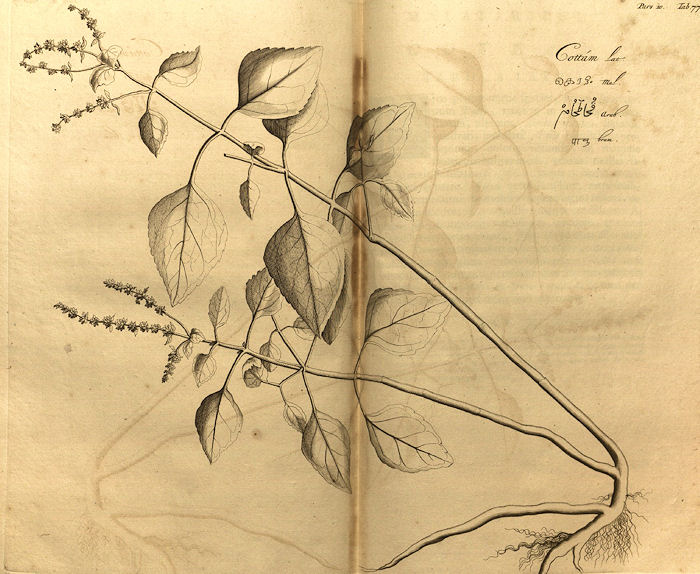
Abb.: जनी । Pogostemon cablin (Blanco) Benth. 1848 - Patschuli - Patchouly
[Bildquelle: Hortus malabaricus X. Fig. 77, 1690]
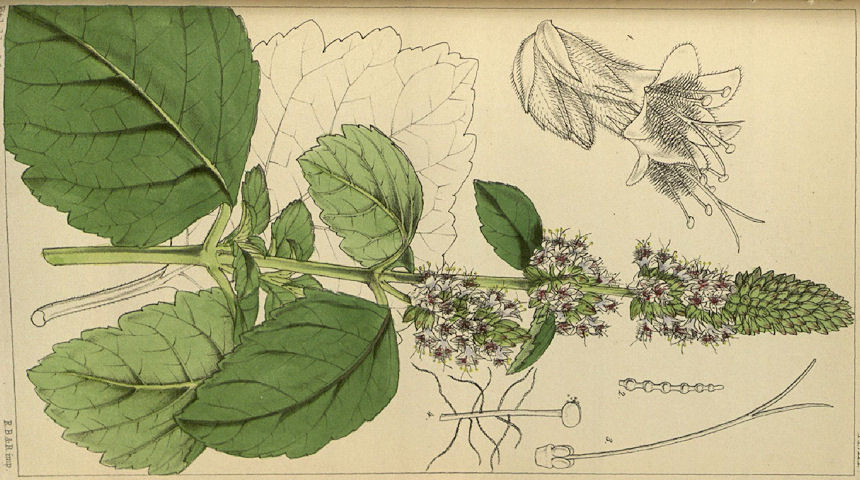
Abb.: रजनी । Pogostemon cablin (Blanco) Benth. 1848 - Patschuli - Patchouly
[Bildquelle: Hooker's journal of botany and Kew Garden miscellany. -- London. --
Vol 1 (1849), Pl. 11.]
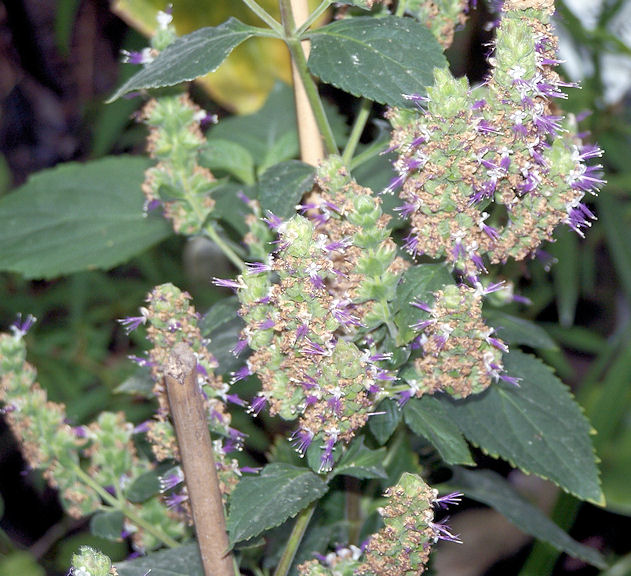
Abb.:
चक्रवर्तिनी
। Pogostemon cablin (Blanco) Benth. 1848 - Patschuli - Patchouly,
Göttingen
[Bildquelle: Valérie75 / Wikimedia. -- GNU FDLicense]
"Pogostemon Patchouli (Pellet). N. O. Lamiaceae. [...]
Description. — Suffruticose, 2-3 feet, pubesccnt; [...] flowers white, with red stamens and yellow anthers.
Hooker's Journ. of Bot. i. 329.—Benth. in Dec. Prod. xii. 153.—Rheede, x. t. 77.
Silhet.
Economic Uses.—The true identification of this plant was long a matter of discussion among botanists, but the subject has been set at rest by Sir W. Hooker, who managed to raise the plant in the Botanic Gardens at Kew, and which flowered there in 1849. It appears to be a native of Silhet, Penang, and the Malay Peninsula; but the dried flowering-spikes and leaves of the plant, which are used, are sold in every bazaar in Hindostan. From the few scattered notices of this celebrated perfume, it would appear that it is exported in great quantities to Europe, and sold in all perfumers' shops. The odour is most powerful, more so perhaps than that derived from any other plant. In its pure state it has a kind of musty odour analogous to Lycopodium, or, as some say, smelling of "old coats." Chinese or Indian ink is scented by some admixture of it. Its introduction into Europe as a perfume was singular enough, accounted for in the following manner:—
A few years ago, real Indian shawls bore an extravagant price, and, purchasers distinguished them by their odour—in fact, they were perfumed with Patchouly. The French manufacturers had for some time successfully imitated the Indian fabric, but could not impart the odour. At length they discovered the secret, and began to import this plant to perfume articles of their make, and thus palm off home-spun shawls as real Indian ones. From this origin the perfumers have brought it into use. The leaves powdered and put into muslin bags prevent cloths from being attacked by moths.
Dr Wallich states that a native friend of his told him that the leaf is largely imported by Mogul merchants ; that it is used as an ingredient in tobacco for smoking, and for scenting the hair of women; and that the essential oil is in common use among the superior classes of the natives, for imparting the peculiar fragrance of the leaf to clothes. It is exported in great quantities from Penang. The Arab merchants buy it chiefly, employing it for stuffing mattresses and pillows, asserting that it is very efficacious in preventing contagion and prolonging life. For these purposes no other preparation is required, save simply drying the plant in the sun, taking care not to dry it too much, lest the leaves become too brittle for packing. In Bengal it has cost Rs. 11-8 per maund, but the price varies. It has been sold as low as Rs. 6. The drug has been exported from China to New York, and from thence to England. The volatile oil is procured by distillation. The Sachets de Patchouli, which are sold in the shops, consist of the herb, coarsely powdered, mixed with cotton root and folded in paper. These are placed in drawers and cupboards to drive away moth and insects. The P. Heyneanum (Benth.) is probably merely a variety, with larger spikes and more drooping in habit. This plant is figured in Wallich, Pl. As. Res. i. t. 31. J. Graham states that it is found wild in the Concans. Rheede's synonym probably is the P. Heyneanum, which the natives use for perfuming purposes.—Hooker's Journ. of Bot. Pharm. Journ. viii 574, and ix. 282. Wallich in Med. Phys. Soc. Trans. Plant As. Rar. Simmonds."
[Quelle: Drury, Heber <1819 - 1872>: The useful plants of India : with notices of their chief value in commerce, medicine, and the arts. -- 2d ed. with additions and corrections. London : Allen, 1873. -- xvi, 512 p. ; 22 cm. -- s.v.]
Zingiberaceae (Ingwergewächse)
|
19. c./d.
saṃsparśātha śaṭī gandhamūlī
ṣaḍgranthikety api 20. a./b. karcūro 'pi palāśo 'tha kāravellaḥ kaṭhillakaḥ
संस्पर्शाथ शटी गन्धमूली
षड्ग्रन्थिकेत्य् अपि ॥१९ ख॥ [Bezeichnungen für Curcuma zedoaria (Christm.) Roscoe 1810 - Zitwer - Zedgary:]
|
Siehe auch 2.IV.23!
Colebrooke (1807): "Ambahaldi. The Hindi name, here taken from medical writings, appertains to a new species of Curcuma."
1 कर्चूर - karcūra m.: Auripignment
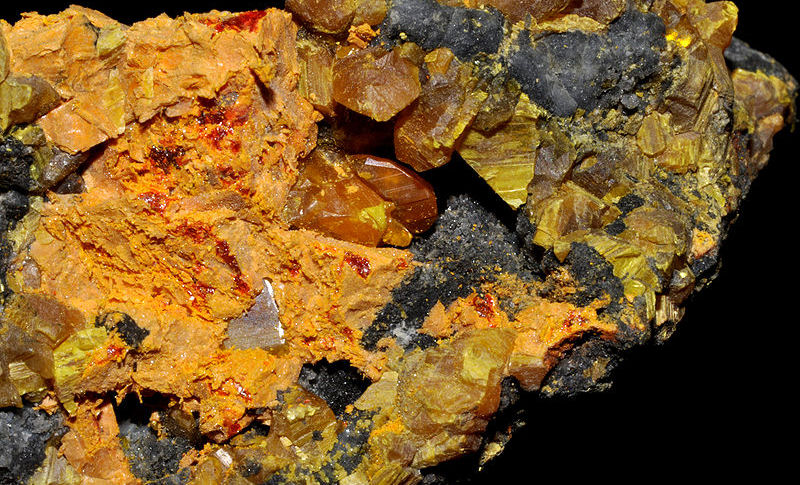
Abb.: Auripigment (gelb) mit einem Restanteil Realgar (rot)
[Bildquelle: Parent Géry / Wikipedia. -- Public domain]
"Auripigment (lat., Operment, gelbe Arsenblende, Rauschgelb), Mineral, findet sich in kleinen, rhombischen Kristallen, häufiger derb, eingesprengt, in Trümmern, knollig, traubig, nierenförmig, ist wenig durchscheinend, zitronen- oder pomeranzengelb, mit schwachem Fettglanz, Härte 1,5–2, spez. Gew. 3,4–3,5, besteht aus Schwefelarsen As2S3 und findet sich vornehmlich in Ungarn und Siebenbürgen, mit Realgar, Quarz und Kalkspat in Mergeln und tonigen Sandsteinen, mit Bleiglanz, Schwefelkies etc. auf Erzgängen, auch auf Gängen im Tonschiefer, zu Andreasberg, in der Walachei, China, Mexiko, in Kraterspalten am Ätna und Vesuv. Über künstliches A. s. ð Arsensulfide." [Quelle: Meyers großes Konversations-Lexikon. -- DVD-ROM-Ausg. Faksimile und Volltext der 6. Aufl. 1905-1909. -- Berlin : Directmedia Publ. --2003. -- 1 DVD-ROM. -- (Digitale Bibliothek ; 100). -- ISBN 3-89853-200-3. -- s.v.]
2 पलाश - palāśa m.: Palāśa
palāśa m. = Butea monosperma (Lam.) Kurtz - Malabar-Lackbaum - Flame of the Forest
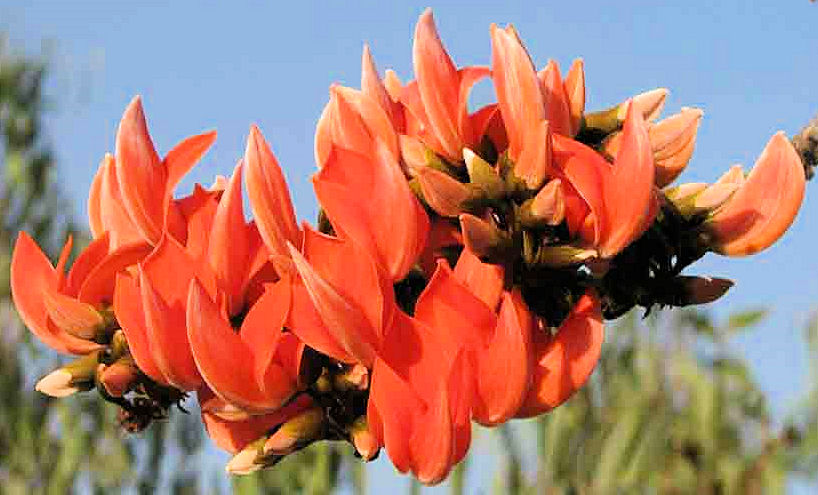
Abb.: पलाशः । Butea monosperma (Lam.)
Kurtz - Malabar-Lackbaum - Flame of the Forest, Bangalore,
Karnataka
[Bildquelle: SumaTagadur / Wikimedia. --
Creative Commons Lizenz (Namensnennung, share alike)]
Curcuma zedoaria (Christm.) Roscoe 1810 - Zitwer - Zedgary
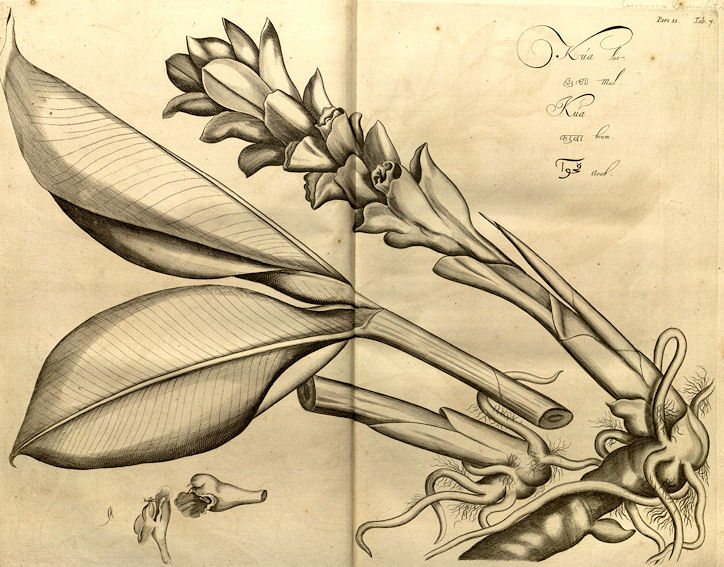
Abb.: Curcuma zedoaria (Christm.) Roscoe 1810 - Zitwer - Zedgary
[Bildquelle: Hortus malabaricus XI. Fig. 7, 1692]
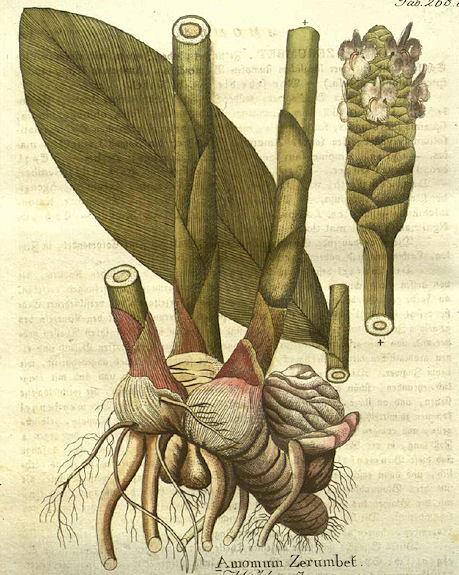
Abb.:
षड्ग्रन्थिका
। Curcuma zedoaria (Christm.) Roscoe 1810 - Zitwer - Zedgary
[Bildquelle: Icones plantarum medico-oeconomico-technologicarum cum earum
fructus ususque descriptione =Abbildungen aller
medizinisch-ökonomisch-technologischen Gewächse mit der Beschreibung ihres
Gebrauches und Nutzens. -- Wien, 1800 - 1822. -- Bd. 3, Tab. 268b]
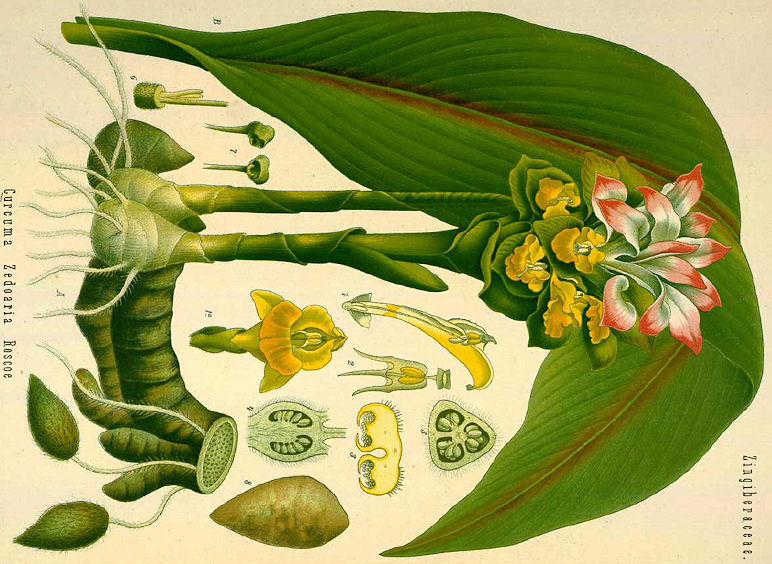
Abb.:
कर्चूरः । Curcuma zedoaria (Christm.) Roscoe 1810 - Zitwer -
Zedgary
[Bildquelle: Köhler, 1883-1914]
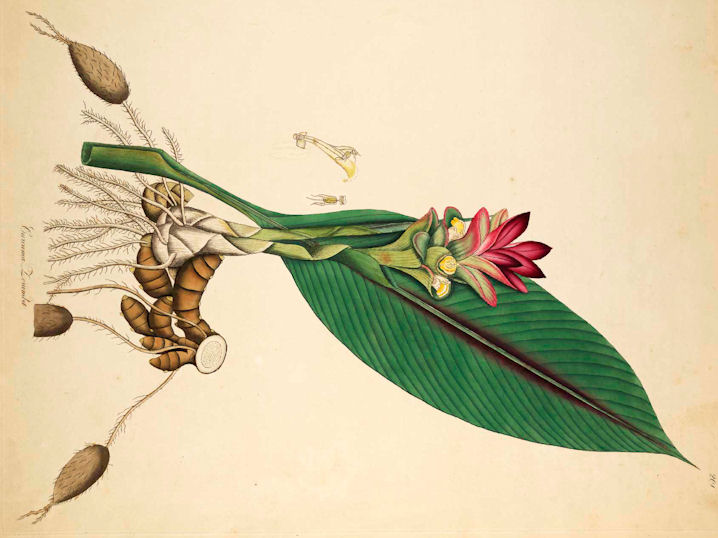
Abb.:
षड्ग्रन्थिका
। Curcuma zedoaria (Christm.) Roscoe 1810 - Zitwer - Zedgary (Roxb.:
Curcuma zerumbet)
[Bildquelle: Roxburgh. -- Vol III. -- 1819. -- Image courtesy Missouri Botanical
Garden. http://www.botanicus.org. --
Creative Commons Lizenz
(Namensnennung, keine kommerzielle Nutzung)]
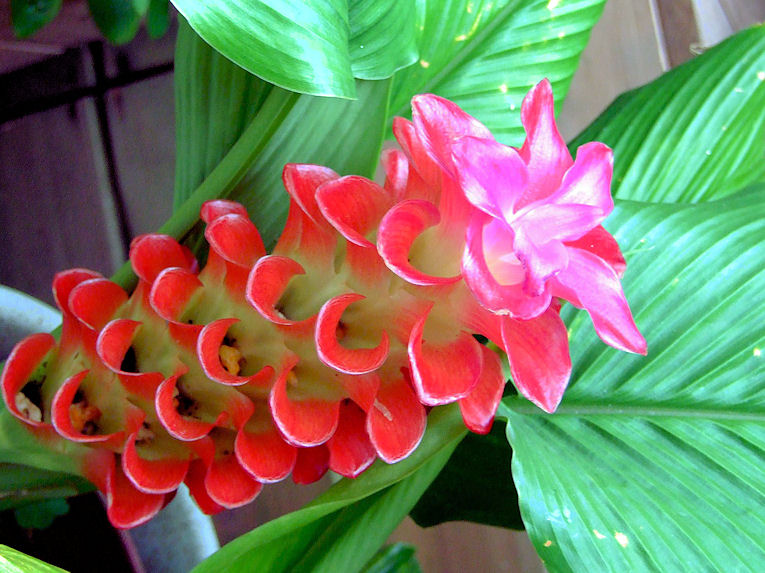
Abb.: पलाशः । Curcuma zedoaria (Christm.) Roscoe 1810 - Zitwer - Zedgary,
Hongkong - 香港
[Bildquelle:
Kai Yan, Joseph Wong. --
http://www.flickr.com/photos/33623636@N08/5000127263/. -- Zugriff am
2010-10-24. --
Creative
Commons Lizenz (Namensnennung, keine kommerzielle Nutzung, share alike)]
"Curcuma Zerumbet. Roxb. Ind. pl. 3. N. 201
[...]
Sans. Shutee, Gundha-moolee, Shud-grunthhika, Kurvoora, Kurchoora, and Pulasha.
Kua. Rheed. Mal. vol. II. p. 13. t. 7.
Zerumbed. Rumph. Amb. 5. p. 168. t. 68.
Amomum Zerumbeth. Kon. in Retz. Obs. 3. 55.
Zerumbet, or Cachora of Garcias.
The plants from which the following description was taken, were sent by Dr. F. Buchanan, from Chittagong, where they are indigenous, to the Botanic garden at Calcutta, in 1798, where they grow freely, and blossom in the month of April. Others have since been procured from thence under the Bengalee name Kuchoora. From that place the native druggists in Calcutta, are chiefly supplied with the root or drug.
[...]
Obs. The dry root powdered and mixed with the powdered wood of the Caesalpinia Sappan makes the red powder called Abeer by the Hindoos, and Phag by the Bengalees. It is copiously thrown about by the natives during the Hooli, or Hindoo holidays in the month of March. The root is also used medicinally amongst the natives.
In 1805, I gave some of the sliced and dried bulbous, and palmate tuberous roots of this plant to Sir Joseph Banks, which he gave to Dr. Comb, who found that it was the real Zedoaria of our Materia Medica, and by the same means ascertained that the root of my Curcuma Zedoaria, is Zedoaria rotunda of the shops."
[Quelle: Roxburgh, William <1751-1815>: Flora indica, or, Descriptions of Indian plants / by the late William Roxburgh. -- Serampore : Printed for W. Thacker, 1832. -- Vol. 1, S. 20ff.]
"Curcuma zedoaria (Roscoe). Long Zedoary [...]
Description.—Height 3-4 feet; [...] flowers deep yellow and bright crimson tuft.
Fl. April.
Wight Icon. t. 2005.
Curcuma zerumbet, Roxb. Fl. Ind. i. ed. Car. 20. — Corom. iii t. 201.—Rheede, xi. t. 7.
Chittagong. Malabar.
Medical Uses.—According to Roxburgh this plant yields the long Zedoary of the shops, though Pereira states that the plant has not been well ascertained. The root is used medicinally by the natives. It is cut into small round pieces, about the third of an inch thick and two in circumference. The best comes from Ceylon, where it is considered tonic and carminative. According to Rheede it has virtues in nephritic complaints. The pulverised root is one of the ingredients in the red powder (Abeer) which the Hindoos use during the Hooly festival.—Roxb. Pereira."
[Quelle: Drury, Heber <1819 - 1872>: The useful plants of India : with notices of their chief value in commerce, medicine, and the arts. -- 2d ed. with additions and corrections. London : Allen, 1873. -- xvi, 512 p. ; 22 cm. -- s.v.]
"CURCUMA ZEDOARIA, Rosc.
Fig.—Rosc. Scit., t. 109; Roxb. Cor. Pl., t. 101; Rheede, Hort. Mal. xi., t. 7.
Zedoary
Hab.—Eastern Himalaya, cultivated throughout India.
[...]
History, Uses, &C—This plant is the Sati and Krachura of Sanskrit writers, and the Zerumbād aud Urūk-el-kāfūr, "camphor root," of the Arabians. It is noticed by the later Greek physicians under the name ζοθρομβεδ corruption of the Arabic name, which in the Middle Ages, was variously written as Zeruban, Zerumber, and Zerumbet. It is not the ζεδοαρ of Aetius (A. D. 540-550) or the τζετουαριον of Myrepsus, or the Zedoar of MacerFloridus (A. D. 1140). Barbosa (1510) speaks of Zedoaria and Zeruban as distinct articles of trade at Cannanore, so that it must have been some time after this date that Zerumbet came into use in Europe as a cheap substitute for the Zedoar of the earlier physicians, which, we have no doubt, was the same drug as the Jadwar of the Arabians. This name, correctly written by Aetius, is the Zhedwar of the ancient Persians, and is described in the Burhān (A. D. 1040) as a drug used as an antidote to poisons, the same as the Jadwār of the Arabians, and also called Mahparvin. Ibn Sina of Bokhara, who lived about the same time (980—1037), describes Jadwār shortly in the following words:—
"it has the form of the root of Aristolochia, but is smaller." Haji-Zein-cl-attār, the well-known Persian physician and apothecary, and the author of the "Ikhtiarāt" (A. D. 1308), describes Jadwār as a root about the size and shape of the Indian Cyperus root, but harder and heavier, and the same as the Indian drug Nirbisi, the best internally of a purplish tint. He states that there are, as far as his experience goes, four drugs sold as Jadwār, viz., a white kind, a purplish, a black and a yellow ; the people of Cathay call the yellow kind Kurti and the purplish Burbi, the other two kinds come from India. As to the locality in which the drug is collected, he states that there is a mountain called Farājal between India and Cathay, where the plant grows along with the aconite, and that the latter, whenever it grows near the Jadwār, loses its poisonous properties and is eaten with impunity by the inhabitants. Where the Jadwār does not grow, the aconite (Bish) is a deadly poison, and is called Halālal by the natives (Halahala, Sanskrit). In the Dict. Econ. Prod. of India (ii., p. 656), the following account of certain drugs collected in Nepal by Dr. Gimlette, the Residency Surgeon, substantially confirms Haji-Zein's description of Jadwār or Nirbisi:—According to Dr. Gimlette, "the Kala bikh of the Nepalese (the Dulingi of the Bhoteas) is a very poisonous form of Aconitum ferox, so poisonous, indeed, that the Katmandu druggist will not admit they possess any. Pahlo (yellow) bikh is a less poisonous form of the same plant, known to the Bhoteas as Holngi, while Setho (white) bikh (the Nirbisi sen of the Bhoteas) is A. Napellus, and Atis is Aconitum heterophyllum. The aconite adulterants or plants used for similar purposes are, Cynanthus lobatus, the true Nirbisi of Nepal, the root of which is boiled in oil, thus forming -a liniment which is employed in chronic rheumatism, Delphinium denudatum, the Nilo (blue or purplish) bikh of the Nepalese and the Nirbisi of the Bhoteas, Dr. Gimlette says, is used by the Baids of Nepal for the same purposes as the Setho and Pahlo bikh. Geranium collinum (var. Dunianum) is the Ratho (red) bikh of the Nepalese, and the Nirbisi-num of the Bhoteas, and, like the Setho bikh, is given as a tonic in dyspepsia, fevers, and asthma. Lastly, a plant never before recorded as used medicinally, namely, Caragana crassicaulis, is known as the Artiras of the Nepalese, and the Kurti of the Bhoteas; it affords a root which is employed as a febrifuge."
The Jadwār or Nirbisi myth appears to have been invented in the East to account for the curious occurrence on the Himalayas of poisonous and non-poisonous aconites growing side by side (see Vol. I., pp. 1, 15, 18, 20).
It would appear also that the Curcumas have no claim to the name of zedoary, which was probably first given to them about the middle of the 16th century, as Clusius's figure of Gedwar is certainly meant for the pendulous tuber of a Curcuma. The on of the cheaper for the more expensive article is rendered highly pvobable by the fact that Zerumbet was considered by the Arabians to be very little inferior to Jadwār as an antidote to poisons. Ibn Sina, Ibn Baitar, and Ibn Jazla in the Minhāj use almost the same word-in speaking of these drugs ; of Jadwār they say :
"it is an antidote for all poisons, even those of aconite and the viper"; and of Zerumbet —
"it is most useful against the bites of venomous annuals, and is almost equal to Jadwār."
Both drugs were considered to have properties similar to Darunaj (see Vol. II., p. 292). Ainslie (Mat Ind., i, 492) remarks that C. Zedoaria is the Lampooyang of the Javanese, and the Lampuium of Rumphius (Herb. Amb. V., p. 148), and that it is a native of the East Indies, Cochin-China, and Otaheite. He quotes Geoffrey's description of the drug, which leaves no doubt as to it- identity with the modern Kachora—"Foris cinerea, intus candida; sapore acri-amaricante aromatico; odore tenui fragrante, ac valde aromaticum suavtatem, cum tunditur aut manducatur, spirante et ad camphoram aliquatenus accedente." Guibourt states that C. Zedoaria is the Zerumbet of Serapion, Pomet, and Lemery. The following is his description of it :—"The round zedoary is greyish-white externally heavy, compact, grey and often horny internally, laving a bitter and strongly camphoraceous taste, like that of the long zedoary, which it also resembles in odour. The odour of both drugs is analogous with that of ginger, but weaker unless the rhizome be powdered, when it developes a powerful aromatic odour, similar to that of cardamoms." (Hist. Nat. 6me Ed., Vol. II., p. 213.) In our opinion there is no doubt that C. Zedoaria is the source of the round and long zedoary of commerce. The plant is common in Bombay gardens, and was probably introduced by the Portuguese, whose descendants and converts at the present day use the leaves in cookery, especially with fish. From Dr. Hove's account of Bombay in 1787 it appears that Kachura and Turmeric were cultivated at that time in the cocoanut woods at Mahim. The natives chew the root to correct a sticky taste in the mouth ; it is also an ingredient in some of the strengthening conserves which are taken by women to remove weakness after child-birth. In colds it is given in decoction with long-pepper, cinnamon and honey, and the pounded root is applied as a paste to the body. Rheede says that the starch of the zedoary is much esteemed, and that the fresh root is considered to be cooling and diuretic, it checks leucorrhoeal and gonorrhoeal discharges and purifies the blood. The juice of the leaves is given in dropsy. One of us has had the plant in cultivation for some years ; it blossoms in the hot weather just before the rains, when the first leaves begin to appear."
[Quelle: Pharmacographia indica : a history of the principal drugs of vegetable origin met with in British India / by William Dymock [1834-1892], C. J. H. Warden and David Hooper [1858-1947]. -- Bd. 3. -- London, 1893. -- S. 399ff.]
Cucurbitaceae (Kürbisgewächse)
|
20.
karcūro 'pi palāśo
'tha kāravellaḥ kaṭillakaḥ suṣavī cātha kulakaṃ patolas tiktakaḥ paṭuḥ
कर्चूरो
ऽपि
पलाशो
ऽथ कारवेल्लः कटिल्लकः । [Bezeichnungen für Momordica charantia L. 1753 - Bittergurke - Balsam Pear / Bitter Melon:]
|
Colebrooke (1807): "Momordica charantia."
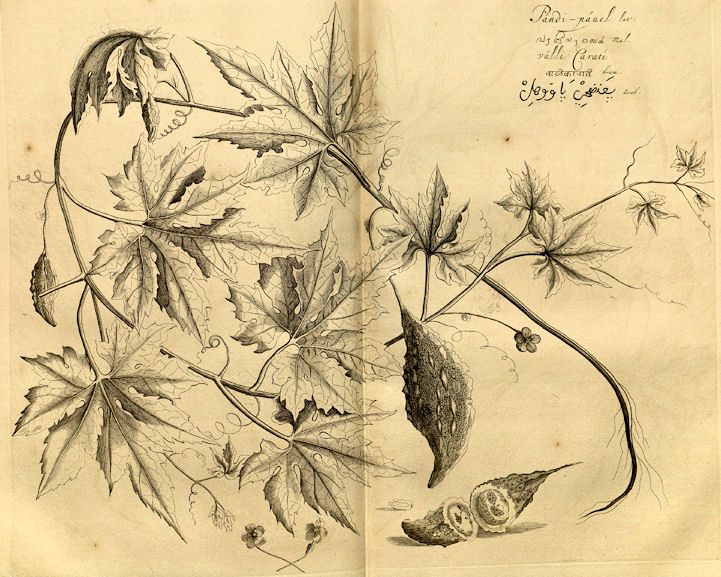
Abb.: कारवेल्लः । Momordica charantia L. 1753 - Bittergurke - Balsam Pear / Bitter
Melon
[Bildquelle: Hortus malabaricus VIII. Fig. 9, 1688]
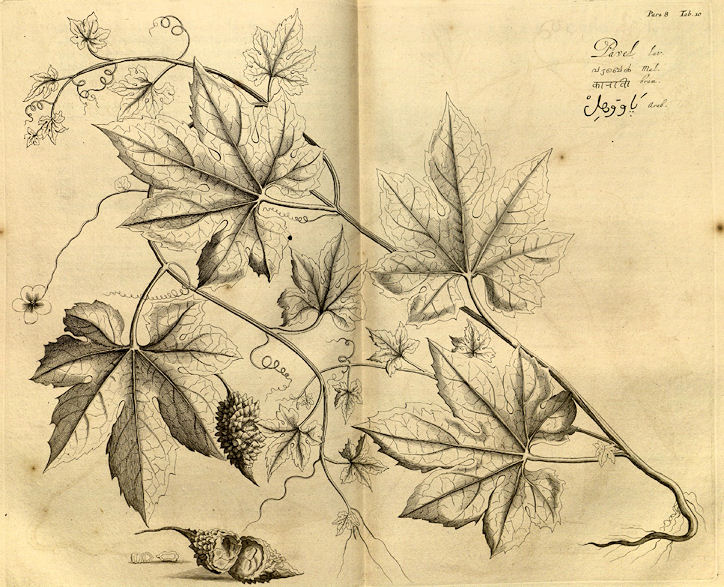
Abb.: Momordica charantia L. 1753 - Bittergurke - Balsam Pear / Bitter
Melon
[Bildquelle: Hortus malabaricus VIII. Fig. 10, 1688]
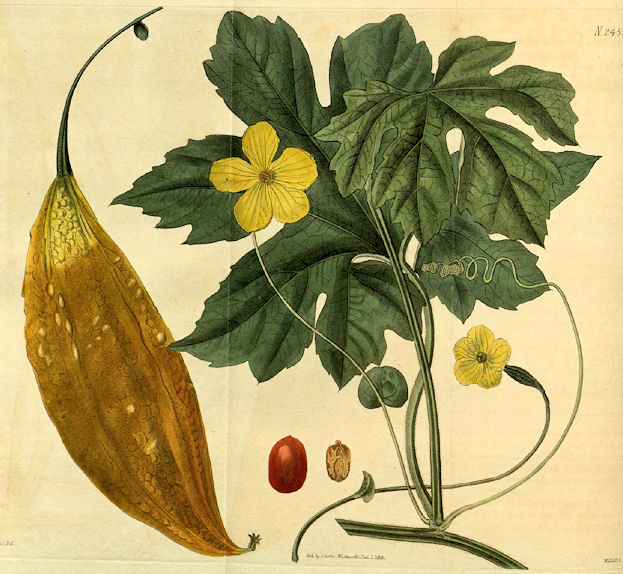
Abb.: Momordica charantia L. 1753 - Bittergurke - Balsam Pear / Bitter
Melon
[Bildquelle: Curtis's Botanical Magazine, v. 51 (1824), Tab. 2455]
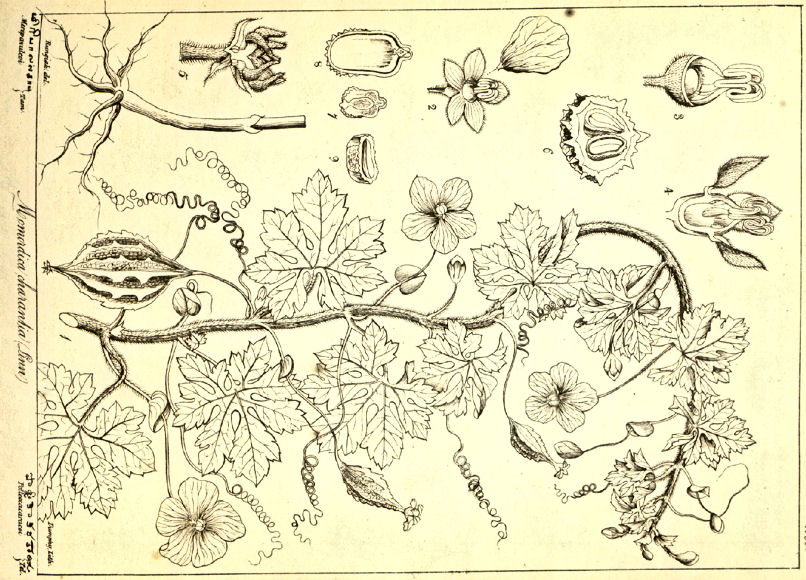
Abb.: Momordica charantia L. 1753 - Bittergurke - Balsam Pear / Bitter
Melon
[Bildquelle: Wight Icones II, Tab. 504, 1843]
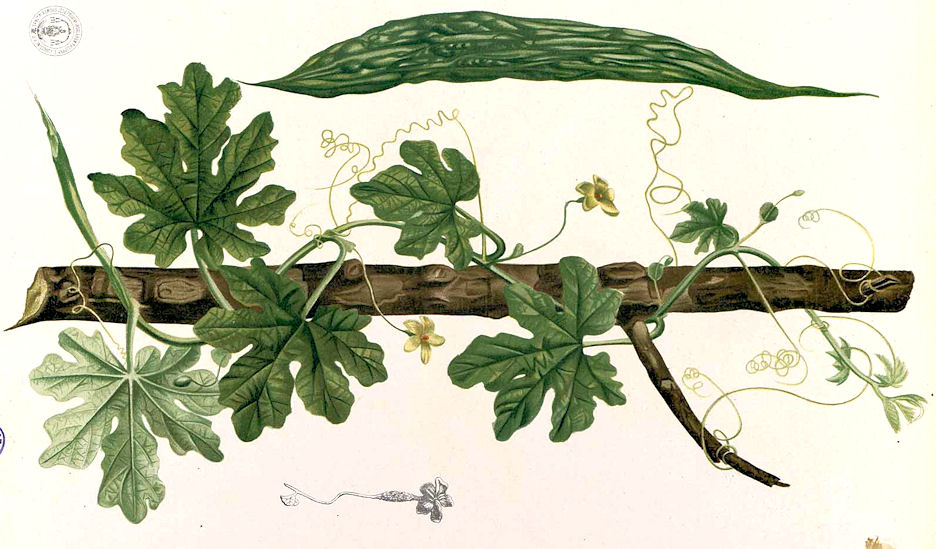
Abb.: Momordica charantia L. 1753 - Bittergurke - Balsam Pear / Bitter
Melon
[Bildquelle: Flora de Filipinas, 1880 / Wikipedia. -- Public domain]
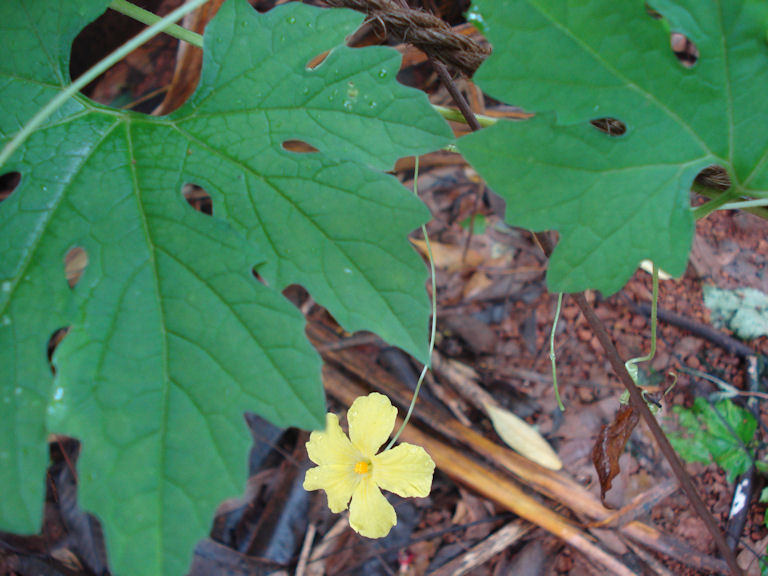
Abb.: Momordica charantia L. 1753 - Bittergurke - Balsam Pear / Bitter
Melon
[Bildquelle: Aruna / Wikipedia. -- GNU FDLicense]
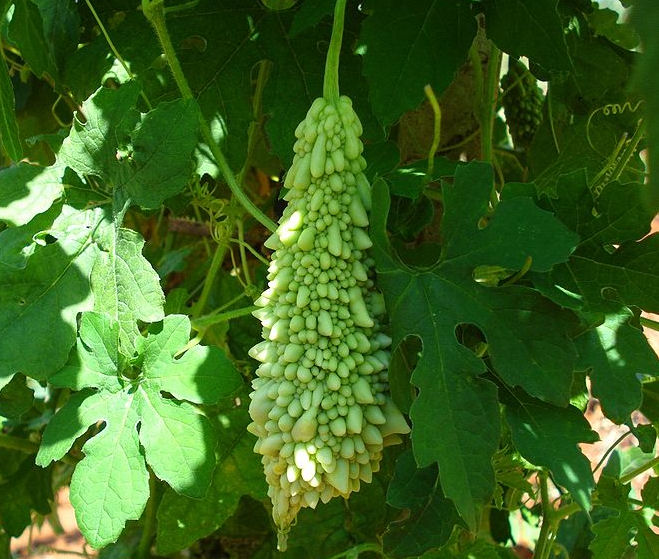
Abb.: Momordica charantia L. 1753 - Bittergurke - Balsam Pear / Bitter
Melon
[Bildquelle: Aruna / Wikipedia. -- GNU FDLicense]

Abb.: Momordica charantia L. 1753 - Bittergurke - Balsam Pear / Bitter
Melon
[Bildquelle: H. Zell / Wikipedia. -- GNU FDLicense]
"Momordica Charantia. Willd. iv. 602.
[...]
Pandi-pavel. Rheed. Mal. viii. t. 9.
Amara-indica. Rumph. Amb. v. t. 151.
Cultivated in all the warmer parts of Asia for the fruit, which the natives eat, while unripe, in their curries. The fruits are bitter and reckoned wholesome."
[Quelle: Roxburgh, William <1751-1815>: Flora indica, or, Descriptions of Indian plants / by the late William Roxburgh. -- Serampore : Printed for W. Thacker, 1832. -- Vol. 3, S. 707.]
"Momordica Charantia (Linn.) N. O. Cucurbitaceae.
[...]
Description.—Climbing; stems more or less hairy; [...] flowers middle-sized, pale yellow.
Fl. Aug.—Oct.
W. & A. Prod. i. 348.—Roxb. Fl Ind. iii. 707.— Wight Icon. ii. t. 504.
M. muricata, Willd.—Rheede Mal. viii. t. 9, 10.
Cultivated everywhere in the Peninsula.
Medical Uses.—There are two chief varieties differing in the forms of the fruit, the one having the fruit longer and more oblong, the other with the fruit smaller, more ovate, muricated, and tubercled. There are besides these many intermediate gradations. The fruit is bitter but wholesome, and is eaten in curries by the natives. It requires, however, to be steeped in salt water before being cooked. That of the smaller variety is most esteemed. The whole plant mixed with cinnamon, long-pepper, rice, and marothy oil (Hydnocarpus inebrians), is administered in the form of an ointment in psora, scabies, and other cutaneous diseases. The juice of the leaves mixed with warm water is reckoned anthelmintic. The whole plant pulverised is a good specific externally applied in leprosy and malignant ulcers.—Rheede. Dr Gibson. Wight."
[Quelle: Drury, Heber <1819 - 1872>: The useful plants of India : with notices of their chief value in commerce, medicine, and the arts. -- 2d ed. with additions and corrections. London : Allen, 1873. -- xvi, 512 p. ; 22 cm. -- s.v.]
"MOMORDICA CHARANTIA, Linn.
Fig.—Bot Mag., t. 2455; Wight Ic., t. 504; Bot. Reg., t. 980.
Hab Throughout India.
[...]
Description, Uses, &C.—There are two chief varieties differing in the form of the fruit, the one being longer and more oblong, and the other smaller, more ovate, muricated and tubercled. There are besides many intermediate gradations. The fruit is bitter but wholesome, and is eaten by the natives. It requires, however, to be steeped in salt water before being cooked ; the smaller variety is most esteemed. (Drury.) From Rheede, Wight and Gibson we learn that the Hindus use the whole plant combined with cinnamon, long pepper, rice and the oil of Hydnocarpus Wightiana, as an external application in scabies and other cutaneous diseases. The fruit and leaves are administered as an anthelmintic, and are applied externally in leprosy. One-eighth of a seer of the juice of the leaves is given in bilious affections, as an emetic and purgative, alone or combined with aromatics ; the juice is rubbed in, in burning of the soles of the feet, and with black pepper is rubbed round the orbit as a cure for night blindness. The Sanskrit name is Kāravella, the muricated variety is called Sushavi, and bears the synonym Kāndira or " armed with arrows." The author of the Makhzan-el-Adwiya describes the fruit as tonic and stomachic, and says that it is useful in rheumatism and gout, and in diseases of the spleen and liver ; he also mentions its anthelmintic properties. He points out that some have erroneously supposed it to be identical with the Katha-el-himār of the Arabs, which is a violent purgative. [...]
In the rainy season the plant may be seen in almost every garden in India. The fruit is also offered for sale in the market, and when well cultivated attains the size of a cucumber."
[Quelle: Pharmacographia indica : a history of the principal drugs of vegetable origin met with in British India / by William Dymock [1834-1892], C. J. H. Warden and David Hooper [1858-1947]. -- Bd. 2. -- London, 1891. -- S. 78f.]
Cucurbitaceae (Kürbisgewächse)
|
20. c./d.
suṣavī cātha
kulakaṃ paṭolas tiktakaḥ paṭuḥ सुषवी चाथ कुलकं पटोलस् तिक्तकः पटुः ॥२० ख॥ [Bezeichnungen für Trichosanthes dioica Roxb. - Pointed Gourd:]
|
Colebrooke (1807): "Trichosanthes. Trichosanthes dioeca, Roxb."
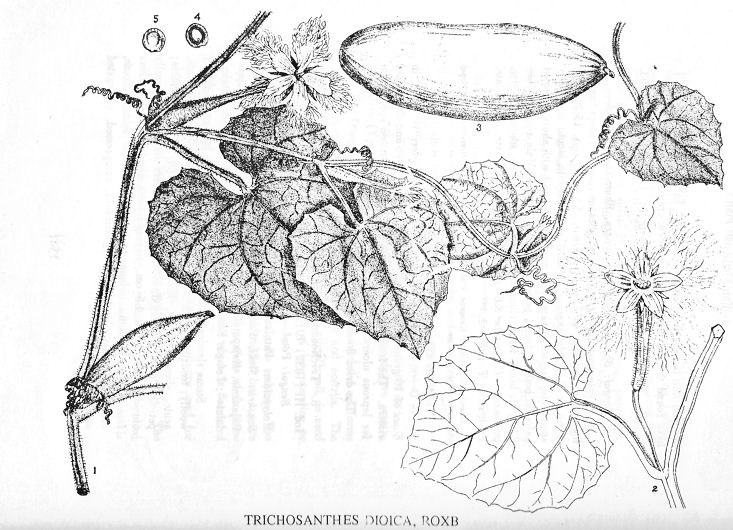
Abb.: पटोलः । Trichosanthes dioica Roxb. - Pointed Gourd
[Bildquelle: Kirtikar-Basu, ©1918]
"Trichosanthes dioeca. Roxb.
[...]
Sans. Putulika.
This is by far the most useful species of Trichosanthes I am yet acquainted with. It is much cultivated by the natives about Calcutta, during the rains. It is unknown on the coast of Coromandel.
[...]
The unripe fruit and tender tops are much eaten both by Europeans and natives in their curries, and are reckoned exceedingly wholesome.
Trichosanthes cucumerina. Willd. iv. 600.
[...]
Pada valam. Rheed. Mal. viii. t. 15.
A pretty extensive, climbing annual, a native of hedges,
&c. where it has shelter. It flowers during the cold season.
[...]
The unripe fruit is eaten in stews, by the natives, it is exceedingly bitter, for which it is reckoned the more wholesome, and is said to be anthelmintic."
[Quelle: Roxburgh, William <1751-1815>: Flora indica, or, Descriptions of Indian plants / by the late William Roxburgh. -- Serampore : Printed for W. Thacker, 1832. -- Vol. 3, S. 702f.]
"Trichosanthes cucumerina (Linn.) N. O. Cucurbitaceae. [...]
Description.—Annual, climbing; [...] flowers small, white.
Fl. Aug.—Dec.
W.& A. Prod. i. 350.—Roxb. Fl. Ind. iii. 702.—Rheede, Mal. viii. t. 15.
Peninsula. Bengal
Medical Uses.—The seeds are reputed good in disorders of the stomach on the Malabar coast. The unripe fruit is very bitter, but is eaten by the natives in their curries. The tender shoots and dried capsules are very bitter and aperient, and are reckoned among the laxative medicines by the Hindoos. They are used in infusion. In decoction with sugar they are given to assist digestion. The seeds are anti-febrile and anthelmintic. The juice of the leaves expressed is emetic, and that of the root drank in the quantity of 2 oz. for a dose is very purgative. The stalk in decoction is expectorant.
One species, the T. cordata (Roxb.), is found on the banks of the Megna, where the inhabitants use the root as a substitute for Columba- root It has been sent to England as the real Columba of Mozambique.—(Ainslie. Rheede. Roxb.) The T. dioica (Roxb.) is cultivated as an article of food. An alcoholic extract of the unripe fruit is described as a powerful and safe cathartic, in doses of from 3 to 5 grains, repeated every third hour as long as may be necessary. —(Beng. Disp.) The plant is a wholesome bitter, which imparts a tone to the system after protracted illness. It has also been employed as a febrifuge and tonic. The old Hindoo physicians used it in leprosy.—Pharm. of India."
[Quelle: Drury, Heber <1819 - 1872>: The useful plants of India : with notices of their chief value in commerce, medicine, and the arts. -- 2d ed. with additions and corrections. London : Allen, 1873. -- xvi, 512 p. ; 22 cm. -- s.v.]
"TRICHOSANTHES DIOICA, Roxb.
Hab.—Throughout the plain of North India, Guzerat to Assam, Bengal.
TRICHOSANTHES CUCUMERINA, Linn.
Fig.—Rheede Hort. Mal. viii., t. 15.
Hab.—Throughout India and Ceylon.
[...]
History, Uses, &c.—In Northern India, Bengal and Guzerat the fruit of T. diolca is considered to be the Patola of Sanskrit writers, and in Western and Southern India, where T. dioica is not found, T. cucumerina is used as Patola.
Patola or Patolaka, "shaped like a muscle shell," is a medicine in great repute amongst the Hindus as a febrifuge and laxative in bilious fevers, the decoction of the whole plant being administered in combination with other bitters. It is also considered to purify the blood and remove boils and skin eruptions; aromatics may be added to the decoction. The following prescription from Chakradatta may be taken as an example:—Take of Patola, Tinospora, Cyperus, Chiretta, Neembark, Catechu, Oldenlandia, Root bark of Adhatoda, equal parts, in all two tolas (360 grains), and prepare a decoction which is afterwards to be boiled down to one-fourth, and taken in divided doses during 24 hours. The drug is also administered in combination with Turbith as a drastic purgative in jaundice and dropsy ; the Patoladya churna is a compound purgative powder of this kind. Both of these plants are found in a wild and in a cultivated condition; for medicinal purposes, the wild plants are used, the cultivated fruits, though still bitter, are favourite vegetables with the Hindus and exert a mild aperient action when freely eaten.
Mahometan writers describe the plant as cardiacal, tonic, alterative and antifebrile, and say that it is a useful medicine for boils and intestinal worms. The author of the Makhzan remarks that the Hindus in obstinate cases of fever infuse 180 grains of the plant with an equal quantity of Coriander for a night, and in the morning add honey to it and strain the liquor; this quantity makes two doses, one of which is taken in the morning and one at night. ln the Concan the leaf juice is rubbed over the liver or even the whole body in remittent fevers. In Guzerat the fruit of the cultivated T. dioica is steamed, stuffed with spices, fried in melted butter, and eaten with wheaten bread as a remedy for spermatorrhoea. Ainslie, under the name of T. laciniosa, notices the use of T. cucumerina as a stomachic and laxative medicine among the Tamools, and says it is the Patola of Southern India. Rheede gives the following account of its medicinal properties :—" Decoctum cum saccharo sumptum, digestioni confert, tormina intestinorum, ac alios ventris dolores sedat, phlegmata expectorat, pectoris angustiam tollit; febres minuit, humores attemperat, vermes enecat. Succus expressus idem praestat et vomitum provocat. Radicis succus ad quantitatem duarum unciarum epotus, valde purgativns est, in ipsa accessione februm quotidianarum ac quartanarum ex pituita provenientium, frigus vel diminuit vel in totum tollit, per vomitum scilicet: stipes in decocto datus phlegmati expectorando conducit: fructus quaquo modo sumpti tumores expellunt."
From our observation of the action of these plants we cannot find that they differ in any way from colocynth ; like that drug they require to be combined with aromatics to prevent griping. Their febrifuge action appears to depend upon their purgative properties."
[Quelle: Pharmacographia indica : a history of the principal drugs of vegetable origin met with in British India / by William Dymock [1834-1892], C. J. H. Warden and David Hooper [1858-1947]. -- Bd. 2. -- London, 1891. -- S. 72ff.]
Trichosanthes cucumerina L. 1753 - Schlangenhaargurke
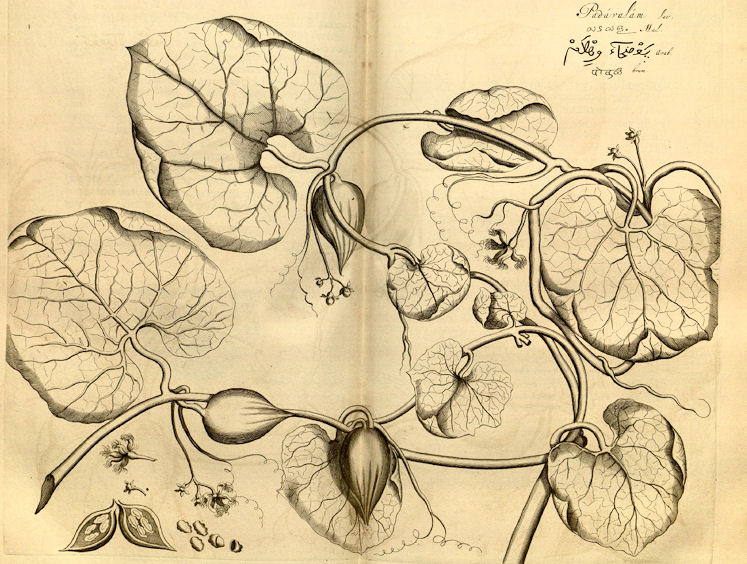
Abb.: Trichosanthes cucumerina L. 1753 - Schlangenhaargurke
[Bildquelle: Hortus malabaricus VIII. Fig. 15, 1688]
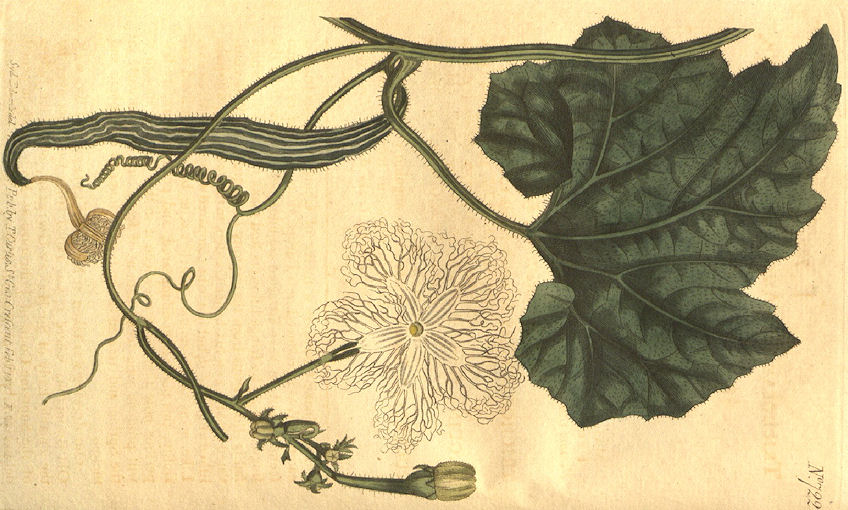
Abb.: Trichosanthes cucumerina L. 1753 var. anguina
[Bildquelle: Curtis's Botanical Magazine, v. 19 (1803), Tab. 722]
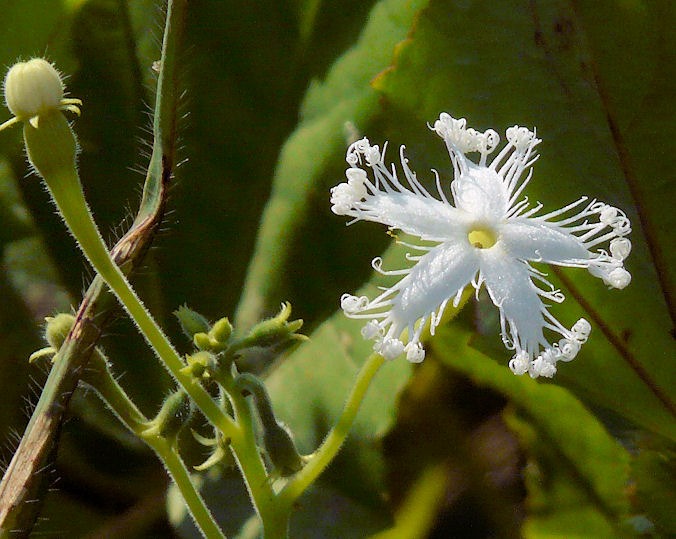
Abb.: Trichosanthes cucumerina L. 1753 - Schlangenhaargurke, Maharashtra
[Bildquelle: dinesh_valke. --
http://www.flickr.com/photos/dinesh_valke/2897859567/. -- Zugriff am
2010-12-06. --
Creative
Commons Lizenz (Namensnennung, keine kommerzielle Nutzung, share alike)]
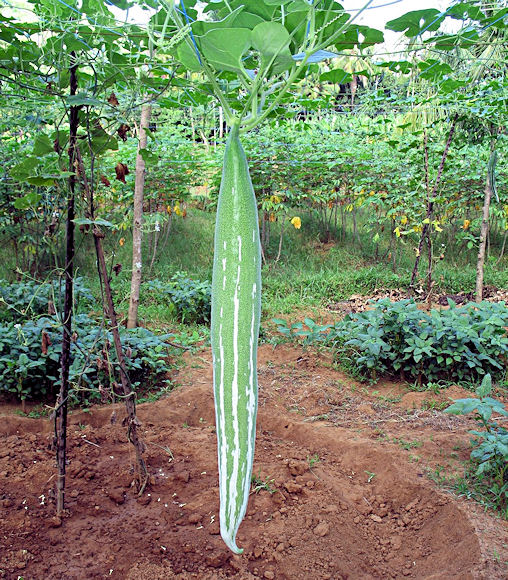
Abb.: Trichosanthes cucumerina L. 1753 - Schlangenhaargurke, Kerala
[Bildquelle: Sangfroid / Wikipedia. -- Public domain]
Cucurbitaceae (Kürbisgewächse)
|
21. a./b. kūṣmāṇḍakas tu karkārur
irvāruḥ karkaṭī striyau कुष्माण्डकस् तु कर्कारुर् इर्वारुः कर्कटी स्त्रियौ ।२१ क। [Bezeichnungen für Cucurbita pepo L. 1753 - Gartenkürbis:]
|
Colebrooke (1807): "A pumpkin gourd. Cucurbita pepo."
1 कुष्माण्डक - kuṣmāṇḍaka m.: Kuṣmāṇḍaka
"KUSHMĀṆḌAS. 'Gourds'. A class of demigods or demons in the service of Śiva." [Quelle: Dowson, John <1820-1881>: A classical dictionary of Hindu mythology and religion, geography, history, and literature. -- London, Trübner, 1879. -- s.v. ]
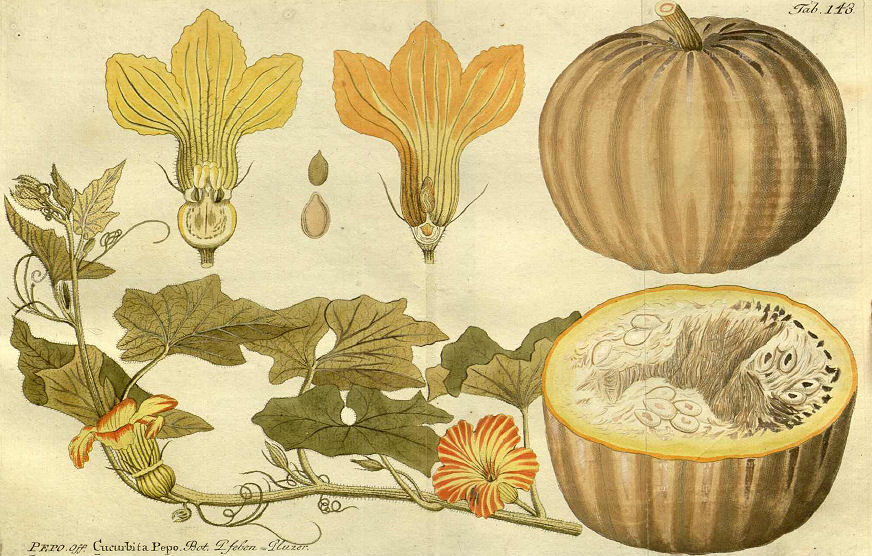
Abb.:
कुष्माण्डकः
। Cucurbita pepo L. 1753 - Gartenkürbis
[Bildquelle: Icones plantarum medico-oeconomico-technologicarum
cum earum fructus ususque descriptione =Abbildungen aller
medizinisch-ökonomisch-technologischen Gewächse mit der Beschreibung ihres
Gebrauches und Nutzens. -- Wien, 1800 - 1822. -- Bd. 2, Tab. 148]
"Cucurbita Pepo. Willd. iv. 609.
[...]
Cumbulam. Rheed. Mal. viii. t. 3.
Sans. Kurkaroo.
This plant I have only found in a cultivated state.
[...]
The young unripe pomes are universally eaten by the natives in their stews, and curries."
[Quelle: Roxburgh, William <1751-1815>: Flora indica, or, Descriptions of Indian plants / by the late William Roxburgh. -- Serampore : Printed for W. Thacker, 1832. -- Vol. 3, S. 718f.]
"Two other plants of this natural order may be mentioned here—the Cucurbita pepo, the well-known Pumpkin, which is reputed to possess anthelmintic properties in its seeds useful in cases of Taenia. The fruit is very common in India, in which case the remedy, if really effectual, might be readily available." [Quelle: Drury, Heber <1819 - 1872>: The useful plants of India : with notices of their chief value in commerce, medicine, and the arts. -- 2d ed. with additions and corrections. London : Allen, 1873. -- xvi, 512 p. ; 22 cm. -- s.v. Cucumis utilissimus]
Cucurbitaceae (Kürbisgewächse)
|
21. a./b.
kūṣmāṇḍakas tu karkārur
irvāruḥ karkaṭī striyau कुष्माण्डकस् तु कर्कारुर् इर्वारुः कर्कटी स्त्रियौ ।२१ क। [Bezeichnungen für Cucumis melo L. 1753 - Melone - Melon:]
|
Colebrooke (1807): "A sort of cucumber. Cucumis Utilatissimus [= utilissimus], Roxb. [= Cucumis melo L. 1753 - Melone - Melon]"
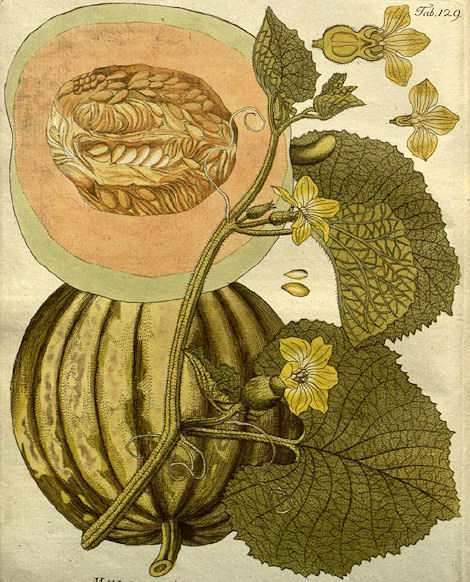
Abb.:
इर्वारुः
। Cucumis melo L. 1753 - Melone - Melon
[Bildquelle: Icones plantarum medico-oeconomico-technologicarum
cum earum fructus ususque descriptione =Abbildungen aller
medizinisch-ökonomisch-technologischen Gewächse mit der Beschreibung ihres
Gebrauches und Nutzens. -- Wien, 1800 - 1822. -- Bd. 2, Tab. 129]
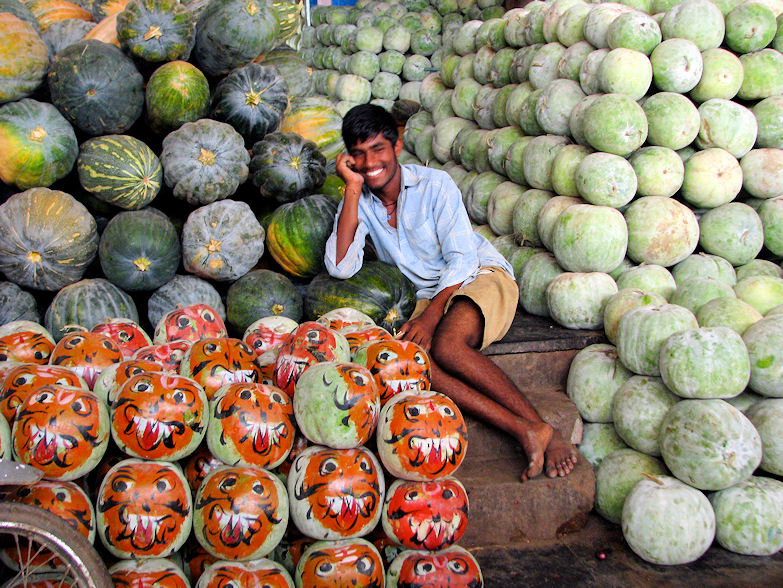
Abb.: Melonenverkäufer, Chennai -
சென்னை, Tamil Nadu
[Bildquelle: McKay Savage. --
http://www.flickr.com/photos/mckaysavage/3984998318/. -- Zugriff am
2010-10-24. --
Creative Commons Lizenz (Namensnennung)]
"Cucumis melo. Willd. iv. C13.
[...]
Found in a cultivated state only."
[Quelle: Roxburgh, William <1751-1815>: Flora indica, or, Descriptions of Indian plants / by the late William Roxburgh. -- Serampore : Printed for W. Thacker, 1832. -- Vol. 3, S. 720.]
"Cucumis utilissimus. Roxb.
[...]
Fruit short-oval, smooth, variegated, of the size of a small
melon.
An annual, a native of the higher cultivated lands, but generally found in a cultivated state; the cold season is the most favourable.
[...]
This appears to me to be by far the most useful species of Cucumis that I know ; when little more than one half grown, they are oblong, and a little downy, in this state they are pickled ; when ripe they are about as large as an ostrich's egg, smooth and yellow ; when cut they have much the flavor of the melon and will keep good for several months, if carefully gathered without being bruised and hung up ; they are also in this stage eaten raw and much used in curries, by the natives.
The seeds like those ofthe other Cucurbitaceous fruits contain much farinaceous matter blended with a large portion of mild oil ; the natives dry and grind them into a meal, which they employ, as an article of diet ; they also express a mild oil from them, which they use in food and to burn in their lamps. Experience as well as analogy prove these seeds to be highly nourishing and well deserving of a more extensive culture than is bestowed on them at present. The powder of the toasted seeds mixed with sugar is said to be a powerful diuretic, and serviceable in promoting the passage of sand or gravel.
As far as my observation and information goes, this agriculture is chiefly confined to the Guntoor Circar, where these seeds form a considerable branch of commerce; they are mixed with those of Holcus Sorgum or some other of the large culmiferous tribe and sown together ; these plants run on the surface of the earth, and help to shade them from the sun, so that they mutually help each other.
The fruit I observed above keeps well for several months if carefully gathered and suspended. This circumstance will render them a very excellent article to carry to sea during long voyages."
[Quelle: Roxburgh, William <1751-1815>: Flora indica, or, Descriptions of Indian plants / by the late William Roxburgh. -- Serampore : Printed for W. Thacker, 1832. -- Vol. 3, S. 721f.]
"Cucumis utilissimus (Roxb.) N. O. Cucurbitaceae. Field Cucumber [...]
Description.—Trailing; [...] flowers yellow. Fl. Nearly all the year.
W. & A. Prod. i. 342.—Roxb. Fl. Ind. iii. 721.
Cultivated.
Economic Uses.—The fruit is pickled when half grown, and when ripe and hung up it will keep good for several months. The seeds contain much farinaceous matter mixed with a large proportion of mild oil. The meal is an article of diet with the natives, and the oil is used for lamps. Roxburgh has the following remarks upon this plant: "This appears to me to be by far the most useful species of Cucumis that I know : when little more than half grown, the fruits are oblong and a little downy—in this state they are pickled; when ripe, they are about as large as an ostrich's egg, smooth and yellow. When cut they have much the flavour of the Melon, and will keep for several months, if carefully gathered without being bruised, and hung up. They are also in this state eaten raw, and much used in curries by the natives. The seeds, like those of other Cucurbitaceous fruits, are nutritious; the natives dry and grind them into a meal, which they employ as an article of diet; they also express a bland oil from them, which they use in food and burn in their lamps. Experience as well as analogy proves these seeds to be highly nourishing, and well deserving of a more extensive culture than is bestowed on them at present. The powder of the toasted seeds mixed with sugar is said to be a powerful diuretic, and serviceable in promoting the passage of sand or gravel. As far as my observation and information go, this agriculture is chiefly confined to the Guntoor Circar, where the seeds form a considerable branch of commerce. They are mixed with those of Holcus sorghum, or some others of the large culmiferous tribe, and sown together: these plants run on the surface of the earth and help to shade them from the sun, so that they mutually help each other. The fruit, as I observed above, keeps well for several months if carefully gathered and suspended. This circumstance renders it an excellent article to carry to sea during long voyages."—(Roxb.)
The C. pseudocolocynthis found on the slopes of the Western Himalaya is a good cathartic. It is called the Himalayan Colocynth.—(Royle.)
The C. momordica is an article of diet, and a good substitute for the common Cucumber, which is also cultivated to a great extent in India.—(Roxb.)
Two other plants of this natural order may be mentioned here—the Cucurbita pepo, the well-known Pumpkin, which is reputed to possess anthelmintic properties in its seeds useful in cases of Taenia. The fruit is very common in India, in which case the remedy, if really effectual, might be readily available.
The other is the C. maxima, which would appear to possess similar properties, and to have been successfully applied in cases on record.—Pharm. of India."
[Quelle: Drury, Heber <1819 - 1872>: The useful plants of India : with notices of their chief value in commerce, medicine, and the arts. -- 2d ed. with additions and corrections. London : Allen, 1873. -- xvi, 512 p. ; 22 cm. -- s.v.]
Cucurbitaceae (Kürbisgewächse)
|
21. c./d. ikṣvākuḥ kaṭutumbī syāt tumby alābūr
ubhe same इक्ष्चाकुः कटुतुम्बी स्यात् तुम्ब्य् अलाबूर् उभे समे ॥२१ ख॥ [Bezeichnungen für die beiden Varietäten von Lagenaria siceraria (Molina) Standl. 1930 - Flaschenkürbis - Calabash:]
|
Colebrooke (1807): [21.c:] "A bittergourd. It is a variety of the next species." [21.d:] "A long gourd. Cucurbita lagenaris [= lagenaria L. 1753 = Lagenaria siceraria (Molina) Standl. 1930]."
1 इक्ष्चाकु - ikṣvāku f.: Ikṣvāku
"IKSHWĀKU. Son of the Manu Vaivaśwat, who was son of Vivaśwat, the sun. "He was born from the nostril of the Manu as he happened to sneeze." Ikshwāku was founder of the Solar race of kings and reigned in Ayodhyā at the beginning of the second Yuga or age. He had a hundred sons, of whom the eldest was Vikukshi. Another son, named Nimi, founded the Mithilā dynasty. According to Max Müller the name is mentioned once, and only once, in the Rig-veda. Respecting this he adds : "I take it, not as the name of a king, but as the name of a people, probably the people who inhabited Bhājeratha, the country washed by the northern Gangā or Bhāgīrathī" Others place the Ikshwākus in the north-west." [Quelle: Dowson, John <1820-1881>: A classical dictionary of Hindu mythology and religion, geography, history, and literature. -- London, Trübner, 1879. -- s.v. ]
Lagenaria siceraria (Molina) Standl. 1930 - Flaschenkürbis - Calabash
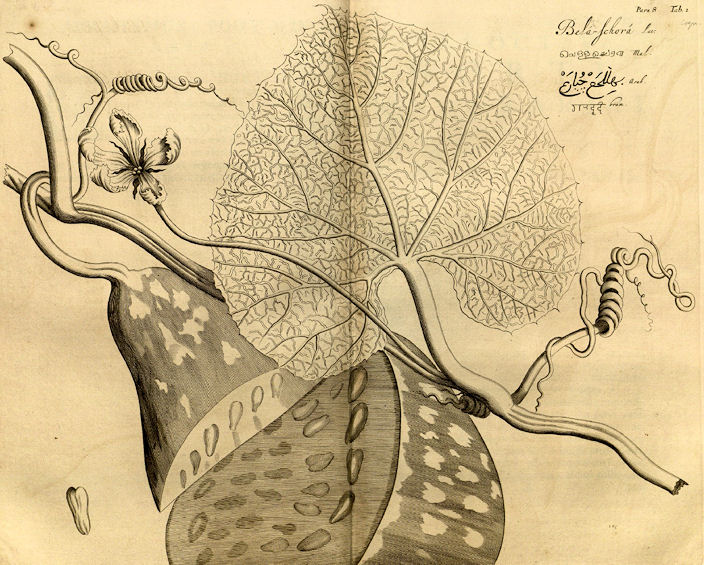
Abb.: Lagenaria siceraria (Molina) Standl. 1930 - Flaschenkürbis -
Calabash
[Bildquelle: Hortus malabaricus VIII. Fig. 1, 1688]
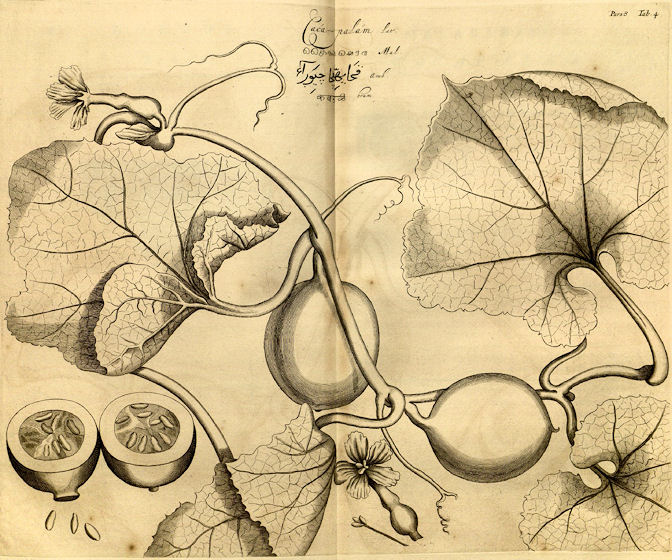
Abb.: Lagenaria siceraria (Molina) Standl. 1930 - Flaschenkürbis -
Calabash
[Bildquelle: Hortus malabaricus VIII. Fig. 4, 1688]
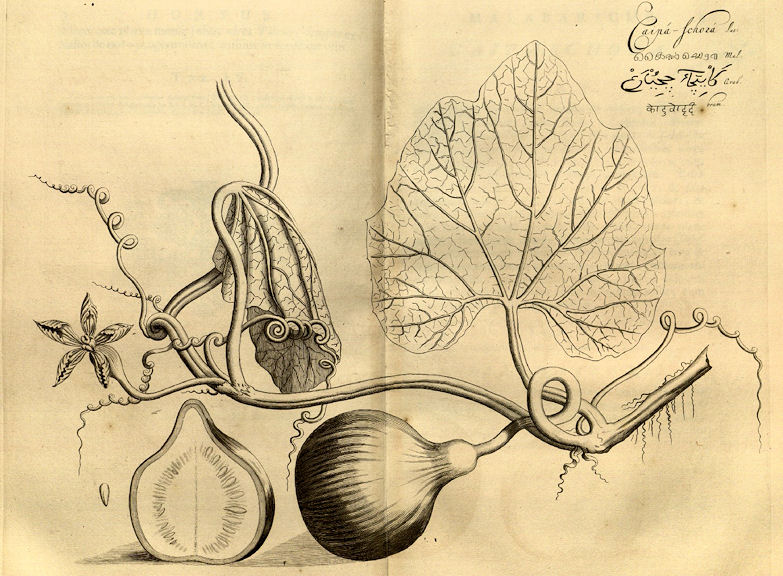 S
S
Abb.: Lagenaria siceraria (Molina) Standl. 1930 - Flaschenkürbis -
Calabash
[Bildquelle: Hortus malabaricus VIII. Fig. 5, 1688]
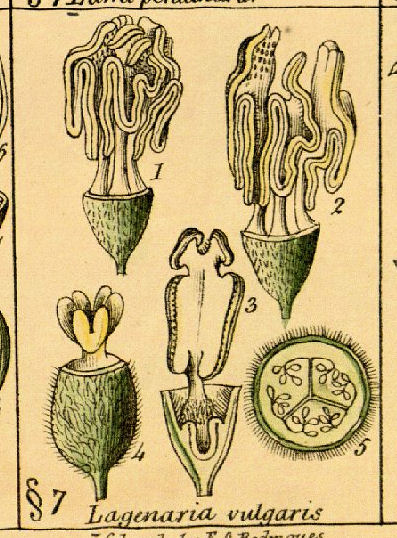
Abb.: Lagenaria siceraria (Molina) Standl. 1930 - Flaschenkürbis -
Calabash
[Bildquelle: Wight: Illustrations II, Tab. 105, 1850]
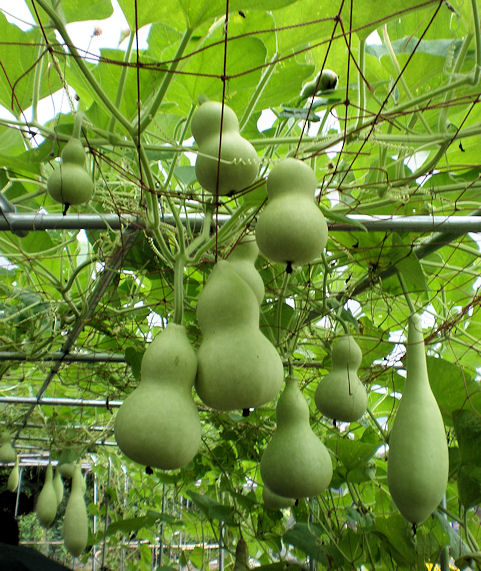
Abb.: Lagenaria siceraria (Molina) Standl. 1930 - Flaschenkürbis -
Calabash, Kyoto - 京都市,
Japan
[Bildquelle: Joel Abroad. --
http://www.flickr.com/photos/40295335@N00/3795233605/. -- Zugriff am
2010-10-24. --
Creative
Commons Lizenz (Namensnennung, keine kommerzielle Nutzung, share alike)]
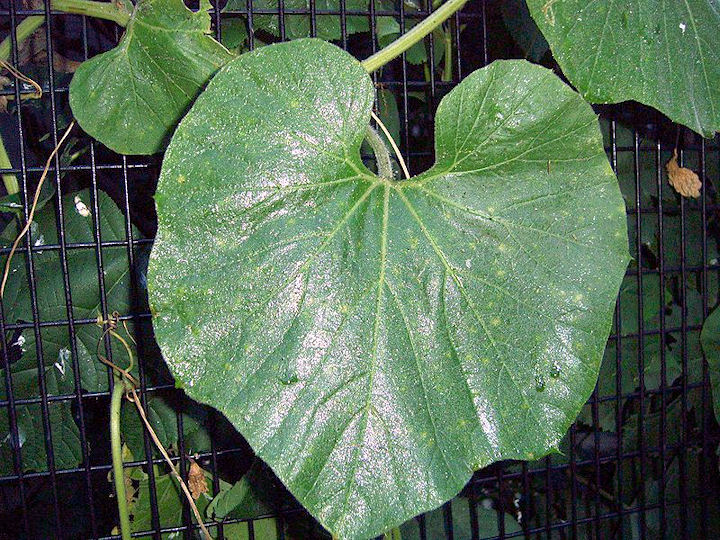
Abb.: Lagenaria siceraria (Molina) Standl. 1930 - Flaschenkürbis -
Calabash
[Bildquelle: Shizhao / Wikimedia. --
Creative Commons
Lizenz (Namensnennung, share alike)]
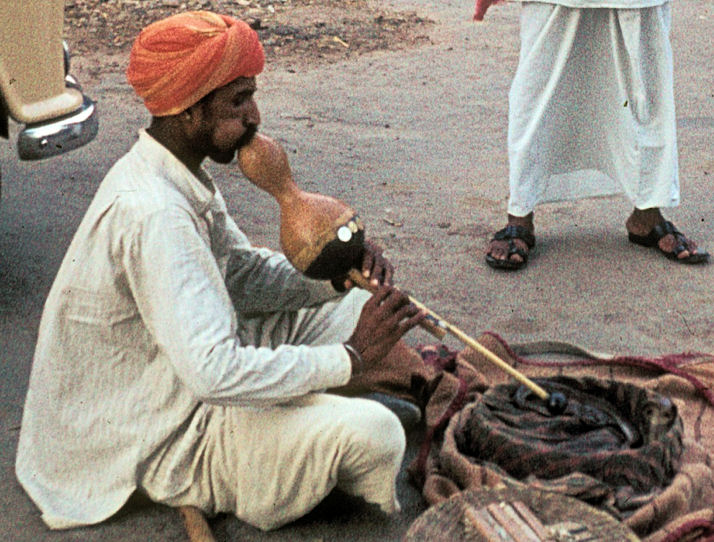
Abb.: Lagenaria siceraria (Molina) Standl. 1930 - Flaschenkürbis -
Calabash, New Delhi - नई दिल्ली
[Bildquelle: Roger McLassus / Wikimedia. -- GNU FDLicense]
"Cucurbita lagenaria. [= Lagenaria siceraria (Molina) Standl. 1930] Willd. iv. 60G.
[...]
Bela-schora. Rheed. Mal. viii. t, 1.
Cucurbita Lagenaria. Rumph. Amb. v. t, 144. bad.
Sans. Ulava.
A wild bitter variety is called Tita Laoo, by the Bengalees and Hindoos ; and Kutoo toombee in Sanscrit.
The shape of the fruit varies much, from that of a flask to round, and cylindric."
[Quelle: Roxburgh, William <1751-1815>: Flora indica, or, Descriptions of Indian plants / by the late William Roxburgh. -- Serampore : Printed for W. Thacker, 1832. -- Vol. 3, S. 718.]
"Lagenaria vulgaris (Ser.) [= Lagenaria siceraria (Molina) Standl. 1930] N. O. Cucurbitaceae. White Pumpkin. Bottle-gourd.
[...]
Descr.--Stem climbing [...] fruit bottle-shaped, yellow when ripe.
Fl. July—Sept.
W.&A. Prod. i. 341.
Cucurbita lagenaria, Linn. sp.—Roxb. Fl. Ind. iii. 718.—Rheede, viii t. i. 4, 5.
Cultivated.
Medical Uses.—The pulp of the fruit is often used in poultices ; it is bitter and slightly purgative, and may be used as a substitute for colocynth. A decoction of the leaves mixed with sugar is given in jaundice.
Economic Uses.—The fruit is known as the bottle-gourd. The poorer classes eat it, boiled, with vinegar, or fill the shells with rice and meat, thus making a kind of pudding of it. In Jamaica, and many other places within the tropics, the shells are used for holding water or palm-wine, and so serve as bottles. The hard shell, when dry, is used for faqueers' bottles, and a variety of it is employed in making the stringed instrument known as the Sitar, as well as buoys for swimming across rivers and transporting baggage. There is one kind, the fleshy part of which is poisonous.—Royle. Don."
[Quelle: Drury, Heber <1819 - 1872>: The useful plants of India : with notices of their chief value in commerce, medicine, and the arts. -- 2d ed. with additions and corrections. London : Allen, 1873. -- xvi, 512 p. ; 22 cm. -- s.v.]
"LAGENARIA VULGARIS, Seringe. [= Lagenaria siceraria (Molina) Standl. 1930]
Fig.—Rheede Hort. Mal. viii., L 5; Wight Ill., t. 105.
The bottle gourd
Hab.—Cultivated throughout India.
[...]
History, Uses, &c.—The shell of this gourd when dried is much used in the East as a vessel for holding fluids of all kinds, and for making the native guitar or Tambura. The fruit often attains an enormous size, and is used as a buoy for crossing rivers and transporting baggage. Amongst the Hindus as amongst the Greeks gourds are considered to be emblematic of fecundity, prosperity, and good health. There are two varieties of the bottle gourd, a sweet one, called in Sanskrit Alābu, and a bitter one known as Katutumbi. The fruit varies much in shape. The outer rind is hard and ligneous, and encloses a spongy white flesh, very bitter, and powerfully emetic and purgative. The seeds are grey, flat, and elliptical, surrounded by a border which is inflated at the sides but notched at the apex; their kernels are white, oily, and sweet. In India the pulp in combination with other drugs is used in native practice as a purgative; it is also applied externally as a poultice. The seeds were originally one of the four cold cucurbitaceous seeds of the ancients, but pumpkin seeds are now usually substituted for them.
The Hindus administer a decoction of the leaves in jaundice; it has a purgative action.
Toxicology.—Dr. Burton Brown notices the poisonous properties of the bitter variety of this gourd, the symptoms observed being similar to those after poisoning by elaterium or colocynth."
[Quelle: Pharmacographia indica : a history of the principal drugs of vegetable origin met with in British India / by William Dymock [1834-1892], C. J. H. Warden and David Hooper [1858-1947]. -- Bd. 2. -- London, 1891. -- S. 67f.]
Cucurbitaceae (Kürbisgewächse)
|
22. a./b. citrā gavākṣī goḍumbā
viśālā tv indravāruṇī चित्रा गवाक्षी गोडुम्बा विशाला त्व् इन्द्रवारुणी ।२२ क। [Bezeichnungen für Cucumis maderaspatanus L. 1753:]
|
Colebrooke (1807): "Another sort of cucumber. Cucumis Maderaspatanus."
1 गवाक्षी - gavākṣī f.: Kuhäugige
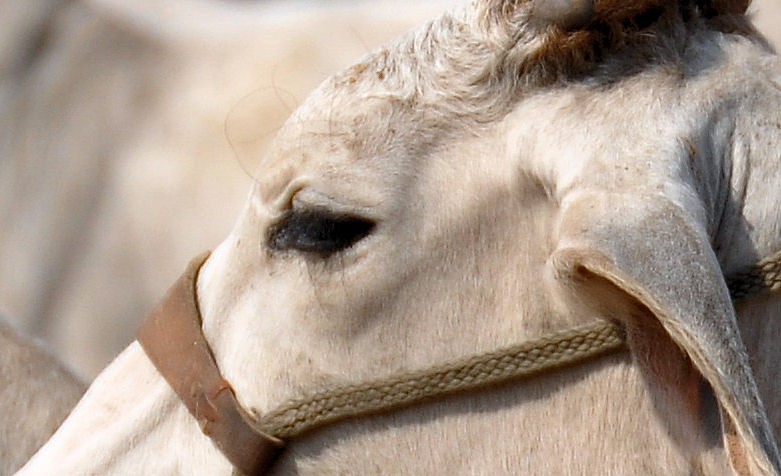
Abb.: Rindsauge (Zebuauge), Pushkar -
पुष्कर,
Rajasthan
[Bildquelle:
Shreyans
Bhansali. --
http://www.flickr.com/photos/thebigdurian/4174892287/.
-- Zugriff am 2011-01-13. --
Creative Commons Lizenz (Namensnennung,
keine kommerzielle Nutzung, share alike)]
Cucumis maderaspatanus L. 1753
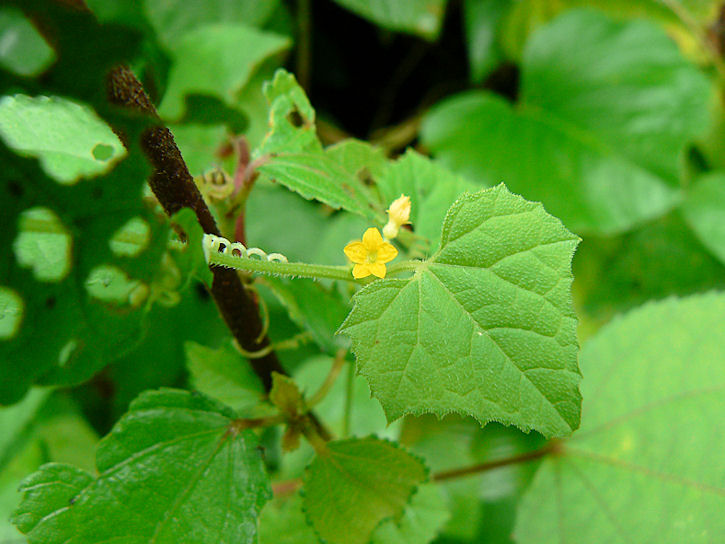
Abb.: Cucumis maderaspatanus L. 1753, Maharashtra
[Bildquelle: dinesh_valke. --
http://www.flickr.com/photos/dinesh_valke/1125887449/. -- Zugriff am
2010-10-24. --
Creative
Commons Lizenz (Namensnennung, keine kommerzielle Nutzung, keine
Bearbeitung)]
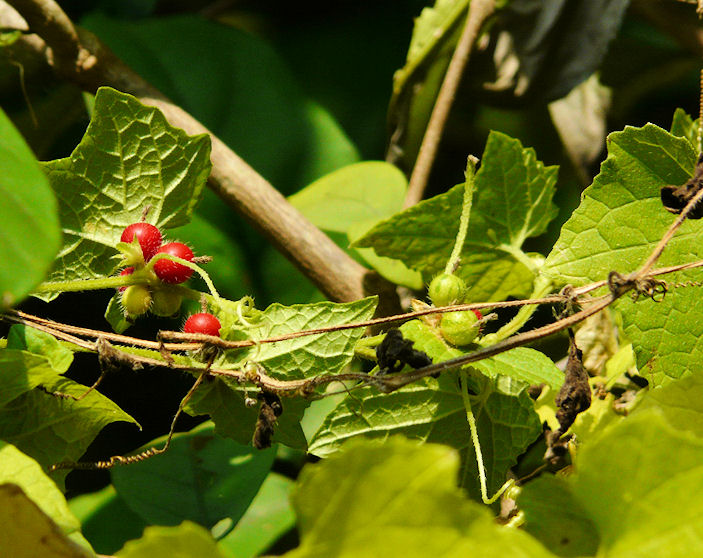
Abb.: गवाक्षी । चित्रा
। Cucumis maderaspatanus L. 1753, Maharashtra
[Bildquelle: dinesh_valke. --
http://www.flickr.com/photos/dinesh_valke/2953317375/. -- Zugriff am
2010-10-24. --
Creative
Commons Lizenz (Namensnennung, keine kommerzielle Nutzung, share alike)]
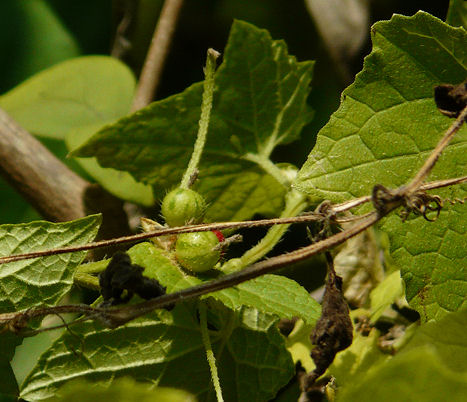
Abb.: गवाक्षी । चित्रा
। Cucumis maderaspatanus L. 1753, Maharashtra
[Bildquelle: dinesh_valke. --
http://www.flickr.com/photos/dinesh_valke/2953317375/. -- Zugriff am
2010-10-24. --
Creative
Commons Lizenz (Namensnennung, keine kommerzielle Nutzung, share alike)]
"Cucumis madraspatanus. Willd. iv. 615.
[...]
Till I saw Plukenet's figure of C. madraspatanus, I considered this to be the plant he meant, but now I hesitate not to say, that his is Bryonia scabrella ; however I have continued Linnaeus's specific name, although at the same time, I am in doubt whether or not this is the plant he so named. It is much like the two last described species [C. trigonis Roxb., C. turbinatus Roxb., grows in similar places, is about the same size, and in perfection at the same season, the leaves are more like those of the common cucumber, the fruit about the size of a partridge's egg, oval, downy, maculated, without any tending to be three-sided.
Note. The form of tlie fruit must be attended to, to distinguish these three last described species.
The fruit of this sort is used in food by the natives and much esteemed, yet they never take the trouble to cultivate the plant."
[Quelle: Roxburgh, William <1751-1815>: Flora indica, or, Descriptions of Indian plants / by the late William Roxburgh. -- Serampore : Printed for W. Thacker, 1832. -- Vol. 3, S. 723f.]
Cucurbitaceae (Kürbisgewächse)
|
22. a./b.
citrā gavākṣī goḍumbā
viśālā tv indravāruṇī चित्रा गवाक्षी गोडुम्बा विशाला त्व् इन्द्रवारुणी ।२२ क। [Bezeichnungen für Citrullus colocynthis (L.) Schrad. 1838 - Bitter-Melone - Bitter Apple:]
|
Colebrooke (1807): "Coloquintida. Cucumis Colocynthis [L. 1753 = Citrullus colocynthis (L.) Schrad. 1838]."
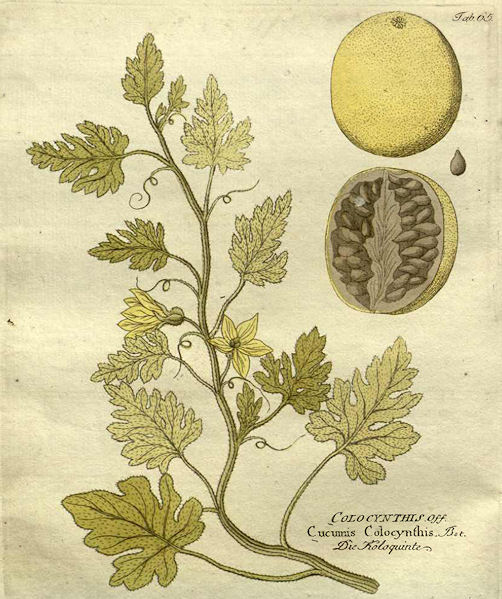
Abb.: Citrullus colocynthis (L.) Schrad. 1838 - Bitter-Melone - Bitter
Apple
[Bildquelle: Icones plantarum medico-oeconomico-technologicarum
cum earum fructus ususque descriptione =Abbildungen aller
medizinisch-ökonomisch-technologischen Gewächse mit der Beschreibung ihres
Gebrauches und Nutzens. -- Wien, 1800 - 1822. -- Bd. 1, Tab. 65]
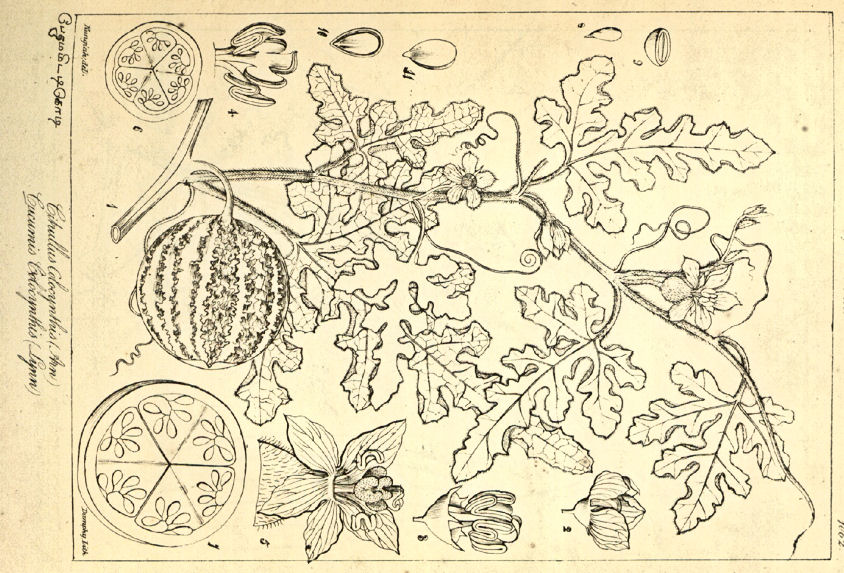
Abb.: Citrullus colocynthis (L.) Schrad. 1838 - Bitter-Melone - Bitter
Apple
[Bildquelle: Wight Icones II, Tab. 498, 1843]
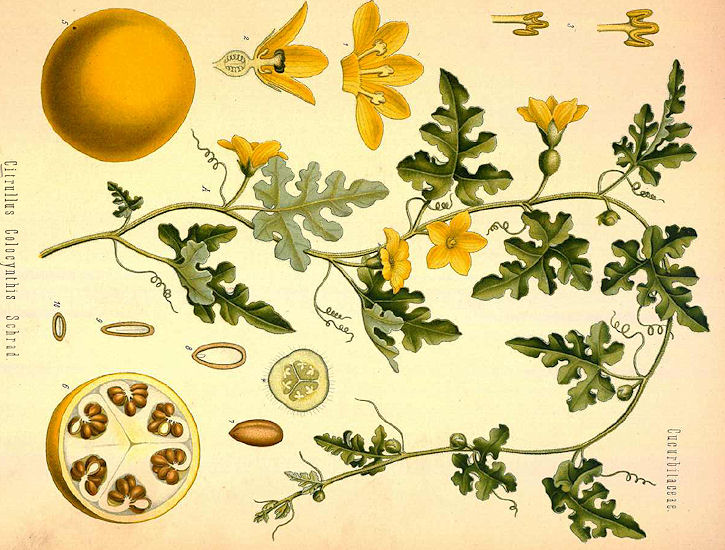
Abb.: विशाला । Citrullus colocynthis (L.) Schrad. 1838 - Bitter-Melone - Bitter
Apple
[Bildquelle: Köhler, 1883-1914]
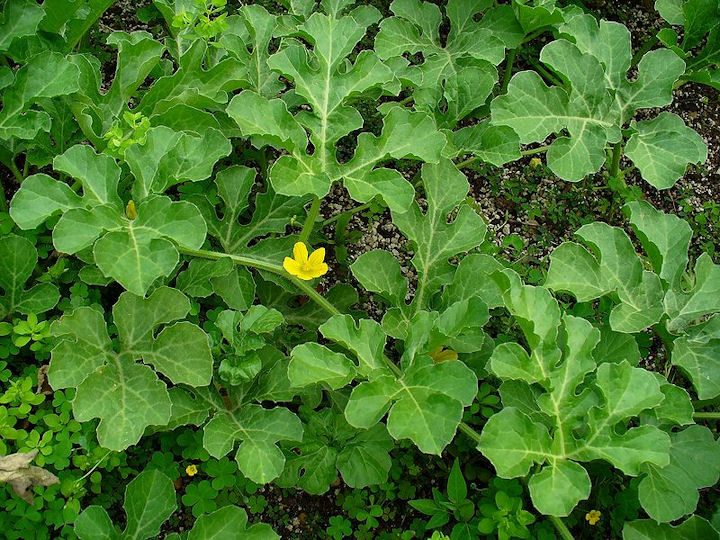
Abb.: विशाला । Citrullus colocynthis (L.) Schrad. 1838 - Bitter-Melone - Bitter
Apple, Karlsruhe
[Bildquelle: H. Zell / Wikimedia. -- GNU FDLicense]
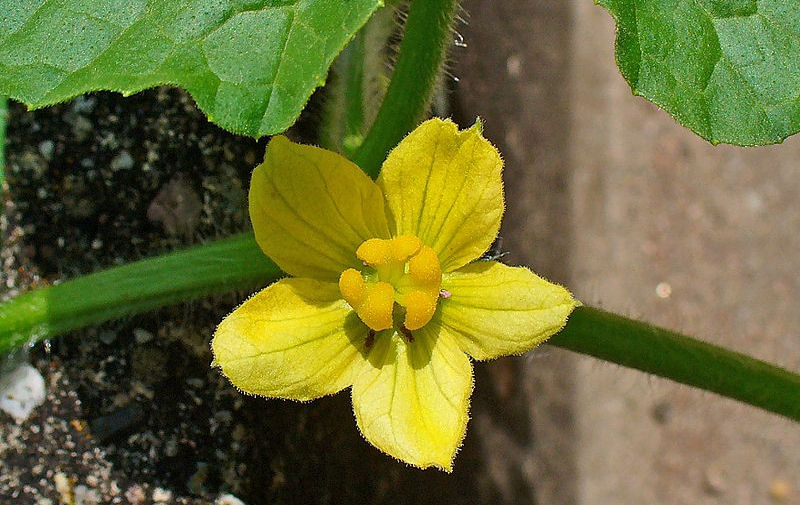
Abb.: Citrullus colocynthis (L.) Schrad. 1838 - Bitter-Melone - Bitter
Apple, Karlsruhe
[Bildquelle: H. Zell / Wikimedia. -- GNU FDLicense]
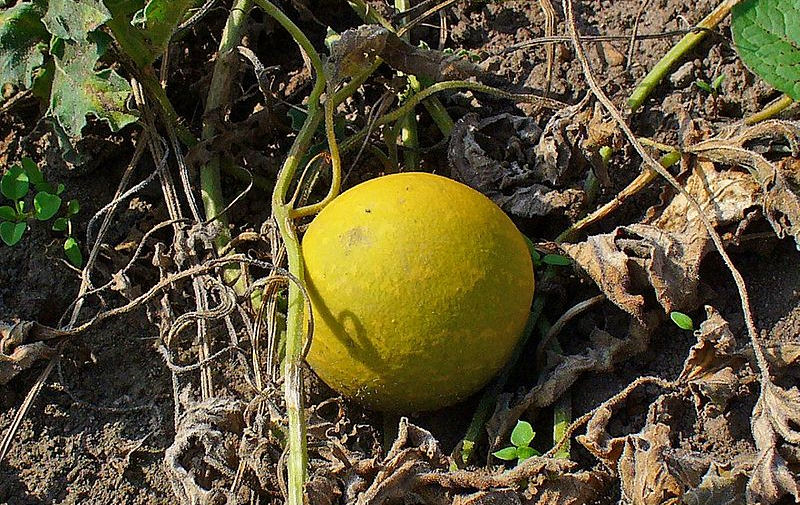
Abb.:
इन्द्रवारुणी
। Citrullus colocynthis (L.) Schrad. 1838 - Bitter-Melone - Bitter
Apple, Karlsruhe
[Bildquelle: H. Zell / Wikimedia. -- GNU FDLicense]
"Cucumis Colocynthis. Willd. iv. 61.
[...]
Common on the sandy lands of Coromandel."
[Quelle: Roxburgh, William <1751-1815>: Flora indica, or, Descriptions of Indian plants / by the late William Roxburgh. -- Serampore : Printed for W. Thacker, 1832. -- Vol. 3, S. 719f.]
"Citrullus Colocynthis (Schrad.) N. O. Cucurbitaceae.
Colocynth or Bitter Apple [...]
Description.—Annual; [...] flowers yellow.
Fl. July—September.
Cucumis colocynthis, Linn,—W. & A. Prod. i. 342.—Roxb. Fl Ind. iii. 719.— Wight Icon. t. 498.
Peninsula. Lower India in sandy plantations.
Medical Uses.—The Colocynth plant is properly a native of Turkey, but has long been naturalised in India. The medullary part of the fruit, freed from the rinds and seeds, is alone made use of in medicine. It is very bitter to the taste. The seeds are perfectly bland and highly nutritious, and constitute an important article of food in Africa, especially at the Cape of Good Hope. The extract of Colocynth is one of the most powerful and useful of cathartics. The juice of the fruit when fresh, mixed with sugar, is given in dropsy, and is externally applied to discoloration of the skin. A bitter and poisonous principle called Colocynthine resides in the fruit, the incautious use of which has frequently proved fatal. An oil is extracted from the seeds, used in lamps. Before exportation to Europe, the rind is generally removed from the fruit. In medicine its chief uses are for constipation and the removal of visceral obstructions at the commencement of fevers and other inflammatory complaints.—Ainslie. Lindley, Flor. Med.
Sheep, goats, jackals, and rats eat Colocynth apples readily, and with no bad effects. They are often used as food for horses in Scinde, cut in pieces, boiled, and exposed to the cold winter nights. They are made into preserves with sugar, having previously been pierced all over with knives, and then boiled in six or seven waters, until all the bitterness disappears. The low Gypsy castes eat the kernel of the seed, freed from the seed-skin by a slight roasting.— Stocks in Lond. Journ. Bot. iii 76."
[Quelle: Drury, Heber <1819 - 1872>: The useful plants of India : with notices of their chief value in commerce, medicine, and the arts. -- 2d ed. with additions and corrections. London : Allen, 1873. -- xvi, 512 p. ; 22 cm. -- s.v.]
CITRULLUS COLOCYNTHIS, Schrad. Fig.—Wight Ic. t. 498 ; Bentl. and Trim., 114.
Bitter apple
Hab.—India, Asia, Africa. ).
History, Uses, &c.—Wild colocynth is common in waste tracts of North-West, Central and South India, and ripens in the cold season. Aitchison observes that it is very common all over the desert country of Beluchistan, where it is called Khar-kuskta. The fresh fruit is brought for sale by the herbalists; it is grown in the North-West Provinces for the use of the Government Sanitary Establishments.Sanskrit writers describe the fruit as bitter, acrid, cathartic and useful in biliousness, constipation, fever and worms. They also mention the root as a useful cathartic in jaundice, ascites, enlargements of the abdominal viscera, urinary diseases, rheumatism, &c. Sarangadhara gives a receipt for a compound pill, which contains Mercury 1 part, Colocynth pulp, Sulphur, Cardamoms, Long Pepper, Chebulic myrobalans, and Pellitory root, of each 4 parts. The Sanskrit names for colocynth are Indravāruni and Vishālā. In India the fruit or root, with or without nux vomica, is rubbed into a paste with water and applied to boils and pimples. In rheumatism equal parts of the root and long pepper are given in pills. A paste of the root is applied to the enlarged abdomen of children. (Compare with Scrib. Comp. 80, and Pliny 20, 8.)
Mahometan writers call the colocynth plant Hanzal, and discuss its properties at great length. They consider it to be a very drastic purgative, removing phlegm from all parts of the system, and direct the fruit, leaves and root to be used. The drug is prescribed as with us, when the bowels are obstinately costive from disease or lesion of the nervous centres, also in dropsy, jaundice, colic, worms, elephantiasis, &c. Its irritant action upon the uterus is noticed, and fumigation with it is said to be of use for bringing on the menstrual flow. (Compare Hippocrates de morb. mulier. ii., 50.) The author of the Makhzan describes a curious method of administration. A small hole is made at one end of the fruit and pepper-corns are introduced, the hole is then closed, the fruit enveloped in a coating of clay and buried in the hot ashes near the fire-place for some days; the pepper is then removed and used as a carminative aperient. A similar preparation is made with rhubarb root instead of pepper. The same author tells us that the seeds are purgative, and mentions their use for preserving the hair from taming grey, a purpose for which "bitter apples" are apparently employed in England in the present day. As regards the purgative properties of the seeds he is incorrect, for when thoroughly washed they are eaten by the Arabs in time of famine. Colocynth was familiar to the Greeks and Romans. (
κολοκυνθις, Theophr. H. P. i., 19, 22. vii., 1, 3, 6; Dios. iv., 171; Colocynthis, Plin. 20,8)Description.—The Indian fruit is nearly globular, of the size of an orange, smooth, marbled with green and yellow when fresh, yellowish-brown when dry, and contains a scanty greyish-white pulp in which a number of brown seeds are embedded. This pulp in the fresh fruit is spongy and juicy, and occupies the whole of the interior of the fruit. Peeled colocynth is unknown in the Indian market except as an import from Europe. [...] All parts of the plant are very bitter, and the dust when dry very irritating to the eyes and nostrils."
[Quelle: Pharmacographia indica : a history of the principal drugs of vegetable origin met with in British India / by William Dymock [1834-1892], C. J. H. Warden and David Hooper [1858-1947]. -- Bd. 2. -- London, 1891. -- S. 59ff.]
Araceae (Aronstabgewächse)
|
22. c./d. arśoghnaḥ śūraṇaḥ kando
gaṇḍīras tu samaṣṭhilā अर्शोघ्नः सूरणः कन्दो गण्डीरस् तु समष्ठिला ॥२२ ख॥ [Bezeichnungen für Amorphophallus paeoniifolius (Dennst.) Nicolson 1977 - Elefantenkartoffel - Elephant Yam:]
|
Colebrooke (1807): "An esculent root. Arum campanulatum, Roxb. [= Amorphophallus paeoniifolius (Dennst.) Nicolson 1977]
1 अर्शोघ्न - arśogna m.: Vernichter von Hämorrhoiden
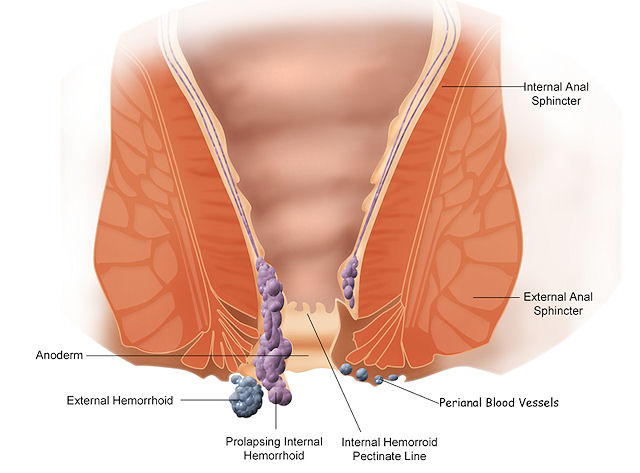
Abb.: अर्शः । Hämorrhoiden
[Bildquelle: WikipedianProlific /
Wikipedia. -- GNU FDLicense]
Amorphophallus paeoniifolius (Dennst.) Nicolson 1977 - Elefantenkartoffel - Elephant Yam
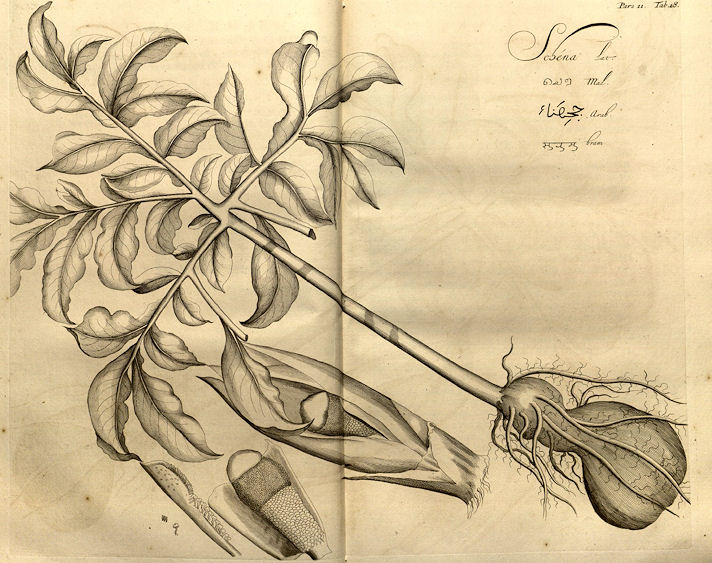
Abb.: कन्दः । Amorphophallus paeoniifolius (Dennst.) Nicolson 1977 -
Elefantenkartoffel - Elephant Yam
[Bildquelle: Hortus malabaricus XI. Fig. 18, 1692]
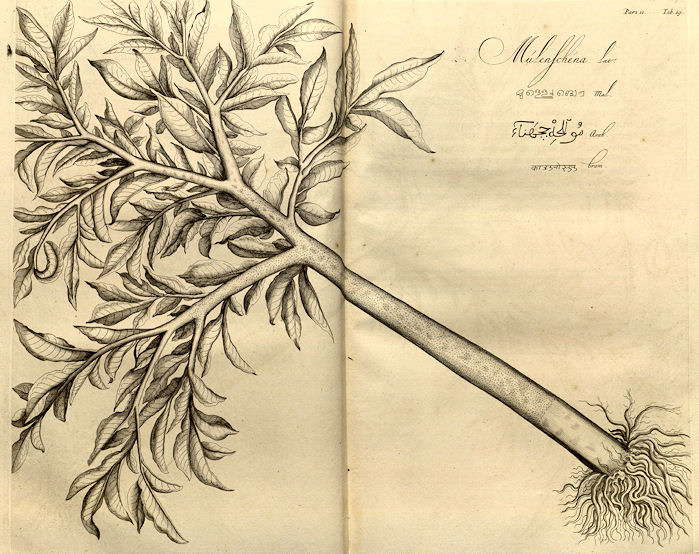
Abb.: Amorphophallus paeoniifolius (Dennst.) Nicolson 1977 -
Elefantenkartoffel - Elephant Yam
[Bildquelle: Hortus malabaricus XI. Fig. 19, 1692]
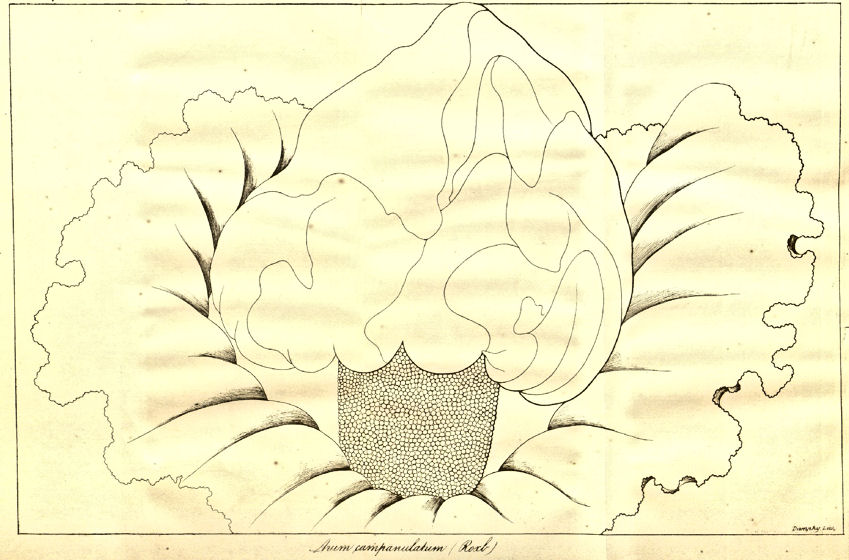
Abb.: Amorphophallus paeoniifolius (Dennst.) Nicolson 1977 -
Elefantenkartoffel - Elephant Yam
[Bildquelle: Wight Icones III, Tab. 782, 1846]
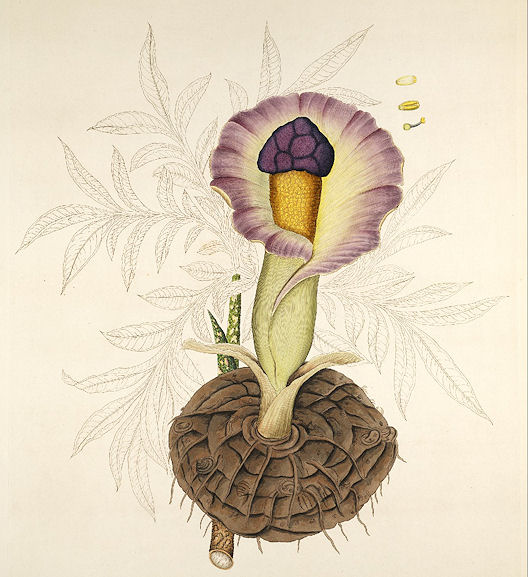
Abb.: Amorphophallus paeoniifolius (Dennst.) Nicolson 1977 -
Elefantenkartoffel - Elephant Yam
[Bildquelle: Roxburgh. -- Vol III. -- 1819. -- Tab. 272. -- Image courtesy
Missouri Botanical Garden.
http://www.botanicus.org. --
Creative Commons Lizenz
(Namensnennung, keine kommerzielle Nutzung)]
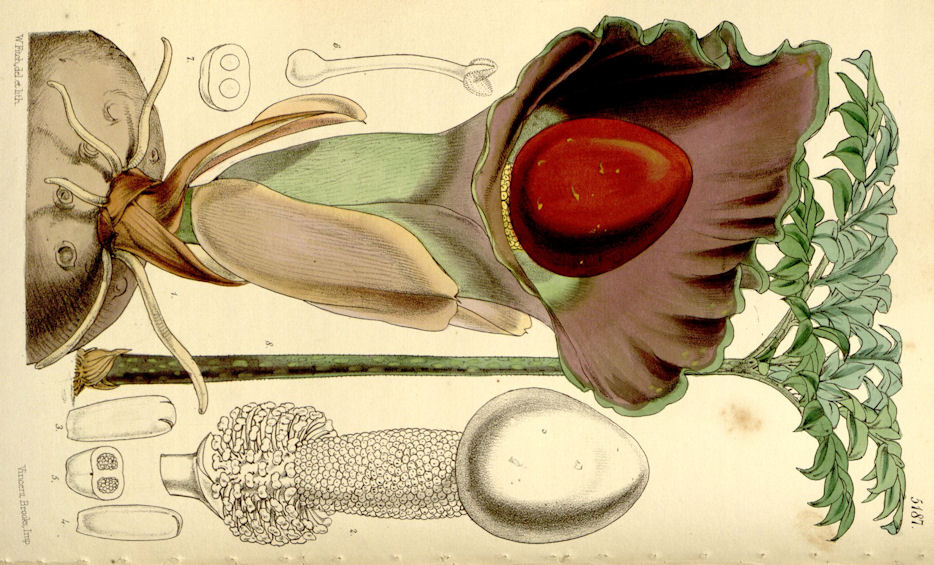
Abb.: Amorphophallus paeoniifolius (Dennst.) Nicolson 1977 -
Elefantenkartoffel - Elephant Yam
[Bildquelle: Curtis's Botanical Magazine 1860 / Wikimedia. -- Public domain]
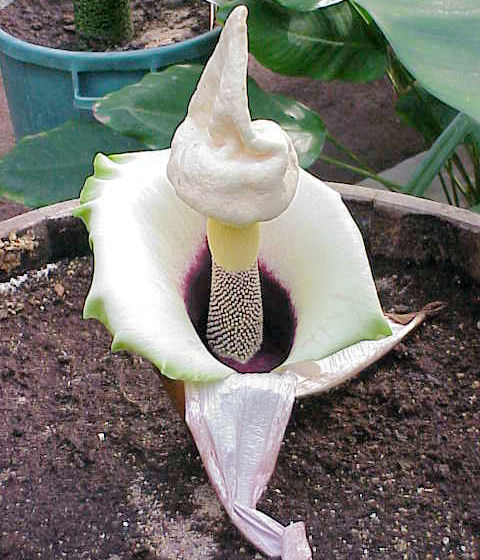
Abb.: Amorphophallus paeoniifolius (Dennst.) Nicolson 1977 -
Elefantenkartoffel - Elephant Yam
[Bildquelle: Kurt Stueber / Wikimedia. -- GNU FDLicense]
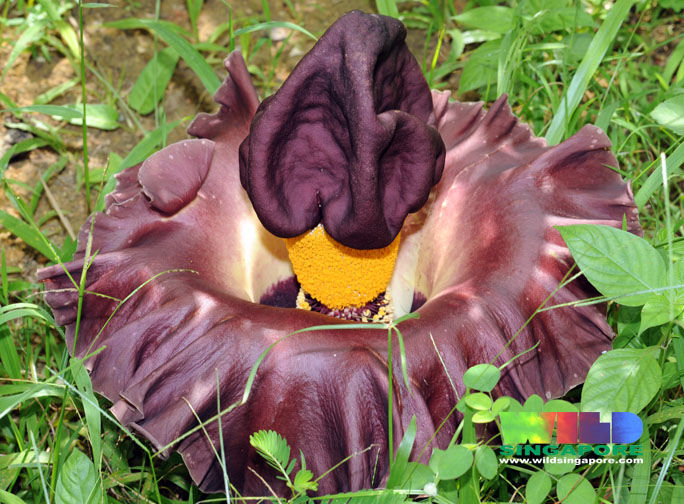
Abb.: शूरणः । Amorphophallus paeoniifolius (Dennst.) Nicolson 1977 -
Elefantenkartoffel - Elephant Yam, Singapur
[Bildquelle: Ria Tan. --
http://www.flickr.com/photos/wildsingapore/3015632246/. -- Zugriff am
2010-10-24. --
Creative
Commons Lizenz (Namensnennung, keine kommerzielle Nutzung, keine
Bearbeitung)]
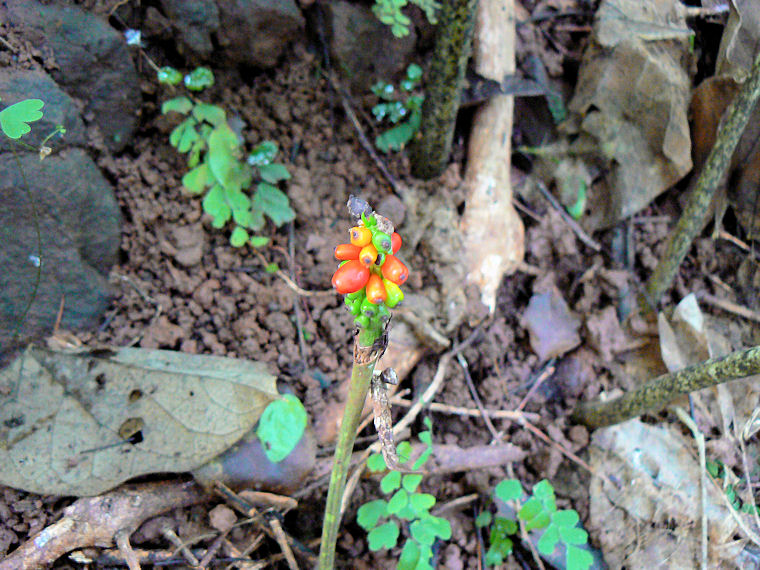
Abb.: Amorphophallus paeoniifolius (Dennst.) Nicolson 1977 -
Elefantenkartoffel - Elephant Yam
[Bildquelle: dinesh_valke. --
http://www.flickr.com/photos/dinesh_valke/1355525323/. -- Zugriff am
2010-10-24. --
Creative
Commons Lizenz (Namensnennung, keine kommerzielle Nutzung, keine
Bearbeitung)]
"Arum campanulatum. Roxb. [= Amorphophallus paeoniifolius (Dennst.) Nicolson 1977]
Stemless. [...]
Sans, Kunda or Kulla.
Tacca sativa, Rumph. Amb. v. p. 324. t. 112, the root and leaf, and Tacca phallifera, t. 113. f. 2. the flower, at which period not a leaf is to be found.
Schena and Mulen-Schena. Rheed. Mal. p. 11 .t. 18, and 19.
Found wild in damp places in the woods near Calcutta;
flowering time the beoinnino- of the rains.
Root perennial, tuberous, roundish, covered with a dark
brown skin, frequently, when in a good soil, as large as a
child's head ; from various parts of the chief root, there issue
small tuberosities, which are employed as offsets, to cultivate
the plant by.
[...] openings at the apex, at which to discharge the disk or pollen ; the immense quantity thereof that spews out from these openings and drops down in the pistils, is really inconceivable.
[...]
This species is much cultivated in the Northern Circars, and highly esteemed for the wholesomeness, and nourishing quality of the roots. It deserves to be called the Telinga potato. The usual time of cultivation is immediately after the first rains, in June. A very rich loose soil suits it best ; where the swelling of the root meets with little obstruction, and where they draw the greatest nourishment, for which reason it requires to be very well, and repeatedly ploughed. The small tuberosities that are found in the larger roots, are what they employ for sets, and are planted in the manner potatoes are in England, and about the same distance from one another. In twelve months they are reckoned fit to be taken up for use. The larger roots will then weigh, if the soil has been good, and the season favourable, from four to eight or more pounds each, they keep well if they are kept dry, and are by the natives employed as food, in the same manner as the common yam."
[Quelle: Roxburgh, William <1751-1815>: Flora indica, or, Descriptions of Indian plants / by the late William Roxburgh. -- Serampore : Printed for W. Thacker, 1832. -- Vol. 3, S. 509f.]
"Amorphophallus campanulatus (Blume). N. O. Araceae.
[...]
Description.—Stemless; [...]
Fl. June.
Wight Icon. t. 782.
Arum campanulatum, Roxb.—Rheede, Mal. xi. t. 18,19.
BengaL Peninsula.
Medical Uses.—The acrid roots are used medicinally in boils and ophthalmia. They are very caustic and abound in starch, and are employed as external stimulants, and are also emmenagogue.—(Lindley.) The fresh roots act as an acrid stimulant and expectorant, and are used in acute rheumatism.—Powell, Punj. Prod.
Economic Uses. —The roots are very nutritious, on which account they are much cultivated for the purpose of diet They are planted in May, and will yield from 100 to 250 maunds per beegah, selling at the rate of a rupee a maund. The roots are also used for pickling. Wight says that "when in flower the fetor it exhales is most overpowering, and so perfectly resembles that of carrion as to induce flies to cover the club of the spadix with their eggs." A very rich soil, repeatedly ploughed, suits it best. The small tuberosities found in the large roots are employed for sets, and planted in the manner of potatoes. In twelve months they are reckoned fit to be taken up for use; the larger roots will then weigh from 4-8 or more pounds, and keep well if preserved dry. The natives employ them for food in the manner of the common yam. The plant is the Chaneh or Mullum chanek of Rheede.—Jury Rep. M. E. Roxb."
[Quelle: Drury, Heber <1819 - 1872>: The useful plants of India : with notices of their chief value in commerce, medicine, and the arts. -- 2d ed. with additions and corrections. London : Allen, 1873. -- xvi, 512 p. ; 22 cm. -- s.v.]
"AMORPHOPHALLUS CAMPANULATUS, Blume
Fig.—Roxb. Cor. Pl. iii., t. 272 ; Bot. Mag,, t. 2812 ; Wight Ic., 785.
Hab.—India. Much cultivated.
[...]
History, Uses, &c.—This arum occurs as a wild plant on the banks of streams and also in several cultivated forms. It is the Surana and Olla of Sanskrit writers, and among other synonyms bears that of Arsoghna or "destroyer of piles." For medicinal use, Sarangadhara directs the tuber to be covered with a layer of earth, roasted in hot ashes, and administered with the addition of oil and salt. Several confections are also used, such as the Laghuouramamodaka, Vrihat surana modaka, &c.; these are made of the tubers of the plant with the addition of treacle, aromatics (ginger and pepper) and Plumbago root, and are given in doses of about 200 grains once a day in piles and dyspepsia.
The dried tubers of the wild plant, peeled and cut into segments, are sold in the shops under the name of Madam-mast. The segments are usually threaded upon a string, and are about as large as those of an orange, of a reddish-brown colour, shrunken and wrinkled, brittle and hard in dry weather; the surface is mammillated. When soaked in water they swell up and become very soft and friable, developing a sickly smell. A microscopic examination shows that the root is almost entirely composed of starch. Madan-mast has a mucilaginous taste, and is faintly bitter and acrid; it is supposed to have restorative powers, and is in much request; it is fried in ghi with spices and sugar. It is interesting to note that the tubers of the greater Dracontia (Diosc, ii., 155) were preserved by the Greeks in the same manner for medicinal use. The cultivated plant is largely used as a vegetable ; under cultivation it loses much of its acridity and grows to an enormous size.
Synantheria sylvatica, Schott, is regarded by the Hindus as a kind of wild Surana, and, with the wild form of Amorphophallus campanulatus bears the Sanskrit name of Vajra-kanda "thunder-bolt." The country-people use the crushed seed to cure toothache; a small quantity is placed in the hollow tooth and covered with cotton; it rapidly benumbs the nerve; they also use it as an external application to bruises on account of its benumbing effect. In the Concan the seeds rubbed into a paste with water are applied repeatedly to remove glandular enlargements. The fruit is yellow, about the shape and size of a grain of maize, closely set round the upper part of the spike, which is several feet in height, and as large as that of the plantain. [...] The taste is intensely acrid, after a few seconds it causes a most painful burning of the tongue and lips, which lasts for a long time, causing much salivation and subsequent numbness. [...]
The tubers of Sanromatum pedatum, Schott., are very acrid, and are used externally under the names of Bhasamkand and Lot as a stimulating poultice. The plant is extremely common, and its pedate leaves appear with the first rain in June. The flower, which is produced just before the rains, seldom attracts notice, being more or less buried in the soil. The tubers are about as large as small potatoes, and of the same shape as those of the Surana."
[Quelle: Pharmacographia indica : a history of the principal drugs of vegetable origin met with in British India / by William Dymock [1834-1892], C. J. H. Warden and David Hooper [1858-1947]. -- Bd. 3. -- London, 1893. -- S. 546f.]
Synantherias sylvatica (Roxb.) Schott 1858
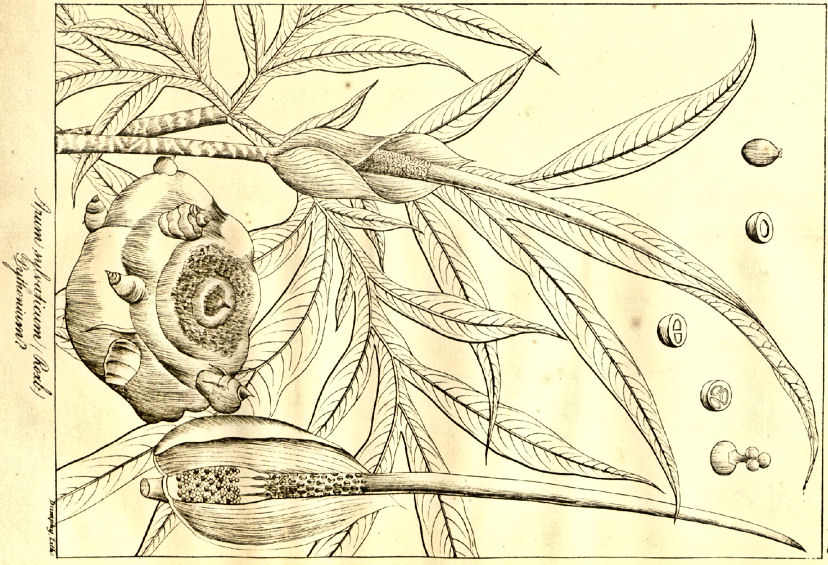
Abb.: Synantherias sylvatica (Roxb.) Schott 1858
[Bildquelle: Wight Icones III, Tab. 802, 1846]
|
22. c./d.
arśoghnaḥ sūraṇaḥ kando
gaṇḍīras tu samaṣṭhilā अर्शोघ्नः सूरणः कन्दो गण्डीरस् तु समष्ठिला ॥२२ ख॥ [Bezeichnungen für ???:]
|
Colebrooke (1807): "A potherb. Described as growing on watery ground."
Convolvulaceae (Windengewächse)
|
23. a./b. kalamby
upodikāstrī tu mūlakaṃ
hilamocikā कलम्ब्य् उपोदिकास्त्री तु मूलकं हिलमोचिका ।२३ क। कलम्बी - kalambī f.: Kalambī = Ipomoea aquatica Forssk. 1775 - Wasserspinat - Water Spinach |
Colebrooke (1807): [23.a-c:] "Various sorts of potherbs. Severally named in the text."
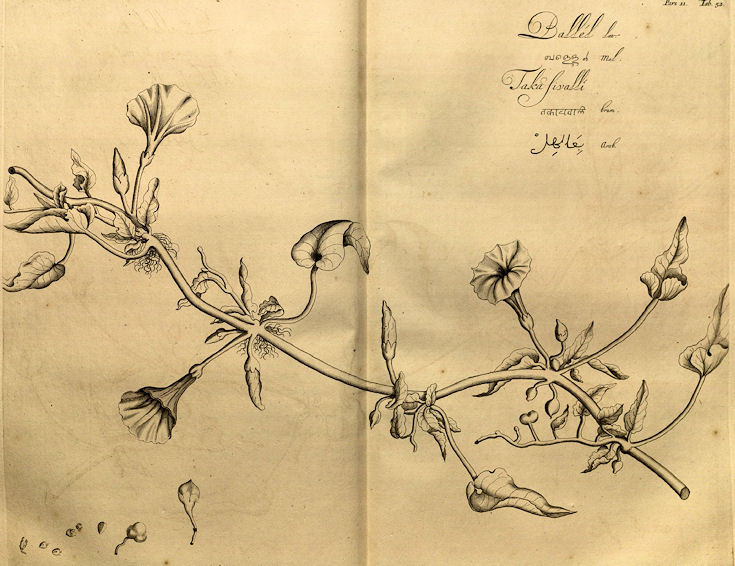
Abb.: कलम्बी । Ipomoea aquatica Forssk. 1775 - Wasserspinat - Water Spinach
[Bildquelle: Hortus malabaricus XI. Fig. 52, 1692]
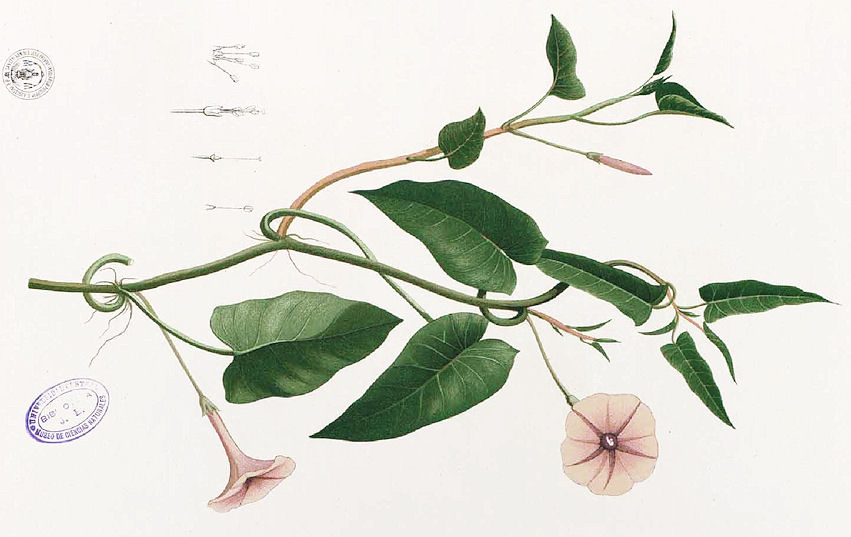
Abb.: कलम्बी । Ipomoea aquatica Forssk. 1775 - Wasserspinat - Water Spinach
[Bildquelle: Flora de Filipinas, 1880 / Wikipedia. -- Public domain]
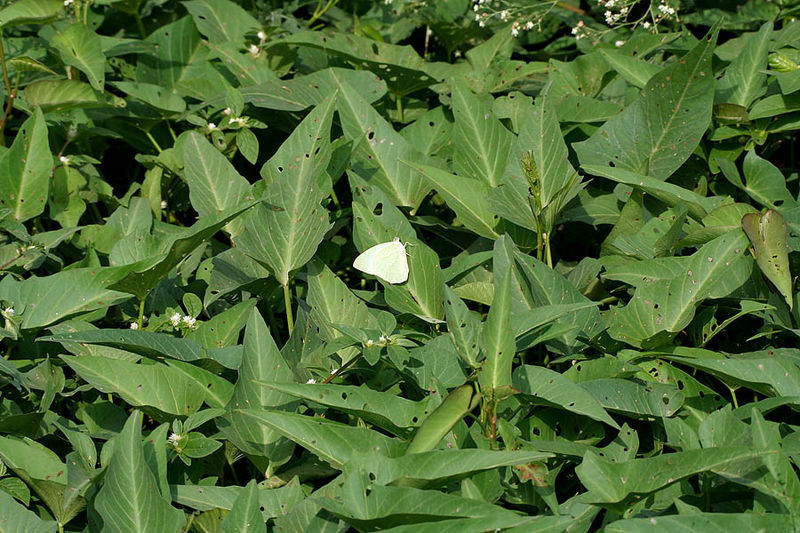
Abb.: कलम्बी । Ipomoea aquatica Forssk. 1775 - Wasserspinat - Water Spinach,
Hyderabad -
హైదరాబాద్ -
حیدرآباد, Andhra Pradesh
[Bildquelle: J. M. Garg / Wikimedia. -- GNU FDLicense]
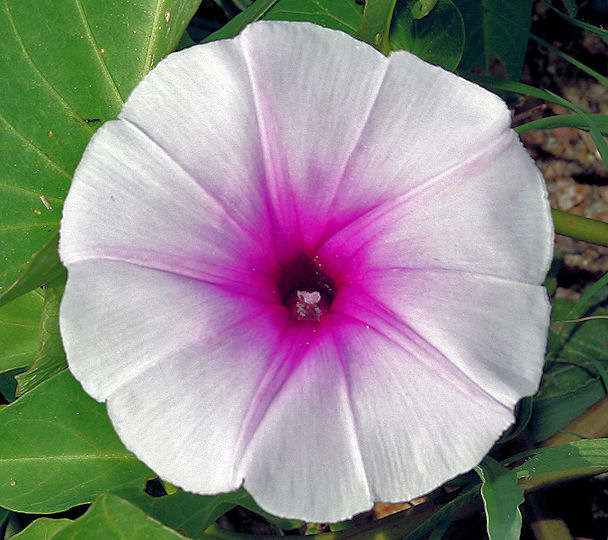
Abb.: कलम्बी । Ipomoea aquatica Forssk. 1775 - Wasserspinat - Water Spinach,
Hyderabad -
హైదరాబాద్ -
حیدرآباد, Andhra Pradesh
[Bildquelle: J. M. Garg / Wikimedia. -- GNU FDLicense]
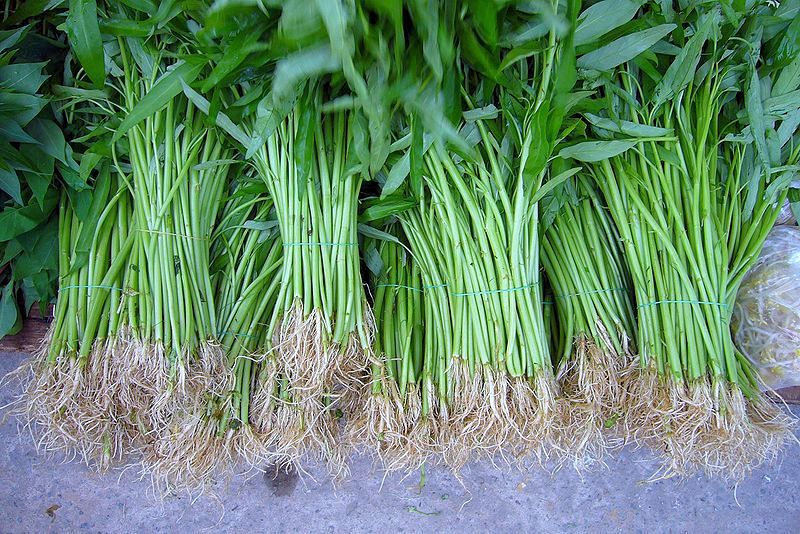
Abb.: कलम्बी । Ipomoea aquatica Forssk. 1775 - Wasserspinat - Water Spinach, Markt
in Kuching, Sarawak, Malaysia
[Bildquelle: Eric in SF / Wikimedia. -- GNU FDLicense]
"Ipomoea aquatica, Forsk., Rheede, Hort. Mal. xi., t. 52, is commonly used as a vegetable. It is called Kalambi m Sanskrit." [Quelle: Pharmacographia indica : a history of the principal drugs of vegetable origin met with in British India / by William Dymock [1834-1892], C. J. H. Warden and David Hooper [1858-1947]. -- Bd. 2. -- London, 1891. -- S. 540.]
Basellaceae (Basellgewächse)
|
23. a./b.
kalamby
upodikāstrī tu mūlakaṃ hilamocikā कलम्ब्य् उपोदिकास्त्री तु मूलकं हिलमोचिका ।२३ क। उपोदिका - upodikā f.: Upodikā = Basella alba L. 1753 - Indischer Spinat - Indian Spinach |
Colebrooke (1807): siehe zum Vorherigen.
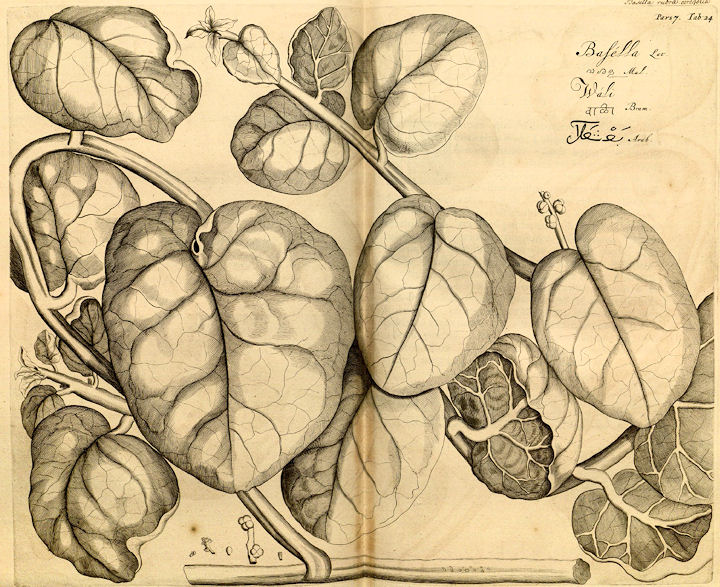
Abb.:
उपोदिका । Basella alba L. 1753 - Indischer Spinat - Indian Spinach
[Bildquelle: Hortus malabaricus VII. Fig. 24, 1686]
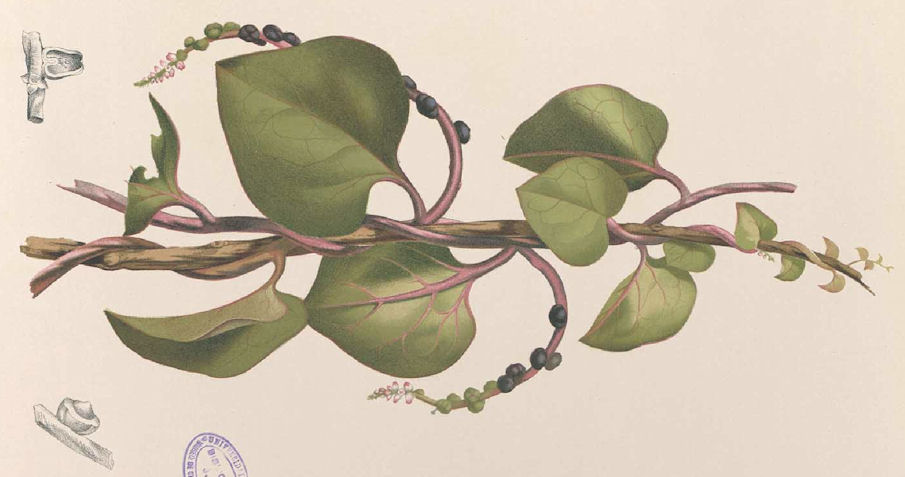
Abb.:
उपोदिका । Basella alba L. 1753 - Indischer Spinat - Indian Spinach
[Bildquelle: Flora de Filipinas, 1880 / Wikipedia. -- Public domain]
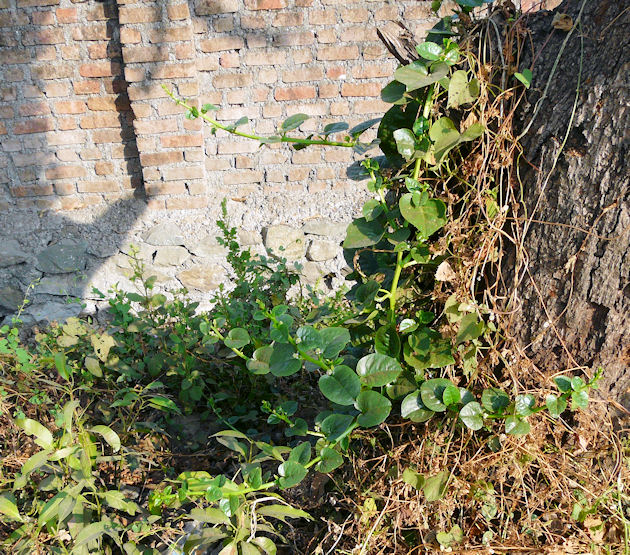
Abb.:
उपोदिका । Basella alba L. 1753 - Indischer Spinat - Indian Spinach,
Maharashtra
[Bildquelle: dinesh_valke. --
http://www.flickr.com/photos/dinesh_valke/3126360851/. -- Zugriff am
2010-10-24. --
Creative
Commons Lizenz (Namensnennung, keine kommerzielle Nutzung, share alike)]
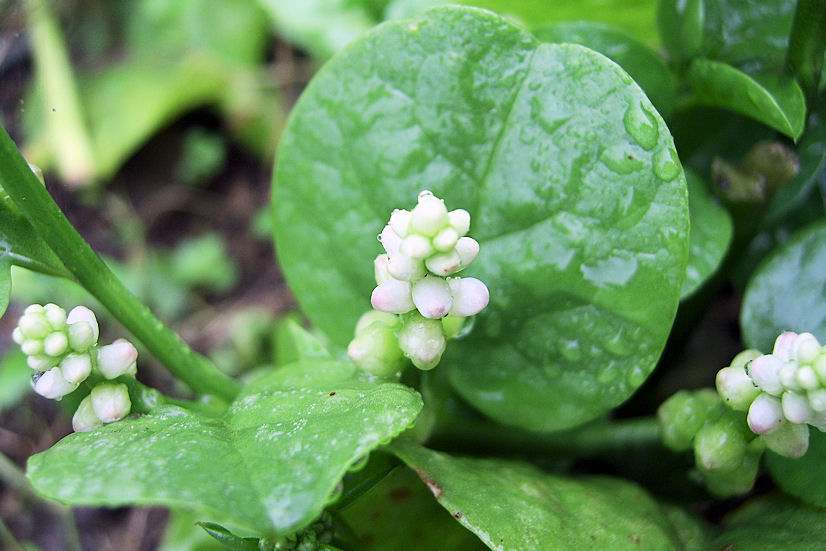
Abb.:
उपोदिका । Basella alba L. 1753 - Indischer Spinat - Indian Spinach
[Bildquelle: Shizhao / Wikimedia. -- GNU FDLicense]
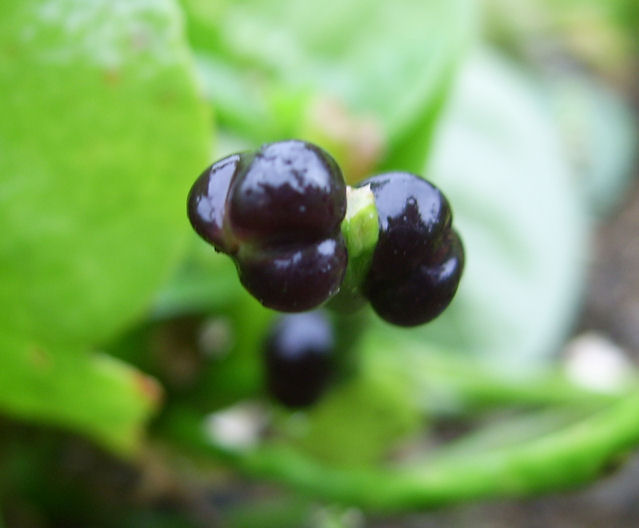
Abb.:
उपोदिका । Basella alba L. 1753 - Indischer Spinat - Indian Spinach
[Bildquelle: Shizhao / Wikimedia. -- GNU FDLicense]
"Basella alba. Willd. 1. 1514.
Perennial, twining.
[...]
Gandola alba. Rumph. amb. 5. p. 417.
The natives of the Coromandel coast reckon five varieties of this ; three of these are cultivated, and two wild ;
the wild sorts are,
Yerra, or Poha-batsalla, the Telinga name of the red wild Batsalla. [...] Basella rubra. Willd. 1. 1513. Gandola rubra. Rumph. amb. 5. 417. t. 154. f. 2. bad. Is found wild in hedges, &c. twining round other plants to a considerable extent, the stems, and branches smooth, as thick as a quill, and deeply tinged red.
Alla-batsalla, above mentioned, grows with the last in hedges, and differs from it only in the colour of the stems, and branches ; here they are always pale green.
The cultivated sorts are ;
1st. Yerra, or red garden Batsalla. It differs from the wild red in being more luxuriant ; it is not much cultivated.
2nd. Mattoo, or white Garden Batsalla. [...] Like the last, it differs from the wild white only in being more luxuriant, according to the nature of the soil, and is much cultivated. The above two are generally raised from the seeds.
3d, Pedda, or large Batsalla of the Telingas. B. lucida, and cordifolia. Willd. 1. 1514. [...] Basella. Rheed. Mal. 7. t. 24. This is much cultivated, and always from slips taken from the old plants ; it grows to a great size running over extensive, trellises, erected for the purpose, and generally about the houses of the natives, where its numerous, large, succulent branchlets and leaves form a most agreeable shade to protect them from the heat of the sun. This variety is also more used as a pot herb by the natives, than any of the other four, though all are reckoned equally wholesome.
I think the whole may be reckoned varieties of one species, and probably Basella Japanica Burm. ind. t. 39. f. 4. is nothing more than from a stunted specimen of one of these varieties."
[Quelle: Roxburgh, William <1751-1815>: Flora indica, or, Descriptions of Indian plants / by the late William Roxburgh. -- Serampore : Printed for W. Thacker, 1832. -- Vol. 2, S. 104f.]
"Basella alba, Linn., Wight Ic, t. 896, is known as Indian spinach, or Malabar Nightshade, and the juice of the leaves, which is demulcent and cooling, is a popular application to allay the heat and itching of urticaria arising from dyspepsia, an affection which the Hindus consider to be indicative of bile in the blood. The boiled leaves are also used as a poultice. This herb is extensively cultivated as a vegetable, [...] The generic name is derived from the Tamil. The Sanskrit name is Potaki or Upodika."
[Quelle: Pharmacographia indica : a history of the principal drugs of vegetable origin met with in British India / by William Dymock [1834-1892], C. J. H. Warden and David Hooper [1858-1947]. -- Bd. 3. -- London, 1893. -- S. 148.]
Brassicaceae (Kreuzblütengewächse)
|
23. a./b.
kalamby upodikāstrī tu mūlakaṃ
hilamocikā कलम्ब्य् उपोदिकास्त्री तु मूलकं हिलमोचिका ।२३ क। मूलक - mūlaka m. n.: Wurzeliger = Raphanus sativus L. 1753 - Rettich - Radish |
Colebrooke (1807): siehe zum Vorherigen.
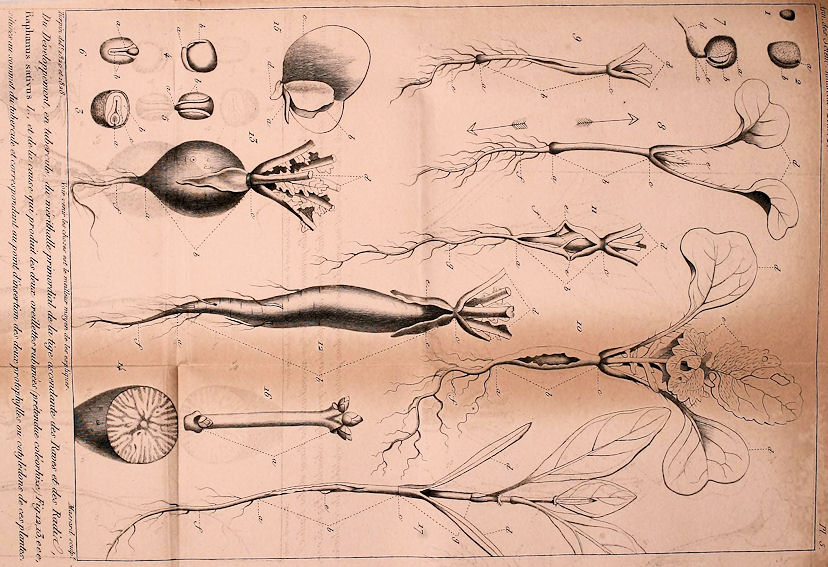
Abb.: मूलकम् । Raphanus sativus L. 1753 - Rettich - Radish
[Bildquelle: Annales des sciences naturelles. -- Paris. -- Vol. 21 (1830). --
Tab. 5]
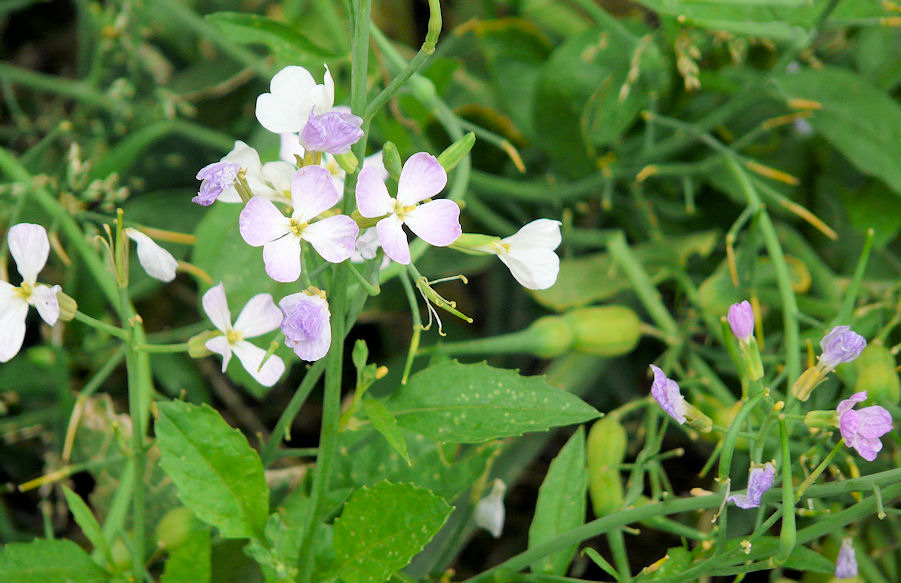
Abb.: मूलकम् । Raphanus sativus L. 1753 - Rettich - Radish, Manali - मनाली,
Himachal Pradesh
[Bildquelle: dinesh_valke. --
http://www.flickr.com/photos/dinesh_valke/2560911922/. -- Zugriff am
2010-10-24. --
Creative
Commons Lizenz (Namensnennung, keine kommerzielle Nutzung, share alike)]
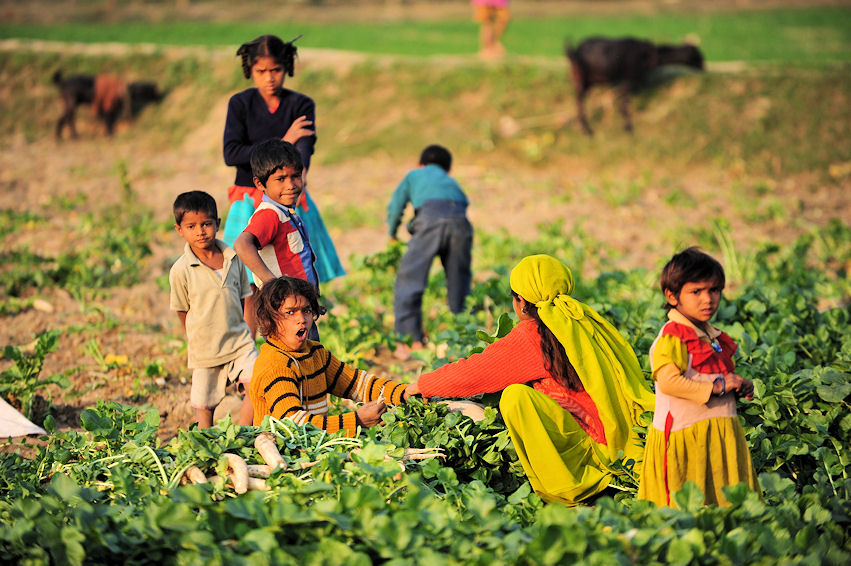
Abb.: Rettichernte, Indien
[Bildquelle: Jacob Mee. --
http://www.flickr.com/photos/jacobmee/4423823059/. -- Zugriff am 2010-10-24.
-- Creative
Commons Lizenz (Namensnennung, keine kommerzielle Nutzung, keine
Bearbeitung)]
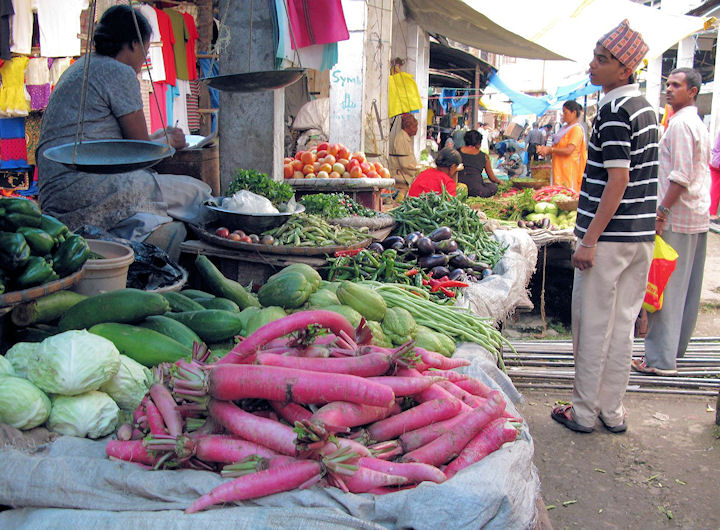
Abb.: मूलकानि । Rettiche, Kalimpong - কালিম্পং, West Bengal
[Bildquelle: hockadilly. --
http://www.flickr.com/photos/hockadilly/2910737356/. -- Zugriff am
2010-10-24. -- Creative
Commons Lizenz (Namensnennung, keine kommerzielle Nutzung)]
"Raphanus sativus. Willd. iii. 560.
[...]
Sans, Mooluka.
The sort cultivated in Bengal is a pale red variety, the root of which grows to the size of a man's leg, or more, and is only half immersed in the soil. It thrives best during the dry season."
[Quelle: Roxburgh, William <1751-1815>: Flora indica, or, Descriptions of Indian plants / by the late William Roxburgh. -- Serampore : Printed for W. Thacker, 1832. -- Vol. 3, S. 126.]
"RAPHANUS SATIVUS, Linn.
Fig.—Lam. Ill., t. 566.
Radish. [...]
Mulaka (sans.)
Description.—A large, coarse white radish, is universally cultivated in India. The seeds Bazr-el-fujl (Arab.) are used as a diuretic, laxative and lithontriptic; also the juice of the fresh leaves. The root and seeds yield with water a milky distillate, from which a small quantity of oil may be obtained by rectification ; it is colourless, heavier than water, and has the taste but not the smell of radishes. The oil contains sulphur; it forms a white precipitate with corrosive sublimate, and yellow with bichloride of platinum. It dissolves with tolerable facility in water.—(Pless, in Gmelin's Handbook, X., 56)."
[Quelle: Pharmacographia indica : a history of the principal drugs of vegetable origin met with in British India / by William Dymock [1834-1892], C. J. H. Warden and David Hooper [1858-1947]. -- Bd. 1. -- London, 1890. -- S. 129.]
Asteraceae (Korbblütler)
|
23. a./b.
kalamby upodikā strī tu mūlakaṃ
hilamocikā कलम्ब्य् उपोदिका स्त्री तु मूलकं हिलमोचिका ।२३ क। हिलमोचिका - hilamocikā f.: Hilamocikā = Enhydra fluctuans Lour. |
Colebrooke (1807): siehe zu den Vorigen.
"Enhydra fluctans [sic!], Lour., Hilamochika or Hilamochi, (Sans.), [...] a glabrous or pubescent marsh plant of Eastern Bengal and Silhet, with sessile, linear-oblong, acute or obtuse, entire or subcrenate leaves, from one to three inches in length, and with axillary or terminal, sessile flower heads ; is used as a bitter vegetable in Bengal; and is considered to be laxative and useful in diseases of the skin and nervous system. The juice of the leaves in doses of about one tola (180 grains) is also prescribed.
This plant is unknown in Western and Southern India."
[Quelle: Pharmacographia indica : a history of the principal drugs of vegetable origin met with in British India / by William Dymock [1834-1892], C. J. H. Warden and David Hooper [1858-1947]. -- Bd. 2. -- London, 1891. -- S. 266.]
|
23. c./d. vāstukaṃ śākabhedāḥ syur
dūrvā tu śataparvikā वास्तुकं शाखभेदाः स्युर् दूर्वा तु शतपर्विका ॥२३ ख॥ वास्तुक - vāstuka n.: Unkraut = ??? All dies sind Gemüsearten. |
Colebrooke (1807): siehe zu den Vorigen.
Poaceae (Süßgräser)
|
23. c./d.
vāstukaṃ śākabhedāḥ syur
dūrvā tu śataparvikā 24. sahasravīryā-bhārgavyau ruhānantātha sā sitā golomī śatavīryā ca gaṇḍālī śakulākṣakaḥ
वास्तुकं शाखभेदाः स्युर्
दूर्वा तु शतपर्विका ॥२३ ख॥ [Bezeichnungen für Cynodon dactylon (L.) Pers. 1805 - Gewöhnliches Hundszahngras - Bahama Grass:]
Weiß2 heißt sie:
|
Colebrooke (1807): "Bent grass. Agrostis linearis, Koen. [= Cynodon dactylon (L.) Pers. 1805]" [24.b-d:] "A similar grass with white blossoms. Agrostis diandra [Retz 1789 = Sporobolus diander (Retz.) P. Beauv. 1812 - Indian Dropseed] ? Some refer two of these terms to one species ; and the two remaining, to another."
1 भार्गवी - bhārgavī f.: Frau des Bhṛgu-Sohns (= Śukra)
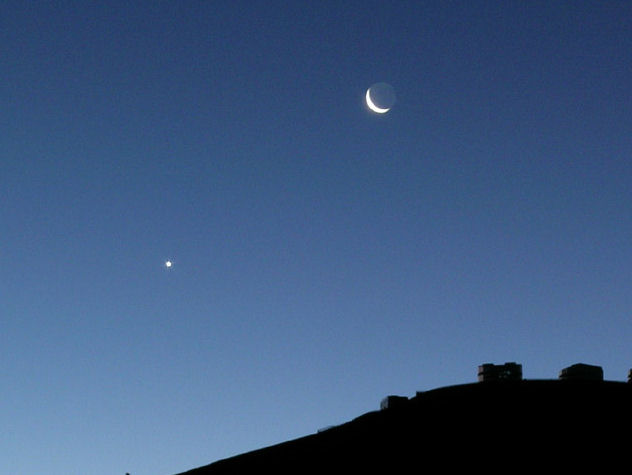
Abb.: Planet Venus
[Bildquelle: Gerhard Hüdepohl / Wikipedia]
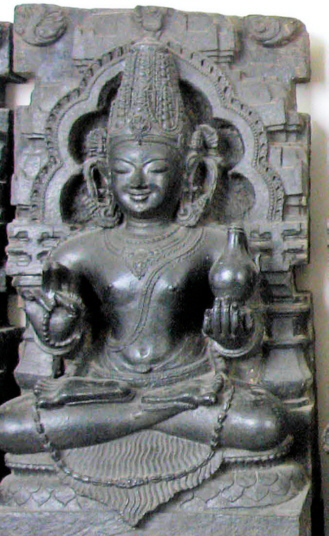
Abb.: Śukra - Venus
[Bildquelle: Redtigerxyz / Wikipedia. -- GNU FDLicense]
"ŚUKRA. The planet Venus and its regent. Śukra was son of Bhṛgu and priest of Bali and the Daityas (Daitya-guru). He is also called the son of Kavi. His wife's name was Śuśumā or Śata-parvā. His daughter Devayānī married Yāyati of the Lunar race, and her husband's infidelity induced Śukra to curse him. Śukra is identified with Uśanas, and is author of a code of law. The Hari-vaṃśa relates that he went to Śiva and asked for means of protecting the Asuras against the gods, and for obtaining his object he performed "a painful rite, imbibing the smoke of chaff with his head downwards for a thousand years." In his absence the gods attacked the Asuras and Viṣṇu killed his mother, for which deed Śukra cursed him "to be born seven times in the world of men." Śukra restored his mother to life, and the gods being alarmed lest Śukra s penance should be accomplished, Indra sent his daughter Jayantī to lure him from it. She waited upon him and soothed him, but he accomplished his penance and afterwards married her. Śukra is known by his patronymic Bhārgava, and also as Bhṛgu. He is also Kavi or Kāvya, 'the poet'. The planet is called Āsphujit, Ἀφροδίτη ; Maghā-bhava, 'son of Maghā'; Ṣodaśāṃśu, 'having sixteen rays' and Śveta, the white."
[Quelle: Dowson, John <1820-1881>: A classical dictionary of Hindu mythology and religion, geography, history, and literature. -- London, Trübner, 1879. -- s.v. ]
2 weiß
vermutlich handelt es sich um keine eigene Art, Unterart oder Varietät, sondern um die - weißen - reifen Ähren von Cynodon dactylon. Siehe die nächste Anmerkung.
3 गोलोमी - golomī f.: Rinds-Haarige
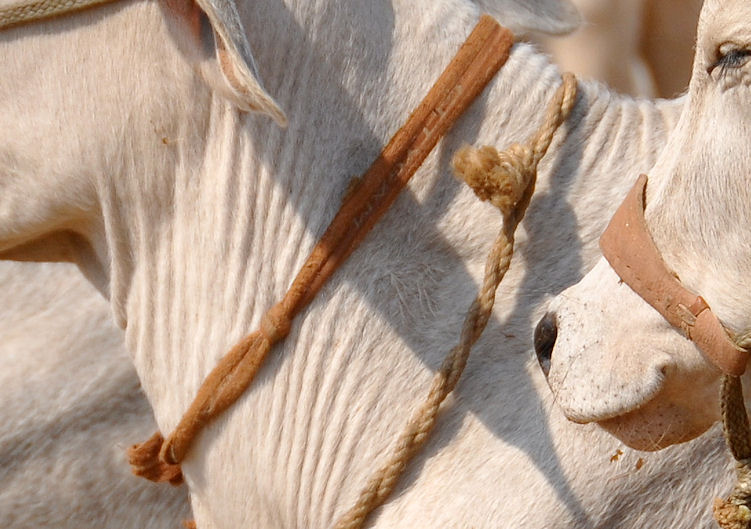
Abb.: गोलोम । Rindshaar (Zebuhaar), Pushkar -
पुष्कर, Rajasthan
[Bildquelle:
Shreyans Bhansali.
--
http://www.flickr.com/photos/thebigdurian/4174892287/. -- Zugriff am
2011-01-13. --
Creative
Commons Lizenz (Namensnennung, keine kommerzielle Nutzung, share alike)]
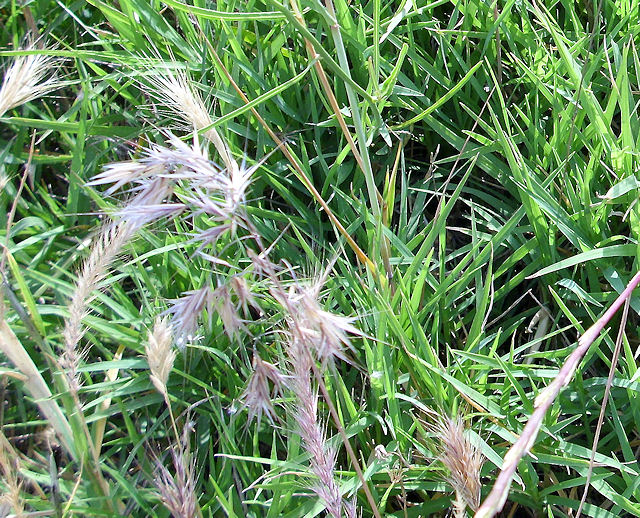
Abb.:
गोलोमी । Reife Ähren von Cynodon dactylon (L.) Pers. 1805 - Gewöhnliches Hundszahngras -
Bahama Grass, Spanien
[Bildquelle: Javier martin / Wikimedia. -- Public domain]
3 शकुलाक्षक - śakulākṣaka m.: Śakula-Äugige
śakula m.: eine - von mir nicht identifizierte - Fischart
Cynodon dactylon (L.) Pers. 1805 - Gewöhnliches Hundszahngras - Bahama Grass
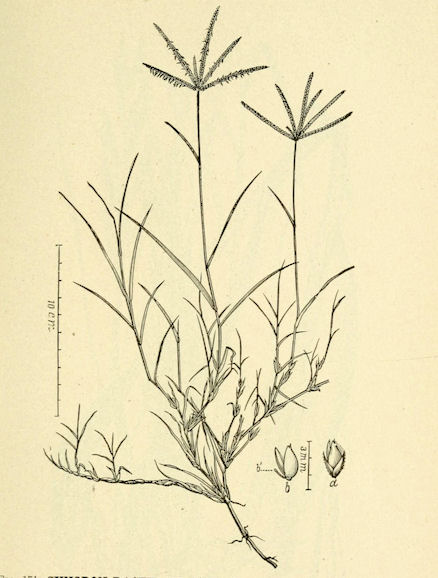
Abb.:
दूर्वा । Cynodon dactylon (L.) Pers. 1805 - Gewöhnliches Hundszahngras -
Bahama Grass
[Bildquelle: American grasses. I. (Illustrated) / by F. Lamson-Scribner. --
Washington DC, 1900. -- S. 177]
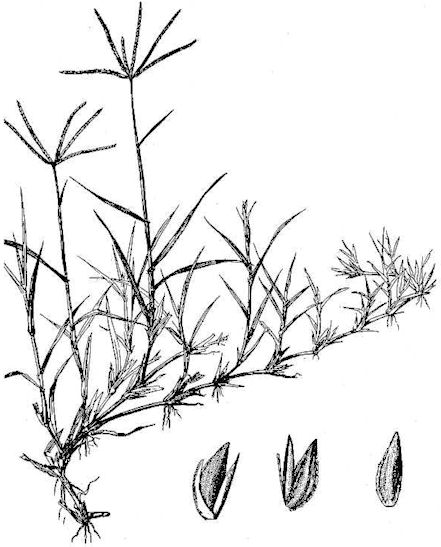
Abb.:
दूर्वा । Cynodon dactylon (L.) Pers. 1805 - Gewöhnliches Hundszahngras -
Bahama Grass
[Bildquelle: USDA / Wikimedia. -- Public domain]
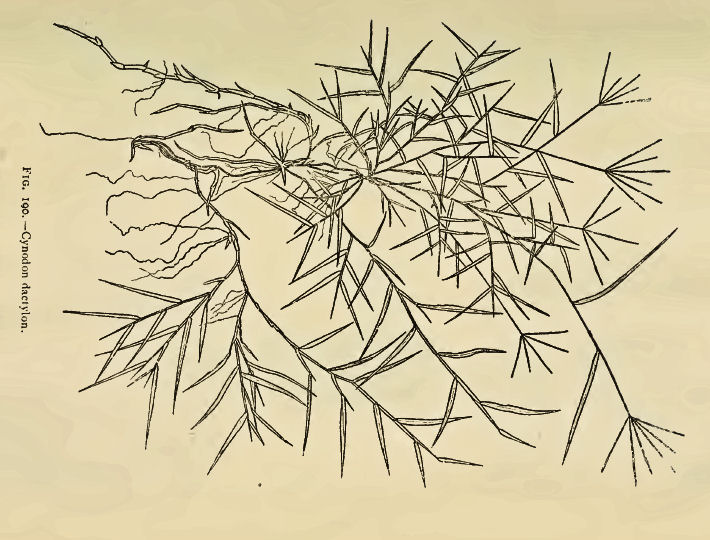
Abb.:
दूर्वा । Cynodon dactylon (L.) Pers. 1805 - Gewöhnliches Hundszahngras -
Bahama Grass
[Bildquelle: A handbook of some south Indian grasses / by K. Rai
Bahadur K. Ranga Achariyar ; assisted by C. Tadulinga Mudaliyar. -- Madras,1921.
- S. 249]
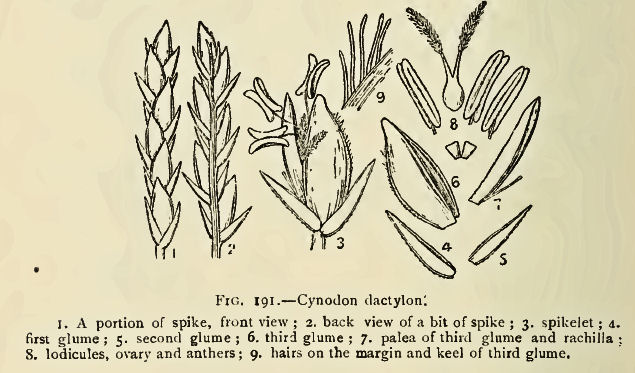
Abb.:
दूर्वा । Cynodon dactylon (L.) Pers. 1805 - Gewöhnliches Hundszahngras -
Bahama Grass
[Bildquelle: A handbook of some south Indian grasses / by K. Rai
Bahadur K. Ranga Achariyar ; assisted by C. Tadulinga Mudaliyar. -- Madras,1921.
- S. 250]
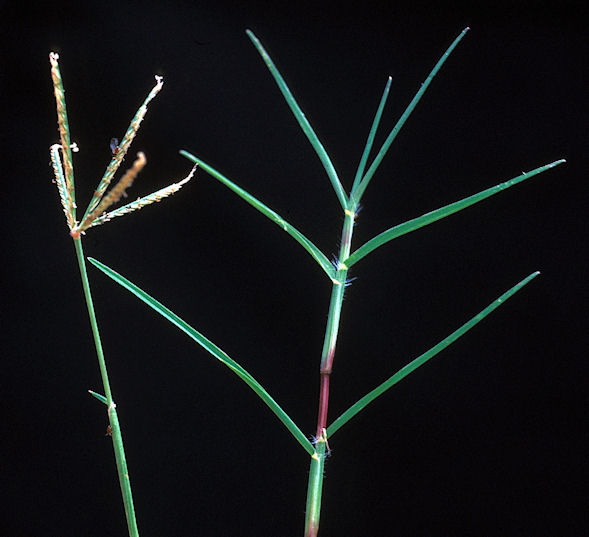
Abb.:
दूर्वा । Cynodon dactylon (L.) Pers. 1805 - Gewöhnliches Hundszahngras -
Bahama Grass, Philippinen
[Bildquelle: IRRI images. --
http://www.flickr.com/photos/ricephotos/857620232/. -- Zugriff am
2010-10-24. --
Creative
Commons Lizenz (Namensnennung, keine kommerzielle Nutzung, share alike)]
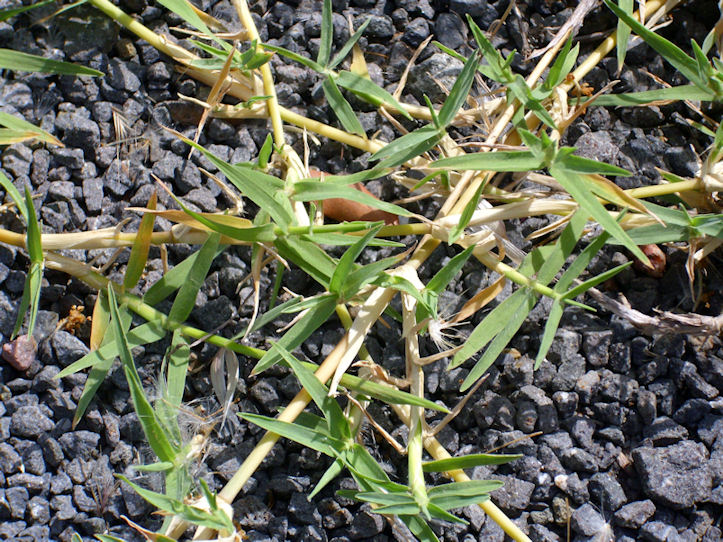
Abb.:
दूर्वा । Cynodon dactylon (L.) Pers. 1805 - Gewöhnliches Hundszahngras -
Bahama Grass, Spanien
[Bildquelle: Javier martin / Wikimedia. -- Public domain]
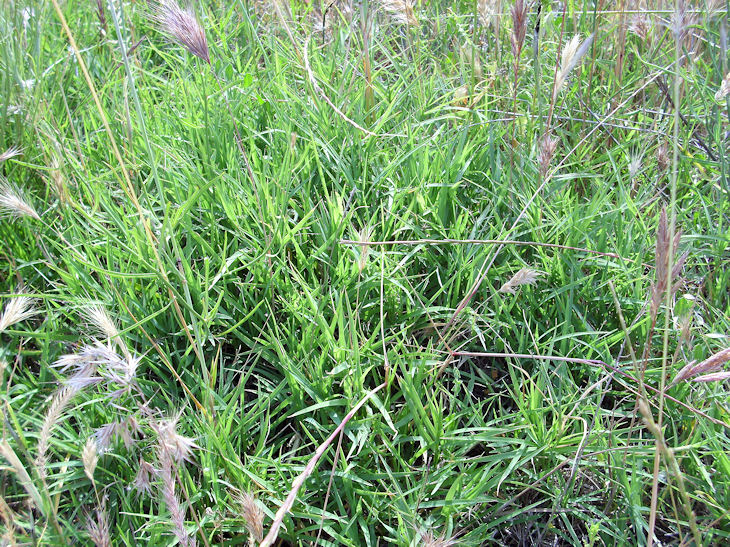
Abb.:
गोलोमी । Cynodon dactylon (L.) Pers. 1805 - Gewöhnliches Hundszahngras -
Bahama Grass, Spanien
[Bildquelle: Javier martin / Wikimedia. -- Public domain]
"Panicum Dactylon. Linn. sp. pl. ed. Willd. i. 342.
Smooth, creeping. [...]
Agrostis linearis. Linn. sp. pl. ed. Willd. i. 375. Retz. Obs. iv. N. 51. Sir W. Jones. Asiat. Res. iv. p. 248.
Sans. Doorva, Shutupurvika, Suhusruveerya, Bharguvee, Ourooha, Ununta.
[...]
This is by far the most common and useful grass in India. It grows every where abundantly, and flowers all the year.
Root creeping. Culms creeping, with their flower-bearing branchlets erect, from six to twelve inches high, smooth.
[...]
Obs. This most valuable grass forms three-fourths of the food of our horses and cows in India. It is by the brahmins of the coasts held sacred to Ganesha, (the Janus of the ancients,) under the name of Doorwall."
[Quelle: Roxburgh, William <1751-1815>: Flora indica, or, Descriptions of Indian plants / by the late William Roxburgh. -- Serampore : Printed for W. Thacker, 1832. -- Vol. 1, S. 289.]
"Cynodon dactylon (Pers.) N. O. Graminaceae. Huriallee Grass [...]
Description.—Culms creeping, with flower-bearing branchlets, erect, 6-12 inches high, smooth; [...]
Fl. All the year.
Panicum dactylon, Linn.—Roxb. Fl. Ind. ed. Car. i. 289.
Agrostis linearis, Retz.
Both Peninsulas. Bengal
Economic Uses.—One of the commonest of Indian grasses, growing everywhere in great abundance. It forms the greater part of the food of cattle in this country. Respecting this grass Sir W. Jones observes (As. Res. iv. 242) that "it is the sweetest and most nutritious pasture for cattle." Its usefulness, added to its beauty, induced the Hindoos to celebrate it in their writings. The natives, too, eat the young leaves, and make a cooling drink from the roots. —(Roxb.) On account of its rooting stolons and close growth, when watered it is well adapted for turfing. From universal testimony it is the best of all our grasses for fattening and milk-producing powers.—Stewart's Punj. Plants."
[Quelle: Drury, Heber <1819 - 1872>: The useful plants of India : with notices of their chief value in commerce, medicine, and the arts. -- 2d ed. with additions and corrections. London : Allen, 1873. -- xvi, 512 p. ; 22 cm. -- s.v.]
"CYNODON DACTYLON, Pers.
Fig.—Eng. Bot. xii., t. 850; Fl. Graec., i, t. 60.
Creeping Dog's-tooth-grass
Hab.—Plains of India, westward to the south of England.
Vernacular.--Durva [...]
History, Uses, &b.—This grass must have first attracted the attention of the ancient Hindus by its value as a food for their cattle. A modern Indian proverb says—Zamindāri dūb ki jār hai (an estate like the roots of the Dūb, i.e., is always bearing). The plant has many synonyms in Sanskrit, such as Granthi "knotted," Sveta ' white," Bhārgavi "belonging to Sukra" (the regent of the planet Venus), Ruha "growing," Dur-mara "not easily dying," &c. Nanak Shah thus apostrophizes himself:—
Nanak! nannhā ho raho jaisi nannhi dūb!
Aur ghās jal jāengi, dūb khūb ki khūb.Be modest Nanak! as the fresh soft Dūb doth lowly lie,
Whilst other grasses scorched up are, the Dūb's bloom ne#er doth die. (Fallon.)In the Rig-Veda (x., 134) misfortunes are prayed to depart like the Dūrva whose seeds fall far from the plant; an allusion to the far-spreading habit of this grass, which has also given rise to the proverbial expression "Dūb ki nal" (the sheath of the Dūb) as applied to family connections, so called from their tendency to spread far and wide like the Dūb. Like other useful plants this grass was deified by the Hindus; in the Atharva-Veda it is thus addressed— "May Dūrva which rose from the water of life, which has a hundred roots and a hundred stems, efface a hundred of my sins, and prolong my existence on earth a hundred years." The Hindus believe that a benevolent Apsaras or nymph dwells in the plant, and when they build a house they place the grass on the four corners of the foundations. This practice dates from Vedic times.
Dūrva is also spoken of as Dūrveshtaka, from its being used in erecting an altar; it is sacred to Vishnu and Ganesha, and a festival called the Dūrvāshtami is held in its honour on the eighth day of the light half of the month Bhadra; at this festival the male worshipper wear the grass tied to the right arm, and the females tied to the left. At marriages the right arm of the bridegroom is tied to the left arm of the bride with Dūrva ; it is a phallic emblem, like the fétu or straw was in Europe. In the third act of the Vikramorvasi of Kālidāsa, Urvasi shows herself to Purūravas with her hair decked with Dūrva, a symbol that she accepts his love. De Gubernatis says :—"A Pésaro, le jeune paysan, lorsqu'il désire demander en mariage la jeune fille qu'il aime, ôte du pailler un fétu de paille et, en le lui montrant, lui demande si elle veut entrer dans sa maison." According to Asvalayana and Narayana, the husband, in the third month of his young wife's pregnancy, should squeeze the juice of the Dūrva into her right nostril to secure a male child; this practice is still customary in Western India and probably elsewhere. Dūrva is one of the eight ingredients of the Arghya, a respectful oblation made to gods and venerable men. The popular version of the Ramayan mentions the eight ingredients in the following couplet:—
Dahi, Dūrba, rochan, phal mūlā
Nav tulsi dal, mangal mūlā,i.e., curdled milk, dūrba, rochan, flowers and roots, young leaves of the Tulsi and Lotus, turmeric.
According to the Panchatantra, Dūrva was born from the hairs of a cow ; in a strophe quoted by Böhtlingk (Ind. Spr., ii., 2921), the leaf is described as the ornament of the Dūrva, like the flower of the tree, independence the ornament of man, and the husband the ornament of the wife ; happy are the gazelles who eat the Dūrva, for they see not the face of rich fools. Dūrva is mentioned in the Nighantas; medicinally the fresh juice is considered astringent, and is used as a snuff in epistaxis. The bruised grass is a popular application to bleeding wounds. The Indo-Portuguese call it gramina, and use it as a substitute forTriticum repens, L., which is generally considered to have been the αγρωστις of the Greeks, and Gramen of the Romans, though some authorities are of opinion that both T. repens and Cynodon dactylon were used indiscriminately by the ancients.
Description.—The roots are tough and creeping, almost woody, with smooth fibres. Stems also creeping to a great extent, matted, round, jointed, leafy, very smooth. Leaves tapering, sharp-pointed, ribbed, hairy, a little glaucous ; with long striated smooth sheaths, and a hairy stipula. Flowering branches a span high, leafy, simple, terminating in 4 or 5 nearly equal, crowded, erect, many-flowered linear spikes ; the common stalk of each triangular, roughish; flat and slightly bordered on one side, along which the nearly sessile, shining, purplish flowers are ranged in two close alternate rows. The corolla is longer than the calyx, very much compressed, opposite with respect to the latter."
[Quelle: Pharmacographia indica : a history of the principal drugs of vegetable origin met with in British India / by William Dymock [1834-1892], C. J. H. Warden and David Hooper [1858-1947]. -- Bd. 3. -- London, 1893. -- S. 577ff.]
Sporobolus diander (Retz.) P. Beauv. 1812 - Indian Dropseed
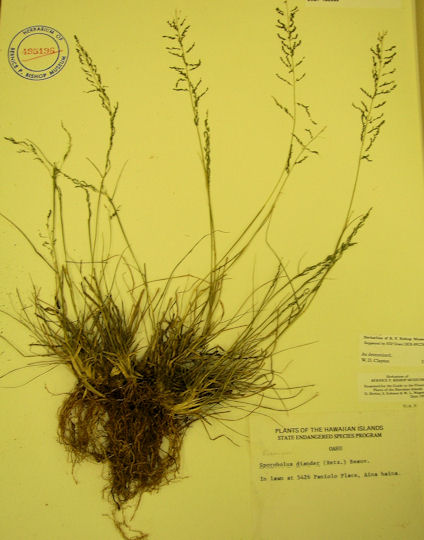
Abb.: Sporobolus diander
(Retz.) P. Beauv. 1812 - Indian Dropseed, Hawaii
[Bildquelle: Forest & Kim Starr. --
http://www.hear.org/starr/images/image/?q=050729-3217&o=plants. -- Zugriff
am 2010-12-02. --
Creative Commons Lizenz (Namensnennung)]
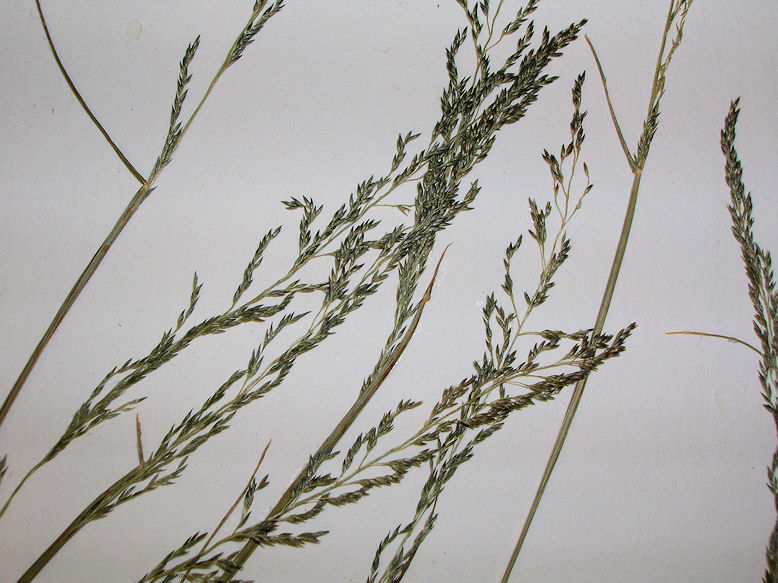
Abb.: Sporobolus diander
(Retz.) P. Beauv. 1812 - Indian Dropseed, Hawaii
[Bildquelle: Forest & Kim Starr. --
http://www.hear.org/starr/images/image/?q=050729-3213&o=plants. -- Zugriff
am 2010-12-02. --
Creative Commons Lizenz (Namensnennung)]
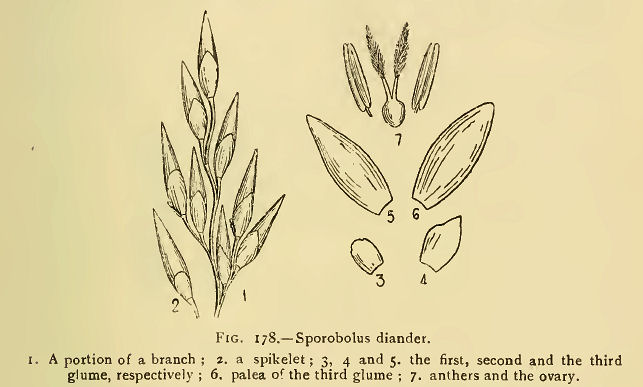
Abb.: Sporobolus diander
(Retz.) P. Beauv. 1812 - Indian Dropseed
[Bildquelle: A handbook of some south Indian grasses / by K. Rai
Bahadur K. Ranga Achariyar ; assisted by C. Tadulinga Mudaliyar. -- Madras,1921.
- S. 231]
"Agrostis diandra. Linn. sp. pl. ed. Willd. i. 371. Retz. Obs. v. N. 37. [= Sporobolus diander (Retz.) P. Beauv. 1812]
Smooth. Culms erect, from one to three feet high. [...]
A native of moist pasture ground, in the vicinity of Calcutta."
[Quelle: Roxburgh, William <1751-1815>: Flora indica, or, Descriptions of Indian plants / by the late William Roxburgh. -- Serampore : Printed for W. Thacker, 1832. -- Vol. 3, S. 317.]
Cyperaceae (Sauergrasgewächse)
|
25.अ.&ब्. kuruvindo meghanāmā mustā mustakam astriyām कुरुविन्दो मेघनामा मुस्ता मुस्तकम् अस्त्रियाम् ।२५ क। [Bezeichnungen für Cyperus scariosus R. Br. 1810 & Cyperus rotundus L. 1753 - Knolliges Zypergras - Nutgrass:]
|
Colebrooke (1807): "A fragrant grass. Cyperus rotundus."
1 कुरुविन्द - kuruvinda m.: Rubin (Korund), Schleifstein (Korund)
Die Bezeichnung "Korund" kommt von Kuruvinda, vermittelt über das Tamil-Wort kurundam - குருந்தம்.
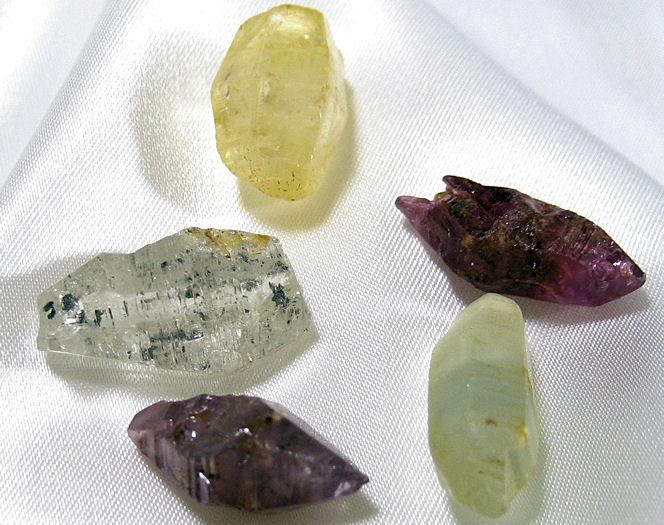
Abb.: Verschiedene Formen von Korund
[Bildquelle: Ra'ike / Wikipedia. -- GNU FDLicense]
"Korund, Mineral, besteht aus Tonerde Al2O3, findet sich in rhomboedrischen Kristallen und derb in großkörnigen bis feinkörnigen Aggregaten, Härte 9 (also nächst dem Diamant das härteste Mineral), spez. Gew. 3,9–4, eingewachsen in Granit, Syenit, Basalt, Gneis, Glimmerschiefer, auch in körnigem Kalk und Dolomit sowie lose in Kristallen und kleinen Geröllen in den Edelsteinseifen. Man unterscheidet mineralogisch drei Varietäten:
1) Edler Korund ist durchsichtig, glasglänzend, farblos oder (durch Chromoxyd und Eisen) blau (Saphir, Salamstein) oder rot (Rubin), auch gelb und grün. [...] Rubin findet sich besonders in Birma im Flussgebiet des Irawadi bei Mogouk sowohl in Seifen (Edelsanden) als auch eingewachsen in körnigem Kalk, ferner in Siam, in Badakschan (Mongolei), spärlich in Ceylon und in Nordamerika. Saphir kommt besonders in Siam und auf Ceylon in Edelsanden vor, außerdem als Einschluss in größeren unreinen Stücken von Korund in einem Olivingestein in Nord- und Südcarolina und in Goldsanden in Montana, ferner in kleinen Körnern lose im Granitgrus der Iserwiese in Böhmen und eingewachsen im Basalt von Unkel u. a. O. (der sogen. brasilische Saphir aus Brasilien ist kein K., sondern bläulicher Topas oder Turmalin).
2) Gemeiner Korund findet sich in Kristallen mit meist rauen Flächen und in großkörnigen bis grobkörnigen Massen (Demantspat, Diamantspat), auch in Geschieben und Körnern; er hat meist graue, rötliche und bräunliche Farben und ist nur durchscheinend. Fundorte: im Dolomit von Campolongo, im Syenit von Biella in Italien, im Chloritschiefer von Kuschwa und Barsowskoi im Ural, im Glimmerschiefer von Chester in Massachusetts, auf der Culsageegrube in Nordcarolina in über 150 kg schweren Kristallen, in den Edelsanden von Ceylon etc. Er dient, wie auch die schlechten Stücke des Saphirs und Abfälle von der Bearbeitung desselben, zum Schleifen und Polieren andrer Edelsteine, des Glases und der Metalle.
3) Schmirgel, feinkörnige Massen von indigoblauer bis schwarzer Farbe, fast stets mit Magneteisen und Eisenglanz innig verwachsen, so dass der Korundgehalt oft nur zwei Drittel des Gemenges beträgt. Wegen der Beimengung der weniger harten Mineralien steht die Härte des Schmirgels hinter derjenigen der andern Korundvarietäten. Der Schmirgel bildet Lager im Glimmerschiefer und körnigen Kalk, so bei Schwarzenberg in Sachsen, in Kleinasien, am Ural, in Massachusetts, auf Naxos etc. Seine große Härte macht ihn zu einem gesuchten Schleifmaterial; namentlich der Naxosschmirgel wird in der Technik viel benutzt. Er wird auf Schmirgelmühlen gemahlen, gesiebt, auch geschlämmt und in verschiedenen Feinheitsgraden in den Handel gebracht."
[Quelle: Meyers großes Konversations-Lexikon. -- DVD-ROM-Ausg. Faksimile und Volltext der 6. Aufl. 1905-1909. -- Berlin : Directmedia Publ. --2003. -- 1 DVD-ROM. -- (Digitale Bibliothek ; 100). -- ISBN 3-89853-200-3. -- s.v.]
Cyperus scariosus R. Br. 1810
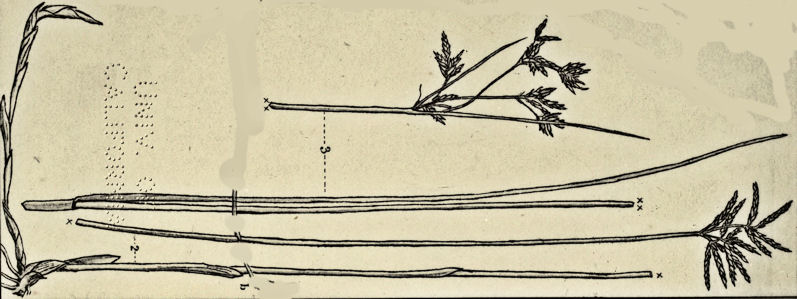
Abb.: मुस्ता । Cyperus scariosus R. Br. 1810
[Bildquelle: Illustrations of Cyperaceae / prepared under the direction of the
late Charles Baron Clarke. -- London, 1909. -- Tab. XVI.]
"CYPERUS SCARIOSUS, B. Br.
Fig —C. B. Clarke, Linn. Soc. Journ. xxi., 159.
Hab.—Damp places in Bengal.
[...]
History, Uses, &C—This plant produces the aromatic tubers which have long been in use in Hindu medicine and perfumery under the Sanskrit name of Nāgar-mustaka; they are considered to have the same medicinal properties as those of C. rotundus. Arabian and Persian writers mention this Indian Cyperus, but consider it to be inferior to C. rotundus. In the Concan, Nāgarmoth, Solanum indicum, Tinospora cordifolia, Ginger and Emblic myrobalans, of each 2 tolas, are powdered and divided into 5 parts, and one part taken daily in decoction with a little honey and long pepper as a febrifuge. Several other prescriptions of a similar nature are used in fever, and will be found in the Wanaushadi Prakasha. In dysentery, Nāgarmoth, Mocharas, Lodhra, Daitiphul (Woodfordia floribunda flowers), unripe Bael fruit, and the seeds of Holarrhena antidysenterica are ground with whey and molasses and given in 6 massa doses. In famine seasons Nāgarmoth has proved a valuable resource to the poor."
[Quelle: Pharmacographia indica : a history of the principal drugs of vegetable origin met with in British India / by William Dymock [1834-1892], C. J. H. Warden and David Hooper [1858-1947]. -- Bd. 3. -- London, 1893. -- S. 554.]
Cyperus rotundus L. 1753 - Knolliges Zypergras - Nutgrass
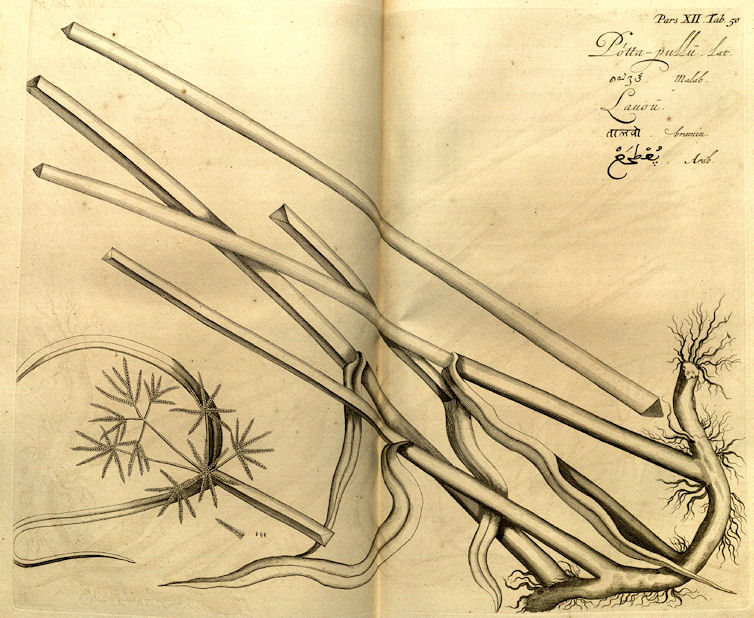
Abb.: मुस्ता । Cyperus rotundus L. 1753 - Knolliges Zypergras - Nutgrass
[Bildquelle: Hortus malabaricus XII. Fig. 50, 1703]
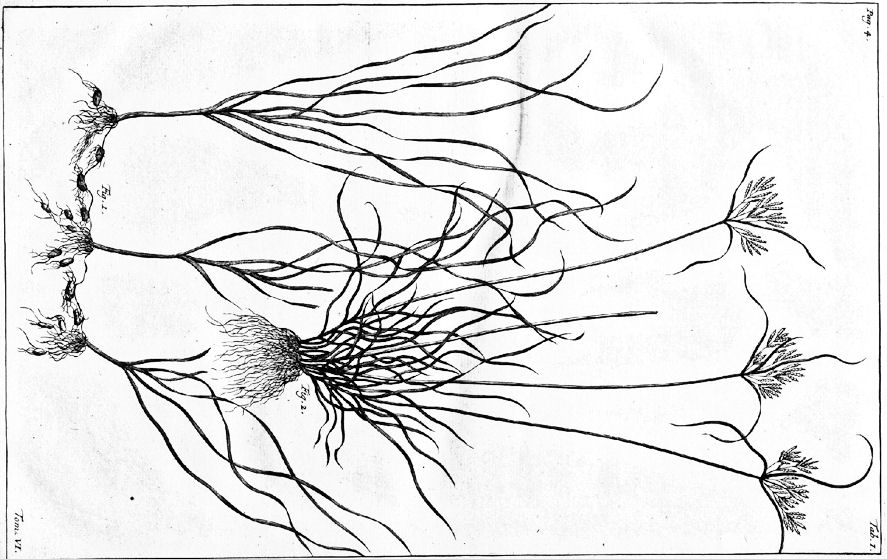
Abb.: मुस्ता । Cyperus rotundus L. 1753 - Knolliges Zypergras - Nutgrass
[Bildquelle: Herbarium amboinense / Georg. Everhard Rumphius. -- Amsterdam, 1741
- 1750. -- Vol 6, Tab. 1.]
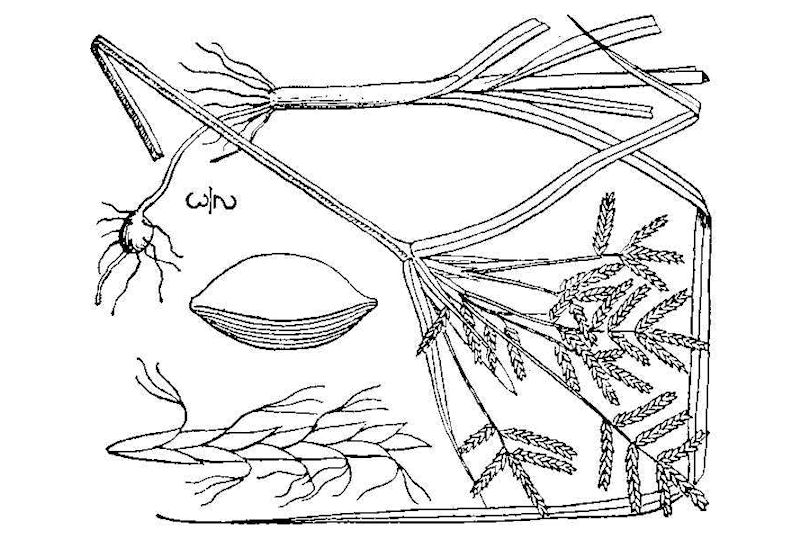
Abb.: मुस्ता । Cyperus rotundus L. 1753 - Knolliges Zypergras - Nutgrass
[Bildquelle: An illustrated flora of the northern United
States, Canada and the British Possessions 1913 / USDA. -- Public domain]
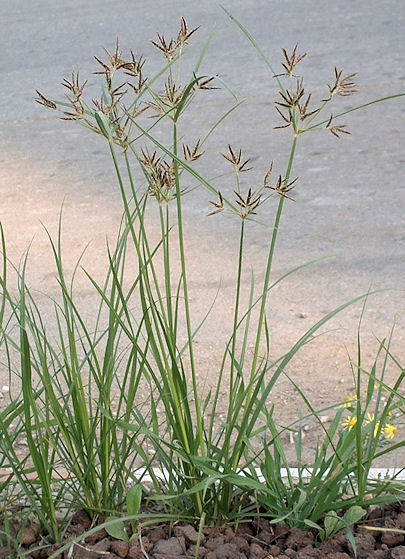
Abb.: मुस्ता । Cyperus rotundus L. 1753 - Knolliges Zypergras - Nutgrass
[Bildquelle: Rickjpelleg / Wikimedia. -- GNU FDLicense]
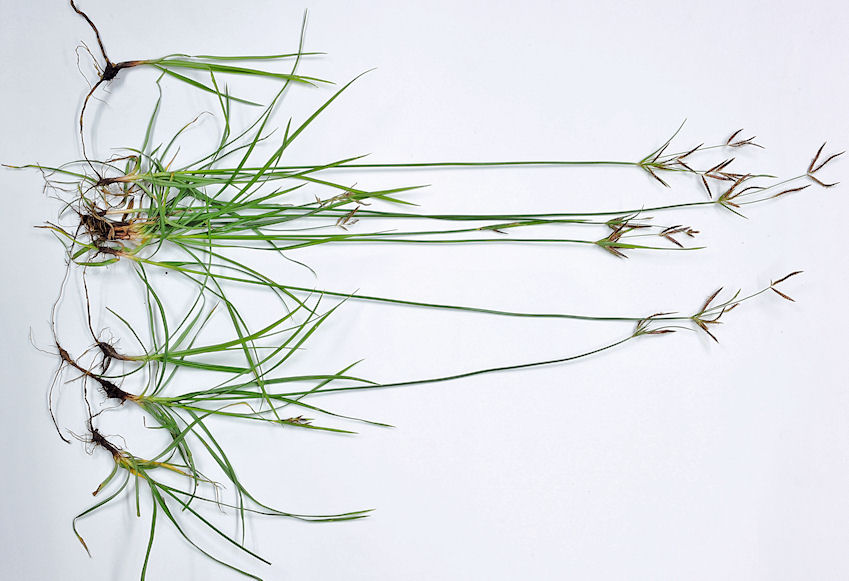
Abb.: मुस्ता । Cyperus rotundus L. 1753 - Knolliges Zypergras - Nutgrass,
Philippinen
[Bildquelle: IRRI images. --
http://www.flickr.com/photos/ricephotos/4726596128/. -- Zugriff am
2010-10-24. --
Creative Commons Lizenz (Namensnennung)]
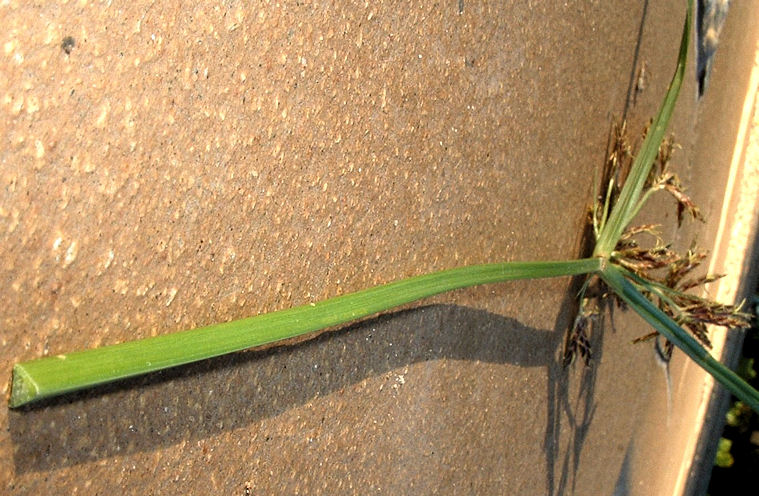
Abb.: मुस्ता । Cyperus rotundus L. 1753 - Knolliges Zypergras - Nutgrass
[Bildquelle: Rickjpelleg / Wikimedia. -- GNU FDLicense]
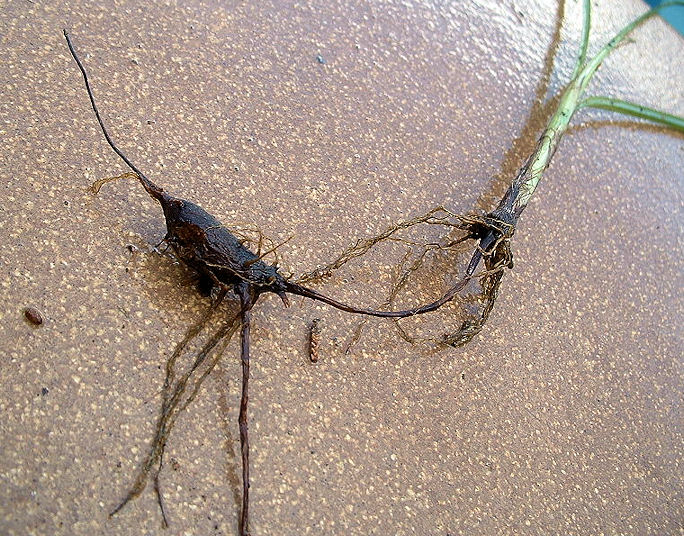
Abb.:
कुरुविन्दः । Cyperus rotundus L. 1753 - Knolliges Zypergras - Nutgrass
[Bildquelle: Rickjpelleg / Wikimedia. -- GNU FDLicense]
"Cyperus rotundus. Linn. sp. pl. ed. Willd. 1. 283. Vahl. enum. pl. 343.
Root tuberous. Culms from one to two feet high [...]
C. rotundus. Rumph. Amb. 6. p. 1. t. 1. fig. 1. 2.
C. hexastachyos. Rottb. 28. t. 14. f. 2.
Sans. Moosta, Moostuka.
[...]
This is by far the most common species we have in India; it delights in a moist sandy soil, though it grows abundantly everywhere.
[...]
Obs. Cattle eat it. Hogs are remarkably fond of the roots. Dried and powdered they are used as a perfume at the weddings of the natives. It is by far the most troublesome weed we have in our gardens, there is no extirpating it, as every little bit of the root grows readily."
[Quelle: Roxburgh, William <1751-1815>: Flora indica, or, Descriptions of Indian plants / by the late William Roxburgh. -- Serampore : Printed for W. Thacker, 1832. -- Vol. 1, S. 197f.]
"Cyperus hexastachyus (Rottl.) [= Cyperus rotundus L. 1753] [...]
Description.—Culms erect, 1-2 feet, triangular with rounded angles; [...]
Fl. June—Aug.
Roxb. Fl. Ind. ed. Car. i. 197.— Wight Contrib. p. 81.
C. rotundus, Linn.
Peninsula. Bengal.
Medical uses.—The tubers are sold in the bazaars, and used by perfumers on account of their fragrance. In medicine they are used as tonic and stimulant, and have been employed in the treatment of cholera. In the fresh state, given in infusion as a demulcent in fevers, and also used in cases of dysentery and diarrhoea. It is perhaps the most common species in India of this extensive genus. It is found chiefly in sandy soils, but will grow almost anywhere. Hogs are very fond of the roots, and cattle eat the greens. It becomes a troublesome weed in the gardens, being difficult to extirpate. —(Roxb. Ainslie.) The roots are sweet, and slightly aromatic; the taste is bitter, resinous, and balsamic. Stimulant, diaphoretic, and diuretic properties are assigned them; and they are further described as astringent and vermifuge.—(Bengal Disp. p. 627. Pharm. of India.) The species C. pertenuis partakes of the same aromatic properties, and is also considered diaphoretic. Its delicate form, small and compound umbels, short slender leaves, readily distinguish this from the other Indian species. The roots, as well as being medicinal, are used for perfuming the hair.—Roxb."
[Quelle: Drury, Heber <1819 - 1872>: The useful plants of India : with notices of their chief value in commerce, medicine, and the arts. -- 2d ed. with additions and corrections. London : Allen, 1873. -- xvi, 512 p. ; 22 cm. -- s.v.]
|
25. c./d. syād bhadramustako gundrā cūḍālā cakraloccaṭāस्याद् भद्रमुस्तको गुन्द्रा चूडाला चक्रलोच्चटा ॥२५॥[Bezeichnungen für Cyperus pertenuis Roxb.:]
|
Colebrooke (1807): "Another sort. Cyperus pertenuis, Roxb."
"Cyperus pertenuis. Roxb.
[...]
This most delicate, tall, slender species, I have only found in low wet places, in the vicinity of Calcutta."
[Quelle: Roxburgh, William <1751-1815>: Flora indica, or, Descriptions of Indian plants / by the late William Roxburgh. -- Serampore : Printed for W. Thacker, 1832. -- Vol. 1, S. 198.]
"The species C. pertenuis partakes of the same aromatic properties, and is also considered diaphoretic. Its delicate form, small and compound umbels, short slender leaves, readily distinguish this from the other Indian species. The roots, as well as being medicinal, are used for perfuming the hair.—Roxb." [Quelle: Drury, Heber <1819 - 1872>: The useful plants of India : with notices of their chief value in commerce, medicine, and the arts. -- 2d ed. with additions and corrections. London : Allen, 1873. -- xvi, 512 p. ; 22 cm. -- s.v. Cyperus hexastachys]
|
25. c./d. syād bhadramustako gundrā cūḍālā cakraloccaṭāस्याद् भद्रमुस्तको गुन्द्रा चूडाला चक्रलोच्चटा ॥२५॥[Bezeichnungen für eine nicht näher identifizierte Art von Cyperus:]
|
Colebrooke (1807): "A different kind. Interpretations differ : it is a Cyperus according to some ; but others make it the Zedoary [Curcuma zedoaria (Christm.) Roscoe 1810 -- Siehe oben Vers 19c f.]."
1 चूडाला - cūḍālā f.: welche eine cūḍā auf dem Kopf hat
cūḍā f.: ein Büschel von Haaren auf dem Scheitel des Kopfes, das man bei der Haarschneidezeremonie (cūḍākaraṇa) stehen lässt

Abb.: चूडा / शिखा । Mumbai - मुंबई,
Maharashtra
[Bildquelle:
Ben Piven. --
http://www.flickr.com/photos/piven/1809715659/. -- Zugriff am 2011-01-13. --
Creative
Commons Lizenz (Namensnennung, keine kommerzielle Nutzung, keine
Bearbeitung)]
2 चक्रला - cakralā f.: (zu cakra: Rad; ringworm = Dermatophytosis = Tinea, durch verschiedene Erreger bewirkt)

Abb.: चक्रम् । "ringworm" - Tinea corporis, bewirkt durch den Pilz
Trichophyton rubrum, Neuguinea
[Bildquelle: CDC/Lucille K. Georg / Wikimedia. -- Public domain]
Cyperus sp.
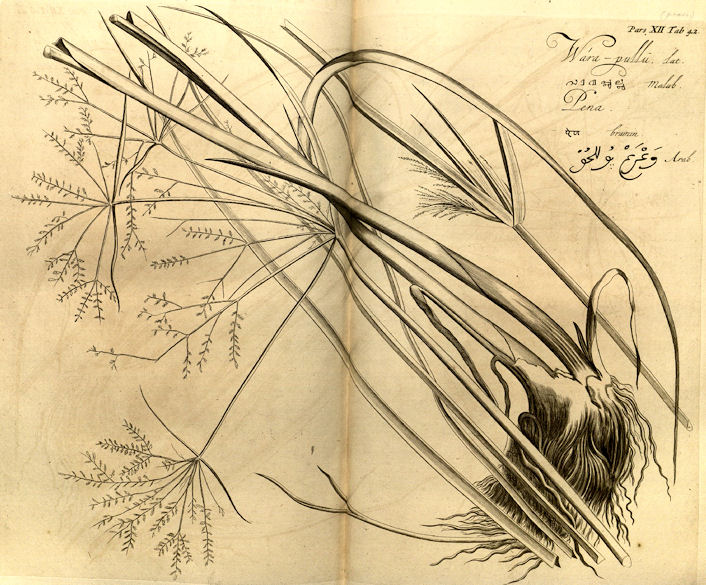
Abb.:
चूडाला । Cyperus sp.
[Bildquelle: Hortus malabaricus XII. Fig. 42, 1703]
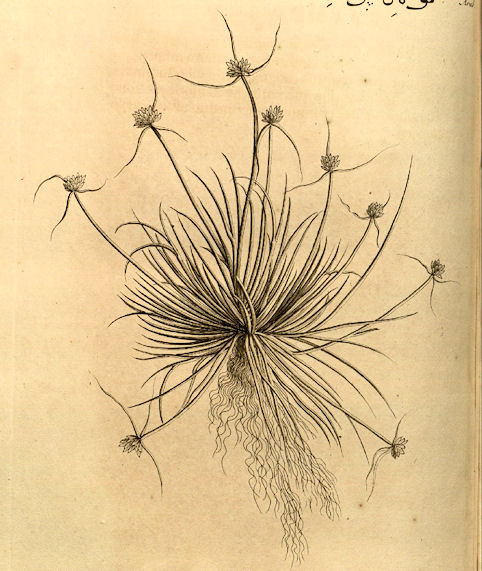
Abb.: Cyperus sp.
[Bildquelle: Hortus malabaricus XII. Fig. 54, 1703]
Cyperus ventricosus R. Br.
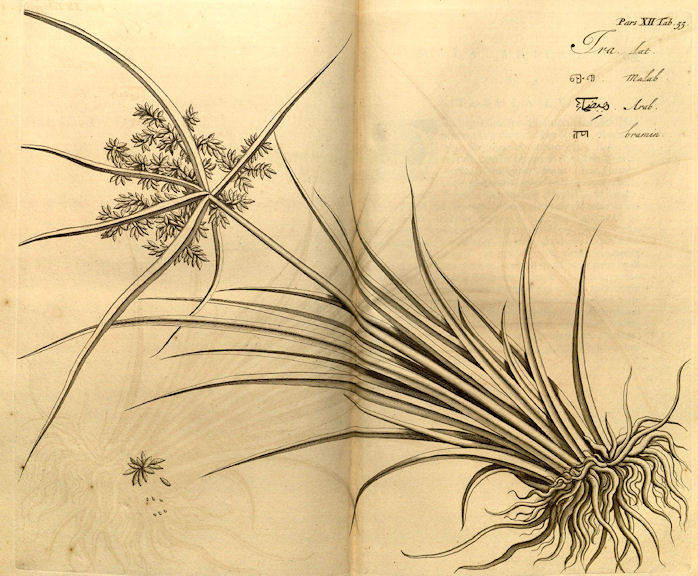
Abb.: Cyperus ventricosus R. Br.
[Bildquelle: Hortus malabaricus XII. Fig. 55, 1703]
Cyperus inundatus Roxb. (= Juncellus inundatus C.B.Clarke)
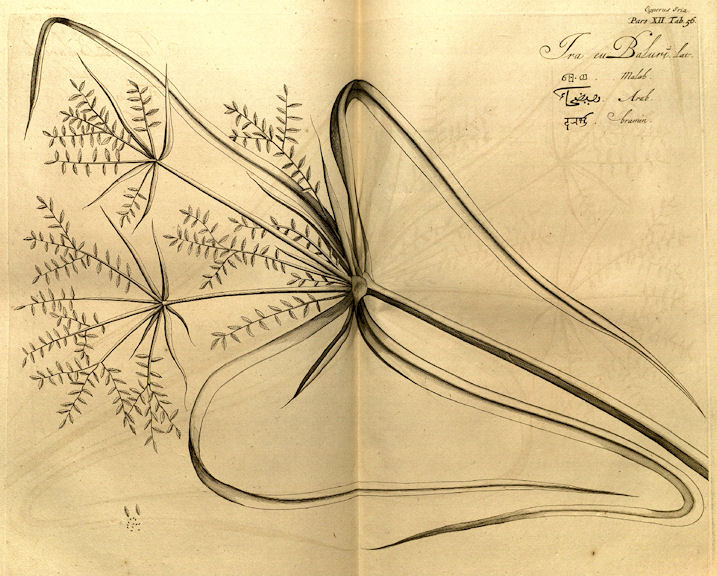
Abb.: Cyperus inundatus Roxb. (= Juncellus inundatus C.B.Clarke)
[Bildquelle: Hortus malabaricus XII. Fig. 56, 1703]
Poaceae (Süßgräser)
|
26. vaṃśe tvaksāra-karmāra-tvacisāra-tṛṇadhvajāḥ śataparvā yavaphalo veṇu-maskara-tejanāḥ 27. veṇavaḥ kīcakās te syur ye svananty anilodghatāḥ granthir nā parva-paruśī gundras tejanakaḥ śaraḥ वंशे
त्वक्सार-कर्मार-त्वचिसार-तृणध्वजाः । Bezeichnungen für वंश - vaṃśa m.: Bambusa bambos (L.) Voss 1895 - Dornbambus - Spiny Bamboo und andere Species von Bambus:
Bambusse heißen कीचक - kīcaka m.: Schilfrohr, Kīcaka, wenn sie, vom Wind geschüttelt, dröhnen. [Die Knoten bzw. Internodien eines Bambus heißen:]
|
Colebrooke (1807): "A bamboo. Bambusa Arundinacea [(Retz.) Willd. = Bambusa bambos (L.) Voss 1895 - Dornbambus - Spiny Bamboo], and other species, Roxb." [27.a./b.:] "The same rattling or whistling." [27.c.:] "A knot or joint."
Siehe auch:
Payer, Alois <1944 - >: Bambus als Material - ไผ่ (Architektur für die Tropen). -- Übersicht: http://www.payer.de/architekturlink.htm
1 यवफल - yavaphala m.: Gersten-Frucht, Getreide-Frucht (gemeint ist vermutlich die Blüten des Bambus)
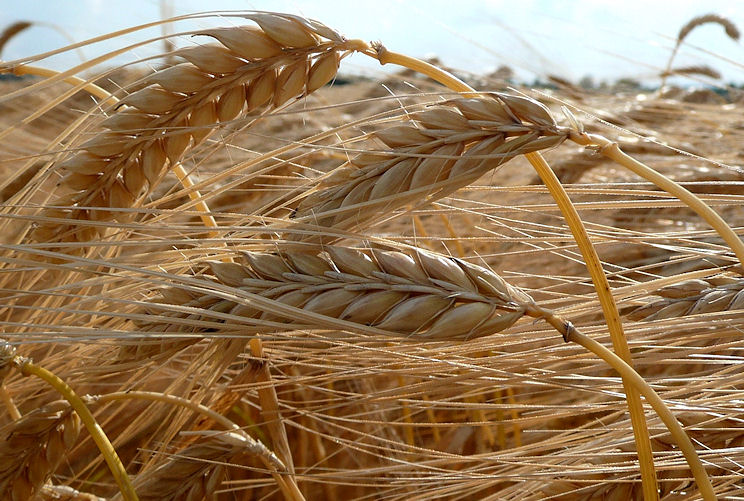
Abb.: Gersten-Ähren
[Bildquelle: Carport / Wikipedia. -- GNU FDLicense]
2 Knoten und Internodium:
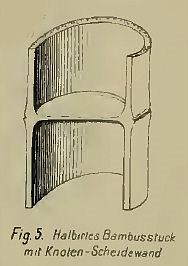
Abb.: Halbiertes Bambusstück mit Knoten-Scheidewand
[Bildquelle: Spörry, Hans <1859-1925> ; Schröter, Carl
<1855-1939>: Die Verwendung des Bambus in Japan und Katalog der Spörry'schen
Bambussammlung / von Hans Spörry. Mit einer botanischen Einleitung / von C.
Schröter. -- Zürich : Zürcher & Furrer, 1903. -- 198 S. : 8 Tafeln im
Anhang und etwa 100 Textbilder. -- (Geographisch-Ethnographische
Gesellschaft Zürich). -- Tafel I. -- Online:
http://www.archive.org/details/dieverwendungdes00sp. -- Zugriff am
2009-09-20]
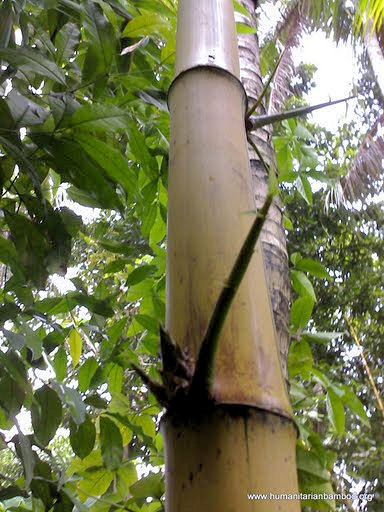
[Bildquelle: humanitarianbamboo.org. --
http://picasaweb.google.com/humanitarianbamboo/FotoBambu# . -- Zugriff
am 2009-09-29. --
Creative Commons
Lizenz (Namensnennung, keine kommerzielle Nutzung, share alike)]
Bambusa bambos (L.) Voss 1895 - Dornbambus - Spiny Bamboo
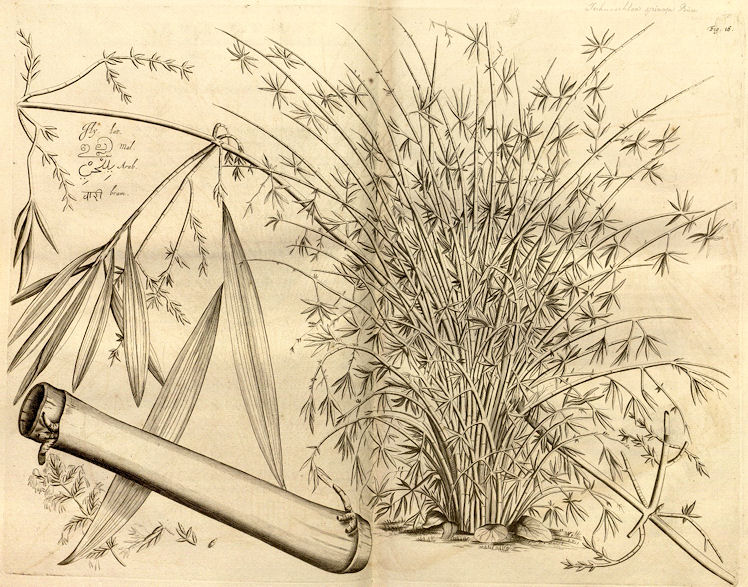
Abb.: वेणुः । Bambusa bambos (L.) Voss 1895 - Dornbambus - Spiny Bamboo
[Bildquelle: Hortus malabaricus I. Fig. 16, 1678]
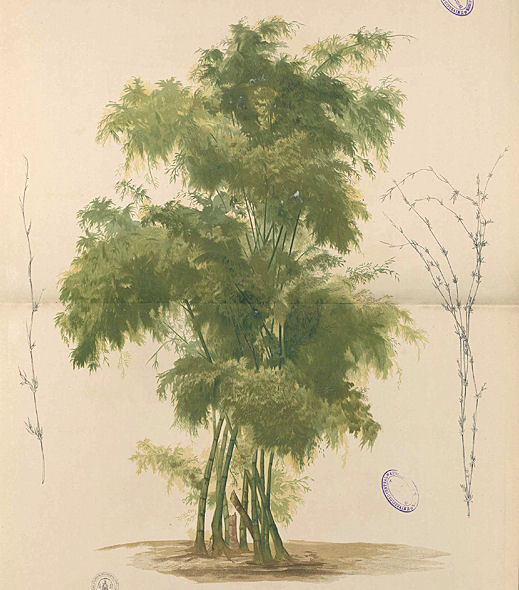
Abb.: तृणध्वजः । Bambusa bambos (L.) Voss 1895 - Dornbambus - Spiny Bamboo
[Bildquelle: Flora de Filipinas, 1880 / Wikipedia. -- Public domain]
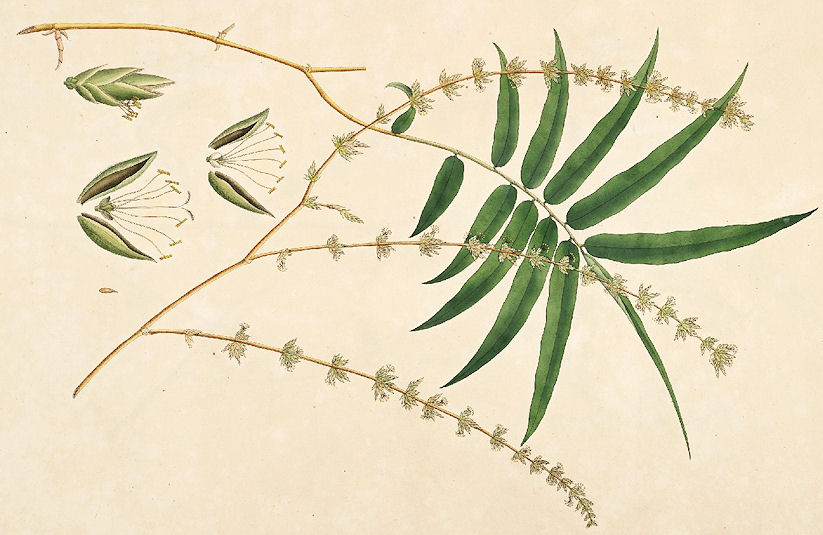
Abb.: यवफलः । Bambusa bambos (L.) Voss 1895 - Dornbambus - Spiny Bamboo
[Bildquelle: Roxburgh. -- Vol I. -- 1795. -- Tab. 79. -- Image courtesy Missouri
Botanical Garden. http://www.botanicus.org.
--
Creative Commons Lizenz
(Namensnennung, keine kommerzielle Nutzung)]
"Bambusa arundinacea. Corom. pl. 1. N. 79. [= Bambusa bambos (L.) Voss 1895]
[...]
Arundo bambos Linn, sp. pl. 120.
Ily, Rheed. Mal. 1. 1. 16.
[...]
It delights in a rich, moist soil, such as the banks of rivulets, lakes, &c. among the mountains.
Stems, I fear to call them culms, numerous, from ten to a hundred from the same root, for eighteen or twenty feet straight, then bending gently to one side [...] Thorns double, or triple, alternate, on the joints of the branches and branchlets ; [...]
It would be needless, and unnecessary to mention the various purposes to which this most useful plant is put ; they are already known to most people.
The Tamul Doctors say the root is diluent ; that the bark cures eruptions ; the Camphire, or salt (Tabaseer) cures all sorts of paralytic complaints, flatulencies, and poisons. The leaves are esteemed the best emmenagogue ; the Chinese are said to possess the same idea. The seed is used for food as rice.
Tabasheer Vedroo Paloo, that is milk of bamboo, of the Telingas ; and Mungle Upoo, salt of bamboo, of the Tamuls, the substance so well described by Dr. Patrick Russell, in the 80th vol. of the Philosophical Transactions of London, is found in the cavities of the joints of this sort.
Bambusa stricta. Corom. pl. 1. N. 80. [= Dendrocalamus strictus (Roxb.) Nees 1835 - Kalkuttabambus - Calcutta Bamboo]
[...]
This is clearly a distinct species ; it grows in a drier situation, is not near so large, has a much smaller cavity, and is very straight ; its great strength, solidity, and straightness renders it much fitter for a variety of uses, than the common sort ; the natives make staffs to their spears, &c. of it.
[...]
Bambusa Tulda. Roxb.
Arboreous, unarmed. [...]
Vansa is the Sanscrit name which Sir William Jones applies to bamboos in general.
This is the common bamboo of Bengal, where it grows in the greatest abundance everywhere. Flowering time the month of May.
The root consists of many small fibres, spreading in every direction, but to no great distance, nor do they penetrate very deep.
The roots of all the other species are similar.
Stems in old plants numerous from the same root, jointed, smooth, and ramous. In the month of June, soon after the first rains set in, new ones rise up amongst those of the former year and in the same manner in all the other species, at first in the form of a large straight elephant's tusk, invested in strong coriaceous sheaths, one at each joint ; these shoots rise simple to their full size, from twenty to seventy feet in height, and from six to twelve inches in circumference, in the course of about thirty days ; during which period the sheaths drop off, and are soon succeeded by numerous, alternate, ramous, bifarious, unarmed branches, from the joints ; before these appear, the shoots look like as many naked fishing rods, of immense size. [...]
Inflorescence. Before these trees blossom, they must be of considerable age, several years ; and even then it is seldom they can be found in this state ; at that period the whole plant is destitute of leaves, and forms one immensely, oblong, waving panicle, composed of innumerable, supra-decompound ramifications.
[...]
This species is very generally used all over Bengal, for covering the houses of the natives, scaffolding, &c. &c. If soaked in water for some weeks previously to their being used, they last much longer, and are stronger ; if not they are soon devoured by a small species of Bostrichus. It is notwithstanding deemed inferior to Balkooa (Batkoo bans) of the Bengalees.
This species, Tulda bans, so far as I am able to judge at present, is not to be found on the Coast of Coromandel.
Its quick growth, size and universal commonness in Bengal, renders it one of the most variously useful plants in India. The young thick shoots, mentioned when describing the stem, are when about two feet high, tender and very frequently pickled, and a most excellent one they make, when properly prepared.
Jowa Bans of the Bengalees, is only a large variety of this species, and used chiefly for scaffolding, and building the larger and better sorts of houses of the natives. It differs from Tulda in the greater length, and greater thickness of the joints. Basini bans of the Bengalees, is another variety of Tulda. It has a larger cavity, and is used chiefly to make baskets.
Behoor bans of the Bengalees, is of a small size, very solid, and strong, much bent to one side, and armed with numerous strong thorns, which renders it very fit for hedges. A staff of this species must be placed in the hand of every young brahmin, when invested with the sacerdotal cord, otherwise they say the ceremony cannot be performed.
Bambusa Balcooa. Roxb.
Arboreous, unarmed. [...]
Beng. Balkoo-bans.
It is a native of Bengal, and on account of its size, and strength, is reckoned by the workers in bamboo work the very best sort for building the houses of the natives, scaffolding, &c. works requiring both size and strength. Flowering time the rainy season, however it rarely arrives at this state, for I have but once met with it in blossom.
[...]
To make this species more serviceable, long immersion in water is required to render them firmer, and proof against the attacks of the Bostrichi, and their larvae.
There are two varieties of this most useful species. The large the natives call Dhooli-balkoo, and the smaller Balkoo-bans, which has a smaller cavity, and though not so large a bamboo, is on that account very strong.
Bambusa baccifera. Roxb. [= Melocanna baccifera (Roxb.) Kurz 1875]
Arboreous, unarmed.
[...]
Beesha. Rheed. Mal. vol. 5. t. 60. p. 119.
[...]
This uncommonly curious berry-bearing bamboo, is a native of the Chittagong mountains.
Growing plants, seeds, and well preserved specimens, were sent me from thence, by Mr. Richard Pierard, a gentleman to whom the Botanic Garden at Calcutta is under many obligations. The bamboo he writes is the one in common use in that country, for every purpose of building, &c. His description of the tree is so full and perfect that I do not think I can do better than transcribe what he says, in reply to my queries regarding this plant, viz.
"It bears no thorns ; grows in dry places, chiefly on the sides of hills, where the upper stratum of the soil is sandy. The circumference near the base twelve or thirteen inches ; height from fifty to seventy feet, beautifully erect, and without the least flexure, or unequality of surface, bare of branches except near the extremity. Perishes after yielding its fruit.
"It yields more or less Tabasheer of a siliceous crystallization ; sometimes it is said the cavity between the joints is nearly filled with this, which the people call choona, lime" So far Mr. Pierard.
[...]
Bambusa spinosa. Roxb.
Subarboreous, dreadfully armed with simple, and compound spines.
[...]
Arundarbor spinosa. Rumph. Amb. 4. 14. t. 2.
This beautiful, middling sized, very elegant species, I have only found in the vicinity of Calcutta, where now and then some of the oldest are found to blossom about the beginning of the rains, in June.
Stems [...] so completely bound together, that it is a most arduous
task to cut down an old clump of them. [...] By the number and strength of these spines, and of the branches of this species, it may be said to form the most impenetrable jungle in India. [...]
Like the other species, this is employed for various useful purposes ; and as it grows to a pretty large size, and with a smaller cavity than any of the others, it is strong, and well adapted for a variety of uses.
Bambusa nana. Roxb.
Shrubby, unarmed.
Keu-fa, of the Chinese ; a native of their country, and now plentiful in the Botanic Garden at Calcutta, but has not yet blossomed in Bengal. It makes most beautiful close hedges.
The popular belief, that Bamboos often take fire by the violence of their friction, during those hot, dry months, when, what is called, the land wind prevails, is supported by the Sanscrit stanza, quoted by Sir William Jones, (See As. Res. vol. 4. p. 254,) of which the following is a copy.
"Delight of the world, beloved Chandana, stay no longer in this forest which is overspread with rigid pernicious Vansas, whose hearts are unsound ; who being themselves confounded in the scorching stream of flames, kindled by their mutual attrition, will consume not their own families merely, but this whole world.""
[Quelle: Roxburgh, William <1751-1815>: Flora indica, or, Descriptions of Indian plants / by the late William Roxburgh. -- Serampore : Printed for W. Thacker, 1832. -- Vol. 2, S. 191ff.]
"Bambusa arundinacea (Willd.) [= Bambusa bambos (L.) Voss 1895] N. O. Graminaceae. Bamboo [...]
Description.— [...]
Fl. March—May.
Roxb. Fl. Ind. ii. 191.—Cor. i. t. 79.
Arundo bambos, Linn.
Forests of the Peninsula.
Medical Uses.—The siliceous concretion known as Tabasheer (Tavakshiri, a Sanscrit term meaning cow's milk) is only procured from the female plant. It so far resembles silex as to form a kind of glass when fused with alkalies. It is also unaffected by fire and acids. It is employed medicinally in the cures of paralytic complaints and poisonings. Sir D. Brewster (Phil. Trans., 1819. Ed. Journ. of Sci., viii. 286) made some singular discoveries on the optical properties of this substance. It is called by the Hindoo physicians, he says, bamboo manna, milk, sugar, or camphor of bamboo, and appears to be a secretion from the joints of the reed in a state of disease, malformation, or fracture. The ordinary quantity produced by a disorganised joint or internode is four or five grains. It consists of silica, containing a minute quantity of lime and vegetable matter. Its physical properties are remarkable. Its refractive power is lower than that of any other body, when solid or fluid. With certain oils, which it imbibes, it becomes as transparent as glass. It absorbs water, and becomes as white and opaque as if it had been covered with white-lead. It is highly prized in native practice as a stimulant and aphrodisiac. Among other reputed medical properties of the bamboo, the root is said to be a diluent, the bark a specific in eruptions, and the leaves as anthelmintic and emmenagogue.—Ainslie. Pharm. of India. Madras Journ. of Med. Sci. 1862, p. 245.
Economic Uses.—These gigantic arborescent grasses, which cover the sides and tops of the mountains throughout the continent of India, form one of the peculiar as well as most striking features of Oriental scenery. Few objects present a more attractive sight in the wild forests of this country than a clump of these beautiful plants, with their tall bending stems and delicate light-green foliage. With the exception of the cocoa, and some other palms perhaps, the bamboo is the most useful and economical of all the vegetable products of the East. In no other plant is strength and lightness combined to that degree which renders this so important an article in building - houses, lifting weights, forming rafts, and a thousand other uses which might here be enumerated. It attains a considerable height —some 70-80 feet—and has been known to spring up thirty inches in six days. At the age of 15 years the bamboo is said to bear fruit—a whitish seed like rice—and then to die. These seeds are eaten by the poorer classes.
The purpose to which different species of bamboo are applied are so numerous that it would be difficult to point out an object, in which strength and elasticity are requisite, and for which lightness is no objection, to which the steins are not adapted in the countries where they grow. The young shoots of some species are cut when tender, and eaten like asparagus. The full-grown stems, while green, form elegant cases, exhaling a perpetual moisture, and capable of transporting fresh flowers for hundreds of miles. When ripe and hard they are converted into bows, arrows, and quivers, lance-shafts, the masts of vessels, bed-posts, walking-sticks, the poles of palanquins, to floors and supporters of rustic bridges, and a variety of similar purposes. In a growing state the spiny kinds are formed into stockades, which are impenetrable to any but regular infantry, aided by artillery. By notching their sides the Malays make wonderfully light scaling-ladders, which can be conveyed with facility where heavier machines could not be transported. Bruised and crushed in water, the leaves and stems form Chinese paper, the finer qualities of which are only improved by a mixture of raw cotton and by more careful pounding. The leaves of a small species are the material used by the Chinese for the lining of their tea-chests. Cut into lengths and the partitions knocked out, they form durable water-pipes, or, by a little contrivance, are made into excellent cases for holding rolls of papers. Slit into strips, they afford a most durable material for weaving into mats, baskets, window-blinds, and even the sails of boats. Finally, the larger and thicker truncheons are exquisitely carved by the Chinese into beautiful ornaments. No plant in Bengal is applied to such a variety of useful purposes as the bamboo. Of it are made implements for weaving, the posts and frames of the roofs of huts, scaffoldings for buildings, portable stages for native processions, raised floors for granaries, stakes for nets in rivers, rafts, masts, yards, oars, spars, and in boat-decks. It is used for building bridges across creeks, for fences, as a lever for raising water for irrigation, and as flag-poles. Several agricultural instruments are made of it, as are also hackeries or carts, doolies or litters, and biers, the shafts of javelins or spears, bows and arrows, clubs, and fishing-rods. A joint of bamboo serves as a holder for pens, small instruments, and tools. It is used as a case in which things of little bulk are sent to a distance. The eggs of silk-worms were brought in a bamboo-cane from China to Constantinople in the time of Justinian. A joint of bamboo answers the purpose of a bottle, and a section of it is a measure for solids and liquids in bazaars. A piece of it is used as a blow-pipe, and as a tube in a distilling apparatus. A small bit of it split at one end serves as tongs to take up burning charcoal, and a thin slip of it is sharp enough to be used as a knife in shelling betel-nuts, &c. Its surface is so hard that it answers the purpose of a whetstone, upon which the ryots sharpen their bill-hooks and sickles.—Roxb. Lindley.
When travelling in the Himalaya, Dr Hooker observed a manufactory for making paper out of the bamboo. Large water-tanks were constructed in the fields for the purpose of steeping the bamboo stems. They appeared to be steeped for a length of time in some solution of lime. They were then removed and beaten upon stones until they became quite soft, or till all the flinty matter which abounds in their stems was removed.—Hooker, Him. Journ. 311.
A correspondent from Burmah furnishes the following very interesting account of the flowering of the bamboo, and of its uses: The flowering of the bamboo is considered to be a very rare occurrence. Once in eighteen, twenty, and even twenty-five years, does it flower, and still less seldom does it produce seed. We have shown the seed to Burmese of 75 and 80 years old, and they could not tell what it was. They had seen none before. Among the hill-people and the tribes who are buried away in the recesses of our forests, they have a very superstitious dread of this phenomenon* They mention that when the bamboo flowers, fevers and sickness will be prevalent. Their traditions have taught them so, and hence they always fear the appearance of this particular flower. Of course their apprehensions are based purely on superstition and ignorance. The flowering of the bamboo may be ascribed to natural causes.
It is one of the most valuable, as it is the most useful, kind of plants, adapted to supply the wants of mankind. It is employed in a great variety of ways—for houses, furniture, utensils, and for fuel Colonel Nuthall, who spent many years on this coast, was of the deliberate opinion, from his great experience of the country, that no branch of industry would yield a capitalist more handsome profits than the growing of the large-size bamboo. All that is needed is to put the young shoots down, and they will run up rapidly of themselves without any care or attention to them whatever. They would proportionately fetch higher prices than the smaller kinds, for which there is a constant demand all over the country. The use of bamboo will never go out of fashion in Burmah, at least among the rural population. Often there is found a small whitish fungus growing on the sides of the bamboo, which is called by the people " Wah moo" which the late Dr Judson makes synonymous with "Than moo" It is a mushroom growth, and when rasped or bruised down to a powder it is administered as a vermifuge by Burmese physicians. It is said to be a very effectual remedy in cases of worms, with which children are so liable to be troubled in infancy. We have no doubt that if this Burmese remedy was known in Europe, it would at once be introduced into the British pharmacopoeia. It is a more manageable article than some of the substances now classified as vermifuge medicines.
Immense quantities of fine bamboos are floated down the various rivers of the western coast. They are usually 60 feet long, and 5 inches in diameter near the root. These are readily purchased, standing at 5 rupees, and small ones at 3 1/2 rupees, per 1000. Millions are annually cut in the forests, and taken away by water in rafts, or by land in hackeries. From their buoyancy they are much used for floating heavier woods.—Cleghorn's Forests of S. India."
[Quelle: Drury, Heber <1819 - 1872>: The useful plants of India : with notices of their chief value in commerce, medicine, and the arts. -- 2d ed. with additions and corrections. London : Allen, 1873. -- xvi, 512 p. ; 22 cm. -- s.v.]
"BAMBUSA ARUNDINACEA, Retz.
Fig.--Roxb. Cor. Pl. i. t. 79; Rheede, Hort. Mal. i. t. 16
Bamboo
Hab.—Throughout India.
[...]
History, Uses,&c.—The Bamboo,in Sanskrit Vansa and Venu, is considered by the Hindus to have the hardest of woods. The word also signifies 'spine' and' lineage,' thus Vansa-visuddha means "made of a good bamboo," i.e., of a pure or good family, and Vansa-dhara "carrying a bamboo," i.e., maintaining a family, Vansa-pratishthana-kara "establishing a family on a sure foundation." The Abbé Dubois, in his Description of India, states that the young Indian bride and bridegroom are made to stand in two bamboo baskets placed side by side, and the Kul or Arbor generationis of the caste, at Hindu marriages, is placed in a winnowing fan made of bamboo. The wild tribes of the Garrow hills, who have no temples or altars, set up opposite their huts a bamboo post which they deck with flowers and tufts of cotton, and before it they make offerings to their god. Indian anchorites carry a bamboo stick having seven knots. A bamboo flowering is an event of rare occurrence, and which is supposed to bring in its train all sorts of evil, accompanied by dire distress and famine. The seeds of the bamboo, in Sanskrit Vansa-tandula, Vansa-ja, Venu-yava, Venu-vija, have often proved of great value in famine seasons, saving thousands of lives ; this was the case in Orissa in 1812 and in Canara in 1864. The young shoots which appear towards the end of the rainy season are used as a vegetable; they are minced very finely and soaked in water to remove the bitter taste, and then cooked with dāl, and seasoned according to taste : they are also made into pickle.
A decoction of the joints of the bamboo is supposed to have an action on the uterus, and is used by females after delivery to cause a free flow of the lochial discharge. The same part of the plant pounded with water is applied to inflamed joints. The juice of the leaves with aromatics is given in haematemesis. The leaves are very commonly given to horses by syces as a remedy for coughs and colds.
Bamboo manna is the Vansa-lochana of the Indian physicians ; in the Nirghantas it bears many synonyms, such as Vansa-rochana, Tvak-kshira "bark-milk," Vansa-karpura "bamboo camphor," Vansa-sarkara " bamboo sugar," Vansāhva "bamboo sacrifice," Subhra, and Sita "white," &c. It is considered to be strengthening, tonic, cold, and sweet; to alleviate thirst, and to avert phthisis, fever, asthma, cough, biliousness, skin diseases, and Vāyu (morbid affections of the windy humor). As an example of the way in which it is prescribed, the following formula for making the Sitopalādi-churna will be found in Sarangadhara :—Bamboo manna 8 parts, long pepper 4, cardamoms 2, cinnamon 1, sugar 16. Powder and mix. Dose about 60 grains, to be given with honey and ghi in phthisis and cachexia.
The belief in the strengthening properties of bamboo manna appears to have originated among the aboriginal tribes of India, as on the West Coast it is the first solid food which the Thana Kolis give their children. The same belief seems to have prevailed in Borneo, as Marco Polo relates that pieces of this substance were let in under the skin by the natives to make the body wound-proof.
We hold with Salmasins that bamboo manna was the substance known to the Greeks as σακχαρ σακχαρον, and described by them as a white, concreted or crystalline substance like common salt, because there was no kind of sugar prepared from the sugar-cane, answering to this description, known in India in the time of Dioscorides. The name Sarkara, which signifies "grit, pebbles, sand," was applied by Hindu writers at that time to several substances, viz., Guda or molasses in a dry granular state, the only kind of cane-sugar then in use in India; Yavāsa-sarkara, the concrete manna of Alhagi; and Vansa sarkara, the concretion found in the bamboo. The Sanskrit name Khanda was also applied to Guda, which is the substance known in the vernaculars as Gūr or Gūl, and is still the kind of sugar most used by the Hindus. Pale crystalline sugar, the Chini of the bazars, does not appear to have been known until some 400 years after the date of Dioscorides.
Under the name of Tabāshir, a corruption of the Sanskrit Tvak-kshira, bamboo manna was known to the early Arab travellers in the East; the port of Thana, on the West Coast of India, was famous for its Tabāshir in the time of Idrisi (1135) and supplied it to all marts. Ibn Sina describes Tabāshir as astringent and stomachic, useful in erysipelas and to ally thirst in bilious dyspepsia, cardiacal, and strengthening. As a local application it is used to relieve the heat and irritation caused by aphthous eruptions along with pounded rose leaves. Later Mahomedan writers upon the Materia Medica of the East have added nothing of importance to Ibn Sina's account of the drug. Flückiger (Zur Geschichte des Tabaschir, Zeit. des allg. österr. Apoth. Ver. Nr. 14 u.15,1887) mentions a list of Indian goods on which transit duty was levied at Aden in 1270 ; in it Tabāshir is mentioned together with tamarinds and camphor. He also draws attention to a remarkable connection between Tabāshir and ivory ashes, generally known by the name of Spodium. Idrisi, in the middle of the 12th century, points out that the latter was used to adulterate the former, while others of a different opinion assign a greater value to Spodium. Garcia d'Orta (Colloquios 51 )mentions both Tabāshir and Spodium, which he considers to be Pompholyx or Turtia (white of zinc ? calamine ?), and states that in Persia and Arabia Tabāshir was generally paid for by its weight in silver ("o preço ordinario na Persia e Arabia é a peso de prata"); he also describes black or grey Tabāshir, which was of less value and was obtained by burning the bamboo cane. Flückiger remarks that it is most likely that the name "Spodium da canna " was given to this black Tabāshir or perhaps to the ashes of the cane, and that it might be owing to this circumstance that in later times the name Spodium came to be applied to animal charcoal (bone-black). The idea of black seems not to have been connected with the original Greek name σποδος (ashes). Flückiger also draws attention to the Latin translation of a Persian Karabādin or Pharmacopoeia by the Carmelite Friar P. Angelus, published in Paris in 1681, in which Tabāshir is spoken of as pseudo-spodium, anti-spodiu, and spodium-arabicum. Rhedde as well as Rumphius notice Tabāshir, but it does not appear to have attracted much attention in Europe until Dr. Patrick Russell drew the attention of the Royal Society to it, and induced James Louis Macie to make an analysis, which showed that it consisted principally of silica.
Further information on Tabāshir may be obtained from Prof. Flückiger's papers above mentioned, and a paper by Dr. Brandis in the Indian Forester, March, Vol. XIII.
Description.—Tabāshir consists of irregularly-shaped fragments of an opaque white or bluish opalescent colour, the larger pieces are about an inch in diameter, concavo-convex, and have evidently derived their form from the joint of the bamboo in which the deposit has collected. The raw article is blackened and dirty, having apparently been obtained by burning the bamboos, or on account of the presence of insects ; to make it fit for use it is calcined, when it becomes perfectly clean."
[Quelle: Pharmacographia indica : a history of the principal drugs of vegetable origin met with in British India / by William Dymock [1834-1892], C. J. H. Warden and David Hooper [1858-1947]. -- Bd. 3. -- London, 1893. -- S. 586ff.]
Dendrocalamus strictus (Roxb.) Nees 1835 - Kalkuttabambus - Calcutta Bamboo
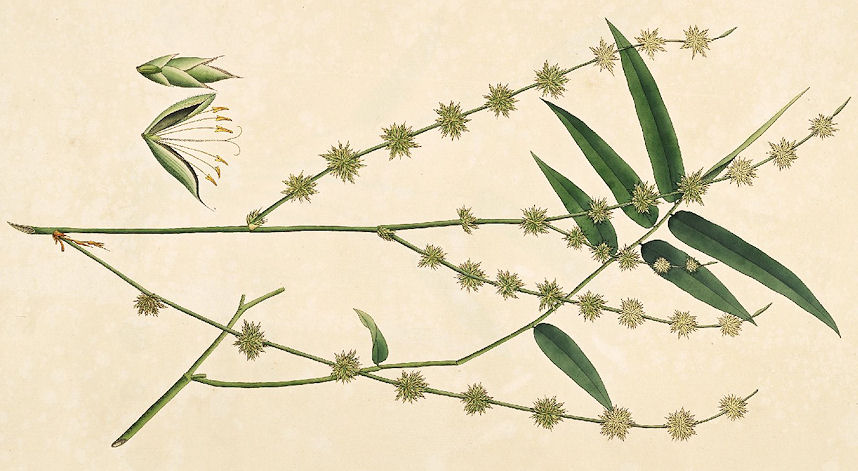
Abb.: Dendrocalamus strictus (Roxb.) Nees 1835 - Kalkuttabambus -
Calcutta Bamboo
[Bildquelle: Roxburgh. -- Vol I. -- 1795. -- Tab. 80. -- Image courtesy
Missouri Botanical Garden.
http://www.botanicus.org. --
Creative Commons Lizenz
(Namensnennung, keine kommerzielle Nutzung)]
Melocanna baccifera (Roxb.) Kurz 1875
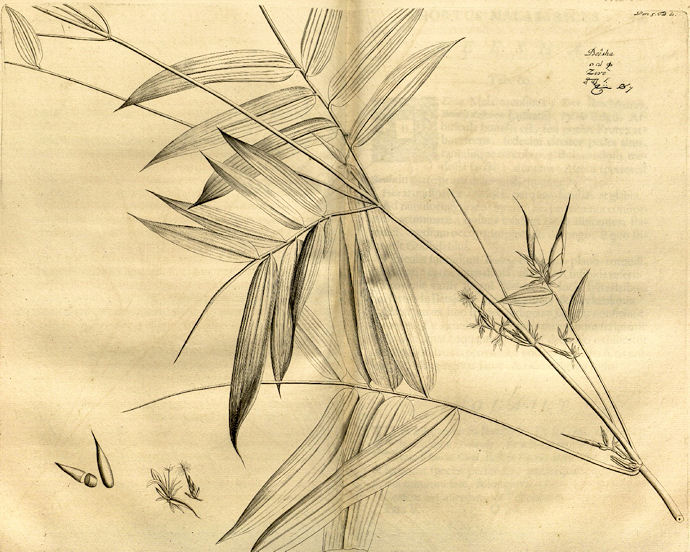
Abb.: Melocanna baccifera (Roxb.) Kurz 1875
[Bildquelle: Hortus malabaricus V. Fig. 60, 1685]
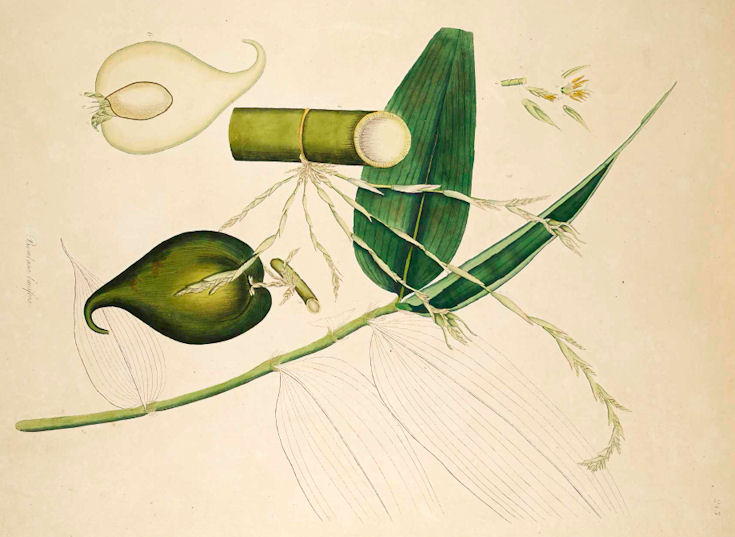
Abb.: Melocanna baccifera (Roxb.) Kurz 1875 (Roxb.: Bambusa baccifera)
[Bildquelle: Roxburgh. -- Vol III. -- 1819. -- Image courtesy Missouri
Botanical Garden. http://www.botanicus.org.
--
Creative Commons Lizenz
(Namensnennung, keine kommerzielle Nutzung)]
Bambus, verschiedene Species
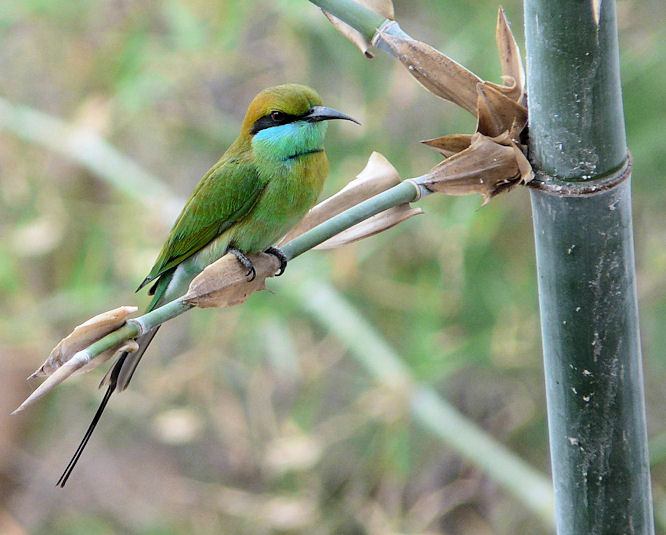
Abb.: Green Bee-eater (Merops orientalis Lantham 1802) auf Bambus,
Andhra Pradesh
[Bildquelle: jankie. --
http://www.flickr.com/photos/jajankie/3986823103/. -- Zugriff am 2010-10-24.
-- Creative
Commons Lizenz (Namensnennung, keine kommerzielle Nutzung, share alike)]
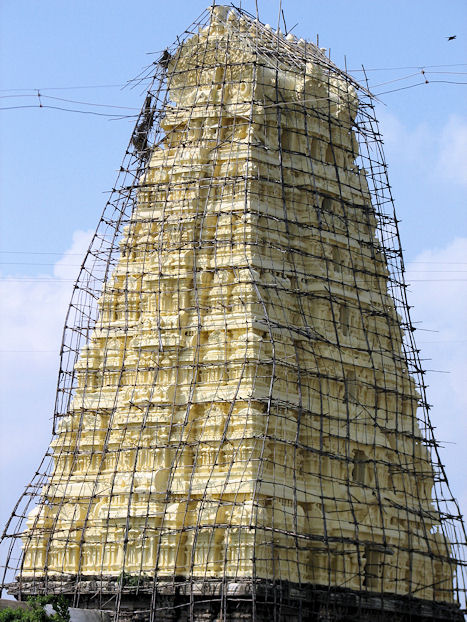
Abb.: Bambusgerüst, Kanchipuram
[Bildquelle: lamentables. --
http://www.flickr.com/photos/lamentables/98711480/. -- Zugriff am
2010-10-04. --
Creative
Commons Lizenz (Namensnennung, keine kommerzielle Nutzung, share alike)]
Poaceae (Süßgräser)
|
27. c./d.
granthir nā parvaparuśī
gundras tejanakaḥ śaraḥ ग्रन्थिर् ना पर्व-परुशी गुन्द्रस् तेजनकः शरः ॥२७॥ [Bezeichnungen für Saccharum bengalense Retz. 1788:]
|
Colebrooke (1807): "Sarahari. Saccharum Sara, Roxb. [= Saccharum bengalense Retz. 1788]"
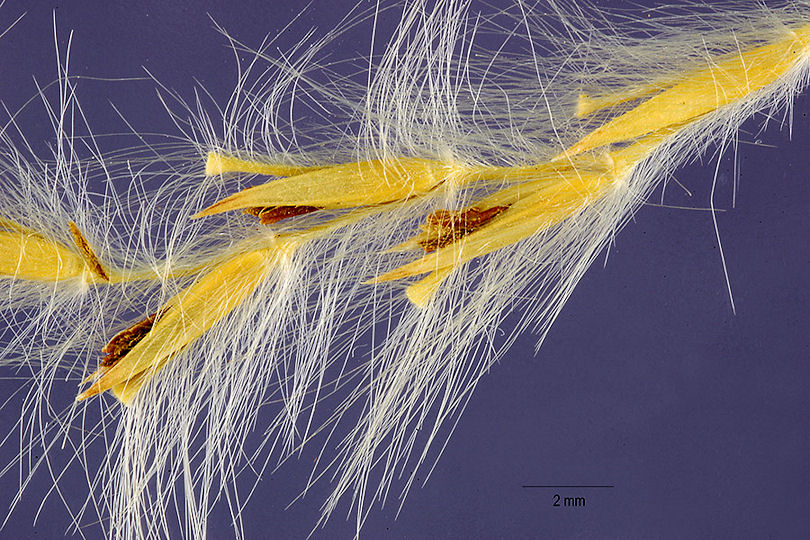
Abb.: Saccharum bengalense Retz. 1788
[Bildquelle: Courtesy Tracey Slotta / USDA]
"Saccharum Sara. Roxb. [= Saccharum bengalense Retz. 1788]
Erect, from eight to twelve feet high.
[...]
Sans. Goondra, Tejunuka, Shura.
Sara. Asiat. Res. iv. 247.
Found in the vicinity of Calcutta, but rather rare, whereas S. spontaneum (which Sir William Jones mistook for Sara) is very common every where. It is readily distinguished by being a stronger reed, the leaves much larger, with very hispid margins, the ramifications of the panicle decompound, and a corol of three valves. Culms perennial, erect, from six to sixteen feet high, often near the base as thick as the little finger, smooth, remarkably strong."
[Quelle: Roxburgh, William <1751-1815>: Flora indica, or, Descriptions of Indian plants / by the late William Roxburgh. -- Serampore : Printed for W. Thacker, 1832. -- Vol. 1, S. 244.]
"Saccharum sara (Roxb.) [= Saccharum bengalense Retz. 1788] Penreed Grass [...]
Description.--Culms perennial, erect 6-16 feet, smooth, very strong; [...]
Roxb. Fl. Ind. i. 244.
Bengal.
Economic Uses.—Ropes made from the leaves are employed by the boatmen about Allahabad and Mirzapore as tow-lines. These ropes are reckoned very strong and durable, even when exposed to the action of water. They are first beaten to a rough fibre and then twisted into ropes. The pens made from these reeds are exported to a small amount from Madras, and are sent chiefly to Bombay.—(Royle. Comm. Prod. Mad. Pres.) The leaves are made into mats, and bundles of the stems are used for floating heavy timber on rivers. The stems are made into blinds, chairs, and basket-work, and are laid down on sandy roads in default of macadamising. The tops, just before flowering, are reckoned good fodder for increasing the supply of milk ; and in the southern parts of the Punjaub the delicate part of the pith, in the upper part of the stem, is eaten by the poor. When burnt, its smoke is considered beneficial applied to burns and scalds.—Stewart's Punj. Plants."
[Quelle: Drury, Heber <1819 - 1872>: The useful plants of India : with notices of their chief value in commerce, medicine, and the arts. -- 2d ed. with additions and corrections. London : Allen, 1873. -- xvi, 512 p. ; 22 cm. -- s.v.]
Phragmites: Poaceae (Süßgräser)
Lobelia: Campanulaceae (Glockenblumengewächse)
|
28. a./b. naḍas tu dhamanaḥ poṭakalo
'tho kāśam astriyām नडस् तु धमनः पोटकलो ऽ थो काशम् अस्त्रियाम् ।२८ क।[Bezeichnungen für Phragmites karka (Retz.) Trin. ex Steud. 1841 oder Lobelia nicotinianifolia (nicotininaefolia, necolinianifola ?) Heyne:]
|
Colebrooke (1807): "A reed. Arundo tibialis, Roxb. [= Lobelia nicotinianaefolia Heyne.]"
Phragmites karka (Retz.) Trin. ex Steud. 1841
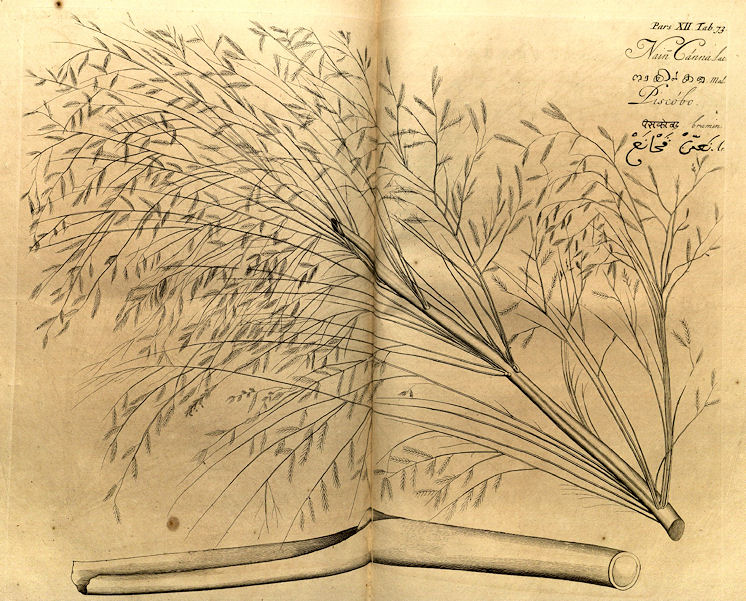
Abb.: धमनः । Phragmites karka (Retz.) Trin. ex Steud. 1841
[Bildquelle: Hortus malabaricus XII. Fig. 73, 1703]
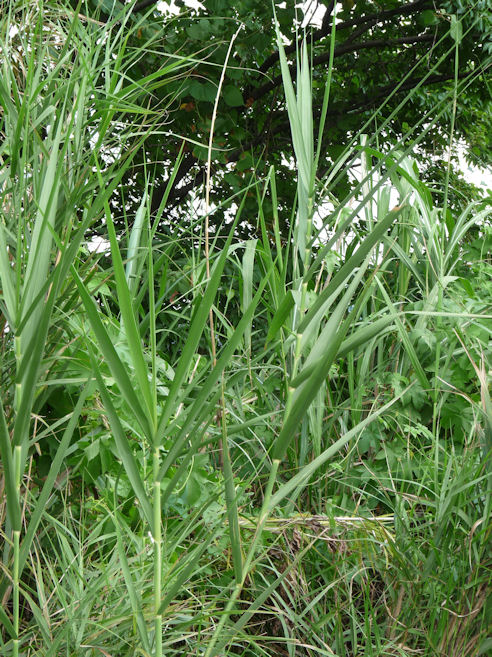
Abb.:
नडः । Phragmites karka (Retz.) Trin. ex Steud. 1841
[Bildquelle: Show_ryu / Wikimedia. -- GNU FDLicense]
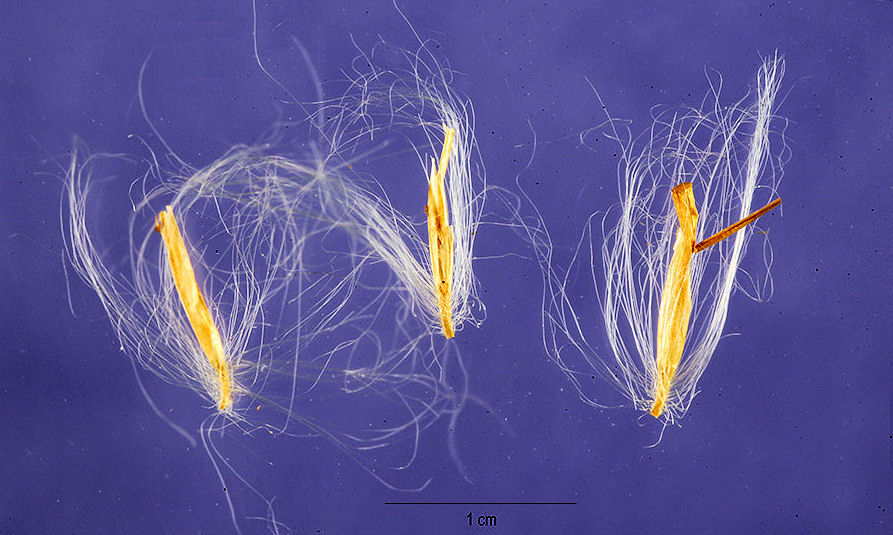
Abb.: Phragmites karka (Retz.) Trin. ex Steud. 1841
[Bildquelle: Courtesy Jose Hernandez / USDA]
"Arundo Karka. Linn. sp. pl. ed. Willd. i. 456. Retz. Obs. iv. 21. [= Phragmites karka (Retz.) Trin. ex Steud. 1841]
Erect, smooth, leafy, from eight to twelve feet high.
[...]
Sans. Nuda, Nula, Dhumuna, Potugula.
Is a native of similar places with the last described [Arundo bifaria].
Culms erect, ramous, from eight to twelve feet high
[...]
Obs. It does not agree with Retzius's description of A. Karka in the number of flowers in the calyx. Pipes are made of the culms, particularly those used by the people who carry about the dancing snakes.
In Bengal it is more luxuriant than on the coast. The common Durma mats of that place are made of the stalks split open. Vessels from the port of Calcutta are generally dunnaged with them."
[Quelle: Roxburgh, William <1751-1815>: Flora indica, or, Descriptions of Indian plants / by the late William Roxburgh. -- Serampore : Printed for W. Thacker, 1832. -- Vol. 1, S. 347f.]
Lobelia nicotinianifolia Heyne (Wight: L. necolianifolia)
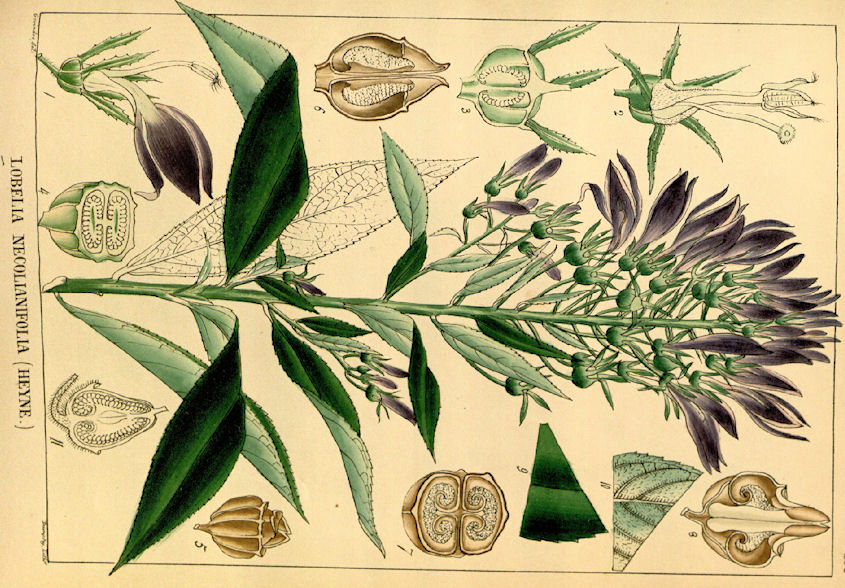
Abb.: Lobelia nicotinianifolia Heyne (Wight: L. necolianifolia)
[Bildquelle: Wight: Illustrations II, Tab. 135, 1850]
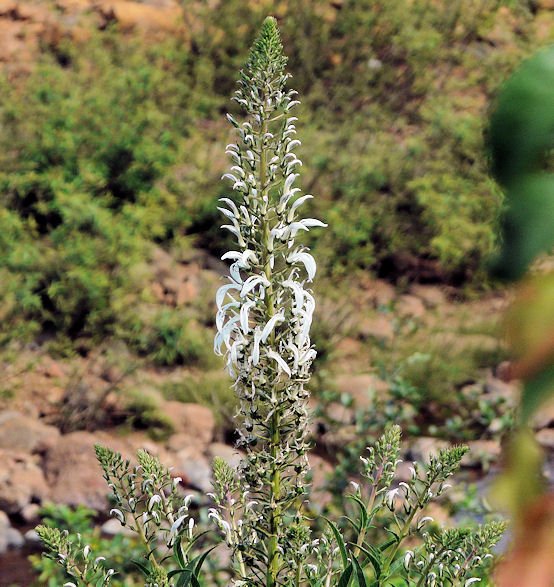
Abb.: Lobelia nicotinianifolia Heyne, Maharashtra
[Bildquelle: dinesh_valke. --
http://www.flickr.com/photos/dinesh_valke/3132752080/. -- Zugriff am
2010-12-02. --
Creative
Commons Lizenz (Namensnennung, keine kommerzielle Nutzung, share alike)]
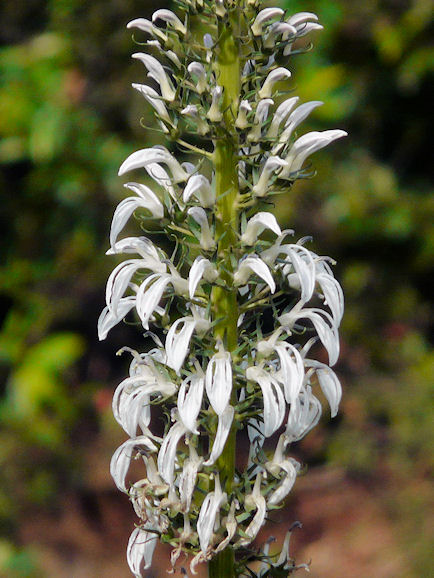
Abb.: Lobelia nicotinianifolia Heyne, Maharashtra
[Bildquelle: dinesh_valke. --
http://www.flickr.com/photos/dinesh_valke/3132840116/. -- Zugriff am
2010-12-02. --
Creative
Commons Lizenz (Namensnennung, keine kommerzielle Nutzung, share alike)]
"Lobelia nicotianifolia. Heyne's Mss.
Erect. [...]
A stout, tall species, first described by Mr. Heyne, who found it indigenous in the vicinity of Bangalore."
[Quelle: Roxburgh, William <1751-1815>: Flora indica, or, Descriptions of Indian plants / by the late William Roxburgh. -- Serampore : Printed for W. Thacker, 1832. -- Vol. 1, S. 506.]
"Lobelia nicotianaefolia (Heyne). N. O. Lobeliaceae.
[...]
Description.—Stem erect; [...] flowers purple.
Dec. Prod. vii. 381.—Drury Handb. ii. 109.— Wight Illustr. t. 135.
Neilgherries. Canara.
Medical Uses.—The seeds of this plant, which is found on the mountain-ranges of the Peninsula and Ceylon, are extremely acrid. An infusion of the leaves is used by the natives as an antispasmodic. —Pharm. of India."
[Quelle: Drury, Heber <1819 - 1872>: The useful plants of India : with notices of their chief value in commerce, medicine, and the arts. -- 2d ed. with additions and corrections. London : Allen, 1873. -- xvi, 512 p. ; 22 cm. -- s.v.]
"LOBELIA NICOTlANAEFOLIA, Heyne.
Fig.—Wight Ill., t. 135.
Wild Tobacco
Hab.—Bombay to Travancore, Ceylon.
[...]
History, Uses, &C—This Lobelia was first described by Heyne, who found it near Bangalore. We have met with no mention of the plant in native medical works, but the Marathi name appears to be of Sanskrit origin and to signify "white," probably in allusion to the colour of the flowers. Graham (Bombay Plants) states that the dried stalks, which are hollow in the centre, are sold in the bazar at Mahableshwar, and used as Koluri horns for collecting herds of cattle and scaring wolves. In the Concan a kind of rustic pipe called पांवा (pāṃvā) is made from them. In the Pharmacopoeia of India an infusion of the leaves is said to be used as an antispasmodic. The dry herb when handled is extremely acrid, the dust irritating the throat and nostrils. It is called wild tobacco among the Tamils and is regarded by the natives as poisonous wherever the plant grows. Physiological experiments conducted by Herr von Rosen at Dorpat have shown that this plant has properties exactly similar to those of Lobelia inflata. The physiological action of poisonous doses of lobelia upon the carnivora and upon man is to cause death by paralysing the respiratory centre. Small doses first raise and then depress the blood pressure ; large doses paralyse the vasomotor centre and the peripheral ends of the vagi. (Attwood.) The effects produced by lobelia on man have been carefully studied by Barallier of Toulon, who found that after taking an infusion of 1 grain of the leaves in 400 grains of water, he felt a burning and rawness in the fauces, headache, and a sensation of constriction beneath the sternum; his pulse became weak, slow and intermittent, and there was diuresis. Larger doses produced general muscular weakness, vomiting, difficult breathing, cardiac depression, reduction of temperature and dilatation of the pupils. The action of lobelia is therefore similar to that of tobacco and its alkaloid nicotine. (Barallier, Des effets jphysiol., &c., de la Lobelia inflata. Bull, de Therap., lxvi.)
The chief medicinal value of lobelia is in the treatment of asthma, whether the disease be purely spasmodic or associated with pulmonary emphysema, chronic bronchitis, heart disease, &c. It eliminates from the attack the bronchial spasm, which in the first-named affection constitutes the whole disease, and in the others is a complication only. A fluid drachm of the tincture should be given every hour, or, if the symptoms are urgent, every half hour, until relief is obtained, or the characteristic effects of the medicine are produced. Its efficacy in other diseases, as in whooping cough, will depend mainly upon the predominance of the nervous element in them. Whenever dyspnoea is due to inflammatory changes in the bronchia, or to the presence in these tubes of secreted matters, rather than to spasm, lobelia displays special virtues that entitle it to be preferred before numerous "expectorants." It is of no more advantage in inflammatory laryngitis than various other nauseants and emetics, but it ia decidedly more efficacious in spasmodic laryngitis than most other remedies of the same class. In almost all cases in which distress in breathing arises from a want of proper balance between the lungs and the heart, this medicine affords relief; as, for instance, when the lungs are congested by mitral obstruction and there is a tendency to oedema of those organs; and, again, when the lungs are themselves diseased so as to interfere with the cardiac circulation, as occasionally happens even in tuberculous consumption. (Stillé and Maisch.)
Description.—The leaves resemble those of the tobacco; they are finely serrated and covered with simple hairs."
[Quelle: Pharmacographia indica : a history of the principal drugs of vegetable origin met with in British India / by William Dymock [1834-1892], C. J. H. Warden and David Hooper [1858-1947]. -- Bd. 2. -- London, 1891. -- S. 322ff.]
Poaceae (Süßgräser)
|
28.
naḍas tu dhamanaḥ poṭakalo
'tho kāśam astriyām ikṣugandhā poṭagalaḥ puṃsi bhūmni tu balvajāḥ
नडस् तु धमनः पोटकलो
ऽथो काशम् अस्त्रियाम् । [Bezeichnungen für Saccharum spontaneum L. 1771:]
|
Colebrooke (1807): "Cās. Saccharum spontaneum."
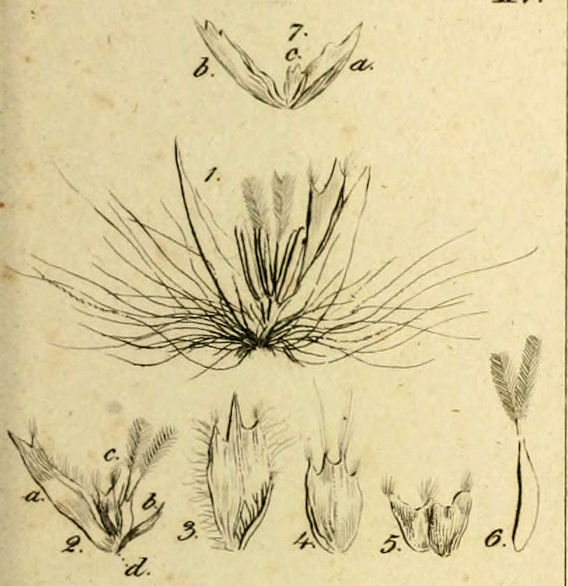
Abb.: Saccharum spontaneum L. 1771
[Bildquelle: Fundamenta agrostographiae, sive Theoria constuctionis floris
graminei; adjecta synopsi generum graminum hucusque cognitorum / auctore Carolo
Bernhardo Trinius. -- Wien, 1820. -- Abb. 15]
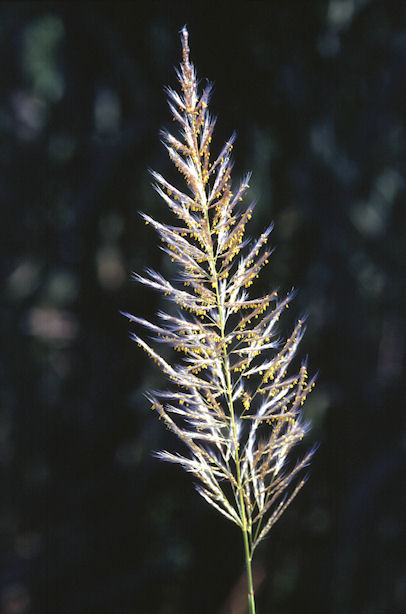
Abb.: काशम् । Saccharum spontaneum L. 1771
[Bildquelle: USDA / Wikimedia. -- Public domain]
"Saccharum spontaneum. Linn, sp. pl. ed. Willd. i. 321.
Culms from five to fifteen feet high. [...]
Sans. Kasha.
Grows on the banks of rivers, in hedges, and on moist, uncultivated land ; in a good soil, it is frequently from ten to fifteen feet high, in a poorer soil, from five to ten. Root perennial, creeping very deep in the ground. Culms annual, erect, leafy, round, lower parts perennial, and as thick as the finger, annual shoots about as thick as a common quill, solid, height various as above observed.
[...]
I have not seen the ripe seed. It is so very coarse that cattle do not eat it, except while very young. It makes good mats for various purposes, and is used to thatch houses."
[Quelle: Roxburgh, William <1751-1815>: Flora indica, or, Descriptions of Indian plants / by the late William Roxburgh. -- Serampore : Printed for W. Thacker, 1832. -- Vol. 1, S. 235f.]
"Saccharum spontaneum (Linn.) Thatch Grass [...]
Description.—Root perennial; culms annual, erect, leafy, round; [...]
Roxb. Fl. Ind. i. 235.
Peninsula. Bengal.
Economic Uses.—The leaves of this species make good mats for various purposes, and are also used for thatching houses. Buffaloes are fed on the grass. It grows on the banks of rivers, in hedges, and on moist uncultivated lands. The immense quantity of long bright silver - coloured wool which surrounds the base of the flowers gives this species a most-conspicuous and gaudy appearance. On the banks of the Irrawady this tall grass is very abundant, and forms a striking object in the landscape.—Roxb."
[Quelle: Drury, Heber <1819 - 1872>: The useful plants of India : with notices of their chief value in commerce, medicine, and the arts. -- 2d ed. with additions and corrections. London : Allen, 1873. -- xvi, 512 p. ; 22 cm. -- s.v.]
Poaceae (Süßgräser)
|
28. c./d.
ikṣugandhā poṭagalaḥ
puṃsi bhūmni tu balvajāḥ इक्षुगन्धा पोटगलः पुंसि भूम्नि तु बल्वजाः ॥२८ ख॥ [Eleusine indica (L.) Gaertn. 1788 - Wilder Korakan - Indian Goose Grass heißt] बल्वज - balvaja m. pl.: Balvaja / Balbaja |
Colebrooke (1807): "Bugai. Perhaps Saccharum Cylindricum, Willd. [= Imperata cylindrica (L.) P. Beauv 1812 - Silberhaargras - Cogongrass] But the Sanscrit name seems to be also applied to Coracanus Indicus [= Eleusine coracana (L.) Gaertn. 1788 - Finger Hirse / Korakan - Finger Millet] or Eleusine Indica [(L.) Gaertn. 1788 - Wilder Korakan - Indian Goose Grass]"
Eleusine indica (L.) Gaertn. 1788 - Wilder Korakan - Indian Goose Grass
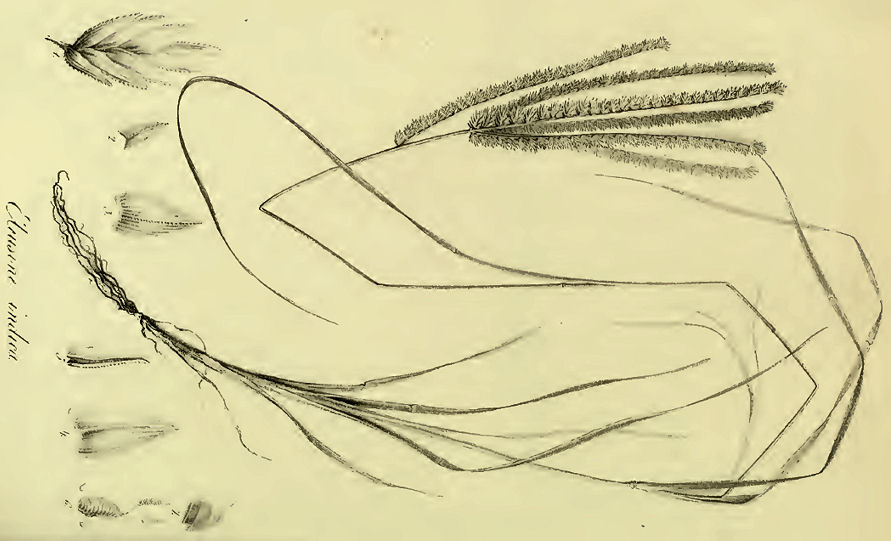
Abb.:
बल्वजाः । Eleusine indica (L.) Gaertn. 1788 - Wilder
Korakan - Indian Goose Grass
[Bildquelle: Species Graminum, iconibus et descriptionibus
/ illustravit C.B. Trinius. -- Petersburg, 1828-1836. -- Vol. 1]
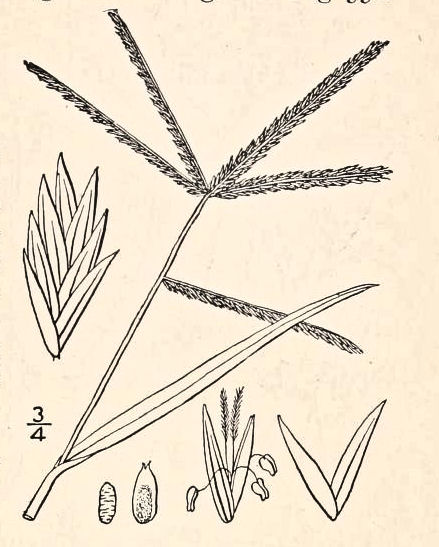
Abb.: बल्वजाः
। Eleusine indica (L.) Gaertn. 1788 - Wilder
Korakan - Indian Goose Grass
[Bildquelle:
An illustrated flora of the northern United States, Canada
and the British possessions ... / by Nathaniel Lord Britton ... and Addison
Brown. -- New York. -- Vol. 1 (1913), S 229]
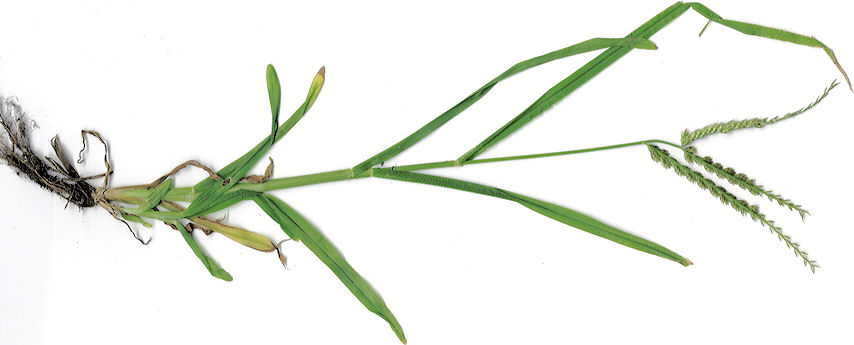
Abb.: बल्वजाः
।
Eleusine indica (L.) Gaertn. 1788 - Wilder Korakan - Indian Goose Grass, Hawaii
[Bildquelle: Forest & Kim Starr. --
http://www.hear.org/starr/images/image/?q=010210-9002&o=plants. -- Zugriff
am 2011-01-14. --
Creative Commons Lizenz (Namensnennung)]
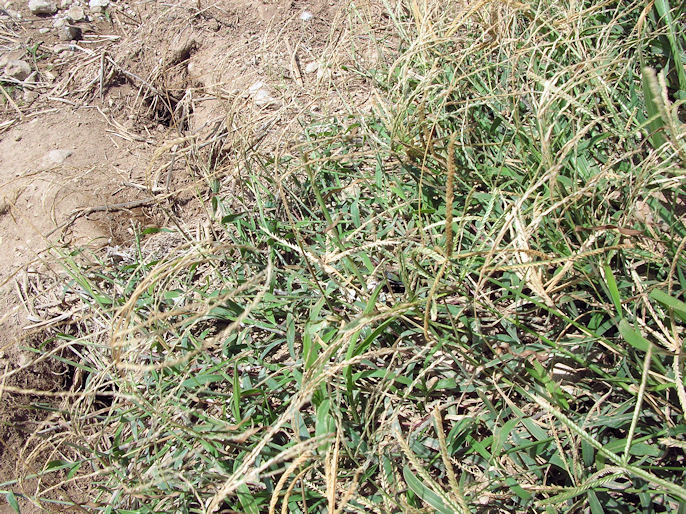
Abb.: बल्वजाः ।
Eleusine indica (L.) Gaertn. 1788 - Wilder Korakan - Indian Goose Grass, Hawaii
[Bildquelle: Forest & Kim Starr. -- http://www.hear.org/starr/images/image/?q=050404-5407&o=plants. -- Zugriff
am 2011-01-14. --
Creative Commons Lizenz (Namensnennung)]
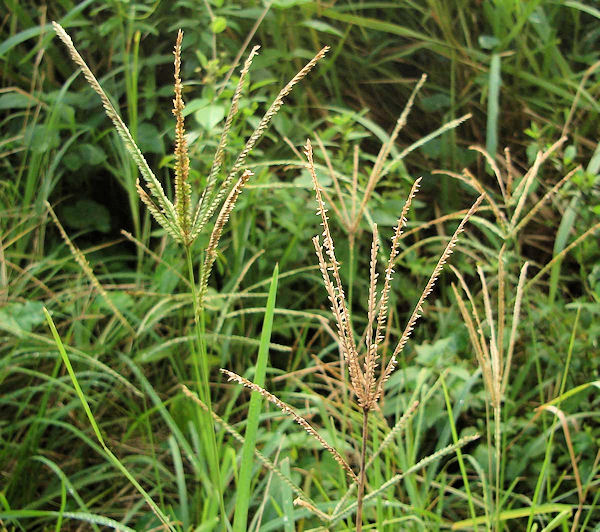
Abb.: बल्वजाः ।
Eleusine indica (L.) Gaertn. 1788 - Wilder Korakan - Indian Goose Grass, Tonga
[Bildquelle: Tauʻolunga / Wikimeadia. -- GNU FDLicense]
Abb.: Eleusine indica (L.) Gaertn. 1788 - Wilder Korakan - Indian Goose Grass, Hawaii
[Bildquelle: Forest & Kim Starr. -- http://www.hear.org/starr/images/image/?q=050404-5407&o=plants. -- Zugriff
am 2011-01-14. --
Creative Commons Lizenz (Namensnennung)]
"Eleusine indica. Gärt. Carp. i. p. 8 t.. 1.
Erect, smooth, from one to two feet high.
[...]
Cynosurus indicus. Linn. sp. pl. ed. Willd. i. 417.
A common coarse species, found growing in large tufts on pasture ground, road sides, &c.
[...]
Obs. Cattle are not fond of it."
[Quelle: Roxburgh, William <1751-1815>: Flora indica, or, Descriptions of Indian plants / by the late William Roxburgh. -- Serampore : Printed for W. Thacker, 1832. -- Vol. 1, S. 345f.]
Imperata cylindrica (L.) P. Beauv 1812 - Silberhaargras - Cogongrass (Saccharum Cylindricum Willd.)
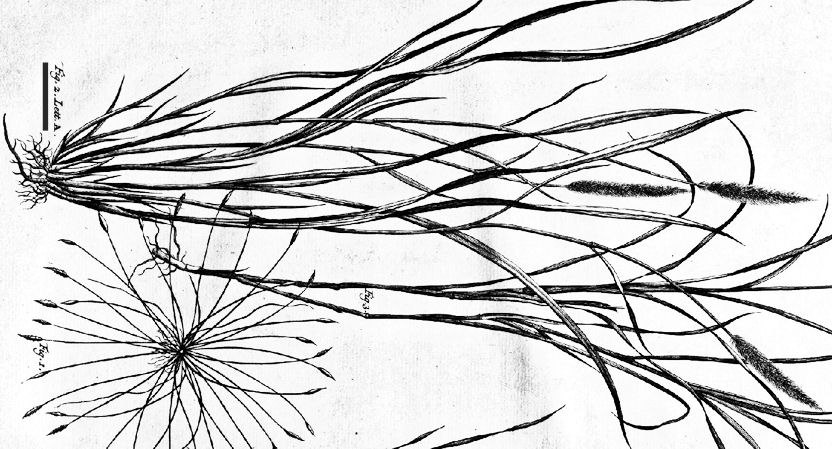
Abb.: Imperata cylindrica (L.) P. Beauv 1812 -
Silberhaargras - Cogongrass (Saccharum Cylindricum Willd.) (Fig. 2 Lett.
A)
[Bildquelle: Herbarium amboinense / Georg. Everhard Rumphius. --
Amsterdam, 1741 - 1750. -- Vol 6, Tab. 7.]
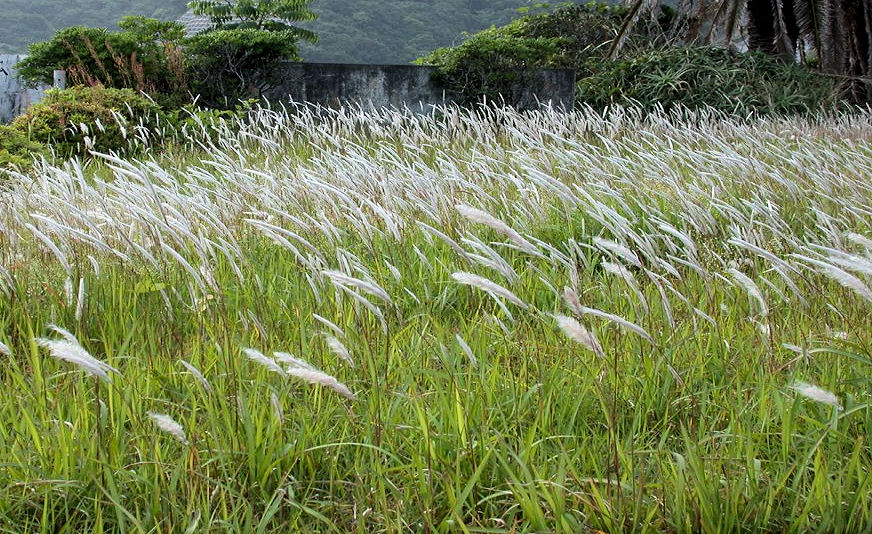
Abb.: Imperata cylindrica (L.)
P. Beauv 1812 - Silberhaargras - Cogongrass, Japan
[Bildquelle: Keisotyo / Wikipedia. -- GNU FDLicense]
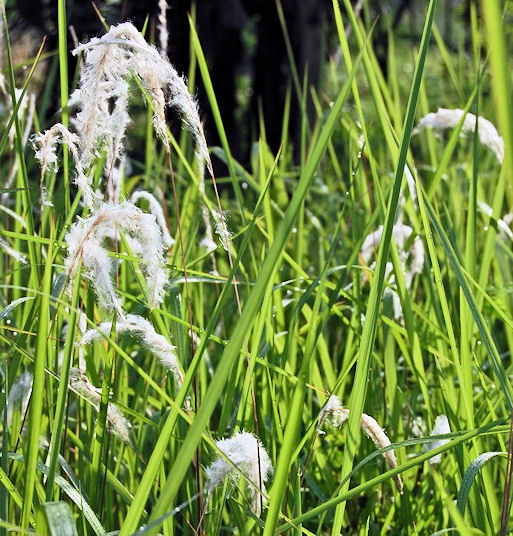
Abb.: Imperata cylindrica (L.)
P. Beauv 1812 - Silberhaargras - Cogongrass, Java, Indonesien
[Bildquelle: W.A. Djatmiko / Wikimedia. -- GNU FDLicense]
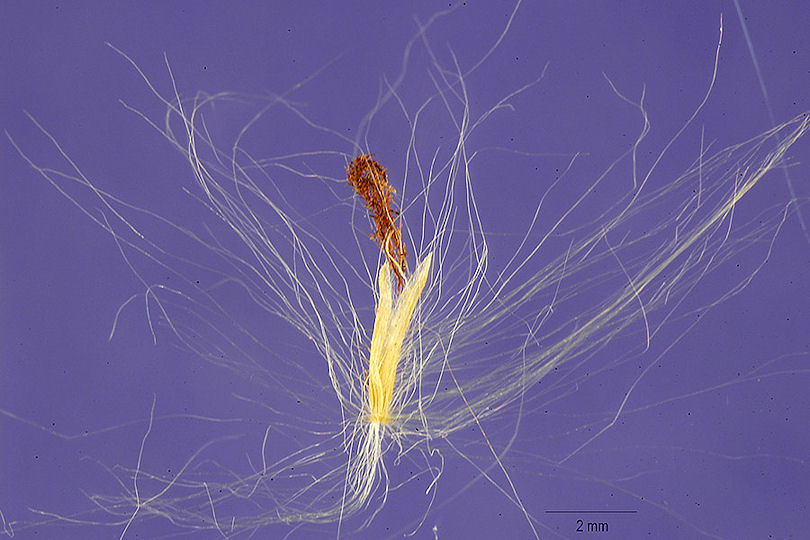
Abb.: Imperata cylindrica (L.)
P. Beauv 1812 - Silberhaargras - Cogongrass
[Bildquelle: Tracey Slotta @ USDA-NRCS PLANTS Database .
--
http://plants.usda.gov/java/profile?symbol=IMCY&photoID=imcy_009_ahp.tif. --
Zugriff am 2010-12-02.]
"Saccharum cylindricum. Linn, sp. pl. ed. Willd. i. 323. [= Imperata cylindrica (L.) P. Beauv 1812]
Culms from one to two feet high, shorter than the leaves.
[...]
Lagurus cylindrica. sp. pl. 120.
S. Thunbergi. Linn. sp. pl. ed. Willd. i. 323. Retz. Obs. v. p. 17.
Gramen caricosum. Rumph. Amb. 6. 17. t. 7. f. 2.
Is a native of moist, stiff, pasture ground, and particularly common over Bengal, where the fields are white with it when in flower, after the first rains in April and May.
Root creeping at some depth under the surface. [...]
Obs. Cattle are not fond of it, particularly when old. It is used in the marriage ceremonies of the Telingas. In Bengal it is much used for thatch."
[Quelle: Roxburgh, William <1751-1815>: Flora indica, or, Descriptions of Indian plants / by the late William Roxburgh. -- Serampore : Printed for W. Thacker, 1832. -- Vol. 1, S. 234f.]
Eleusine coracana (L.) Gaertn. 1788 - Finger Hirse / Korakan - Finger Millet
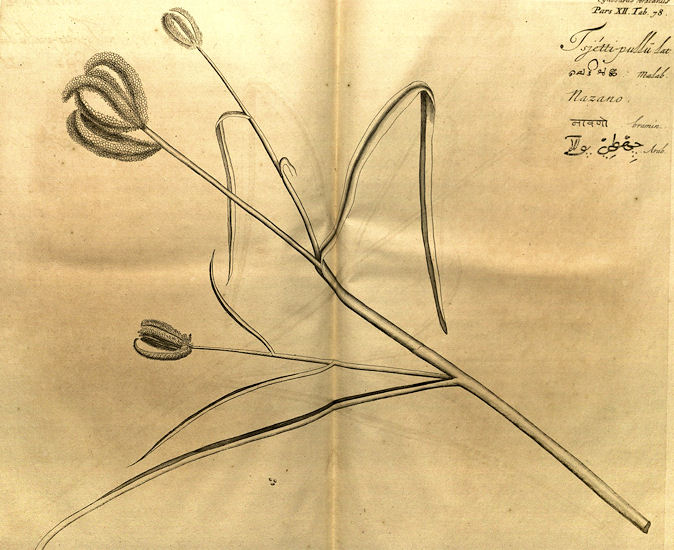
Abb.: Eleusine coracana (L.) Gaertn. 1788 - Finger
Hirse / Korakan - Finger Millet
[Bildquelle: Hortus malabaricus XII. Fig. 78, 1703]
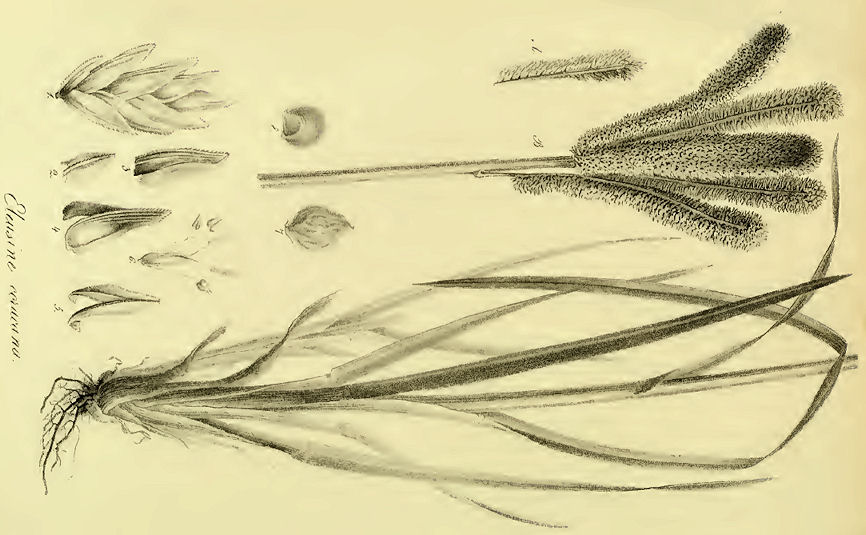
Abb.: Eleusine coracana (L.) Gaertn. 1788 - Finger
Hirse / Korakan - Finger Millet
[Bildquelle: Species Graminum, iconibus et descriptionibus
/ illustravit C.B. Trinius. -- Petersburg, 1828-1836. -- Vol. 1]
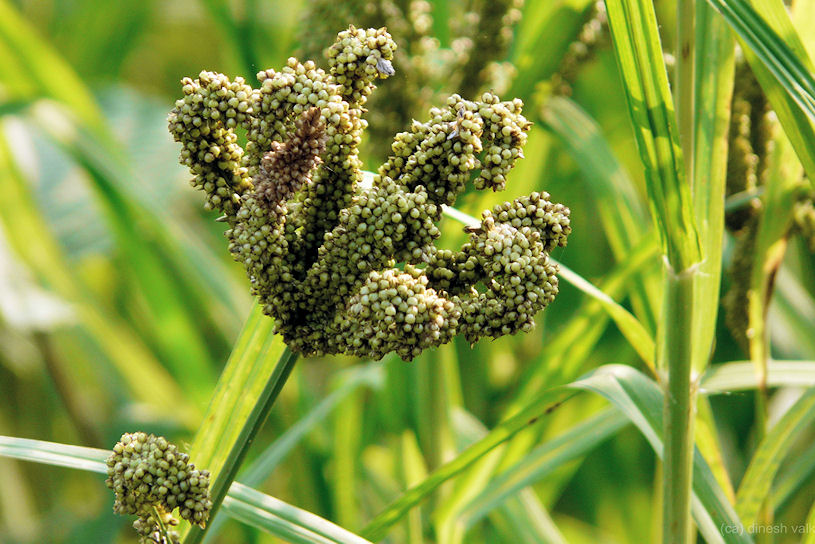
Abb.: Eleusine coracana
(L.) Gaertn. 1788 - Finger Hirse / Korakan - Finger Millet, Maharashtra
[Bildquelle: dinesh_valke. --http://www.flickr.com/photos/91314344@N00/2934263357.
-- Zugriff am 2010-12-02. --
Creative
Commons Lizenz (Namensnennung, keine kommerzielle Nutzung, share alike)]
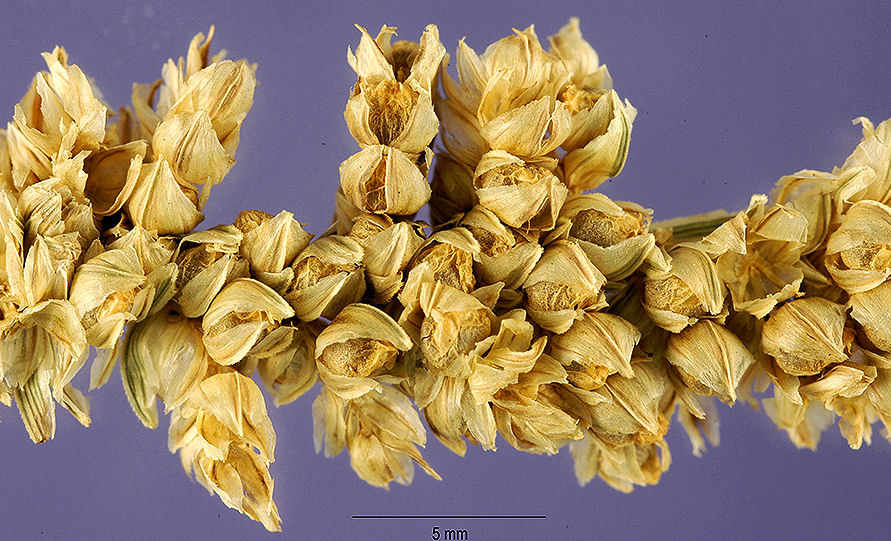
Abb.: Eleusine coracana (L.) Gaertn. 1788 -
Finger Hirse / Korakan - Finger Millet
[Bildquelle: Jose Hernandez @ USDA-NRCS PLANTS Database. --
http://plants.usda.gov/java/profile?symbol=ELCO3&photoID=elco3_002_ahp.tif.
-- Zugriff am 2010-12-02]
"Eleusine Coracana. Gärt. Carp. i. 8. t. 1.
Eleusine. triandria digynia. 343
Cynosurus Coracanus. Linn. sp. pl. ed. Willd. i. 415.
Tsjetti-pullu. Rheed. Hort. Mal. xii. p. 149. t. 78.
Panicum gramineum seu Naatsjoni. Rumph. Amb. v. p. 203. t.76. f.2.
It is called Nutchanee by Europeans on the Coromandel coast.
[...]
This species is cultivated during the rains. I never saw it wild.
Culms erect"
[Quelle: Roxburgh, William <1751-1815>: Flora indica, or, Descriptions of Indian plants / by the late William Roxburgh. -- Serampore : Printed for W. Thacker, 1832. -- Vol. 1, S. 342f.]
"Eleusine coracana (Gaertn.) N. O. Graminacaea. Mootamy, Tsjetti-pullu, Mal. Kayvaru, Kelwaragoo, Tam. Tamida, Sodee, Tbl. Murooa, Bsxa. Bagee, Naclieni, Hind.
Description.—Culms erect, 2-4 feet, [...]
Fl. July—Sept.
Roxb. Fl. Ind. i. 342.
Cynosurus coracanus, Linn.—Rheede, xii t. 78.
Cultivated.
Economic Uses.—This is the most prolific of cultivated grasses, forming the chief diet of the poorer classes in some parts of India, as Mysore, N. Circars, and slopes of the Ghauts. Roxburgh says he never saw it in a wild state. On the Coromandel coast it is known as the Natchnee grain, and is the Raggee of the Mohammedans. In Teloogoo the name of the grain is Ponassa. A fermented liquor is prepared from the seeds called Bojah in the Mahratta country.— (Roxb.) Ragi is perhaps the most productive of Indian cereals. Roxburgh adverts to the extraordinary fertility derived from two seeds which came up by accident in his garden. They yielded 81,000 corns. It is the staple grain of the Mysore country, where it is stored in pits, keeping sound for years.—(W. Elliot.) Another species, the E. stricta, is cultivated to a great extent. It differs from the preceding in having the spikes straight, being of a larger size, and more productive. The seeds are also heavier, which cause the spike to bend bown horizontally. All the millets prefer a light good soil, from which the water readily flows after the heavy rains. In a favourable season the farmers reckon on an increase of about a hundred and twenty fold. The variety known in Teloogoo as the Maddi ruba-soloo requires a richer soil than the others; and in good years, when the land fit for its cultivation can be procured, increases five hundred fold.—Roxb."
[Quelle: Drury, Heber <1819 - 1872>: The useful plants of India : with notices of their chief value in commerce, medicine, and the arts. -- 2d ed. with additions and corrections. London : Allen, 1873. -- xvi, 512 p. ; 22 cm. -- s.v.]
Poaceae (Süßgräser)
|
29. a./b. rasāla ikṣus tadbhedāḥ puṇḍra-kāntārakādayaḥ रसाल इक्षुस् तद्भेदाः पुण्ड्र-कान्तारकादयः ।२९ क। [Bezeichnungen für Saccharum officinarum L. 1753 - Zuckerrohr - Sugar Cane:]
Varietäten davon sind:
|
[29.a:] "Sugarcane." [29.b:] "Varieties of the same."
1 पुण्ड्र - puṇḍra m.: Puṇḍra
puṇḍra m. pl.: Name eines Volkes
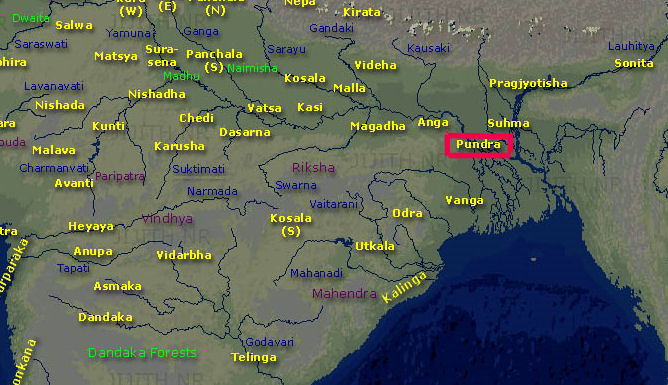
Abb.: Wohngebiet der Puṇḍra
Saccharum officinarum L. 1753 - Zuckerrohr - Sugar Cane
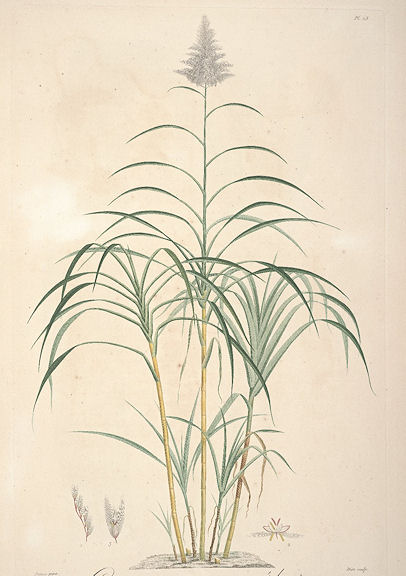
Abb.:
इक्षुः । Saccharum officinarum L. 1753 - Zuckerrohr - Sugar Cane
[Bildquelle: Flore des Antilles / par F.R. de Tussac. -- Paris, 1808-1827. --
Pl. 23]
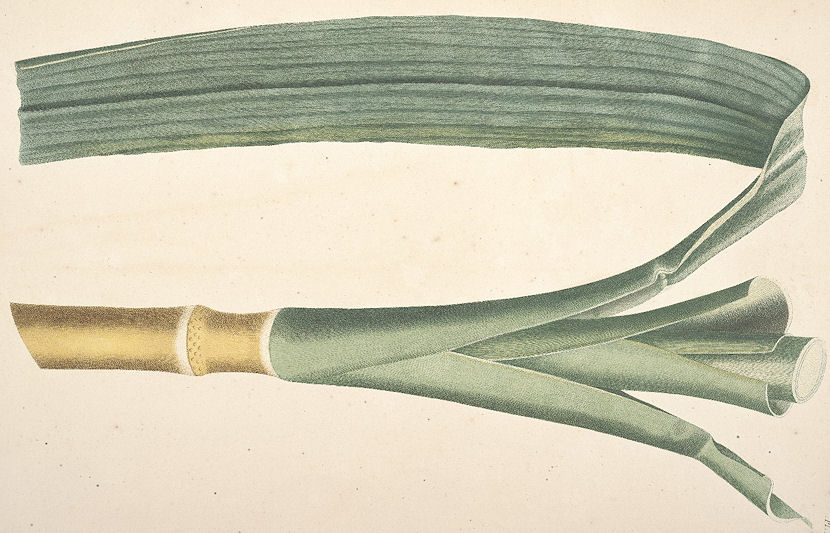
Abb.:
इक्षुः । Saccharum officinarum L. 1753 - Zuckerrohr - Sugar Cane
[Bildquelle: Flore des Antilles / par F.R. de Tussac. -- Paris, 1808-1827. --
Pl. 24]
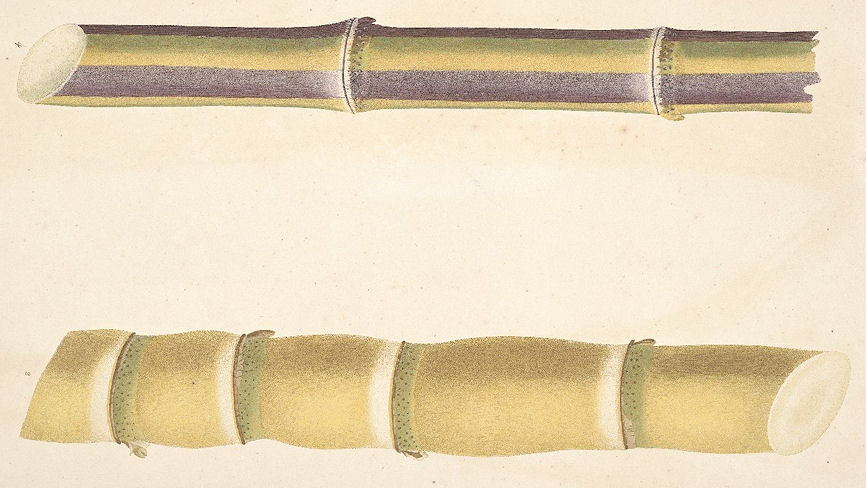
Abb.:
इक्षुः । Saccharum officinarum L. 1753 - Zuckerrohr - Sugar Cane
[Bildquelle: Flore des Antilles / par F.R. de Tussac. -- Paris, 1808-1827. --
Pl. 25]
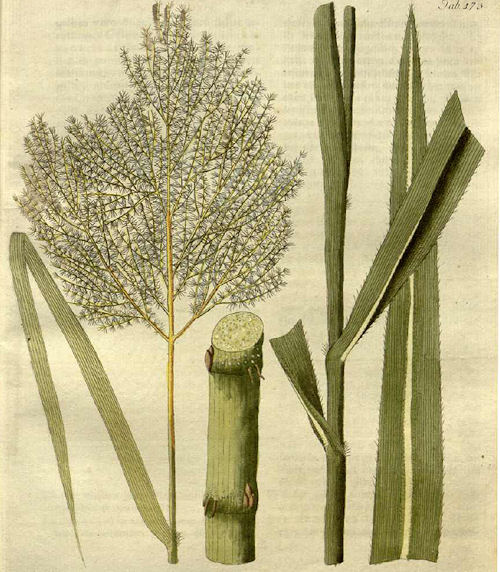
Abb.:
इक्षुः । Saccharum officinarum L. 1753 - Zuckerrohr - Sugar Cane
[Bildquelle: Icones plantarum medico-oeconomico-technologicarum
cum earum fructus ususque descriptione =Abbildungen aller
medizinisch-ökonomisch-technologischen Gewächse mit der Beschreibung ihres
Gebrauches und Nutzens. -- Wien, 1800 - 1822. -- Bd. 2, Tab. 173]
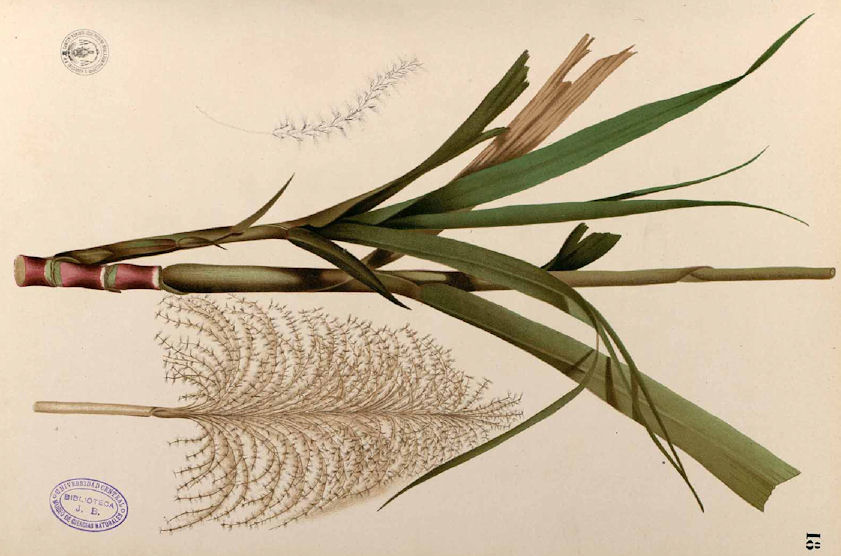
Abb.:
इक्षुः । Saccharum officinarum L. 1753 - Zuckerrohr - Sugar Cane
[Bildquelle: Flora de Filipinas, 1880 / Wikipedia. -- Public domain]
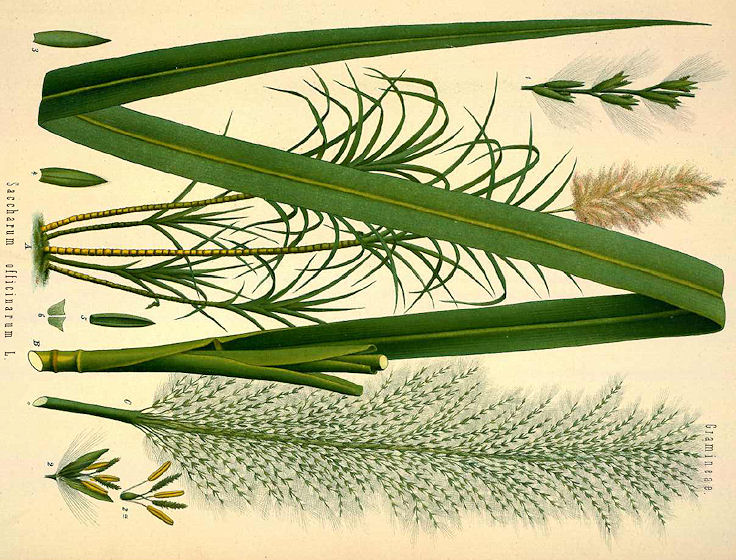
Abb.:
इक्षुः । Saccharum officinarum L. 1753 - Zuckerrohr - Sugar Cane
[Bildquelle: Köhler, 1883-1914]
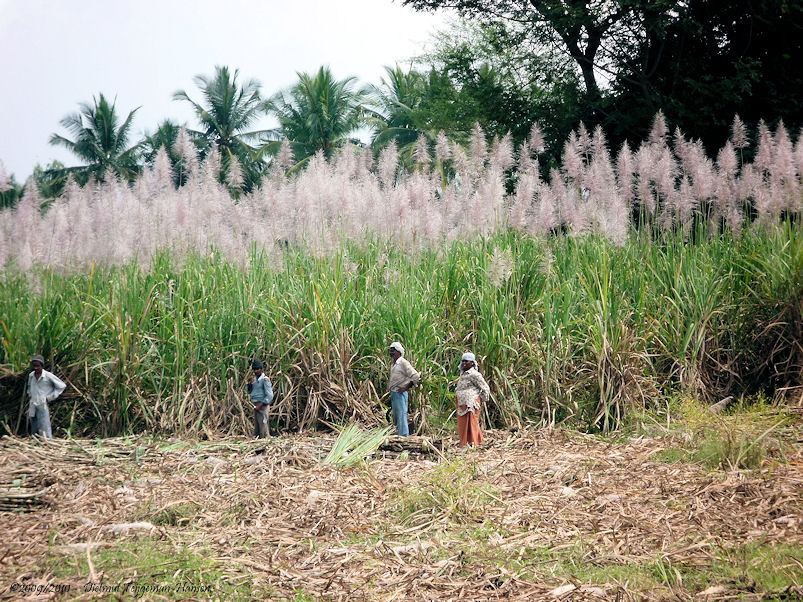
Abb.:
इक्षुः । Saccharum officinarum L. 1753 - Zuckerrohr - Sugar Cane, Karnataka
[Bildquelle:
Dietmut Teijgeman-Hansen. --
http://www.flickr.com/photos/reisgekki/4271467168/. -- Zugriff am
2010-10-24. --
Creative
Commons Lizenz (Namensnennung, keine kommerzielle Nutzung, keine
Bearbeitung)]
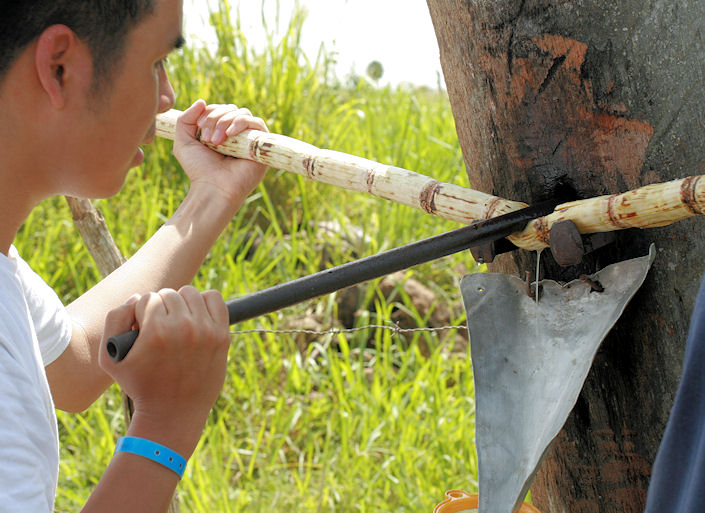
Abb.: रसालः
। Manuelle Gewinnung von Zuckerrohrsaft
[Bildquelle: Krestavilis / Wikipedia. -- GNU FDLicense]
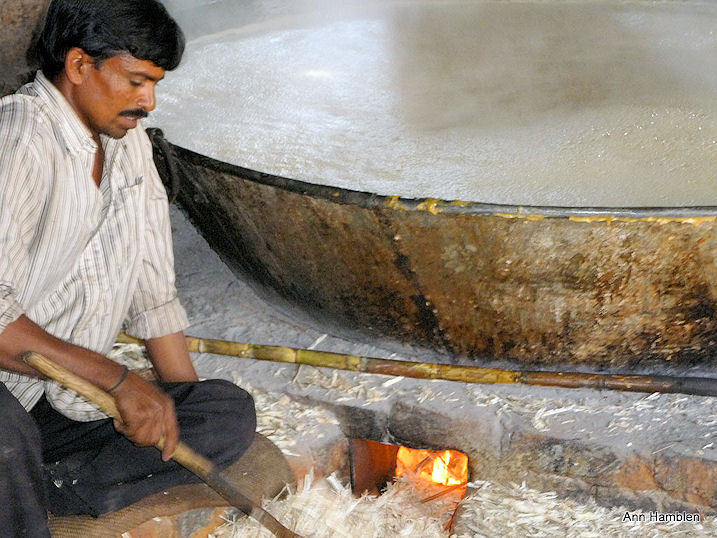
Abb.: रसालः ।
Eindicken von Zuckerrohsaft zu Zucker, Mysore -
ಮೈಸೂರು,
Karnataka
[Bildquelle: Ann Hamblen. --
http://www.flickr.com/photos/primarygeography/4229981703/. -- Zugriff am
2010-10-24. --
Creative
Commons Lizenz (Namensnennung, keine kommerzielle Nutzung, keine
Bearbeitung)]
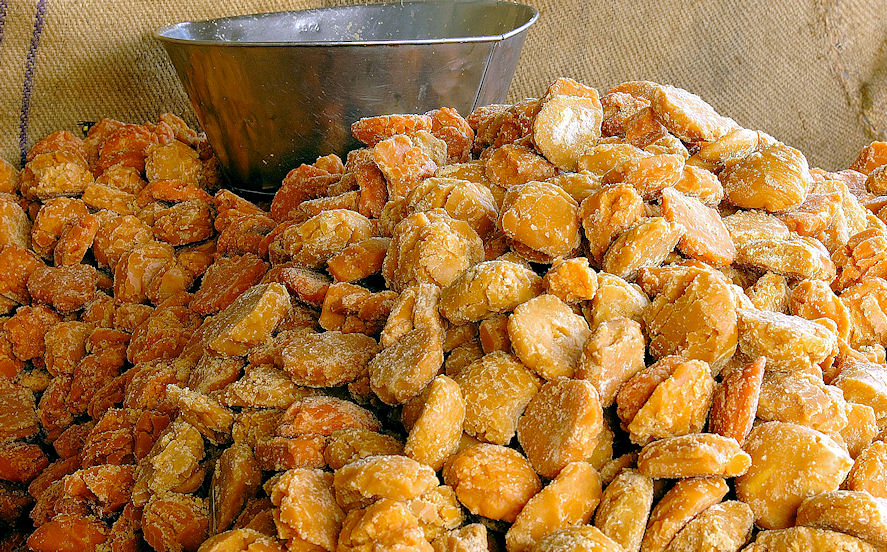
Abb.: गुडाः । Jaggery, Punjab - ਪੰਜਾਬ
[Bildquelle: Giridhar Appaji Nag
Y. --
http://www.flickr.com/photos/appaji/2205964134/. -- Zugriff am 2010-10-24.
-- Creative Commons
Lizenz (Namensnennung)]
"Saccharum Officinarum. Linn, sp. pl. ed. Wifld. i. 321.
Calms from six to twelve feel high. [...]
Sans. Ikshoo, Rusala, the light-coloured varieties; Poondra, and Kanguruka, the red.
[...]
Where wild, I do not know. [...] I have not seen the seed.
Obs. It is much cultivated in the Rajamundri Circar, where they only make a coarse sort of brown raw sugar, which is sold on the spot for about three half-pence per pound. The cane is cultivated on their best lands, which can be easily watered ; but, unless the farmer pleases, not easily flooded during violent rains. The land is first well ploughed during the month of April and beginning of May. The field is then flooded from the river, if there is not sufficient rain; the upper part of the cane is then cut into two lengths of one or two joints each, (the lower part of the same canes are employed to make sugar from) these are placed over the wet field, at about fifteen or eighteen inches asunder, in rows, the rows about four feet from one another, and trode under the soft wet surface with the foot ; in six days after the planting, the field is again flooded, if there has not been rain. In about eight days more the shoots appear ; the land is soon after slightly hoed and weeded. A month after the planting some rotten chaff, or other such manure, is scattered about the young plants. Every ten or fifteen days, if there be not sufficient rain, the field is watered; two months from the planting, some stronger manure is strewed about the plants; and every fifteen or twenty days the field is slightly hoed, and the weeds rooted out.
During the wet season, drains must be made, to carry off the superabundant water. By August or September, the cane will be from three to five feet high ; in each shoot, the produce of every cutting, which may contain from three to six canes, a straight bamboo is stuck into the earth, in the centre; to this the canes are tied by their leaves. In this country the leaves are never stript from the cane, but as they wither are tied round them. This must impede the free circulation of air, which may be conceived hurtful. In January, viz. between nine and ten months from the time they were planted, the cane, when stript of its leaves, and the useless top cut off, will be about as thick as a good stout walking-cane, and from four to six feet long; they then begin to cut the cane, express the juice, and boil the sugar, which is with the natives here, a very simple process ; a small mill turned by cattle squeezes, the cane, and one boiler boils it.
In Bengal there are three varieties cultivated, viz.
The above described or common yellow cane, called by the Bengalees Poori.
Secondly, the purple cane called by them Kajooli, which is said to yield juice one-eighth part richer than the yellow cane ; but the sugar thereof is always of a dark colour.
The third and last, is a very large, light-coloured cane, called Kullooa, which grows in a low swampy soil, where neither of the other two will succeed ; its juice is still weaker than that of the yellow cane ; but it has these advantages, that it grows to a much larger size, and where neither of the other two will thrive. It is therefore much cultivated, because the other sorts planted to higher situations are apt to suffer from drought."
[Quelle: Roxburgh, William <1751-1815>: Flora indica, or, Descriptions of Indian plants / by the late William Roxburgh. -- Serampore : Printed for W. Thacker, 1832. -- Vol. 1, S. 237ff.]
"Saccharum officinarum (Linn.) Common Sugar-cane [...]
Description.—Culm 6-12 feet; [...]
Fl. July—Sept.—Roxb. Fl. Ind. i. 237.
Cultivated in most parts of India.
Economic Uses.—There is every reason to believe that sugar was manufactured from the cane in India in very early ages, and that the Greek word Sakcharon was employed for this identical product, and not for Tabasheer as formerly supposed. From the Arab Sukkur, the Persian Shukkar, and Sanscrit Sarkara, our word sugar is evidently derived. Herodotus certainly alludes to sugar in his fourth book, when he talks of "honey made by the hand of confectioners;" and he is the earliest writer who mentions it. Theophrastus talks of honey made from canes ; but Dioscorides, who flourished in the reign of Nero, was the first Greek writer who used the word Sakcharon. He says, "There is a sort of concreted honey which is called sugar found upon canes in India and Arabia Felix; it is a consistence like salt, and is brittle between the teeth like salt." Pliny also speaks of sugar brought from this country. It was certainly an article of commerce at the commencement of the Christian era, though the early Greek and Roman writers seem to have been imperfectly acquainted with its origin. Its first appearance in Europe is not exactly known, though it was introduced by the Saracens into Sicily, and was known at Venice in 990 a.d. From Sicily it soon spread to all countries of the Old World.
The sugar-cane is now cultivated over most parts of India, the estimated annual produce of sugar being about a million tons. In a report upon the sugar cultivation made by desire of the E. I. Company some years ago, it was stated that the three following kinds were cultivated:—
The Kajooli, or purple-coloured cane. This grows on dry lands in Bengal. It yields a sweet and rich juice of a darkish colour, but sparingly, and is hard to press.
The Pooree, or light-coloured cane. This is deeper yellow when ripe. It grows on richer soil than the former, but the juice is less rich, and of a softer nature.
The Kulloor, or white cane. This grows in moist swampy lands where the other two will not succeed. It yields a less strong sugar than the former, and has a more watery juice. It is more cultivated than the others.
According to Dr Buchanan, there are four kinds known in Mysore— namely, the Restali, the native sugar of Mysore, and the Puttaputti, from which alone the natives extract sugar, and which yields the best Jaggery. The two others are the Maracabo and Cuttaycabo.
The season of planting is soon after the commencement of the rains, in whatever districts the cane may be cultivated, the chief requisites being frequent ploughing of the soil, much manuring, careful removal of weeds ; and in those varieties requiring much moisture the land must occasionally be artificially watered. Dr Roxburgh has given the following account of the cultivation of the Pooree or common yellow cane in the Rajamundry Circars :—
"The land is first well ploughed during the month of April and beginning of May. The field is then flooded from the river if there is not sufficient rain. The upper part of the cane is then cut into two lengths of one or two joints each (the lower part of the same canes are employed to make sugar from); these are placed over the wet fields, at about fifteen or eighteen inches asunder in rows, the rows about four feet from one another, and trod under the soft wet surface with the foot. In six days after the planting the field is again flooded, if there has not been rain. In about eight days more the shoots appear; the land is soon after slightly hoed and weeded. A month after the planting, some rotten chaff or other such manure is scattered about the young plants. Every ten or fifteen days, if there be not sufficient rain, the field is watered. Two months from the planting some stronger manure is strewed about the plants; and every fifteen or twenty days the field is slightly hoed, and the weeds rooted out.
"During the wet season, drains must be made to carry off the superabundant water. By August or September the cane will be from three to five feet high. In each shoot, the produce of every cutting, which may contain from three to six canes, a straight bamboo is struck into the earth, in the centre; to this the canes are tied by their leaves. In this country the leaves are never stripped from the cane, but as they wither are tied round them. This must impede the free circulation of air, which may be conceived hurtful. In January—viz., between nine and ten months from the time they were planted—the cane, when stripped of its leaves and the useless top cut off, will be about as thick as a good stout walking-cane, and from four to six feet long: they then begin to cut the cane, express the juice, and boil the sugar, which is with the natives here a very simple process,—a small ™ill turned by cattle squeezes the cane, and one boiler boils it."
Either a too wet or too dry season is injurious to the sugar-cane; in the former case the quantity of saccharine juice is much diminished. The crops suffer much from the depredations of wild animals, particularly elephants, wild hogs, jackals, besides caterpillars and Worms. White ants are also very destructive. As a remedy against the attacks of the ants, the following recipe has been proposed :—
Assafoetida, 8 chittacks.
Mustard-seed cake, 8 seers.
Putrid fish, 4 seers.
Bruised butch-root, 2 seers ; or muddur, 2 seers.Mix the above together in a large vessel, with water sufficient to make them into the thickness of curds; then steep each slip of cane in it for half an hour before planting; and lastly, water the lines three times previous to setting the cane, by irrigating the watercourse with water mixed up with bruised butch-root, or muddur if the former be not procurable.
A very effectual mode of destroying the white ant is by mixing a small quantity of arsenic with a few ounces of burned bread, pulverised flour, or oatmeal, moistened with molasses, and placing pieces of the dough thus made, each about the size of a turkey's egg, on a flat board, and covered over with a wooden bowl, in several parts of the plantations. The ants soon take possession of these, and the poison has continuous effect, for the ants which die are eaten by those which succeed them. They are said to he driven from a soil by frequently hoeing it. They are found to prevail most upon newly broken up lands.
In Central India, the penetration of the white ants into the interior. of the sets, and the consequent destruction of the latter, is prevented by dipping each end into buttermilk, assafoetida, and powdered mustard-seed, mixed into a thick compound.—Simmands.
There are different processes for separating the sugar from the cane-juice in different countries. The following is the method which obtains in the East Indies : "The liquor, after being strained so as to separate the coarser feculencies, is boiled down, in a range of open boilers heated by a long flue, into a thick inspissate juice, the scum which rises during the operation being removed. When it is sufficiently evaporated, it is removed into earthern pots to cool, and in these it becomes a dark-coloured, soft, viscid mass, called goor or jaggery. Sometimes a little quicklime is added to the juice before boiling, which, by partly clarifying it, renders it capable of being formed into cakes or lumps. In general, however, if intended for subsequent clarification, the juice is merely boiled down, and sold in pots, in a granular honey-like state, to the boilers or refiners. These separate much of the molasses or uncrystallisable part of the juice, by putting the goor into a coarse cloth and subjecting it to pressure. The sugar, which in this state is called shuckar or khand, is further purified by boiling it with water, with the addition of an alkaline solution and a quantity of milk. When this has been continued until scum no longer rises upon the liquor, it is evaporated, and sometimes strained, and afterwards transferred to earthen pots or jars, wide at the top, but coming to a point at the bottom, which is perforated with a small hole, that, at the commencement of the operation, is stopped with the stem of a plantain-leaf. After it has been left for a few days to granulate, the holes in the pots are unstopped, and the molasses drain off into vessels placed to receive it." The sugar is rendered still purer and whiter by covering it with the moist leaves of some succulent aquatic plant (Vallisneria spiralis and Hydrilla verticillata are employed by sugar-refiners for this purpose), the moisture from which drains slowly through the sugar and carries with it the dark- coloured molasses. After several days the leaves are removed, and the upper part of the sugar, which has been most purified, is taken away and dried in the sun. Fresh leaves are then added, by which another layer of sugar is whitened in like manner; and the operation is repeated until the whole mass is refined. The sugar thus prepared is called chenee, and is that which is commonly sent to England.
In regard to quantity and the purity of its sugar, the cane is preferred to any other plant containing saccharine juice. Six to eight lb. of the latter yield 1 lb. of raw sugar; and when properly ripe, 16 to 20 bandy-loads of canes ought to yield a hogshead of sugar. Sugar when simply sucked from the cane is highly nutritious. In the West Indies immense quantities of the cane are consumed in this way; and it has often been remarked how singularly the condition of the negroes becomes changed during the cane harvest, when they become far more. plump and healthy than they are at other seasons. The alimentary properties of sugar are much lessened by crystallisation. The common brown sugar is more nutritious than what has been refined. To persons disposed to dyspepsia and bilious habits, sugar in excess becomes more hurtful than otherwise; and, as Dr Prout observes, " the derangement or partial suspension of the power of converting the saccharine principle in man into the albuminous or oleaginous not only constitutes a formidable species of dyspepsia, but the unassimilated saccharine matter in passing through the kidneys gives occasion to the disease termed diabetes." Now in the blood of a person in perfect health scarcely any sugar exists, whereas during the disease above named it will be found abundantly in the system. Sugar, therefore, whether in the shape of fruit or in whatever form, should be entirely avoided by persons in that condition, and only taken in moderation by persons suffering from bilious habits.
Sugar when concentrated is highly antiseptic, and from a knowledge of its possessing this principle, it is frequently employed in the preservation of vegetable, animal, and medicinal substances. Dried fruits are often preserved a longer time by reason of the sugar contained in them. In cases of poisoning by copper, arsenic, or corrosive sublimate, sugar has been successfully employed as an antidote ; and white sugar finely pulverised is occasionally sprinkled upon ulcers with unhealthy granulations. The Hindoos set a great value upon sugar, and in medicine it is considered by them as nutritious, pectoral, and anthelmintic.
The average annual quantity of cane-sugar imported into the markets of the civilised world at the present time may be taken at 1,500,000 tons, exclusive of what is made for consumption in the several countries where the canes grow, and this would probably amount to another million.—Simmonds. Lindley."
[Quelle: Drury, Heber <1819 - 1872>: The useful plants of India : with notices of their chief value in commerce, medicine, and the arts. -- 2d ed. with additions and corrections. London : Allen, 1873. -- xvi, 512 p. ; 22 cm. -- s.v.]
"SACCHARUM OFFICINARUM, Linn.
Fig. — Woodville, t 266; Tussac, Fl. Antilles, i., tt. 23—25 ; Bentl. and Trim., t. 298.
Sugar-cane
Hab.—India. Cultivated in all warm climates.
[...]
History, Uses, &c.—If the wild form of the sugar-cane is to be anywhere now met with, it is in India, of which country it is undoubtedly a native, and where it has been cultivated from the earliest antiquity. Whether the species grown in China, S. sinense (Roxb.), is specifically the same is scarcely determined with certainty, but it is probably native in that country. (Bentl. and Trim.) The Sanskrit name of the plant is Ikshu, and it is also called Guda-trina, "the grass from which guda is made," and Guda-daru, &c.; from the juice (ikshurasa) the ancient Hindus prepared an extract by boiling, which, when soft and sticky, was called Ikshurasa-kvātha, Phānita, and Guda, but when allowed to drain and become dry was known as Guda-sarkara, Khanda or Khanda-sarkara, and Matoyandika. Twelve varieties of sugar-cane are mentioned by Sanskrit writers, but in this number are probably included other grasses belonging to the genera Saccharum, Sorghum, &c. , The root of the sugarcane is also used in Hindu medicine, and is considered to have demulcent and diuretic properties. It is an ingredient along with the roots of Saccharum sara, S. spontaneum, Eragrostis cynosuroides, and Cynodon dactylon in the compounds known as Trinapancha-mula and Kusa-valeha, which are much prescribed as adjuncts to metallic medicines in gonorrhoea and other affections of the urinary passages. A kind of rum was also obtained by the ancient Hindus from the juice of the cane or from guda and water fermented, which was known as Sidhu and Ganda.
The unrefined, dark-brown Guda or Phānita of the Hindus was known to the ancient Persians as Pāniz and Shakar; from it they manufactured the dry crystalline sugar which they call Kand or Nabāt,[...]. We have already stated (see Article on Bambusa) our reasons for believing that the σακχαρον of Dioscorides was not cane-sugar, viz., that no such article as sugar in a dry crystalline state was known in India at that time, the only kind of sugar used by the Hindus being the dark-brown mass known as guda, and which is still the kind of sugar most popular in India. This substance, as well as the guda prepared from the palm (φαινιξ), was called by the Greeks μελι (honey), and is mentioned by Herodotus, Theophrastus, Seneca, Strabo, and other early writers as "Honey of Canes" and "Honey made by human hands." The .vernacular names Misri, "Egyptian," for refined sugar, and Chini, "Chinese," for sugar-candy, point to these crystalline forms of sugar as comparatively recent introductions into India, and at the present time the sugar-candy of Indian commerce is chiefly imported from China. When we consider that the sugar-cane was known to the ancients from the time of Nearchus, it is hardly reasonable to suppose that Pliny could be so ill-informed as to speak of Saccharum, if by that name he meant cane-sugar, as only employed in medicine. Lucan, writing about the same time, was aware that the Hindus drank the juice of the cane:
"Quique bibunt tenera dulces ab arundine succos."
At the present day, the cane-presser, with his primitive press, is a familiar personage at Indian fairs, where he dispenses the luscious juice to his customers at about twopence a pint.
Sugar, under the name of Shi-mi "stone honey," is frequently mentioned in the ancient Chinese annals among the productions of India and Persia; and it is recorded that the Emperor Tai-tsung (A.D. 626—650) sent an envoy to the kingdom of Magadha in India, to learn the method of manufacturing it. (Bretschneider, Chinese Botanical Works, 1870, 46.) The Chinese acknowledge that the Indians between A.D. 766 and 780 were their first teachers in the art of making sugar. An Arabian writer, Abu Zaid-el-Hasan, states that about A.D. 850 the sugar-cane was growing on the north-eastern shore of the Persian Gulf; and in the following century, the traveller Ali Istakhri found sugar abundantly produced in the Persian Province of Kuzistan. About the same time (950) Moses Chorenensis stated that the manufacture of sugar was flourishing near the celebrated school of medicine at Jondisabur in the same province, and remains of this industry in the shape of millstones, &c., still exist near Ahwas.
Persian and Arabian physicians of the 10th and 11th centuries, such as Rāzi, Ali Abbas, and Ibn Sina, introduced sugar (Sukkar ) into medicine. The Arabs cultivated the cane in many of their Mediterranean settlements, as Cyprus, Sicily, Italy, Northern Africa, and Spain. The Calendar of Cordova shows that as early as A. D. 961 the cultivation was well understood in Spain, which is now the only country in Europe where sugar-mills still exist.
The importance of the sugar manufacture in the East was witnessed by Marco Polo, Barbosa, and other European travellers ; and the trading nations of Europe rapidly spread the cultivation of the cane over all the countries of which the climate was suitable. The ancient cultivation in Egypt, probably never quite extinct, was revised on an extensive scale by the Khedive Ismail Pasha. (Pharmacographia.)
Sugar is of comparatively little value for its independent effects, but few substances are more useful as an associate of other medicines, whether to preserve them from oxidation and decomposition, to conceal or improve their taste, or to give them special pharmaceutical forms.
[...]
Cultivation.—The sugar-cane season comprises nearly a twelvemonth. The land chosen is usually a good loam or light clay manured. The leafy ends of the preceding season's canes are cut off, or the whole cane is chopped into pieces so as in any case to include two nodes or joints, and these, to the number of about 20,000 per acre, are planted in furrows in January and February. The land is irrigated occasionally from this time to the commencement of the rains. The harvest begins in the beginning of December, and the cutting and crushing of the canes and boiling of the juice is carried on till January and February. Excepting the few mills under European management, the crushing and boiling is performed by primitive, and, therefore, rude processes. The average outturn per cent, of cane in the North-West Provinces is stated by Messrs. Duthie and Fuller to be as follows: 100 of canes=15 of juice=18 of guda (unrefined sugar) or 17.5 of shakar (dry, unrefined sugar), or 19.5 of rāb (syrupy sugar). The natives generally manufacture the juice into the two kinds of guda, called in the vernaculars gūra or gūla."
[Quelle: Pharmacographia indica : a history of the principal drugs of vegetable origin met with in British India / by William Dymock [1834-1892], C. J. H. Warden and David Hooper [1858-1947]. -- Bd. 3. -- London, 1893. -- S. 592ff.]
Poaceae (Süßgräser)
|
29. c./d. syād vīraṇaṃ vīrataraṃ mūle 'syośīram astriyām 30. abhayaṃ naladaṃ sevyam amṛṇālaṃ jalāśayam lāmajjakaṃ laghulayam avadāheṣṭakāpathe
स्याद् वीरणं वीरतरं मूले
ऽस्योशीरम् अस्त्रियाम् ॥२९ ख॥ [Bezeichnungen für Vetiveria zizanoides (L.) Nash 1903 - Vetivergras - Cus Cus:]
Seine Wurzel heißt उशीर - uśīra n. m.: Uśīra. [Eine Varietät der Vetiverwurzel heißt:]
|
Colebrooke (1807): "A fragrant grass. Andropogon muricatum [Retz. = Vetiveria zizanoides (L.) Nash 1903]." [29.d - 30.d:] "Its root."
zu 30: "Bhāvamiśra states that it is a variety of uśīra - Vetiveria zizanoides (L.) Nash. But in market a similar kind of grass - Cymbopogon iwarancusa Jones is available in this name. It is still to be decided which one is correct." (Bhāvaprakāśa I, S. 225)
Cymbopogon iwarancusa Jones: siehe unten
1 वीरण - vīraṇa n.: Vīraṇa
vīraṇa ist auch der Name eines Prajāpati
Vetiveria zizanoides (L.) Nash 1903 - Vetivergras - Cus Cus
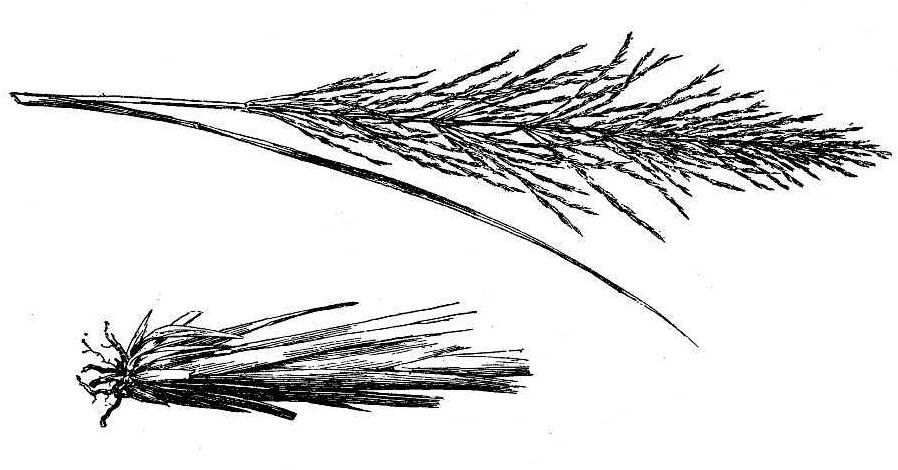
Abb.: Vetiveria zizanoides (L.) Nash 1903 - Vetivergras - Cus Cus
[Bildquelle: USDA / Wikimedia. -- Public domain]
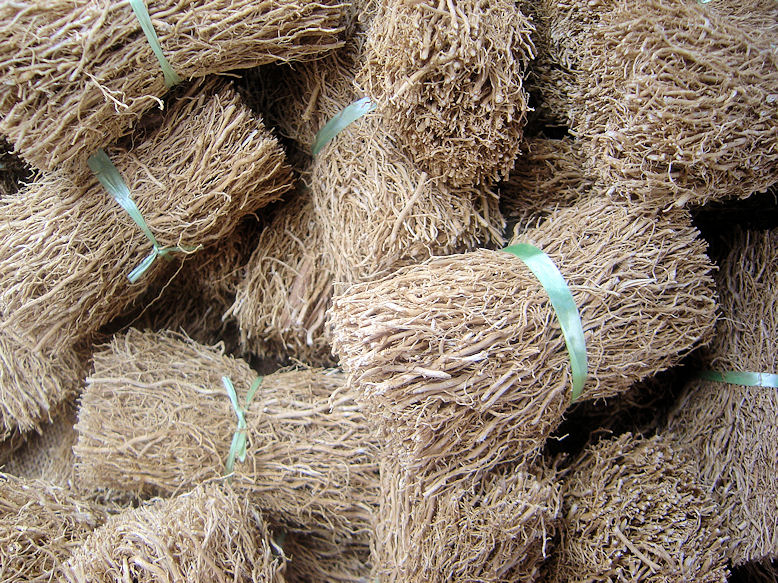
Abb.: नलदम् । Wurzeln von Vetiveria zizanoides (L.) Nash 1903 - Vetivergras - Cus
Cus, Réunion
[Bildquelle: David Monniaux / Wikimedia. -- GNU FDLicense]
"Andropogon muricatus. Retz. Obs. iii. N. 95. and v. 20. [=Vetiveria zizanoides (L.) Nash 1903]
Erect in all situations.
[...]
Sans. Veerunung, Veeruturung.
[...]
Virana. Asiat. Res. vol. iv. p. 306.
It is very common in every part of the coast and Bengal, where it meets with a low, moist, rich soil, especially on the banks of water courses, &c.
[...]
Obs. The roots, when dry, and then gently moistened, emit a pleasant kind of fragrance; they are employed to make large fans, commonly called Vissaries; and also screens which are placed before windows and doors, which being kept moist during the hot winds render the air that passes through them, both cool and fragrant. See Observation on Aristida setacea. The grass is often employed for thatch.
Dr. König was too accurate a Botanist to describe this very conspicuous plant under two names, viz. A. squarrosus. Linn. sp. pl. Willd. iv. 908, and A. muricatus ; the former is evidently a very different species, and found by him in Ceylon, floating on pools of water ; whereas A. muricatus (which I formerly called aromaticus) is always rigidly erect, whether growing in water, or on dry land. Its root is delightfully aromatic, as mentioned by Konig himself, and by Sir William Jones, particularly when moistened with water.
I am inclined to think König's A. squarrosus is my Panicum paludosum ; a species with thick spongy culms, which is generally found swimming on pools of sweet water."
[Quelle: Roxburgh, William <1751-1815>: Flora indica, or, Descriptions of Indian plants / by the late William Roxburgh. -- Serampore : Printed for W. Thacker, 1832. -- Vol. 1, S. 265ff.]
"ANDROPOGON MURICATUS, Retz.
Fig.—Beauv. Agr., t. 22.
Cuscus
Hab.—Coromandel, Mysore, Bengal, Northern India.
[...]
History, Uses, &c.—The root of this grass, which is the only part of the plant having aromatic properties, is described in the Nighantas under the name of Usira, and bears among other synonyms those of Virana, Veni-mulaka "having braided roots," Sugandhi-mulaka "having sweet-smelling roots," Sita-mulaka " having cool roots," &c. It is considered to be cooling, refrigerant and stomachic, removing bile and phlegm, and useful to allay thirst in fever and inflammatory affections. An infusion is used, and it enters into the composition of several cooling mixtures. Sir W. Jones suggests that it is the Mrināla mentioned in Kalidasa's Sakuntala, but that name is more commonly applied to the leaf-stalk of the Lotus than to the roots of this grass. All parts of the Lotus are renowned for their cooling properties, and the use of the Water Lily for Sakuntala's complaint appears to us to be more Poetical. In Vedic times the ancient Hindus were instructed to build their houses in a place where the Virana and Kusa were abundant, and on some copper-plate inscriptions discovered near Etawah, dated A.D. 1103 and 1174, this plant is mentioned as one of the articles upon which the kings of Kanauj levied imports (Proc. As. Soc. Bengal, 1873, p. 161). Externally it is used in a variety of ways: a paste of the root is rubbed on the skin to relieve oppressive heat or burning of the body; an aromatic cooling bath is prepared by adding to a tub of water the root in fine powder, together with the root of Pavonia odorata, red sandalwood and the wood of Prunus Puddum. The same ingredients are applied in the form of a thin paste to the skin. (Chakradatta.)
All over India the roots are made into aromatic scented mats, hung in door-ways, and kept wet to cool and perfume the atmosphere during the hot season; they are also much used for making fans, ornamental baskets, and other small articles. When distilled with water, the roots yield a fragrant oil, which is used as a perfume and for flavouring sherbet. Mir Muhammad Husain, in the Makhzan-d-Adwiya, describes khas as a kind of Izkhir used in India, known as Izkhir-i-Jāmi and called by the Persians Bikh-i-wāla. European physicians in India have used the root as a diaphoretic, and Pereira (Mat. Med., ii., Pt. I., p. 132) states that in 1831 it was used in Paris and Hamburg as a preservative against cholera, being hung up in rooms and burnt as a fumigatory. In 1837 it was recommended by Foy in rheumatism and gout. At the present time the root is distilled in Europe to obtain the oil, which commands a high price, being used in the composition of many favourite perfumes, as "Mousseline des Indes," "Maréchal," "Bouquet du Roi," &c."
[Quelle: Pharmacographia indica : a history of the principal drugs of vegetable origin met with in British India / by William Dymock [1834-1892], C. J. H. Warden and David Hooper [1858-1947]. -- Bd. 3. -- London, 1893. -- S. 571ff.]
|
31. a./b. naḍādayas tṛṇaṃ garmuc-chyāmākapramukhā api नडादयस् तृणं गर्मुच्-छ्यामाकप्रमुखा अपि ।३१ क। नड - naḍa (Phragmites karka (Retz.) Trin. ex Steud. 1841 oder Lobelia nicotinianifolia (nicotininaefolia, necolinianifola ?) Heyne; Vers 28.a/b) heißen तृण - tṛṇa n.: Gras. Ebenso (tṛṇa) heißen:
|
Erläuterungen:
Colebrooke (1807): "A gramineous plant. Including reeds, grasses and corn ; as Panicum frumentaceum, (Roxb.) [= Echinochloa frumentacea Link 1827 - Sawa-Hirse - Billion Dollar Grass] &c. comprehending the after-mentioned grasses, besides various sorts of grain, as कगुः - kagu, Panicum Italicum [= Setaria italica (L.) P. Beauv. 1812 - Kolbenhirse - Italian Millet], कोद्रवः - kodrava, Paspalum frumentaceum [= Paspalum scrobiculatum L. 1767 - Kodo-Hirse - Indian Crown Grass] &c."
Echinochloa frumentacea Link 1827 - Sawa-Hirse - Billion Dollar Grass
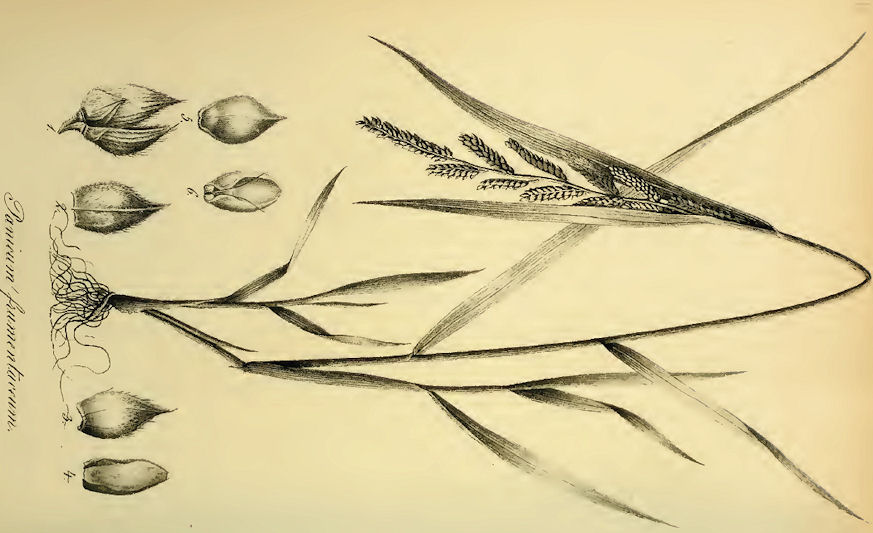
Abb.: Echinochloa frumentacea Link 1827 -
Sawa-Hirse - Billion Dollar Grass
[Bildquelle: Species Graminum, iconibus et descriptionibus
/ illustravit C.B. Trinius. -- Petersburg, 1828-1836. -- Vol. 2]
"Panicum frumentaceum. Roxb. [= Echinochloa frumentacea Link 1827]
Culms erect, from two to four feet high.
[...]
Sans. Shyamaka.
This I have only found in a state of cultivation, it delights in a light, tolerably dry, rich soil ; the same ground yields two crops between the first of the rains in June, July, and the end of January.
[...]
Obs. There are several varieties of it known to the Hindoo farmers. The seed is wholesome and nourishing, it is an article of diet, particularly amongst the lower classes of the natives. It yields about fifty-fold in a good soil. Cattle are fond of it."
[Quelle: Roxburgh, William <1751-1815>: Flora indica, or, Descriptions of Indian plants / by the late William Roxburgh. -- Serampore : Printed for W. Thacker, 1832. -- Vol. 1, S. 304f.]
Setaria italica (L.) P. Beauv. 1812 - Kolbenhirse - Italian Millet
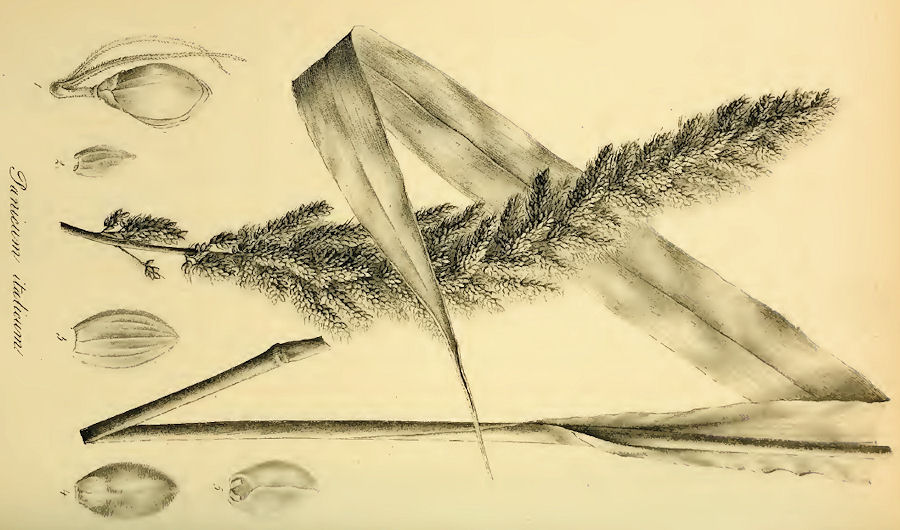
Abb.: कगुः । Setaria italica (L.) P. Beauv. 1812 -
Kolbenhirse - Italian Millet
[Bildquelle: Species Graminum, iconibus et descriptionibus
/ illustravit C.B. Trinius. -- Petersburg, 1828-1836. -- Vol. 2]
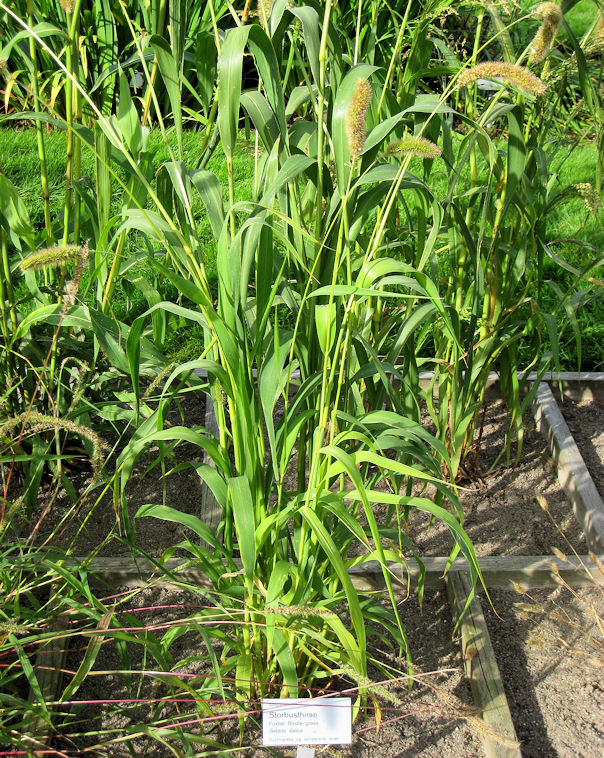
Abb.: कगुः । Setaria italica (L.) P. Beauv. 1812 -
Kolbenhirse - Italian Millet
[Bildquelle: Daderot / Wikimedia. -- Public domain]
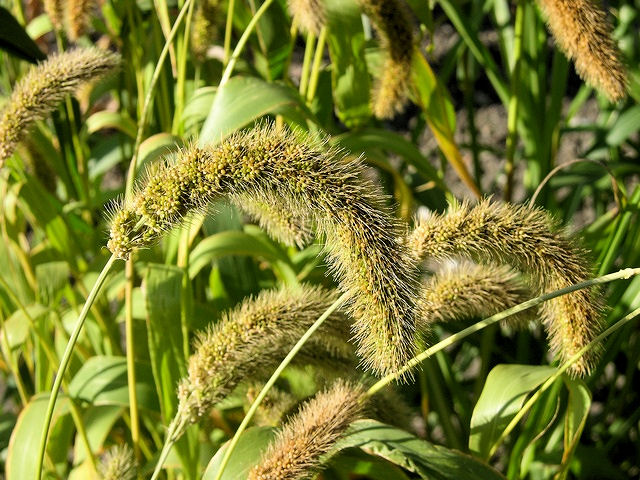
Abb.: कगुः । Setaria italica (L.) P. Beauv. 1812 -
Kolbenhirse - Italian Millet
[Bildquelle: JCSchou / Biopix. --
http://www.eol.org/pages/1114673. -- Zugriff am 2010-12-02. --
Creative Commons Lizenz
(Namensnennung, keine kommerzielle Nutzung)]
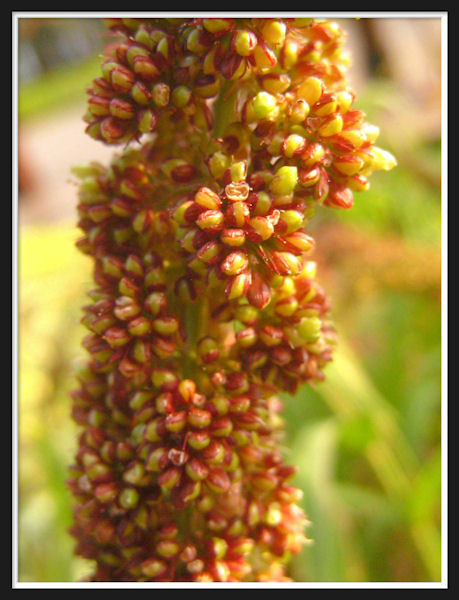
Abb.: कगुः । Setaria italica (L.) P. Beauv. 1812 -
Kolbenhirse - Italian Millet, Taiwan
[Bildquelle: jennyhsu47. --
http://www.flickr.com/photos/jennyhsu47/4433927437/. -- Zugriff am
2010-12-02. --
Creative Commons Lizenz (Namensnennung, keine kommerzielle Nutzung, keine
Bearbeitung)]
"Panicum italicum. Linn. sp. pl. ed. Willd. i. 336.
Culms erect.
[...]
Panicum. Rumph. Amb. x. p. 202. t. 175 f. 2.
Sans. Kungoo, Priyungoo.
[...]
This is one of the plants called dry or small grain. It is cultivated in many parts of India, and requires an elevated, light soil. I never saw it wild.
[...]
Obs. [...]
The seed is an article of diet with the natives. It delights in a light, elevated, tolerably dry soil. Seed time for the first crop, about the months of June and July ; harvest time in September; produce about fifty-fold in a favourable season. A second crop may be had from the same ground, between September and the end of January."
[Quelle: Roxburgh, William <1751-1815>: Flora indica, or, Descriptions of Indian plants / by the late William Roxburgh. -- Serampore : Printed for W. Thacker, 1832. -- Vol. 1, S. 302f.]
"Panicum Italicum (Linn.) N. O. Graminaceae Italian Millet [...]
Description.--Culms erect, 3-5 feet [...]
Roxb. Fl. Ind. i. 302.
Setaria Italica, Beauv.
Cultivated.
Economic Uses.—This is considered by the natives one of the most delicious of cultivated grains. The Brahmins—indeed all classes of natives—particularly esteem it, and use the seeds for cakes, porridge, &c. It is good for pastry—scarcely inferior, says Ainslie, to wheat; and when boiled with milk, makes a pleasant light diet for invalids. It is cultivated in many parts of India, requiring a dry light soil. The seed-time for the first crop is in June and July; for the second, between September and February. There are several kinds of millet cultivated in the Peninsula, among which the most celebrated are P. miliaceum (Willd.) and P. frumentaceum (Roxb.), of which there are several varieties.—Boxb. Ainslie."
[Quelle: Drury, Heber <1819 - 1872>: The useful plants of India : with notices of their chief value in commerce, medicine, and the arts. -- 2d ed. with additions and corrections. London : Allen, 1873. -- xvi, 512 p. ; 22 cm. -- s.v.]
Paspalum scrobiculatum L. 1767 - Kodo-Hirse - Indian Crown Grass
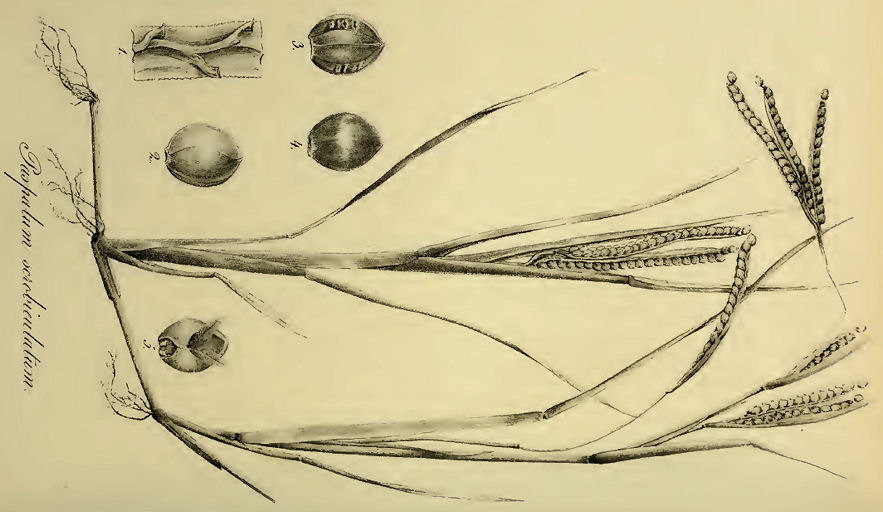
कोद्रवः । Paspalum scrobiculatum L. 1767 - Kodo-Hirse
- Indian Crown Grass
[Bildquelle: Species Graminum, iconibus et descriptionibus
/ illustravit C.B. Trinius. -- Petersburg, 1828-1836. -- Vol. 2]
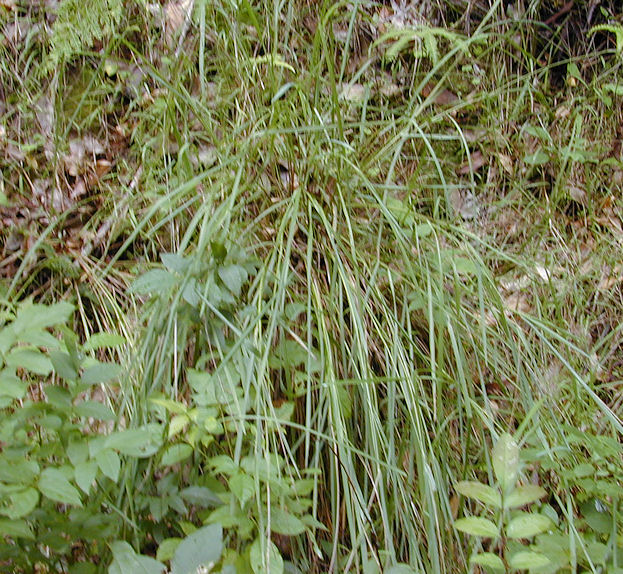
कोद्रवः । Paspalum scrobiculatum L. 1767 - Kodo-Hirse
- Indian Crown Grass
[Bildquelle: Forest & Kim Starr. --
http://www.hear.org/starr/images/image/?q=030405-0044&o=plants. -- Zugriff
am 2010-12-02. --
Creative Commons Lizenz (Namensnennung)]
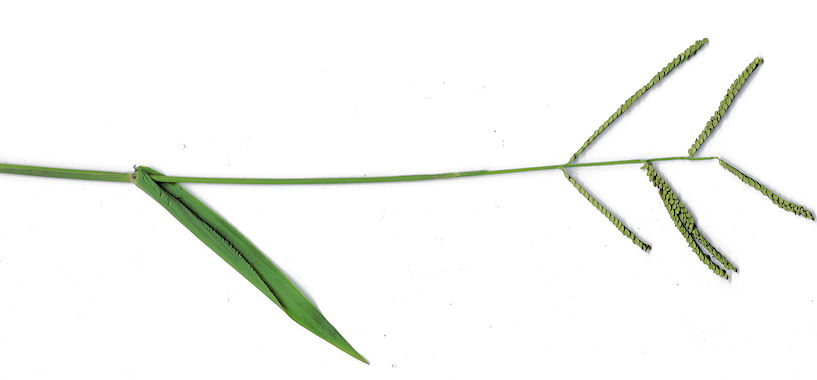
कोद्रवः । Paspalum scrobiculatum L. 1767 -
Kodo-Hirse - Indian Crown Grass
[Bildquelle: Forest & Kim Starr. --
http://www.hear.org/starr/images/image/?q=030807-8006&o=plants. -- Zugriff
am 2010-12-02. --
Creative Commons Lizenz (Namensnennung)]
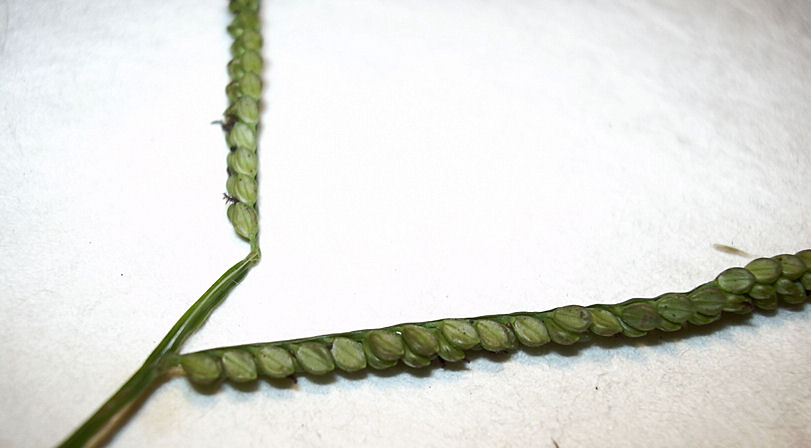
कोद्रवः । Paspalum scrobiculatum L. 1767 - Kodo-Hirse
- Indian Crown Grass
[Bildquelle: Forest & Kim Starr. --
http://www.hear.org/starr/images/image/?q=030808-0064&o=plants. -- Zugriff
am 2010-12-02. --
Creative Commons Lizenz (Namensnennung)]
"Paspalum scrobiculatum. Linn, sp. pl. ed. Willd. i. 330. [= Paspalum scrobiculatum L. 1767]
[...]
Sans. Korudoosha, Kodrava.
[...]
This is cultivated by the natives over many parts of India. It delights in a light, dry, loose soil, but will grow in a very barren one. Time of cultivation the rainy season.
[...]
Obs. The seed is an article of diet with the Hindoos, particularly with those who inhabit the mountains and most barren parts of the country, for it is in such countries only where it is cultivated, it being an unprofitable crop, and not sown where others more beneficial will thrive. I have eaten of the boiled grain, and think it as palatable as rice."
[Quelle: Roxburgh, William <1751-1815>: Flora indica, or, Descriptions of Indian plants / by the late William Roxburgh. -- Serampore : Printed for W. Thacker, 1832. -- Vol. 1, S. 278f.]
Poaceae (Süßgräser)
|
31. c./d.
astrī kuśaṃ kutho darbhaḥ pavitram
atha kattṛṇam अस्त्री कुशं कुथो दर्भः पवित्रम् अथ कत्तृणम् ॥३१ ख॥ [Bezeichnungen für Desmostachys bipinnata (L.) Stapf. 1900:]
|
Colebrooke (1807): "Sacrificial grass. Poa cynosuroides, Koen. [Retz 1786 = Desmostachys bipinnata (L.) Stapf. 1900]"
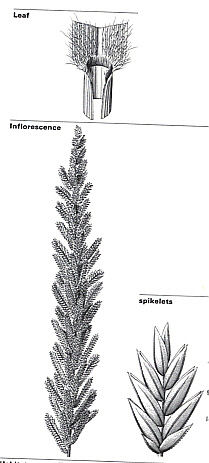
Abb.: Desmostachys bipinnata (L.) Stapf. 1900
[Bildquelle: Häfliger, Ernst ; Scholz, Hildemar: Grass
weeds. -- Basel : Ciba-Geigy, 1980-1982. -- 3
Bde. : Ill. -- (Documenta / Ciba-Geigy). -- Bd. 2. -- S. 59 ]
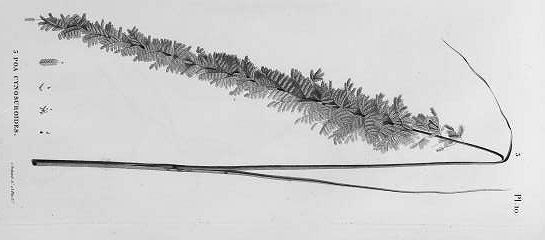
Abb.: Desmostachys bipinnata (L.) Stapf. 1900
[Bildquelle: Description de l'Égypte 1809ff. -- Public domain]
"Poa cynosuroides. Linn. sp. pl. ed. Willd. i. 393. [= Desmostachys bipinnata (L.) Stapf. 1900]
Smooth, straight, from one to three feet high. Leaves long and acute. Panicle straight, sub-cylindrical ; ramifications horizontal ; spikelets depending, from six to twelve-flowered.
Uniola bipinnata. Linn. sp. pl. 104.
Sans. Koosha, Kootha, Darbha, Pavitrug.
[...]
A strong coarse species, a native of dry barren ground. Root creeping, perennial.
[...]
Obs. It is employed by the brahmins in their religious ceremonies. Cattle do not eat it. Can this be Gramen capillaceum ? &c. Pluck. Alm. p. 176. t. 34. Fig. 2. Cusa, or Cusha, the Sanscrit name of this much venerated grass, was given to it at a very early period, by the Hindoo Philosophers, and believed, by Sir William Jones, to have been consecrated to the memory of Cush, one of the sons of Ram. See Asiatic Researches, vol. iii. p. 490. If so, we have here a very ancient precedent for the present very convenient practice of giving such arbitrary names to plants, and to their families."
[Quelle: Roxburgh, William <1751-1815>: Flora indica, or, Descriptions of Indian plants / by the late William Roxburgh. -- Serampore : Printed for W. Thacker, 1832. -- Vol. 1, S. 333.]
Poaceae (Süßgräser)
|
31. c./d.
astrī kuśaṃ kutho darbhaḥ pavitram
atha kattṛṇam 32. a./b. paura-saugandhika-dhyāma-devajagdhaka-rauhiṣam
अस्त्री कुशं कुथो दर्भः पवित्रम्
अथ कत्तृणम् ॥३१ ख॥ [Bezeichnungen für Cymbopogon jwarancusa (Jones) Schult. 1824:]
|
Colebrooke (1807): "A fragrant grass."
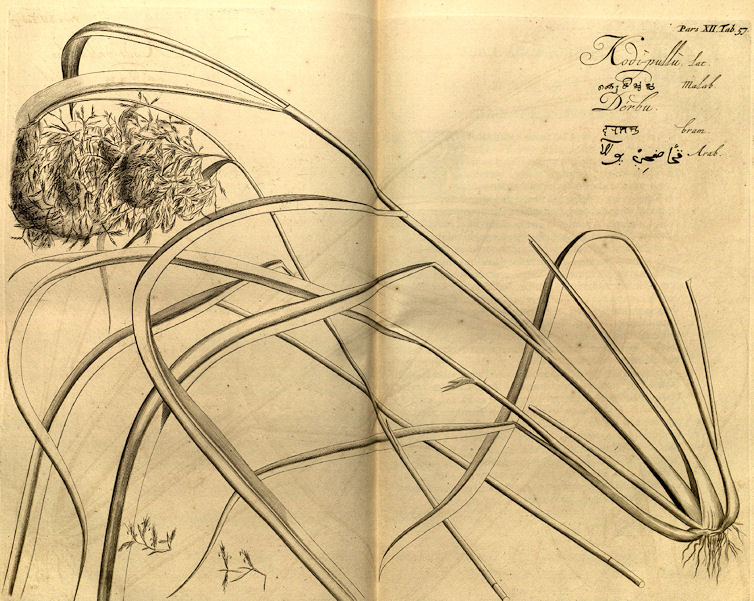
Abb.: कत्तृणम् । Cymbopogon jwarancusa (Jones) Schult. 1824
[Bildquelle: Hortus malabaricus XII. Fig. 57, 1703]
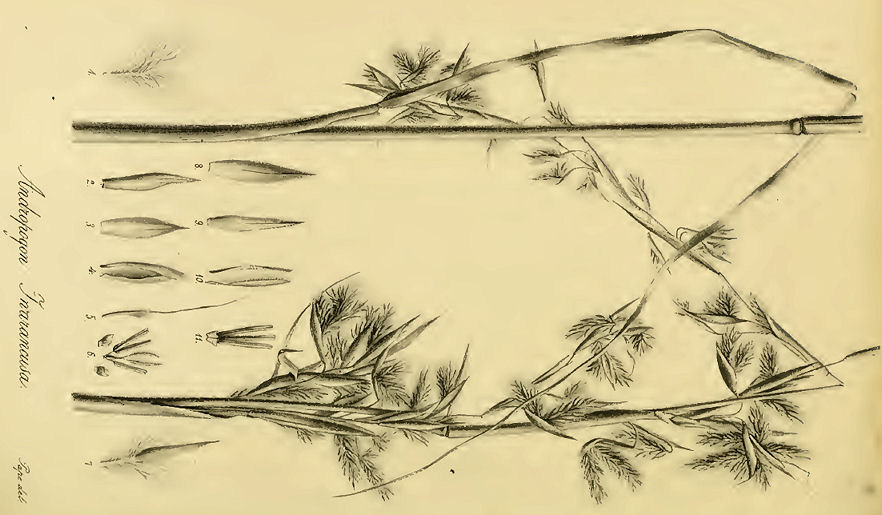
Abb.:
पौरम् । Cymbopogon jwarancusa (Jones) Schult. 1824
[Bildquelle: Species Graminum, iconibus et descriptionibus /
illustravit C.B. Trinius. -- Petersburg, 1828-1836. -- Vol. 3]
"Andropogon Iwarancusa. Philosoph. Transact, vol. 80. 284. 1. 16.
Perennial, erect.
[...]
Iwarancussa. Asial. Res. iv. 109.
A native of the skirts of the northern mountains of India. Dr. Blane found it between the river Raptee and the mountains, and Dr. Boyd about Hurdwar; it is therefore probably a native of a very extensive tract along the skirts of that range of mountains which bounds the plains of Bengal, Bahar, Oude, &c. Flowering time the rainy season.
It grows in large tufts, each tuft composed of a number of plants adhering together by their roots.
Root perennial, [...]
Obs. This species comes remarkably near to A. Schoenanthus both in habit and taste.
For the virtues of the roots of this plant, see Dr. Blane's account thereof in the second part of the 80th volume of the Philosophical Transactions of the Royal Society of London ; also Asiatic Researches, iv. p. 109. The virtues seem to reside almost entirely in the larger parts of the root, marked with annular cicatrices, the taste is agreeably aromatic, with some degree of bitterness."
[Quelle: Roxburgh, William <1751-1815>: Flora indica, or, Descriptions of Indian plants / by the late William Roxburgh. -- Serampore : Printed for W. Thacker, 1832. -- Vol. 1, S. 275ff.]
"Andropogon Iwarancusa (Roxb.) [= Cymbopogon jwarancusa (Jones) Schult. 1824] Description.—Root perennial, fibrous; culms erect, 3-6 feet, [...]
Roxb. Fl. Ind. i. 275.—Lindl. Flor. Med. 611.
Skirts of the mountains of N. India. Hurdwar.
Medical Uses.—The roots of this fragrant grass are used by the natives in Northern India in intermittent fevers. In habit and taste it is similar to the A. schoenanthus. Dr Boyle denies that it yields a grass oil.—Pereira. Royle."
[Quelle: Drury, Heber <1819 - 1872>: The useful plants of India : with notices of their chief value in commerce, medicine, and the arts. -- 2d ed. with additions and corrections. London : Allen, 1873. -- xvi, 512 p. ; 22 cm. -- s.v.]
|
32. c./d. chatrāticchatra-pālaghnau mālātṛṇaka-bhūstṛṇeछत्रातिच्छत्र-पालघ्नौ मालातृणक-भूस्तृणे ॥३२ ख॥[Bezeichnungen für einen bestimmten Pilz:]
|
Colebrooke (1807): "A mushroom."
Die Pharmacographia Indica (III, S. 628ff.) nennt folgende Pilze, die verwendet werden:
Mylitta lapidescens Horan. 1856, = Omphalia lapidescens (Horan.) Cohn & J. Schröt. - Thunder Ball
Boletus crocatus Batsch.
Polyporus officinalis (Vill.) Fries, 1821 = Laricifomes officinalis (Vill.) Kotl. & Pouzar, 1957 - Agarikon mushroom
Auf keinen davon scheinen die bei Amara gegebenen Beschreibungen (chatra - Schirm) zuzutreffen.
Die Beschreibung chatra, atichatra passt gut auf den Macrolepiota procera (Scop.) Singer - Parasol. Die Bezeichnung pāla-ghna verweist allerdings eher auf einen Giftpilz.
Macrolepiota procera (Scop.) Singer - Parasol
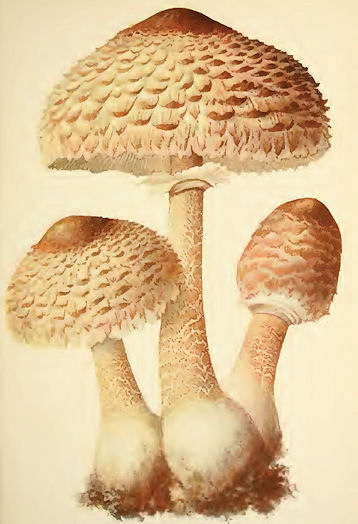
Abb.: Macrolepiota procera (Scop.) Singer - Parasol
[Bildquelle: Führer für Pilzfreunde / Edmund Michael. -- Zwickau, 1901. -- Tafel
53]
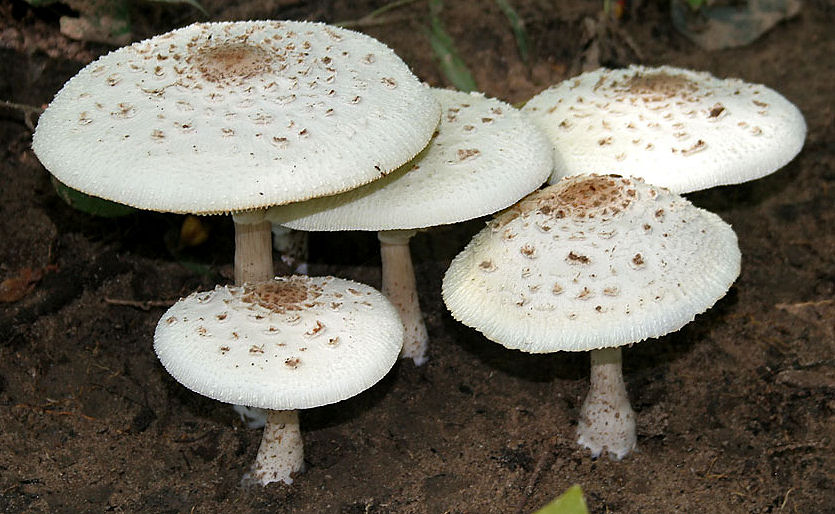
Abb.: Macrolepiota procera (Scop.) Singer - Parasol, Narsapur -
నరసాపురం, Andhra Pradesh
[Bildquelle: J. M. Garg / Wikimedia. -- GNU FDLicense]
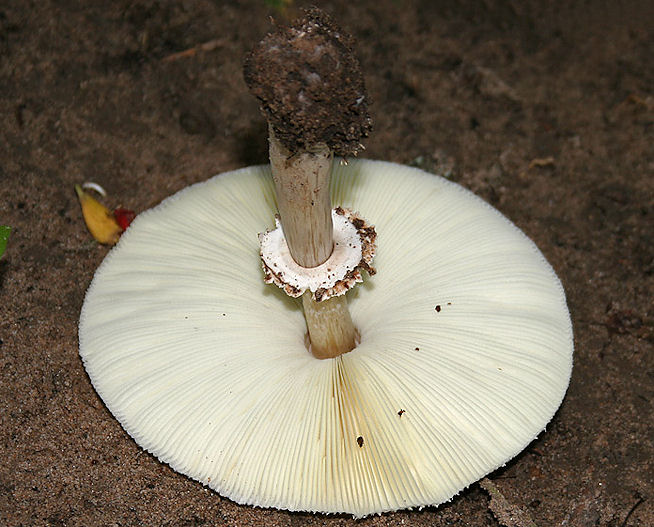
Abb.: Macrolepiota procera (Scop.) Singer - Parasol, Narsapur -
నరసాపురం, Andhra Pradesh
[Bildquelle: J. M. Garg / Wikimedia. -- GNU FDLicense]
Mylitta lapidescens Horan., 1856 = Omphalia lapidescens (Horan.) Cohn & J. Schröt. - Thunder Ball
Hat keine Schirmform (chatra) und ist deshalb hier nicht gemeint.
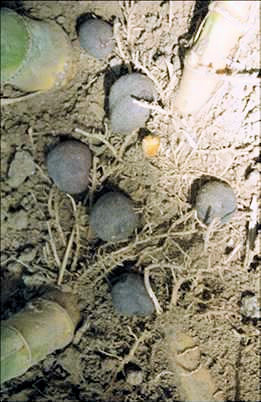
Abb.: Omphalia lapidescens (Horan.) Cohn & J. Schröt. - Thunder Ball
[Bildquelle: International Centre for Science and High Technology (ICS-UNIDO).
--
http://portal.ics.trieste.it/MAPs/MedicinalPlants_Plant.aspx?id=634. --
Zugriff am 2011-01-07. -- "Extracts from ICS-UNIDO material contained in this
website may be freely used elsewhere provided that acknowledgement of the source
is made."]
"MYLITTA LAPIDESCENS. Horan.
Fig.—Trans. Linn. Soc., vol xxiii., t. 9, p. 97.
Hab.—India and China.
[...]
History, Uses, &c.—This curious underground fungus is supposed to be allied to the truffles, and is used in Southern India as medicine and food. In 1860 Dr. E. J. Waring forwarded to Mr. Hanbury some specimens of these tuberiform productions, and they were examined by Mr. M. J. Berkeley and Mr. Currey. These specimens had been dug out from the chalk-beds in the mountains between Travancore and Tinnevelly, and the hill-people were in the habit of bringing them into Trevandrum for sale. They are much esteemed by native doctors for various complaints, and they are regarded as diuretic. The Tamil name signifies Black Pallagum, Pallagum meaning a medicinal substance. The fungus frequently appears on the Nilgiris, and the Badagas. Karumbars, and other hill-tribes call it "God's bread" or "Little man's bread," and use it for food. In 1889 the Peziza was very plentiful in the Government Cinchona Plantations at Natuvatam, and the specimens were found over a wide area about one foot beneath the surface of the ground. Planters on other parts of the hills have noticed their periodical occurrence in their estates, and the coolies always collect and cook them for their meals.
Description.—These fungoid bodies are like small tubers having a black,. finely-wrinkled surface, and the inside is white and marked with veins, and a microscopic section shows the division of the tissue into areola similar to that exhibited by hypogaeous fungi. In a fresh state they have a waxy consistence, but when dry they are hard and horny. Some fresh slices immersed in glycerine for several weeks showed no crystalline or crystalloid formations, and starch was entirely absent."
[Quelle: Pharmacographia indica : a history of the principal drugs of vegetable origin met with in British India / by William Dymock [1834-1892], C. J. H. Warden and David Hooper [1858-1947]. -- Bd. 3. -- London, 1893. -- S. 628f.]
Boletus crocatus Batsch.
"BOLETUS CROCATUS, Batsch.
Hab.—India, on the Jack-tree (Artocarpus integrifolia, Linn.)
[...]
History, Uses, &c.—The only notice of this fungus, which we have met with, occurs in Rumphius (Hort. Amb., i., 25), where he says:— "In Malabara ac Zeylana ex eodem quoque succo circa radices colligitur et concrescit in terra massa, seu tuber Portugallis Isca de Jaca (tinder of the Jack-tree) dictum, quod molle est et intus flavescit, quod natio ista pro experto habet medicamento contra diarrhoeam, ad paucas vero tantum colligitur arbores, atque inde venale in alias quoque transfertur regiones.'' It appears to be probable that the medicinal use of this fungus was introduced into the East by the Portuguese, who adopted it as a substitute for the Boletus fomentarius of Linneus, the Agaricus Chirurgorum or "surgeon's agaric " of the old European Pharmacopoeias, which the Portuguese call Isca de ferir "wound tinder," and the French Agaric de chêne or Polypore ongulé. It is the Spunk or Touchwood of the English.
In Western India the fungus is ground to a paste with water and applied to the gums in cases of excessive salivation. It is also applied to the mouths of children suffering from aphthae, and is given internally in diarrhoea and dysentery.
Description.-—In form this fungus closely resembles the European Boletus above referred to, and resembles the hoof of a horse. Internally it is of a rich orange-brown colour when fresh, and has a sweetish, styptic taste, but when long kept it turns to a dull brown colour. The fungus consists of a number of laminae upon the under surface of which the hymenium is situated."
[Quelle: Pharmacographia indica : a history of the principal drugs of vegetable origin met with in British India / by William Dymock [1834-1892], C. J. H. Warden and David Hooper [1858-1947]. -- Bd. 3. -- London, 1893. -- S. 629f.]
Polyporus officinalis (Vill.) Fries, 1821 = Laricifomes officinalis (Vill.) Kotl. & Pouzar, 1957 - Agarikon mushroom
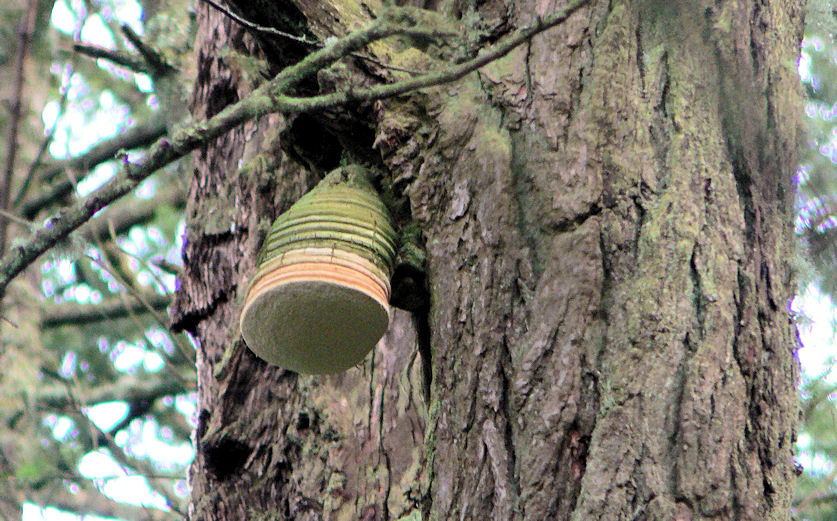
Abb.: Laricifomes officinalis (Vill.) Kotl. & Pouzar, 1957, Washington
State, USA - Agarikon mushroom
[Bildquelle: Walter Siegmund / Wikimedia. -- GNU FDLicense]
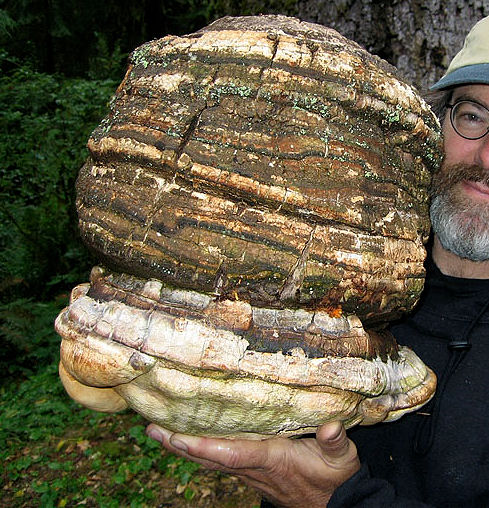
Abb.: Laricifomes officinalis (Vill.) Kotl. & Pouzar, 1957 - Agarikon
mushroom
[Bildquelle: Walter Siegmund / Wikimedia. -- GNU FDLicense]
"POLYPORUS OFFICINALIS, Fries.
Fig.—Guibourt, Hist. Nat. ii., 45; Pereira, Mat. Med, ii., Pt. 1, p. 54.
Larch Agaric
Hab.—Southern Europe, Asia Minor. On the Larch.
The fungus.
Vernacular.—Ghārikūn (Indian Bazars).
History, Uses, &c.—The use of this fungus in medicine is of very ancient date. Dioscorides (iii., 1) describes αγαρικον as male and female, the female being the best and having internally a comb-like structure, whilst the male is convolute, round and compact (συμφνες); both have the same taste, at first sweet, afterwards bitter. He states that it grows in Sarmatia, Galatia in Asia, and Cilicia, and that some suppose it to be a root and others a fungus. It is astringent, hot, and purgative, and is also given in fever, jaundice, nephritis, uterine obstructions, phthisis, dyspepsia, haemorrhage, and pains in the joints; it is alexipharmic. Pliny (25, 57) says : "Agaric is found growing in the form of a fungus of a white colour, upon the trees in the vicinity of the Bosporus. It is administered in doses of four oboli, beaten up in two cyathi of oxymel. The kind that grows in Galatia is generally looked upon as not so efficacious. The male agaric is firmer than the other, and more bitter ; it is productive, too, of headache. The female plant is of a looser texture; it has a sweet taste at first, which speedily_changes into a bitter flavour."
Pereira states that the drug appears in the modern Greek Pharmacopoeia under the name of αγαρικον το λευκον with the Turkish synonym of κατραν μανταρι.
Ibn Sina insists upon the great efficacy of agaric as an alexipharmic. He and other Mahometan physicians closely follow the Greeks in their description of its medicinal properties; they consider that it removes all kinds of visceral obstructions and expels diseased humors; the female kind should be used after it has been rubbed through a hair-sieve us removed. The use of a-uric in phthisis is of ancient date ; it was revived by De Haen, Barbut, and others in the present century, and subsequently decried by Andral (Phil. Trans., Vols. 48 and 49). The active principle, agaricin, has recently been recommended in doses of 1/12 to 1/6 of a grain as an astringent to cheek night-sweating and diarrhoea, to diminish bronchial secretion, and to dry up the milk after weening.
Description.—Pileus corky-fleshy, ungulate, zoned, smooth. Pores yellowish. Berkeley describes the hymenium as concrete with the substance of the pileus, consisting of subrotund spores with their simple dissepiments. The drug is decorticated, dried, and bleached, and occurs in white, friable pieces, from the size of the fist to that of a child's head, which are more or less ungulate or of the shape of half a cone, with a feeble fungous odour and bitter acrid taste. The fungus when met with in its natural state, has an external yellowish or reddish-grey coat."
[Quelle: Pharmacographia indica : a history of the principal drugs of vegetable origin met with in British India / by William Dymock [1834-1892], C. J. H. Warden and David Hooper [1858-1947]. -- Bd. 3. -- London, 1893. -- S. 631f.]
Poaceae (Süßgräser)
|
32. c./d.
chatrāticchatra-pālaghnau
mālātṛṇaka-bhūstṛṇe छत्रातिच्छत्र-पालघ्नौ मालातृणक-भूस्तृणे ॥३२ ख॥ [Bezeichnungen für Cymbopogon citratus (DC. ex Nees) Stapf 1906 - Westindisches Zitronengras - West Indian Lemon Grass:]
|
Colebrooke (1807): "Andropogon. A. schoenanthus [L. = Cymbopogon schoenanthus (L.) Spreng. subsp. schoenanthus]
. But some make these synonymous with the preceeding terms."
Cymbopogon citratus (DC. ex Nees) Stapf 1906 - Westindisches Zitronengras - West Indian Lemon Grass
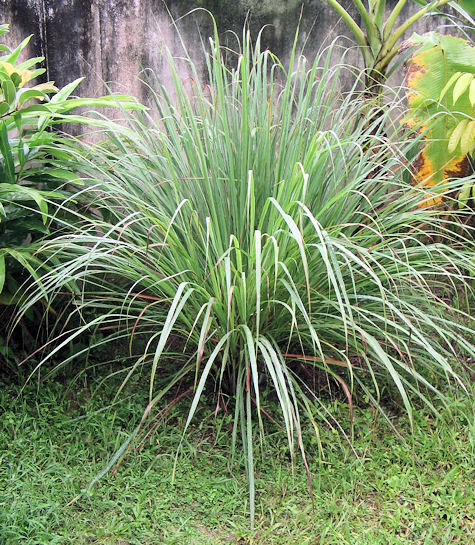
Abb.:
मालातृणकम् । Cymbopogon citratus (DC. ex Nees) Stapf 1906 - Westindisches
Zitronengras - West Indian Lemon Grass
[Bildquelle: Hakcipta Yosri / Wikimedia. --
Creative Commons
Lizenz (Namensnennung)]
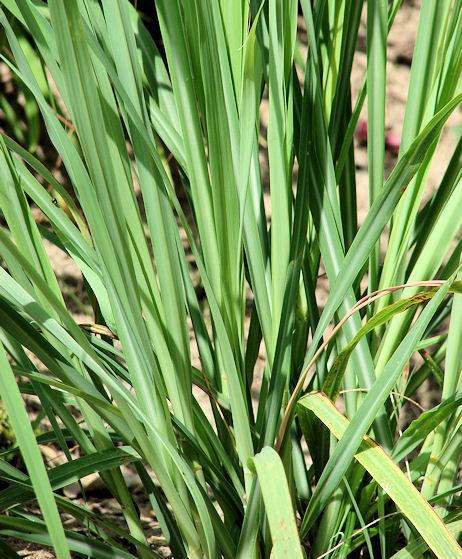
Abb.: Cymbopogon citratus (DC. ex Nees) Stapf 1906 - Westindisches
Zitronengras - West Indian Lemon Grass, Midway Atoll
[Bildquelle: Forest Starr & Kim Starr. --
http://www.hear.org/starr/images/image/?q=080531-4968&o=plants. -- Zugriff
am 2010-10-23. --
Creative Commons Lizenz (Namensnennung)]
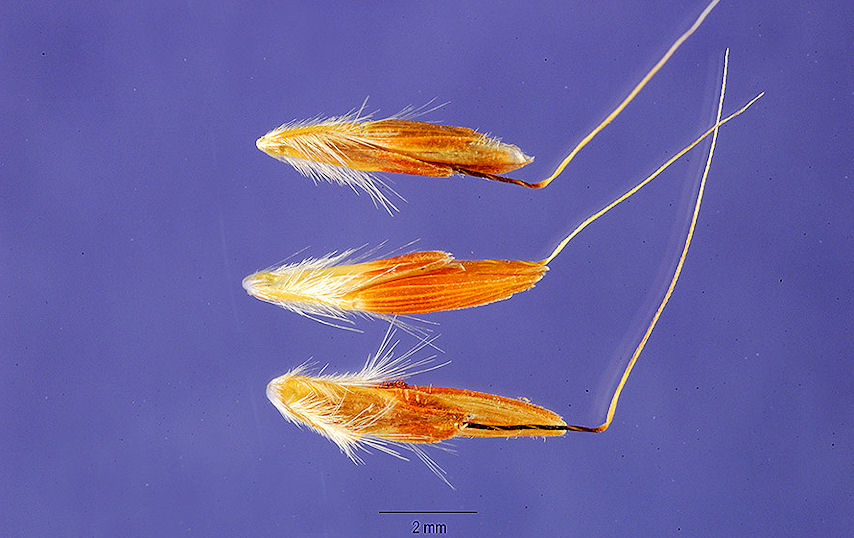
Abb.: Cymbopogon citratus (DC. ex Nees) Stapf 1906 - Westindisches
Zitronengras - West Indian Lemon Grass
[Bildquelle: Courtesy Jose Hernandez / USDA]
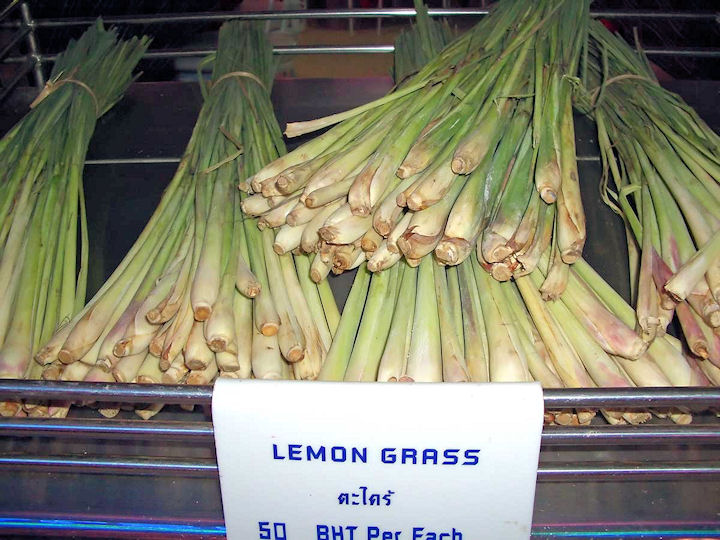
Abb.: Cymbopogon citratus (DC. ex Nees) Stapf 1906 - Westindisches
Zitronengras - West Indian Lemon Grass, Thailand
[Bildquelle: Clay Irving. --
http://www.flickr.com/photos/clayirving/2187150125/. -- Zugriff am
2010-10-24. --
Creative Commons Lizenz (Namensnennung, keine Bearbeitung)]
Cymbopogon schoenanthus (L.) Spreng. subsp. schoenanthus
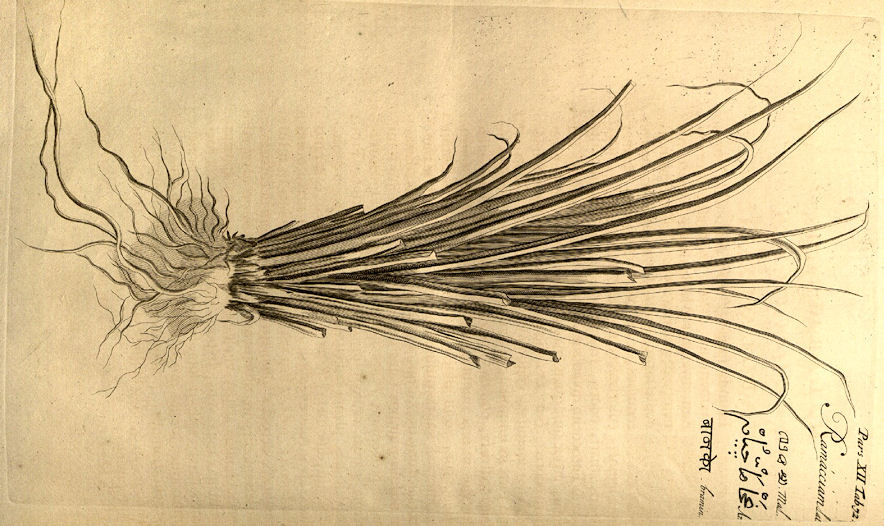
Abb.: Cymbopogon schoenanthus (L.) Spreng. subsp. schoenanthus
[Bildquelle: Hortus malabaricus XII. Fig. 72, 1703]
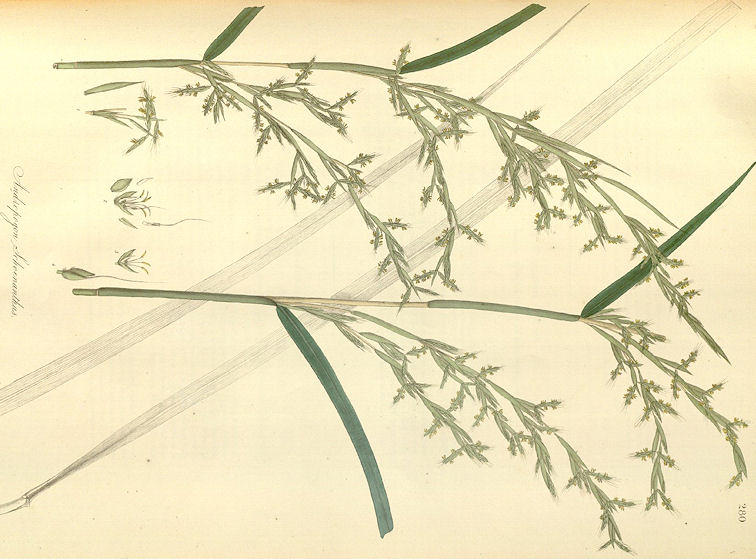
Abb.: Cymbopogon schoenanthus (L.) Spreng. subsp. schoenanthus
[Bildquelle: Plantae Asiaticae rariores, or, Descriptions and
figures of a select number of unpublished East Indian plants / by N. Wallich. --
London, 1830-32. -- Vol. 3, Pl. 280.]
"Andropogon Schoenanthus. Linn. sp. pl. ed. Willd. iv. 915.
Perennial, erect. [...]
Sans. Malatrinukung, Bhoostrinunug.
Ramacciam. Rheed. Hort. Mal. 12. p. 137. t. 72.
Schoenanthum amboinicum. Rumph. Amb 5. p. 181. t. 72. f. 2.
Schoenanthus, or Juncus odoratus of the Materia Medica.
On the coast I have only found this elegant valuable species in a state of cultivation, few gardens being without it ; I have but twice found it in flower and both times during the rainy season.
[...]
Obs. The fresh leaves are much used as a substitute for tea. The white succulent centre of the leaf-bearing culms is often put into curries, to give them an agreeable flavour."
[Quelle: Roxburgh, William <1751-1815>: Flora indica, or, Descriptions of Indian plants / by the late William Roxburgh. -- Serampore : Printed for W. Thacker, 1832. -- Vol. 1, S. 274f.]
"Andropogon citratum (Dec.) N. O. Graminaceae. Lemon-grass [...]
Description.—Root perennial; [...]
Rheede, xii t. 72
A. schoenanthus, Linn.—Roxb. Fl. Ind. i. 274.
Cymbopogon schoenanthus, Spreng.
Travancore. Bengal. Cultivated in Coromandel.
Medical Uses.—An infusion of the fragrant leaves, which are bitter and aromatic, is given to children as an excellent stomachic. It is also diaphoretic. An essential oil is prepared from them, which is a most valuable remedy in rheumatism, applied externally. Mixed with butter-milk, the leaves are used in cases of ringworm. It is a remedy of considerable value in affections of the bowels. It allays and arrests vomiting in cholera, and aids the process of reaction. Externally applied, it forms a useful embrocation in chronic rheumatism, neuralgia, sprains, and similar painful affections.— (Pharm. of India.) The rhizomes and flowers have similar qualities.— (Lindley.) The essential oil, when first distilled, is of a high colour, owing to the quantity of resin in it. To remove this, as also to have the oil clear, it is saturated in charcoal grits that have been previously well washed and thoroughly dried. The grits saturated with the oil are thrown into the still with the required quantity of water, made slightly sharp to the taste and distilled. The oil thus obtained is not only clear, but in a great measure free from resin, and this passes in England as essence of Verbena or Citronelle. The oil of the first distilling, which is of a high colour, is known as the Lemon-grass oil. Mr C. Kohlhoff, for some time Conservator of Forests in Travancore, has used the double-distilled oil as an embrocation in cases of rheumatism, and found it a most efficacious remedy, and has also administered it in cases of cholera with great advantage. The dose is from 12 to 20 drops on a lump of sugar, repeated till the symptoms abate, at the same time applying it externally to the lips, back, and stomach, to prevent the cold and cramp so invariably accompanying that disorder. A decoction made from the fresh leaves is used by the natives to allay thirst in various disorders.— Pers. Obs.
Economic Uses.—When fresh and young, the leaves are used in many parts of the country as a substitute for tea, and the white centre of the succulent leaf-culms is used to impart a flavour to curries. In Bengal, large tracts of waste land are covered with this grass. The export of Lemon-grass oil from Ceylon amounts in value to nearly £7000 annually.—Roxb. Simmonds."
[Quelle: Drury, Heber <1819 - 1872>: The useful plants of India : with notices of their chief value in commerce, medicine, and the arts. -- 2d ed. with additions and corrections. London : Allen, 1873. -- xvi, 512 p. ; 22 cm. -- s.v.]
"ANDROPOGON SCHOENANTHUS, Linn.
'Fig.—Royle, Ill., t. 97; Trin. Sp. Gr. iii., t. 327.
Rusa grass, Ginger grass
Hab.—Indian Peninsula, Western Ghauts, extending spargingly to the coast.
[...]
History, Uses, &c.—This grass is the Bhustrina or Bhutrina "earth grass" of the Raja Nirghanta, and is also known as Rohisha in Sanskrit. Among the synonyms which it bears, we may mention Gandha-kheda and Gandha-trina "odorous grass," Su-rasa "well flavoured," and Su-gandha "having an agreeable odour." It is described as aromatic and stimulant and useful in bilious and phlegmatic affections.
Mahometan writers upon Indian Materia Medica confound A. Schoenanthus with Izkhir (A. laniger), and Mir Muhammad Husain gives Rūs as an Indian name for Izkhir; he also mentions several other Indian names, such as Gandhis, Gandhbel, &c, showing that he was well acquainted with Rūsa grass. The author of the Tuhfat-el-muminin mentions a distilled water prepared from Izkhir, and also an oil made by macerating the grass in sweet oil exposed to the sun ; it is therefore probable that in his time (1669) the essential oil was not made from A. Schoenanthus. The industry probably commenced in the 18th century whilst Khandesh was in a nourishing condition under its Mahometan rulers.
A. Schoenanthus was first brought to the notice of Europeans by General Martin, who collected the seeds in the Balaghat, during the war with Tippu Sultan, and cultivated the plant at Lucknow, whence he sent seeds to Roxburgh, in Calcutta. The first mention of the oil is by Maxwell in 1825 (Calcutta Med. Phys. Trans., i., p. 367); it was afterwards described by Forsyth, 1827 (Ibid., iii., p. 213). The A. Nardus of Ainslie, which he calls ginger or spice grass, is doubtless the same plant; he notices its use in infusion as a stomachic, and states that an essential oil is prepared from it which is useful in rheumatism.
Preparation of the oil.—The oil distillers in Khandesh call the grass Motiya, when the inflorescence is young and of a bluish-white colour; after it has ripened and become red, it is called Sonfiya. The oil obtained from it in the first condition has a more delicate odour than that obtained from the ripened grass. The Motiya oil is usually mixed with the second kind, which by itself would not fetch a good price in the European market. The grass grows freely, though not very widely, on open hillsides in West Khandesh, especially in Akrāni. The original seat of the manufacture was Pimpalner, but as the oil is in great demand, the manufacture has of late spread to Nandurbār, Shāhāda, and Taloda. The makers are Musalmans, who, at the close of the rains, about September, when the grass is ripening, buy it from the Bhils, stack it, and set furnaces at the sides of brooks where wood and water are plentiful. A large pit, four feet long by two wide and two and a half deep, is dug, and a furnace (chula) prepared. On this furnace is placed a copper or iron caldron, large enough to hold from 30 to 50 pots of water. After pouring in some water, the caldron is filled to the brim with chopped grass, and a little more water is added. The mouth of the caldron is carefully closed with an iron or copper plate, made fast with wheat dough. From a hole in this lid, a bamboo tube, wrapped in a piece of cloth, plastered with the flour of Udid (Phaseolus Mungo, Linn., black var.), and bound with ropes, passes into a second closed caldron, sunk to the neck in running water. The steam from the grass is condensed in the second caldron, which, when full, begins to shake. The tube is then skilfully removed, and the contents of the caldron poured into a third similar vessel and stirred. Then the oil begins to appear on the surface, and is slowly skimmed off. The distillate is returned with fresh grass to the still. In 1879-80 the number of stills was 197, producing about 71 cwts. of oil. More than 100 stills are worked in Nandurbār alone, and the increase of the manufacture is prevented only by the scarcity of the grass. The oil is packed in skins, and sent on bullock back over the Kundaibāri Pass to Surat, and by Dhulia and Manmad to Bombay.
We are assured by the Bombay dealers that all the oil of commerce is more or less adulterated ; and a comparison of the commercial article with some oil distilled by one of us supports this statement; the adulteration is said to be practised by the distillers, who, we are informed, are regularly supplied with oil of turpentine from Bombay. 373 lbs. of grass received from Khandesh and submitted to distillation under our own superintendence in Bombay yielded 1 lb. 5 1/2 ozs. of oil. Portions of this oil were mixed with oils of turpentine, groundnut, rape, and linseed ; with all three it formed a milky or turbid mixture, ut tfle two first, after standing for some days, became perfectly bright. We are informed that formerly it was the custom to adulterate with groundnut oil, but that turpentine is now used, as it cannot be detected by the evaporation test.
The use to which Rūsa oil is put in Turkey, to which country it is principally exported, via Egypt and the Red Sea ports, from Bombay, was first explained by Hanbury (N. Repert .f. Pharm.,viii., 365), and in Pharmacographia we find the following interesting statement:—"No drug is more subject than attar of rose to adulteration, which is principally effected by the addition of the volatile oil of an Indian grass, Andropogon Schoenanthus, L. This oil, which is called in Turkish Idris yaghi, and also Entershah, and is more or less known to Europeans as Geranium oil, is imported into Turkey for this express purpose, and even submitted to a sort of purification before being used. It was formerly added to the attar only in Constantinople, but now the mixing takes place at the seat of the manufacture. It is said that in many places the roses are absolutely sprinkled with it before being placed in the still."
[Quelle: Pharmacographia indica : a history of the principal drugs of vegetable origin met with in British India / by William Dymock [1834-1892], C. J. H. Warden and David Hooper [1858-1947]. -- Bd. 3. -- London, 1893. -- S. 557ff.]
|
33. śaṣpaṃ bālatṛṇaṃ ghāso yavasaṃ tṛṇam arjunam tṛṇānāṃ saṃhatis tṛṇyā naḍyā tu naḍasaṃhatiḥ शष्पं
बालतृणं घासो यवसं तृणम् अर्जुनम् । [Bezeichnungen für junges Gras:]
[Bezeichnungen für Futtergras:]
[Bezeichnungen für Gras:]
Eine Fülle von Gras heißt तृ्ण्या - tṛṇyā f.: Fülle von Gras |
Colebrooke (1807):
[33.a:] "Young grass."
[33.a/b:] "Meadow grass. Such as cattle feed on."
[33.b:] "Grass in general."
[33.c:] "Abundance of grass."
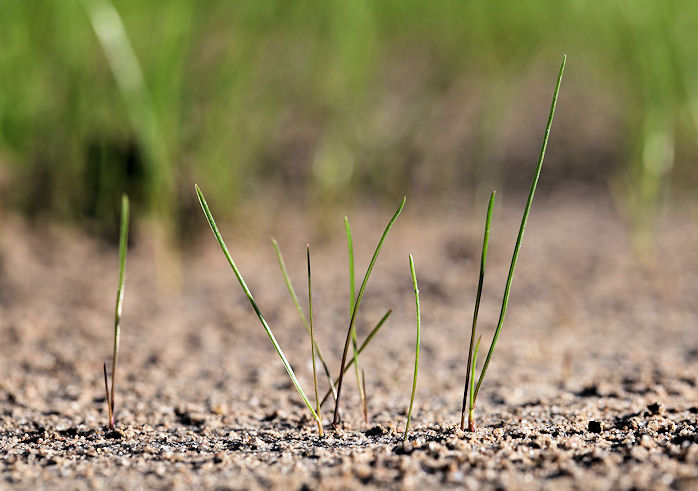
शष्पाणि ।
[Bildquelle: Thomas Wolf / Wikipedia. --
Creative
Commons Lizenz (Namensnennung, share alike)]
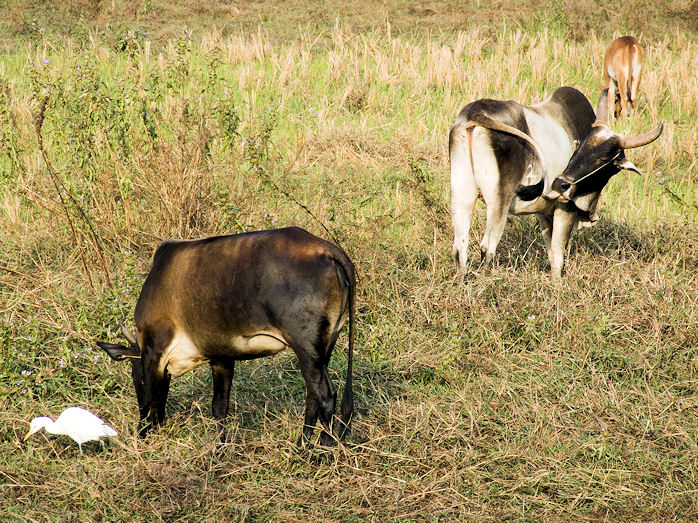
Abb.: यवसम् । Goa
[Bildquelle:
Victoria Bensley.
--
http://www.flickr.com/photos/veebl/2321394189/. -- Zugriff am
2011-01-15. --
Creative
Commons Lizenz (Namensnennung, keine kommerzielle Nutzung, keine
Bearbeitung)]
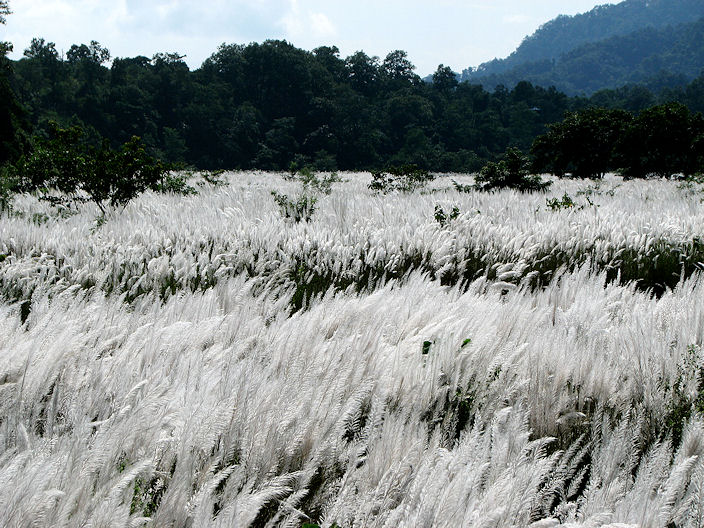
Abb.: अर्जुनम् । bei Sevoke, Sikkim
[Bildquelle:
Amol Hatwar. --
http://www.flickr.com/photos/hatwar/2976623415/. -- Zugriff am
2011-01-15. --
Creative
Commons Lizenz (Namensnennung, share alike)]
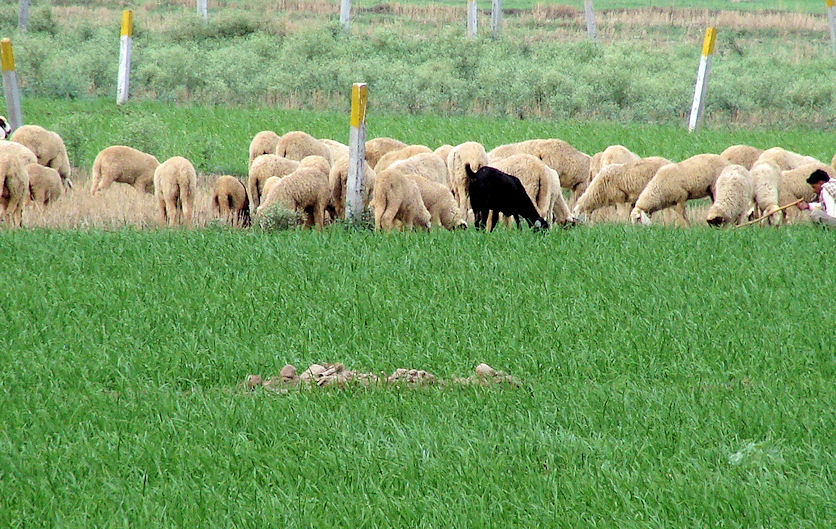
Abb.: तृण्या । Indien
[Bildquelle:
vaibhav ahuja. --
http://www.flickr.com/photos/8085704@N05/3864288743/. -- Zugriff am
2011-01-15. --
Creative Commons Lizenz (Namensnennung, share alike)]
|
33. c./d.
tṛṇānāṃ saṃhatis tṛṇyā
naḍyā tu naḍasaṃhatiḥ तृणानां संहतिस् तृण्या नड्या तु नडसंहतिः ॥३३॥ Eine Fülle von नड - naḍa (Schilf, besonders Phragmites karka (Retz.) Trin. ex Steud. 1841 oder Lobelia nicotinianifolia (nicotininaefolia, necolinianifola ?) Heyne; Vers 28.a/b) heißt नड्या - naḍyā f.: Röhricht |
Colebrooke (1807): "Abundance of reeds."
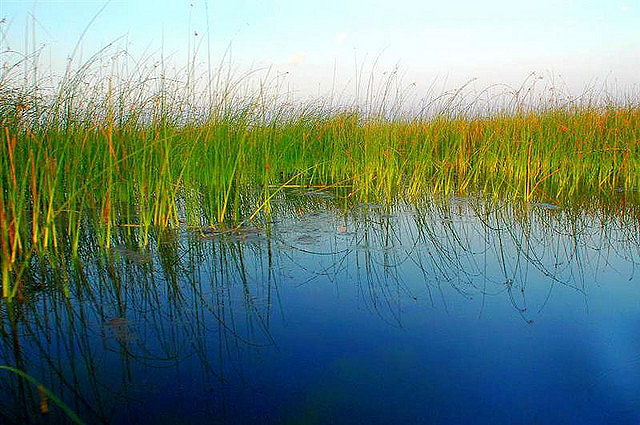
Abb.: नड्या । Nal Sarovar Lake - નળ સરોવર, Gujarat
[Bildquelle: jkairvar. --
http://www.flickr.com/photos/jayzies/2097338921/. -- Zugriff am
2011-01-15. --
Creative
Commons Lizenz (Namensnennung, keine kommerzielel Nutzung, keine
Bearbeitung)]
Arecaceae (Palmengewächse)
|
34. a./b. tṛṇarājāhvayas tālo
nālikeras tu lāṅgalī तृणराजाह्वयस् तालो नालिकेरस् तु लाङ्गली ।३४ क। [Bezeichnungen für Borassus flabellifer L. 1753 - Palmyrapalme - Toddy Palm:]
|
Colebrooke (1807): "Palmyra. Borassus flabelliformis [= Borassus flabellifer L. 1753]."
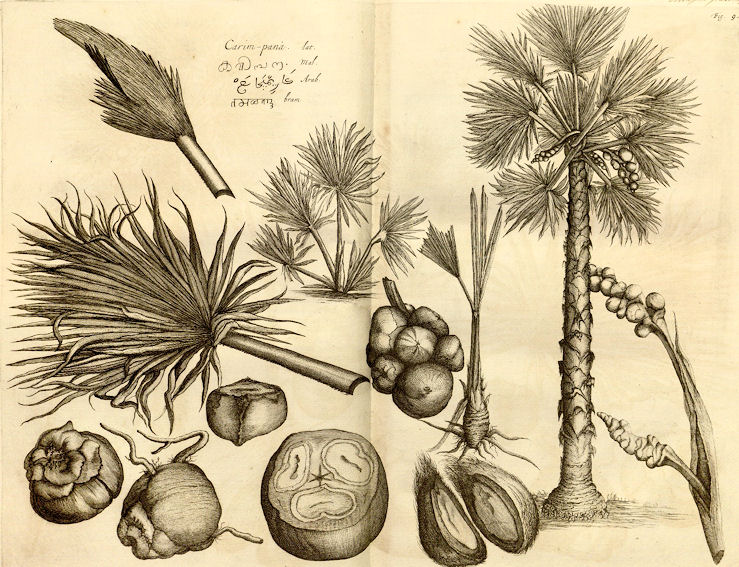
Abb.: तृणराजः । Borassus flabellifer L. 1753 - Palmyrapalme - Toddy Palm
[Bildquelle: Hortus malabaricus I. Fig. 9, 1678]
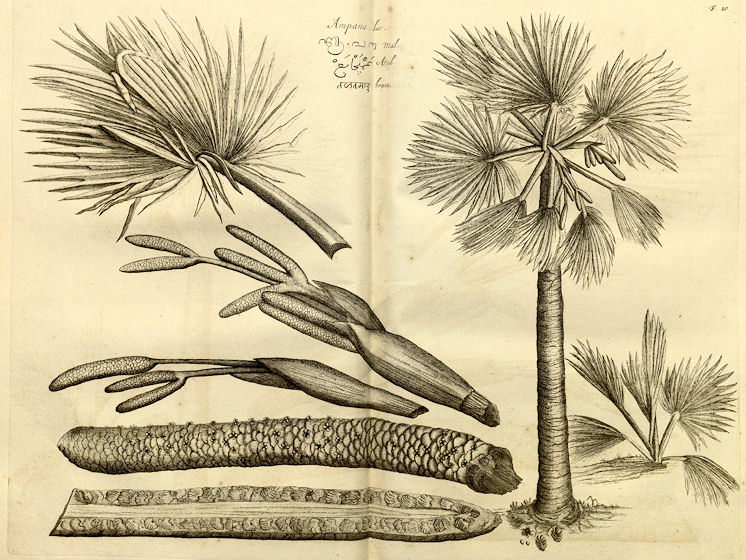
Abb.: तालः । Borassus flabellifer L. 1753 - Palmyrapalme - Toddy Palm
[Bildquelle: Hortus malabaricus I. Fig. 10, 1678]
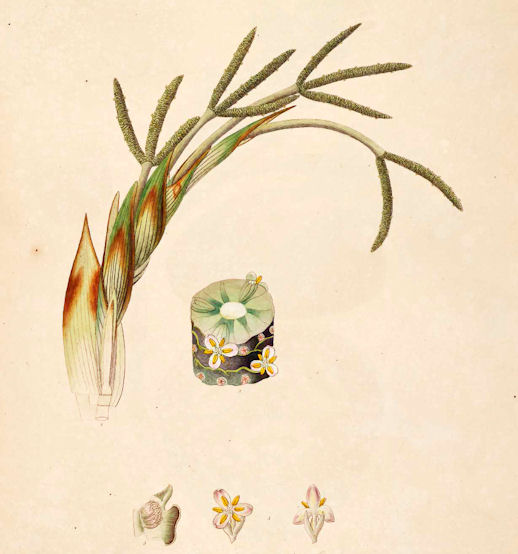
Abb.: Borassus flabellifer L. 1753 - Palmyrapalme - Toddy Palm (Roxb.:
Borassus flabelliformis)
[Bildquelle: Roxburgh. -- Vol I. -- 1795. -- Image courtesy Missouri Botanical
Garden. http://www.botanicus.org. --
Creative Commons Lizenz
(Namensnennung, keine kommerzielle Nutzung)]
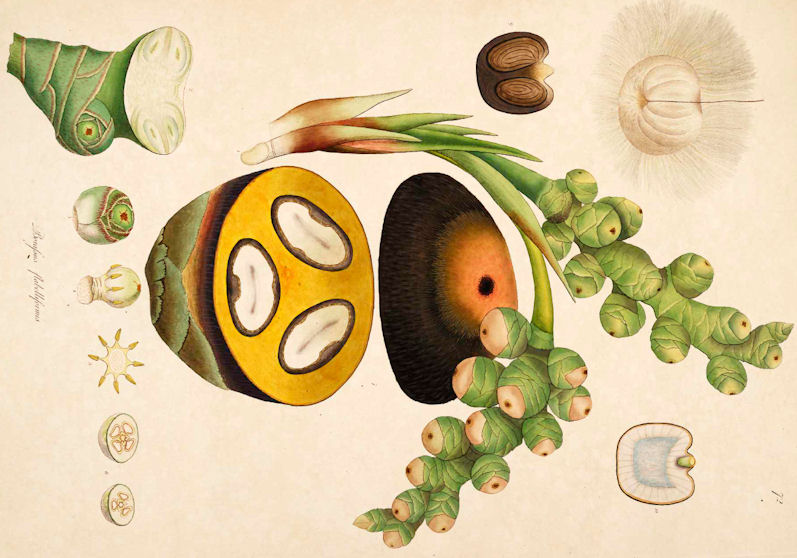
Abb.: Borassus flabellifer L. 1753 - Palmyrapalme - Toddy Palm (Roxb.:
Borassus flabelliformis)
[Bildquelle: Roxburgh. -- Vol I. -- 1795. -- Image courtesy Missouri Botanical
Garden. http://www.botanicus.org. --
Creative Commons Lizenz
(Namensnennung, keine kommerzielle Nutzung)]
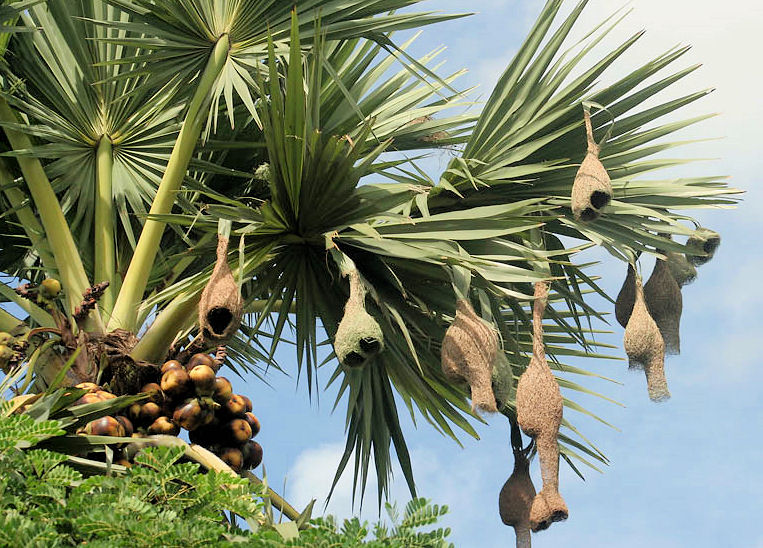
Abb.: Nester von Webervögeln und Früchte auf Borassus flabellifer L. 1753
- Palmyrapalme - Toddy Palm, Kolkata -
কলকাতা, West Bengal
[Bildquelle: J. M. Garg / Wikimedia. -- GNU FDLicense]

Abb.: Borassus flabellifer L. 1753 - Palmyrapalme - Toddy Palm, Kolkata -
কলকাতা, West Bengal
[Bildquelle: J. M. Garg / Wikimedia. -- GNU FDLicense]
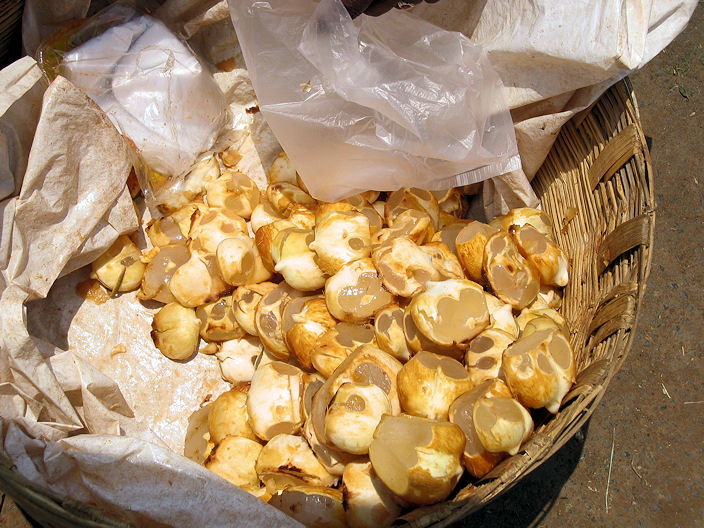
Abb.: Samen von Borassus flabellifer L. 1753 - Palmyrapalme - Toddy Palm,
Guntur - గుంటూరు,
Andhra Pradesh
[Bildquelle: Gpics / Wikimedia. -- GNU FDLicense]
"Borassus flabelliformis. Willd. iv. 800. Corom, pl. i. N. 71 and 72.
Lontarus domestica. Rumph. Amb. i. t. 10. Gaert. Fruct. 21. t. 3.
Carimpana, Rheed, Mal. i. t. 9. the female tree; and Ampara, t. 10. the male.
Sans. Tala. See Asiat. Res. iv. p. 311.
[...]
Common all over India. It flowers in the hot season in Bengal, and the seeds ripen in August."
[Quelle: Roxburgh, William <1751-1815>: Flora indica, or, Descriptions of Indian plants / by the late William Roxburgh. -- Serampore : Printed for W. Thacker, 1832. -- Vol. 3, S. 790.]
"Borassus flabelliformis (Linn.) N. O. Palmaceae. Palmyra Palm [...]
Description.—Trunk, 30-40 feet [...]
Lontarus domestica, Rumph.—Roxb. Cor. i. t. 71.—Fl. Ind. iii. 790.—Rheede, i. t. 9,10.
Common in the Peninsula.
Medical Uses.—The saccharine juice obtained by excision from the spadix or young flowering-branch is, when freshly drawn before sunrise, of a pleasant sweet taste, and if taken in doses of a tumblerful every morning acts as a laxative. After fermentation has commenced, it becomes converted into arrack, one of the intoxicating drinks of the country. A useful stimulant application, called Toddy Poultice, is prepared by adding fresh drawn toddy to rice-flour till it has the consistence of a soft poultice; and this being subjected to a gentle fire, fermentation takes place. This, spread on a doth and applied to the parts, acts as a valuable stimulant application to gangrenous ulcerations, carbuncles, and indolent ulcers. The light- brown cotton-like substance from the outside of the base of the fronds is employed as a styptic for arresting haemorrhage from superficial wounds.—Pharm. of India.
Economic Uses.—This palm is most extensively distributed over the continent of India, especially near the sea-coast. Sir W. Jones said that it was justly styled the king of its order among those which the Hindoos call grass-trees. Its uses are manifold, the best known among which is the fermented liquor called toddy, and this constitutes its chief value to the native inhabitants. The mode of procuring the vinous sap is as follows: The spadix or young flowering-branch is cut off near the top, and an earthen chatty or pitcher then tied on to the stump; into this the juice runs. Every morning it is emptied and replaced, the stump being again cut, the vessel placed as before, and so on, until the whole has been gradually exhausted and cut away. It is known in Tamil as the Pannung-khulloo. It is from this liquor that sugar is extracted, and by the same process as that described for procuring the toddy, except that the inside of the earthen vessel or receiver is powdered with chunam, which prevents any fermentation; the juice is then boiled down, and dried by exposure. Some few trees that from unknown causes do not flower in spring, put out their flowers in the cold season, and give a scanty supply; but in spring many are rendered artificially barren by breaking off the flowering-bud as it begins to form. These also flower in the winter season, and are called Basanti They do not give above 2 1/2 maunds of juice, but this is of as much value as the 6 maunds which a tree gives in spring. Either the male or female will answer for the spring or winter crop, but the female alone will yield juice in the rainy season. When this is wanted, the fruit is allowed to form, and afterwards the point of the spadix or stem which supports the clusters is cut and allowed to bleed. This does not prevent a great many fruit on each cluster from coming to maturity. Palms managed thus are called Ghour. The fruit ripens in August, but many of the stems continue to bleed until October. A coleopterous insect often attacks the heart of this tree, and occasions it to languish. The remedy is to cut a hole about six inches long and two wide entirely through the middle of the stem, and four or five feet from the ground. The stem is found hollow, and a great deal of rubbish like sawdust falls out, but the palm soon recovers. The insect probably undergoes a change, and comes out by the hole. The coarse sugar is called Jaggery; and in Tamil, Karepootee. It is used for medicinal purposes, as well as for sweetening drinks. The pulpy matter surrounding the fresh seeds is cooling and pleasant to the taste, but after they ripen it becomes insipid. The stems when old become very hard, and are capable of taking a fine polish, being used for bows, &c. For house-building and various domestic purposes, the timber is the most generally used of the palm tribe. It is used chiefly for rafters, joists, and reapers, protected from moisture, and esteemed especially when of good age. For this purpose the trunk is split into 4 for rafters, into 8 for reapers, and these are dressed with an adze. From the structure of the fibres, it splits easily in the direction of its length, but supports a greater cross-strain than any other wood ; iron nails, however, will rust rapidly in it. The fruits and fusiform roots are used as food by the poorer classes in the N. Circars ; the leaves are used for writing on. They are also employed for thatching houses and making baskets, mats, umbrellas, and fans. Strong and durable fibres are produced from the petioles of the fronds.—Roxb. Lind, Ainsl. Jury Rep. Mad. Exhib."
[Quelle: Drury, Heber <1819 - 1872>: The useful plants of India : with notices of their chief value in commerce, medicine, and the arts. -- 2d ed. with additions and corrections. London : Allen, 1873. -- xvi, 512 p. ; 22 cm. -- s.v.]
"Borassus flabelliformis, Linn.
Rheede, Hort. Mal., i., tt. 9, 10, is the Palmyra palm of the English, and the Roudier a éventails of the French. In Sanskrit it is called Tala, and in the vernaculars Tāl, Tād, Tār, and Panai-maram. The properties of the various parts of this noble palm are described in detail in Sanskrit medical works. The root is considered to be cooling and restorative ; the saccharine juice obtained from the spathe cooling and diuretic when fresh, but intoxicating when fermented; the pulp of the ripe fruit heavy and indigestible ; the gelatinous contents of the unripe seeds refreshing and cooling; the embryo of the germinating seed, and the terminal bud of the tree, are used as vegetables, and are considered to be cooling, nutritive, and diuretic; the ash of the spathe is given as a remedy for enlarged spleen. The spirit distilled from the juice of this palm is similar to that obtained from the cocoa palm.
The fine, brown, silky substance on the young petioles of the leaves of this and other palms is used as a styptic.
B. flabelliformis yields an insoluble gum, like tragacanth, but of a darker colour.
For an account of the economic uses of this palm, the reader is referred to the Dict. Econ. Prod. India, i., p. 495."
[Quelle: Pharmacographia indica : a history of the principal drugs of vegetable origin met with in British India / by William Dymock [1834-1892], C. J. H. Warden and David Hooper [1858-1947]. -- Bd. 3. -- London, 1893. -- S. 519f.]
|
34. a./b.
tṛṇarājāhvayas tālo
nālikeras tu lāṅgalī तृणराजाह्वयस् तालो नालिकेरस् तु लाङ्गली ।३४ क। [Bezeichnungen für Cocos nucifera L. 1753 - Kokospalme - Coconut:]
|
Colebrooke (1807): "Coconut. Cocos nucifera."
Siehe 2.V.8!
Arecaceae (Palmengewächse)
|
34. c./d. ghoṇṭā tu pūgaḥ kramuko guvākaḥ khapuro 'sya tu 35. a./b. phalam udvegam ete ca hintālasahitās trayaḥ घोण्टा तु
पूगः क्रमुको गुवाकः खपुरो
ऽस्य तु ॥३४ ख॥ [Bezeichnungen für Areca catechu L. 1753 - Betelpalme - Betel Nut:]
Seine Frucht heißt उद्वेग - udvega n.: Aufregendes, Anregendes |
Colebrooke (1807): "Faufel. Areca Faufel (or Catechu)." [35.a:] "Its nut, called Betel-nut."
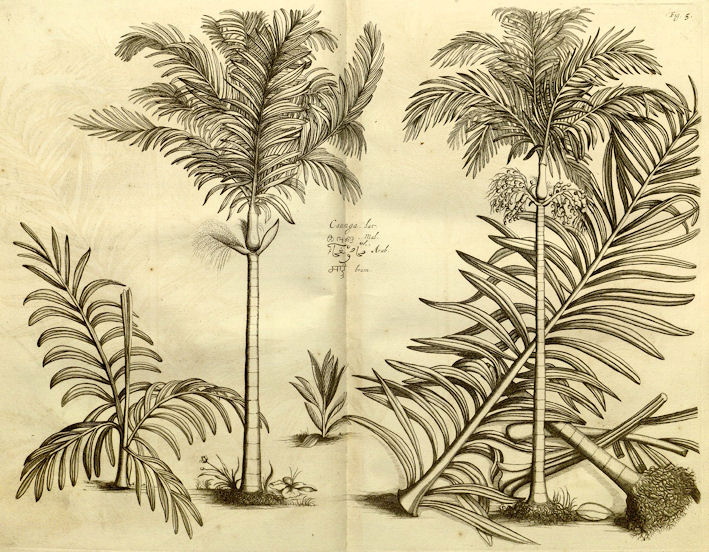
Abb.: घोण्टा । Areca catechu L. 1753 - Betelpalme - Betel Nut
[Bildquelle: Hortus malabaricus I. Fig. 5, 1678]
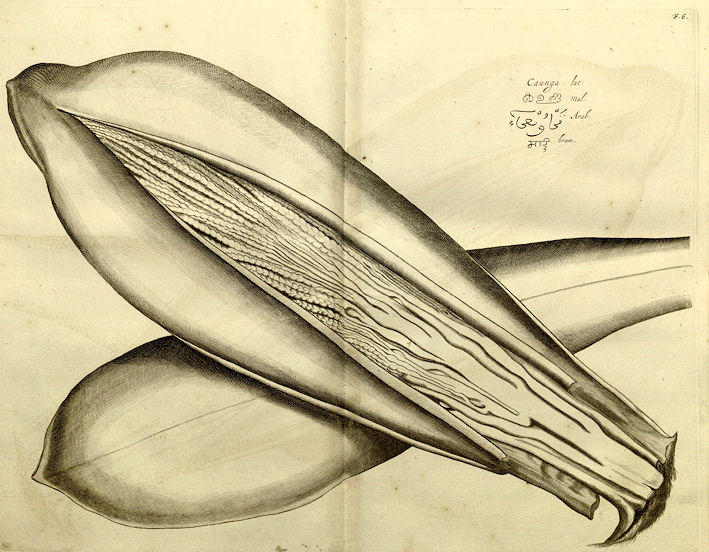
Abb.: Areca catechu L. 1753 - Betelpalme - Betel Nut
[Bildquelle: Hortus malabaricus I. Fig. 6, 1678]
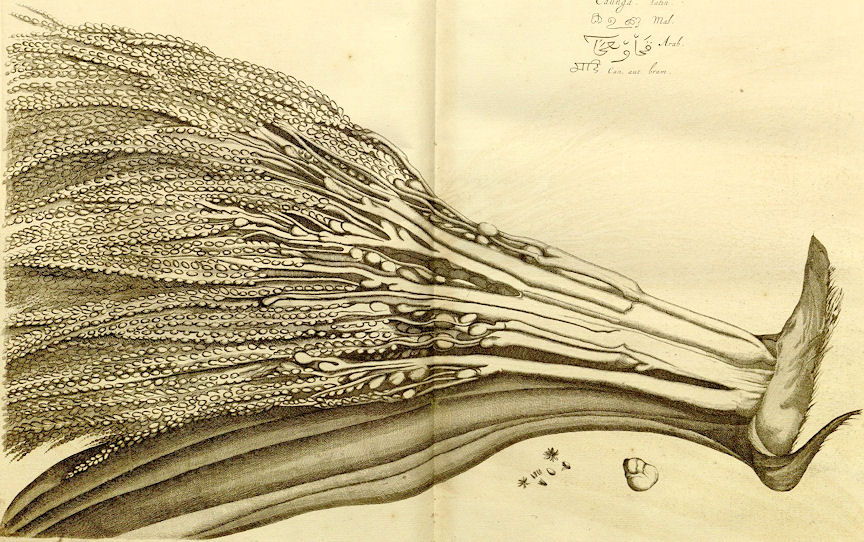
Abb.: Areca catechu L. 1753 - Betelpalme - Betel Nut
[Bildquelle: Hortus malabaricus I. Fig. 7, 1678]
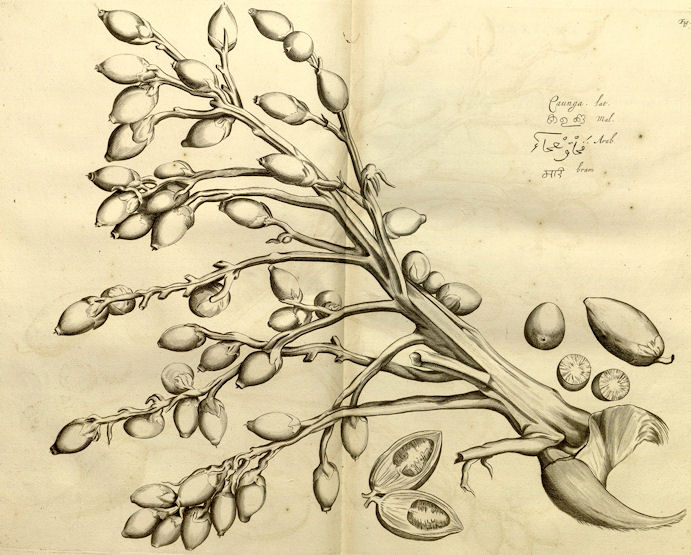
Abb.: पूगः । Areca catechu L. 1753 - Betelpalme - Betel Nut
[Bildquelle: Hortus malabaricus I. Fig. 8, 1678]
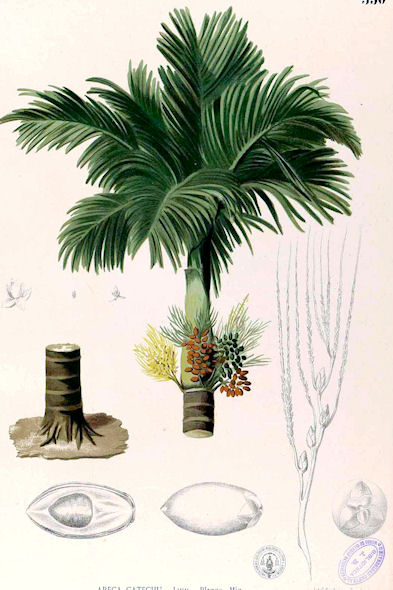
Abb.: क्रमुकः । Areca catechu L. 1753 - Betelpalme - Betel Nut
[Bildquelle: Flora de Filipinas, 1880 / Wikipedia. -- Public domain]
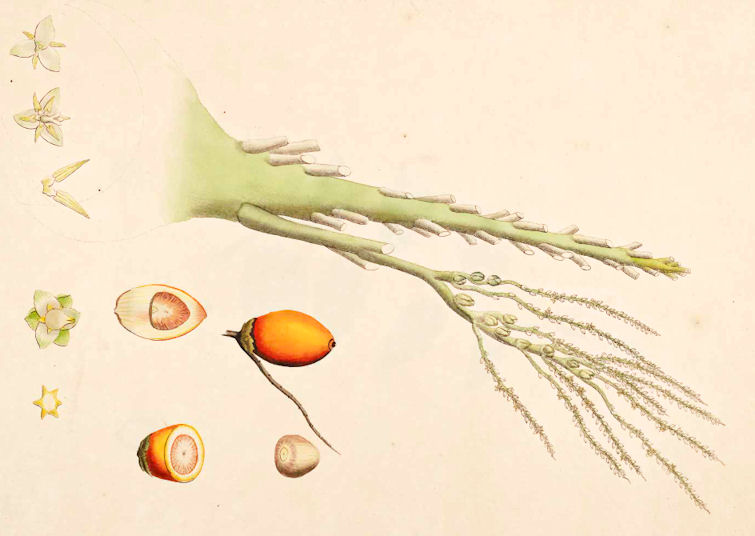
Abb.: Areca catechu L. 1753 - Betelpalme - Betel Nut
[Bildquelle: Roxburgh. -- Vol I. -- 1795. -- Image courtesy Missouri Botanical
Garden. http://www.botanicus.org. --
Creative Commons Lizenz
(Namensnennung, keine kommerzielle Nutzung)]
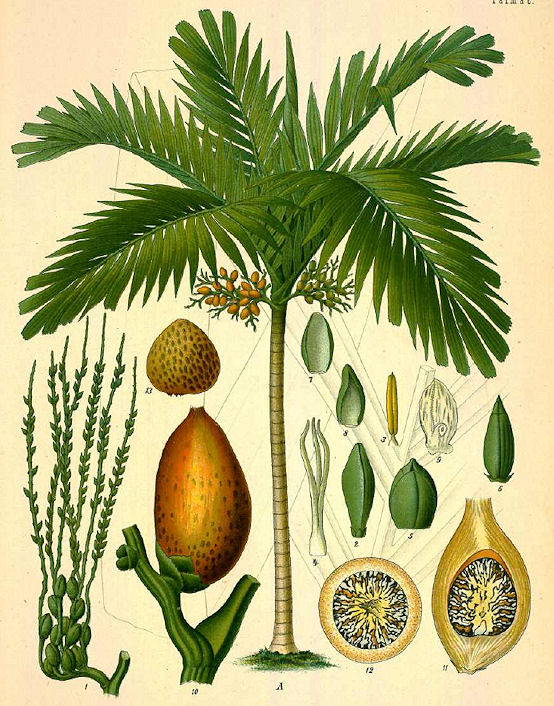
Abb.: Areca catechu L. 1753 - Betelpalme - Betel Nut
[Bildquelle: Köhler, 1883-1914]
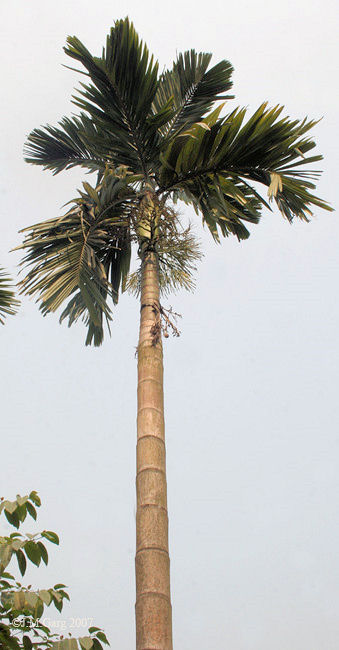
Abb.: Areca catechu L. 1753 - Betelpalme - Betel Nut, Kolkata -
কলকাতা, West Bengal
[Bildquelle: J. M. Garg / Wikimedia. -- GNU FDLicense]
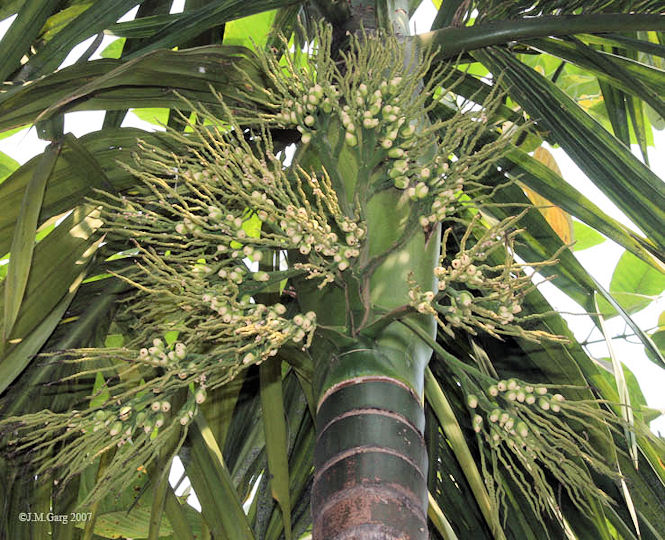
Abb.: पूगः । Areca catechu L. 1753 - Betelpalme - Betel Nut, Kolkata -
কলকাতা, West Bengal
[Bildquelle: J. M. Garg / Wikimedia. -- GNU FDLicense]
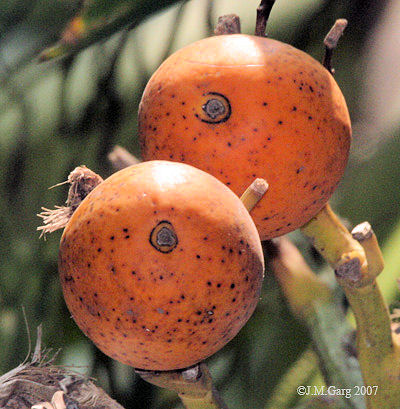
Abb.: Areca catechu L. 1753 - Betelpalme - Betel Nut, Kolkata -
কলকাতা, West Bengal
[Bildquelle: J. M. Garg / Wikimedia. -- GNU FDLicense]
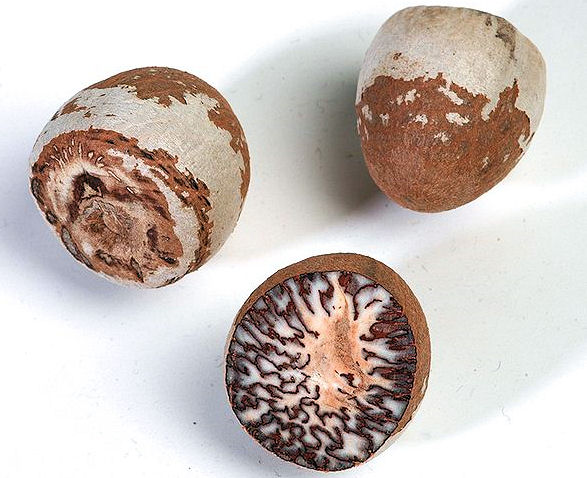
Abb.: उद्वेगानि । Areca catechu L. 1753 - Betelpalme - Betel Nut
[Bildquelle: Henryk Kotowski / Wikimedia. -- GNU FDLicense]
"Areca catechu. Willd. iv. 524. Corom, pl. i. N. 74.
Trunk straight, and slender, from forty to fifty feet high. [...]
Areca faufel. Gaert. Fruct. i. 19. t. 7. f. 2.
Pinanga. Rumph. Amb. i. 1. 4.
Caunga. Rheed. Mal, i. 5. 8.
Sans. Goovaka.
[...]
Where this tree grows wild I cannot say from my own observation, but it is cultivated in all the warmer parts of Asia, and is in flower most part of the year. It is the most beautiful palm we have in India. The trunk grows remarkably straight, often from forty to fifty feet high, and in general about twenty inches in circumference, equally thick in every part, and smooth, but the tree is so well known, and fully described, that I should not have thought of mentioning it, had I not found that its family character was imperfectly known.
[...]
On the Malabar coast the common black pepper vine is usually trained up to this tree, which renders it more useful in those parts, than any other."
[Quelle: Roxburgh, William <1751-1815>: Flora indica, or, Descriptions of Indian plants / by the late William Roxburgh. -- Serampore : Printed for W. Thacker, 1832. -- Vol. 3, S. 615f.]
"Areca catechu (Linn.) N. O. Palmaceae. Areca or Betel-nut Palm [...]
Description.—Palm; [...] flowers small, white, fragrant.
Fl. April—May.
Roxb. Fl. Ind. iii. 615.—Cor. i. t. 76.—Rheede, i. t. 5, 6, 7, 8.
Cultivated.
Medical uses.—The nut is used as a masticatory in conjunction with the leaf of Piper Betel and Chunam. It is considered to strengthen the gums, sweeten the breath, and improve the tone of the digestive organs. The seed, reduced to charcoal and powdered, forms an excellent dentifrice. Dr Shortt states that the powdered nut, in doses of ten or fifteen grains every three or four hours, is useful in checking diarrhoea arising from debility. The dry expanded petioles serve as excellent ready-made splints for fractures. —Pharm. of India.
Economic uses.—In appearance the Areca Palm is perhaps the most graceful and elegant of Indian Palms. Its native place is unknown, but it is extensively distributed in India. It yields the betel-nut of commerce. A tree will produce annually, on an average, three hundred nuts. The catechu which they yield is of a very inferior quality. There are two preparations of it, which are respectively called by the Tamools, Cuttacamboo and Cashcuttie; in Teeloogoo, Kansee; and in Dukhanie, Bharab-cutta and Acha-cutta. The first (Cuttacamboo) is chewed with the betel-leaf. Like most of the Palm tribe, the trunk is much used for ordinary building purposes; and in Travancore is especially used for spear-handles, &c. The spathe which stretches over the blossoms, which is called Paak-muttay, is a fibrous substance, with which the Hindoos make vessels for holding arrack, water, &c.; also caps, dishes, and small umbrellas. It is so fine that it can be written on with ink. The Areca Palm is found chiefly in Malabar, Canara, North Bengal, the lower slopes of the mountains of Nepaul, and the south-west coast of Ceylon. It will produce fruit at five years, and continue to bear for twenty-five years. Unlike the Cocoa Palm, it will thrive at high regions, and at a distance from the sea. In the Eastern Islands the produce of the tree varies from two hundred to one thousand nuts annually. They form a considerable article of commerce with the Eastern Islands and China, and are also one of the staple products of Travancore, The nuts are gathered in July and August, though not folly ripe till October. In the latter country the nuts are variously prepared for use. "Those that are used by families of rank are collected while the fruit is tender; the husks or the outer pod is removed; the kernel, a round fleshy mass, is boiled in water: in the first boiling of the nut, when properly done, the water becomes red, thick, and starch-like, and this is afterwards evaporated into a substance like catechu. The boiled nuts being now removed, sliced, and dried, the catechu-like substance is rubbed to the same and dried again in the sun, when they become of a shining black, ready for use. Whole nuts, without being sliced, are also prepared in the same form for use amongst the higher classes; while ripe nuts, as well as young nuts in a raw state, are used by all classes of people generally; and ripe nuts preserved in water with the pod are also used." When exported to other districts, the nuts are sliced and coloured with red catechu, as also the nut while in the pod. The average amount of exports of the prepared nuts from Travancore is from 2000 to 3000 candies annually, exclusive of the nuts in their ordinary state, great quantities of which are shipped to Bombay and other ports. According to the last survey there were upwards of a million trees in Travancore. The following mode of extracting the catechu from the nuts in Mysore is taken from Heyne's 'Tracts on India:' "The nuts are taken as they come from the tree, and boiled for some hours in an iron vessel. They are then taken out, and the remaining water is inspissated by continual boiling. This process furnishes Kossa, or most astringent terra japonica, which is black, and mixed with paddy-husks and other impurities. After the nuts are dried they are put into a fresh quantity of water and boiled again; and this water being inspissated like the former, yields the best ot dearest kind of catechu, called Coony. It is yellowish brown, has an earthy fracture, and is free from the admixture of foreign bodies." The nuts are seldom imported into England. The catechu has of late years superseded madder in the calico-works of Europe for dyeing a golden coffee-brown, 1 lb. of this being equal to 6 lb. of madder. On the mountains of Travancore and Malabar, a wild species, the A. Jacksonii, is found in great abundance. Of this the poorer classes eat the nuts as a substitute for the common betel-nut, but no other part of the tree appears to be employed for any useful purpose.—Ainslie. Lindley. Simmonds. Rep. on Products of Travancore."
[Quelle: Drury, Heber <1819 - 1872>: The useful plants of India : with notices of their chief value in commerce, medicine, and the arts. -- 2d ed. with additions and corrections. London : Allen, 1873. -- xvi, 512 p. ; 22 cm. -- s.v.]
"ARECA CATECHU, Linn.
Fig.—Roxb. Cor. PL i. t. 75; Bentl. and. Trim., t. 276.
Arecapalm
Hab.—Cochin-China, Malay Peninsula and Islands. Cultivated throughout tropical India.
[...]
History, Uses, &c.—The betel -nut, in Sanskrit Guvāka, Puga, and Kramuka, is a masticatory of great antiquity in the East. In the Panchadandachattraprabandha, Devanamani, "she who compels the gods," goes to the court of king Vikramādītya to play with him, dressed in a sky-blue robe, having in her hand and in her mouth a betel-nut wrapped in a leaf of the kalpa, one of the trees of Indra's paradise, a fabulous tree, granting all desires. The betel-nut is symbolical of festivity, and is a phallic emblem. Vincenzo Maria da Santa Caterina in his Viaggio alle Indie Orientale says:—"The Hindus adorn their idols with the nuts; if a woman wears them in her hair or on her neck it is a sign that she is public." The nuts are distributed along with sugar cakes at marriages (see cocoa-nut) ; when wrapped in the leaves of the Piper Betle or pān, along with lime and spices, they form the bira or vira, which is so much used by the natives of all parts of India, and is commonly presented by one to another in token of civility or affection. They are also given in confirmation of a pledge, promise, or betrothal, and among the Rajpoots are sometimes exchanged as a challenge: thus the expression bira uthāna signifies "to take up the gauntlet," or take upon oneself any enterprise; bira dālna, "to propose a premium," for the performance of a task: the phrase originated in a custom that prevailed of throwing a bira into the midst of an assembly, in token of an invitation to undertake some difficult affair; for instance, in the first story of the "Vetalapanchavinshati," the king, when he sends the courtesan to seduce the penitent who was suspended from a tree nourishing himself with smoke, gives her a bira. Bira dena signifies "to dismiss " either in a courteous sense or otherwise. A bira is sometimes the cover of a bribe, and a bira of seven leaves (sat pān ka bira) is sent by the father of the bride to the bridegroom as a sign of betrothal. At marriages the bride or bridegroom places a viri or cigarette-shaped vira between the teeth, for the other party to partake of by biting off the projecting half; one of the tricks played on such occasions is to conceal a small piece of stick in this viri, so that the biting it in two is not an easy matter. The nut is also a constant offering to the gods at Hindoo temples, and on grand occasions the bira is covered with gold or silver leaf.
The betel-nut is mentioned in Chinese works written before the Christian era under the name of Pin-lang, by some supposed to be a corruption of the Malay name Pinang; but Bretschneider states (Chinese Recorder, 1871), on the authority of the Nang Fang Tsao mu chang, a work written in the 4th century, that the word is derived from Pin "a guest," in allusion to the custom of presenting the nuts to guests which had been introduced into China from India.
Early Arabian writers mention the Fūfal as the fruit, of a certain palm, not of Arabia, hard as though it were wood. Their physicians describe it as good for hot and gross humors prepared as a liniment; and for inflammation of the eyes as a collyrium; and of great efficacy for drying up the seminal fluid, and as a digestive. Fūfal is a corruption of the Persian Pūpal, a word probably cognate with the Sanskrit Kuvara "astringent," but said by some to be derived from the Hindi Kubar (कुबड्) « humpbacked."
Though the betel-nut must have been known to the Greeks who visited India, it does not appear to have been noticed by any of their historians or medical writers ; Desfontaines, however, suggests that it may have been the Hestiatoris or Protomedia of Pliny (24, 102), so called from its promotion of gaiety and good fellowship at carousals.
Hindu medical writers describe the unripe nuts as laxative and carminative, the fresh nuts as intoxicating and productive of giddiness ; when dried, they are said to sweeten the breath, strengthen the gums, remove bad tastes from the mouth, and produce a stimulant or exhilarant effect on the system. Their use is recommended in urinary disorders and as an aphrodisiac; for the latter purpose a confection is made by boiling the nuts in milk and adding a number of aromatic and stimulant substances ; sometimes Datura seeds and the leaves of Cannabis indica are added to this confection, when it is called Kamesvara modaka. Unripe betel-nuts which have been boiled are known as red betel, or chikni supari, and an extract which is obtained from the water in which they have been boiled is often given to women along with powdered red betel and other spices after confinement as a gentle stimulant. In Western India this preparation is known as supāri che phūl The fact that the use of fresh betel-nuts gives rise to a sensation of strangling and giddiness is well known in the East, and it has also been observed that the nuts of certain trees in most betel plantations retain their poisonous properties when dried. These trees cannot be distinguished from the others, so that not unfrequently accidents happen from their nuts becoming mixed with the produce of the plantation before their presence has been detected. The poisonous properties are destroyed by heat, and consequently many people only use the cooked or red betel-nuts of commerce to avoid the possibility of accident. The only account of these poisonous nuts in European works appears to be that of Rumphius, which agrees in every respect with the particulars related by betel farmers whom we have questioned upon this subject; it is as follows:—"Plurimae etiam recentes sunt nuces, quae qualitatem hanc habent, quod manducantes inebrient, ac vertiginosos reddunt uti Tabacum illos afficit, qui ipsi not sunt adsueti; idem quoque, praestant vetustiores Pinangae nuces, quae novitianos adeo pectore oppressos, et anxios reddunt, ut strangulari videantur. Quae proprie Pinanga-mabok seu Pinanga inebrians vocatur, atque hae plurimum in tertia, seu nigra specie inveniuntur, (quae a quibusdam pro diversa habentur specie) atque hae dignoscuntur, si recentes transcissaa in media cavitate rubentes sint. Observavi vero neutiquam diversam hanc esse speciem, sed varietatem atque degenerationem duarum memoratarum specierum, quae hinc inde in arboribus reperiuntur, quamvis etiam arbores occurant, quarum cunctae nuces hanc habent malignitatem, ac prsesertim tertiae speciei." Rumphius adds that when these nuts have been eaten by mistake, salt or limejuice, or acid pickles are the best remedies. The above facts seem to indicate the return of a few plants to an original wild form now extinct, especially as the fresh nuts of the best tree8 produce similar effects in a less degree.
In Europe betel-nuts have been used as an anthelmintic for tape-worm and as an astringent, and in veterinary practice their reputation as a vermifuge is well established."
[Quelle: Pharmacographia indica : a history of the principal drugs of vegetable origin met with in British India / by William Dymock [1834-1892], C. J. H. Warden and David Hooper [1858-1947]. -- Bd. 3. -- London, 1893. -- S. 522ff.]
|
35. a./b.
phalam udvegam
ete ca hintālasahitās trayaḥ फलम् उद्वेगम् एते च हिन्तालसहितास् त्रयः ।३५ क। [Phoenix paludosa Roxb. 1832 - Mangrove Date Palm heißt:] हिन्ताल - hintāla m.: Hin-Tāla (tāla m. = Borassus flabellifer L. 1753 - Palmyrapalme - Toddy Palm). Diese drei zusammen mit Hin-Tāla sowie [die Folgenden] heißen तृणद्रुम - tṛṇadruma m.: Grasbäume = Palmen (35.d). |
Colebrooke (1807): "Marshy date tree. Phoenix (or Elate) Paludosa, Roxb. The three before-mentioned, this, and the following, are Palms."
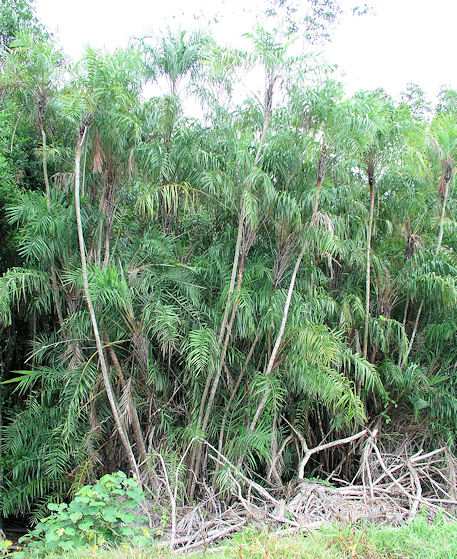
Abb.:
हिन्तालः । Phoenix paludosa Roxb. 1832 - Mangrove Date Palm
[Bildquelle: wan_hong. --
http://www.flickr.com/photos/10382320@N08/3863764571/. -- Zugriff am
2010-12-03. --
Creative Commons Lizenz (Namensnennung, keine kommerzielle Nutzung, share
alike)
"Phoenix paludosa. Roxb.
Sub-arboreous. [...]
Sans. Hintala.
A native of the lower parts of the Delta of the Ganges called the Sunderbunds, where it forms a considerable portion of those impenetrable woods which completely cover that extensive tract of country.
Trunk straight, as thick as a man's leg, and from six to sixteen feet high. [...]
The trunks of the smaller trees serve for walking sticks, and the natives have an idea that snakes get out of the way of any person having such a staff. The longer ones serve for rafters to their houses, and the leaves for thatch."
[Quelle: Roxburgh, William <1751-1815>: Flora indica, or, Descriptions of Indian plants / by the late William Roxburgh. -- Serampore : Printed for W. Thacker, 1832. -- Vol. 3, S. 785f.]
"Phoenix farinifera (Roxb.) N. O. Palmaceae. [...]
Description.—Shrub, 2-3 feet; [...]
Fl. Jan.—Feb.
Roxb. Fl. Ind. iii. 785.—Cor. i. t. 74.
Sandy situations and plains in the Deccan. Travancore.
Economic Uses.—The sweet pulp of the seeds of this dwarf species of date-palm is eaten by the natives. The leaflets are made into mats and the petioles into baskets. A large quantity of farinaceous substance, which is found in the small stem, is used as food in times of scarcity. In order to separate it from the numerous white fibres in which it is enclosed, the stem is split into six or eight pieces, dried, beaten in mortars, and then sifted; this is then boiled to a thick gruel. It is not so nutritive as common sago, and it has a bitter taste. A better preparation might make it more deserving of attention.—(Roxb.)
The Phoenix paludosa (Roxb.), an elegant- looking palm, is characteristic of the Sunderbunds. It is easily recognised by its flat solitary pinnae, and the shape of its fruit, which is sessile, on thick knobs pointing downwards, first yellow, then red, lastly black-purple, oval. The trunks of the smaller trees serve for walking-sticks, and the natives have an idea that snakes get out of the way of any person having such a staff. The larger ones serve for rafters to houses and the leaves for thatch. It is an elegant palm, and well adapted for bank scenery.—Roxb."
[Quelle: Drury, Heber <1819 - 1872>: The useful plants of India : with notices of their chief value in commerce, medicine, and the arts. -- 2d ed. with additions and corrections. London : Allen, 1873. -- xvi, 512 p. ; 22 cm. -- s.v.]
Arecaceae (Palmengewächse)
|
35. c./d. kharjūraḥ
ketakī tālī kharjūrī
ca tṛṇadrumāḥ खर्जूरः केतकी ताली खर्जूरी च तृणद्रुमाः ॥३५ ख॥ [Phoenix sylvestris (L.) Roxb. - Silber-Dattelpalme - Silver Date:] खर्जूर - kharjūra m.: Kharjūra, auch: Skorpion |
Colebrooke (1807): "Date. Phoenix (or Elate) Sylvestris."
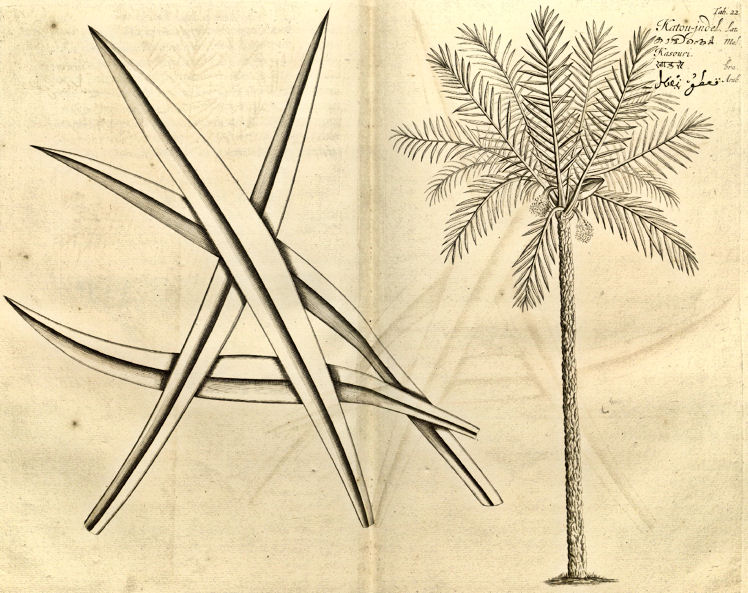
Abb.: खर्जूरः ।
Phoenix sylvestris (L.) Roxb. - Silber-Dattelpalme - Silver Date
[Bildquelle: Hortus malabaricus III. Fig. 22, 1682]
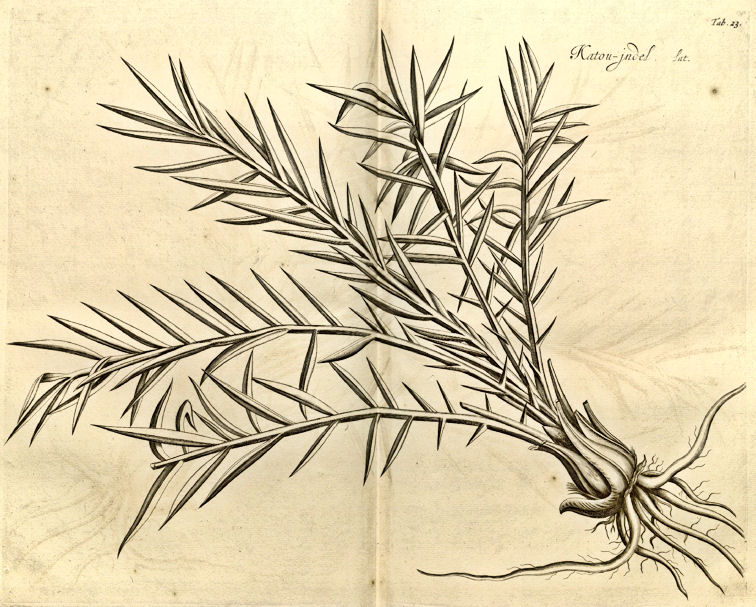
Abb.: खर्जूरः ।
Phoenix sylvestris (L.) Roxb. - Silber-Dattelpalme - Silver Date
[Bildquelle: Hortus malabaricus III. Fig. 23, 1682]
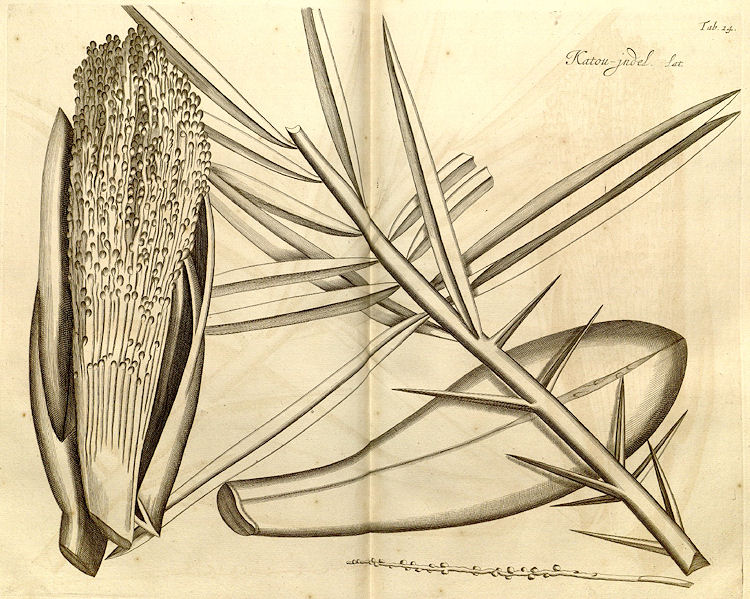
Abb.: Phoenix sylvestris (L.) Roxb. - Silber-Dattelpalme - Silver Date
[Bildquelle: Hortus malabaricus III. Fig. 24, 1682]
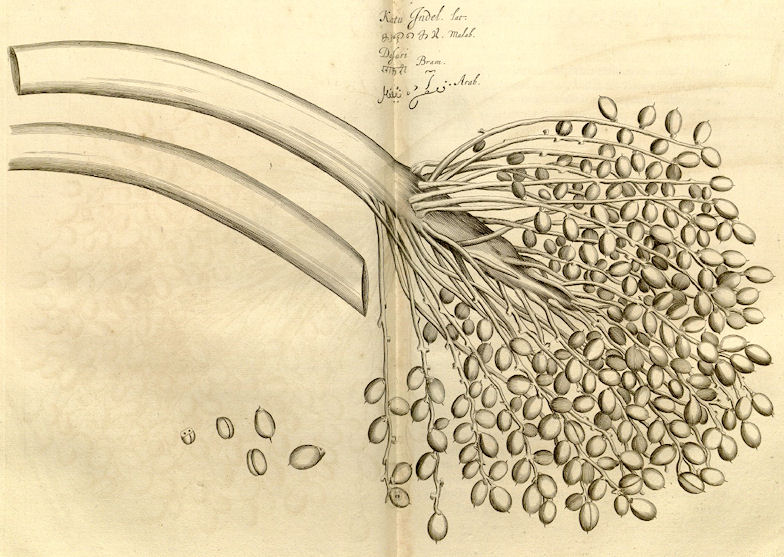
Abb.: Phoenix sylvestris (L.) Roxb. - Silber-Dattelpalme - Silver Date
[Bildquelle: Hortus malabaricus III. Fig. 25, 1682]
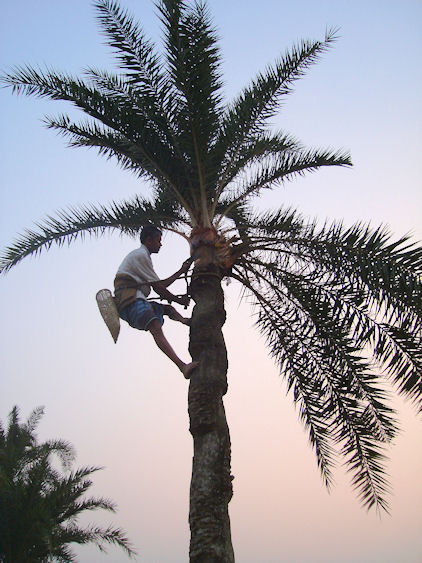
Abb.: खर्जूरः ।
Phoenix sylvestris (L.) Roxb. - Silber-Dattelpalme - Silver Date,
Jessore - যশোর, Bangla Desh
[Bildquelle: Wikimedia. -- Public domain]
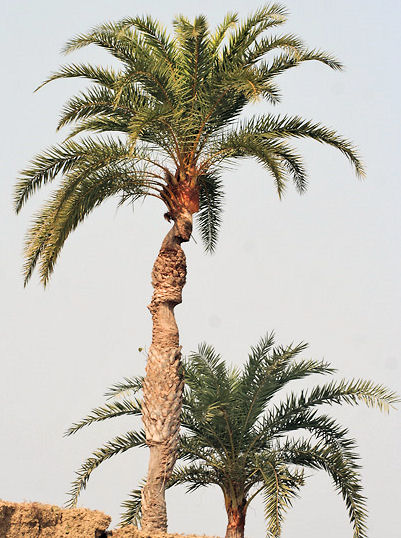
Abb.: खर्जूरः ।
Phoenix sylvestris (L.) Roxb. - Silber-Dattelpalme - Silver Date,
Purbasthali, Bardhaman District - বর্ধমান জেলা,
West Bengal
[Bildquelle: J. M. Garg / Wikimedia. -- GNU FDLicense]
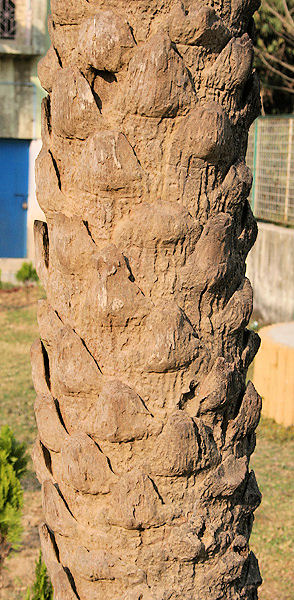
Abb.: Phoenix sylvestris (L.) Roxb. - Silber-Dattelpalme - Silver Date,
Purbasthali, Bardhaman District - বর্ধমান জেলা,
West Bengal
[Bildquelle: J. M. Garg / Wikimedia. -- GNU FDLicense]
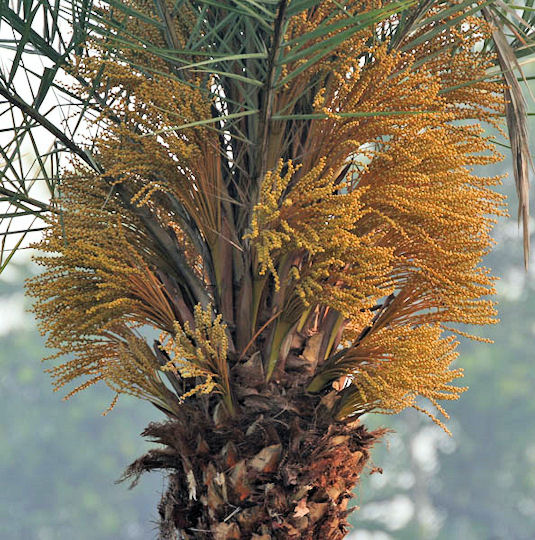
Abb.: Weibliche Blüten von Phoenix sylvestris (L.) Roxb. -
Silber-Dattelpalme - Silver Date, Narendrapur -
নরেন্দ্রপুর, West Bengal
[Bildquelle: J. M. Garg / Wikimedia. -- GNU FDLicense]
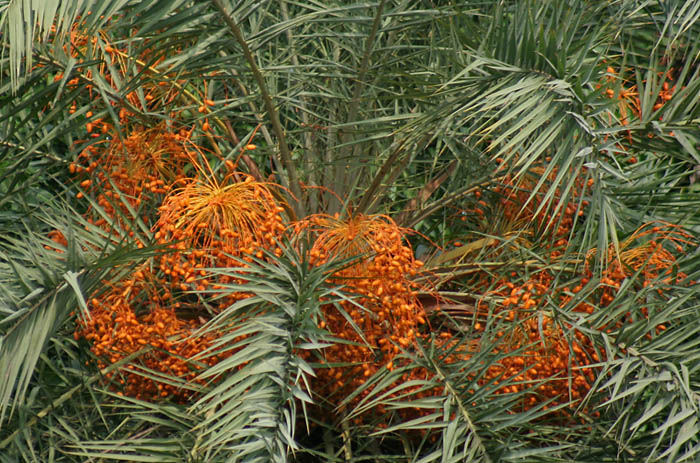
Abb.: Früchte von Phoenix sylvestris (L.) Roxb. - Silber-Dattelpalme -
Silver Date, Kolkata - কলকাতা,
West Bengal
[Bildquelle: J. M. Garg / Wikimedia. -- GNU FDLicense]
"Phoenix sylvestris. Roxb.
[...]
Katou-indel. Rheed. Mai, iii. t. 22. 23. 24. and 25.
Sans. Khurjura.
Elate sylvestris. Linn.
This tree is very common all over India, all soils and situations seem to suit it equally well. Flowering time the beginning of the hot season.
Its parts of fructification are exactly as in V. farinifera, except that here are six small nectarial scales round the base of the germs. But it differs from it most conspicuously in growing to be a tree with a long, pretty thick trunk, and having longer yellowish or reddish fruit. This tree yields Tari, or Palm wine during the cold season. The method of extracting it destroys the appearance and fertility of the tree. The fruit of those that have been cut for drawing off the juice being very small.
The mode of extracting' this juice is by removing the lower leaves and their sheaths, and cutting a notch into the pith of the tree near the top, from thence it issues and is conducted by a small channel made of a bit of the Palmyra tree leaf into a pot suspended to receive it. On the coast of Coromandel this Palm juice is either drank fresh from the tree, or boiled down into sugar, or fermented for distillation, when it gives out a large portion of ardent spirit commonly called Paria aruk on the coast of Coromandel. Mats and baskets are made of the leaves.
The Bengalees call this tree Khujjoor. They also boil the juice into sugar. In the whole Province of Bengal about fifteen thousand maunds, or about a hundred thousand hundredweight is made annually. At the age of from seven or ten years, when the trunk of the trees will be about four feet high, they begin to yield juice, and continue productive for twenty or twenty-five years. It is extracted during the cold months of November, December, January, and February ; during which period, each tree is reckoned to yield from one hundred and twenty to two hundred and forty pints of juice, which averages one hundred and eighty pints, every twelve pints or pounds is boiled down to one of Goor or Jaguri, and four of Goor yield one of good powder sugar, so that the average produce of each tree is about seven or eight pounds of sugar annually.
Another statement presented to me, gives a much larger produce, viz. the average produce of each tree is sixteen pints per day, four of which will yield two pounds of molasses, and forty of molasses will yield twenty-five pounds of brown sugar. The difference is so great, that I cannot well reconcile them, but am inclined to give most credit to the first.
Date sugar, as it is here called, is not so much esteemed as cane sugar, and sells for about one fourth less."
[Quelle: Roxburgh, William <1751-1815>: Flora indica, or, Descriptions of Indian plants / by the late William Roxburgh. -- Serampore : Printed for W. Thacker, 1832. -- Vol. 3, S. 787f.]
"Phoenix sylvestris (Roxb.) Wild-date [...]
Description.—Height 30-40 feet; fronds 10-15 feet long; [...]
Fl. March.
Roxb. Fl. Ind. iii. 787.
Elate sylvestris, Linn.—Rheede, iii. 22-25.
Common all over India.
Economic Uses.—This tree yields Palm-wine. But free extraction destroys the appearance and fertility of the tree, the fruit of those that have been cut for drawing off the juice being very small. The mode of drawing off the juice is, by removing the lower leaves and their sheaths, and cutting a notch into the pith of the tree near the top, whence it issues, and is conducted by a small channel made of a bit of the Palmyra palm-leaf into a pot suspended to receive it. On the coast of Coromandel this palm-juice is either drunk fresh from the tree, or boiled down into sugar, or fermented for distillation, when it gives out a large portion of ardent spirit, commonly called Paria-arak on the coast of Coromandel. There, as well as in Guzerat, and especially in Bengal, the Khajūr is the only tree whose sap is much employed for boiling down to sugar, mixed more or less with the juice of the sugar-cane. At the age of from seven to ten years, when the trunk of the trees will be about 4 feet in height, they begin to yield juice, and continue productive for twenty or twenty-five years. It is extracted from November till February, during which period each tree is reckoned to yield from 120 to 240 pints of juice, which averages 180 pints. Every 12 pints or pounds is boiled down to one of Goor or Jagari, and 4 of this yield 1 of good powdered sugar, so that the average produce of each tree is about 7 or 8 lb. of sugar annually. This date-sugar is not so much esteemed as cane-sugar, and sells for about one-fourth less.
A further description is given in Martin's 'East Indies,' where he says, "A tree is fit for being cut when ten years old, and lasts about twenty years more, during which time, every other year, a notch is cut into the stem just under the new leaves that annually shoot from the extremity. The notches are made alternately on opposite sides of the stem. The upper cut is horizontal, the lower slopes gradually inward from a point at the bottom until it meets the upper, and a leaf at this point collects into a pot the juice that exudes. The season commences about the beginning of October, and lasts until about the end of April. After the first commencement, so long as the cut bleeds, a very thin slice is daily taken from the surface. In from two to seven days the bleeding stops, the tree is allowed an equal number of days' rest, and is then cut again, giving daily 2 seers of juice. The juice when fresh is very sweet, with somewhat the flavour of the water contained in a young cocoanut This is slightly bitter and astringent, but at the same time has somewhat of a nauseous smell. Owing to the coolness of the season, it does not readily ferment. It is therefore collected in large pots; a little (1/16) old fermented juice is added, and it is exposed to the sun for about three hours, when the process is complete. A tree gives annually about 64 seers of juice, or bleeds about thirty-two days. No sugar is made from the juice; 1/2 seer or a pint of the fermented juice makes some people drunk, and few can stand double the quantity. Mats for sleeping on are made of the leaves, and are reckoned the best used in the districts, and also baskets from the leaf-stalks, &c." The latter are twisted into ropes, and employed for drawing water from wells in Bellary and other places. The natives chew the fruit in the same manner as they do the areca-nut with the betel-leaf and chunam.—Roxb. Royle. Fib. Plants. Martin's East Indies. Simmonds."
[Quelle: Drury, Heber <1819 - 1872>: The useful plants of India : with notices of their chief value in commerce, medicine, and the arts. -- 2d ed. with additions and corrections. London : Allen, 1873. -- xvi, 512 p. ; 22 cm. -- s.v.]
"Phoenix sylvestris, Roxb., Rheede, Hort. Mal. iii., tt. 22 to 25, Kharjura (Sans.), [...] also yields a juice, from which spirit is obtained. The fruit called Khārik pounded and mixed with almonds, Quince seeds, Pistachio nuts, spices and sugar forms a Paushtik, or restorative remedy much in vogue. A paste formed of the seeds and the root of Achyranthes aspera is eaten with betel leaves as a remedy for ague.
The juice of this palm is obtained by tapping the trunk."
[Quelle: Pharmacographia indica : a history of the principal drugs of vegetable origin met with in British India / by William Dymock [1834-1892], C. J. H. Warden and David Hooper [1858-1947]. -- Bd. 3. -- London, 1893. -- S. 520.]
Pandanaceae (Schraubenbaumgewächse)
|
35. c./d.
kharjūraḥ
ketakī
tālī kharjūrī ca
tṛṇadrumāḥ खर्जूरः केतकी ताली खर्जूरी च तृणद्रुमाः ॥३५ ख॥ [Pandanus fascicularis Lam.:] केतकी - ketakī f.: Ketakī (zu keta m.: Wille, Verlangen; Zufluchtsstätte; Erkennungszeichen) |
Colebrooke (1807): "Pandanus. Pandanus odoratissimus [L. f. = Pandanus odorifer (Forssk.) Kuntze 1891 = Pandanus fascicularis Lam.]."
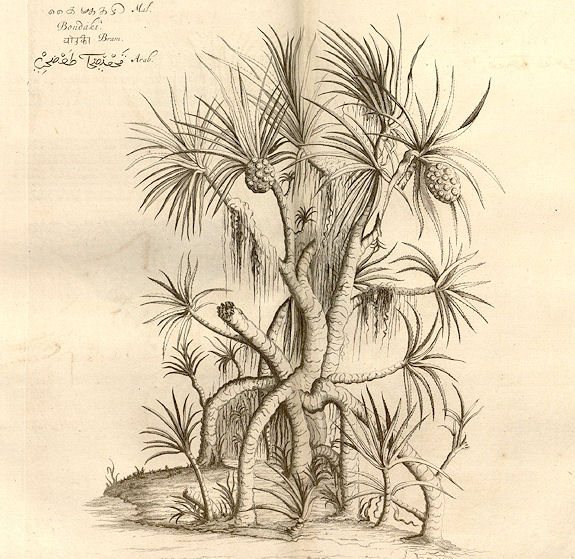
Abb.: केतकी ।s Pandanus fascicularis Lam.
[Bildquelle: Hortus malabaricus II. Fig. 1, 1679]
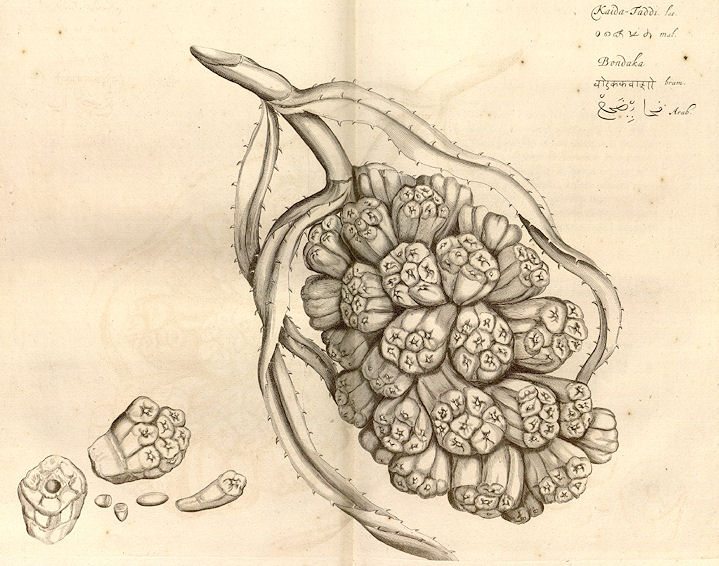
Abb.: Pandanus fascicularis Lam.
[Bildquelle: Hortus malabaricus II. Fig. 6, 1679]
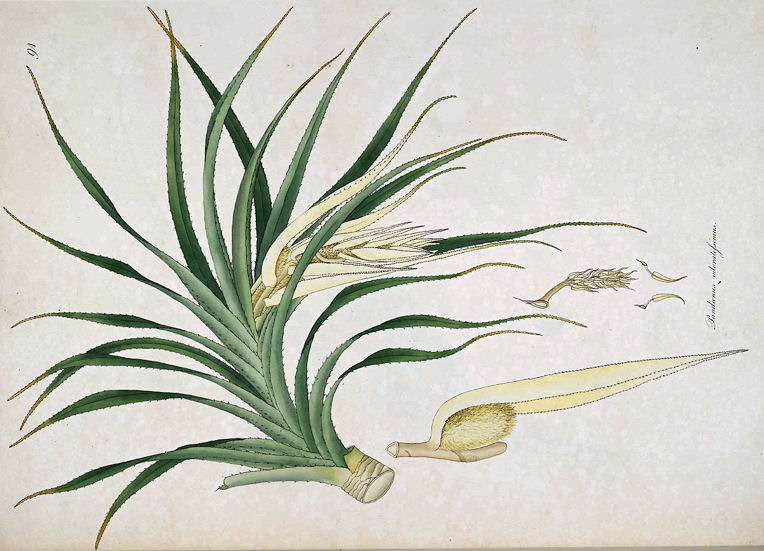
Abb.: Pandanus fascicularis Lam. (= Pandanus odoratissimus Roxb.)
[Bildquelle: Roxburgh. -- Vol I. -- 1795. -- Image courtesy Missouri Botanical
Garden. http://www.botanicus.org. --
Creative Commons Lizenz
(Namensnennung, keine kommerzielle Nutzung)]
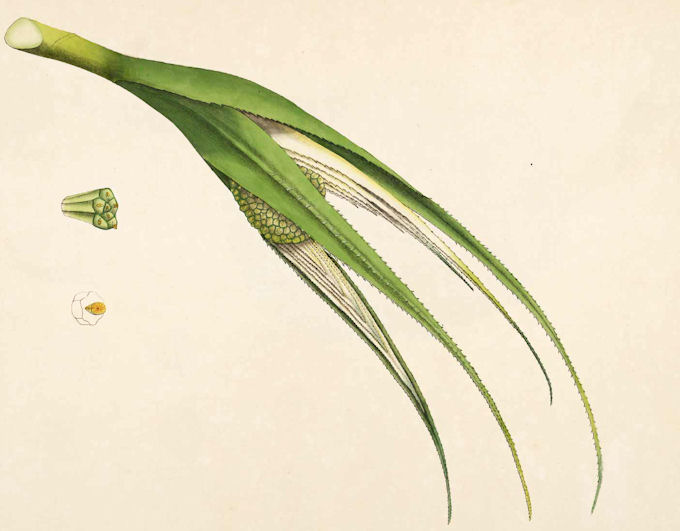
Abb.: Pandanus fascicularis Lam. (= Pandanus odoratissimus Roxb.)
[Bildquelle: Roxburgh. -- Vol I. -- 1795. -- Image courtesy Missouri Botanical
Garden. http://www.botanicus.org. --
Creative Commons Lizenz
(Namensnennung, keine kommerzielle Nutzung)]
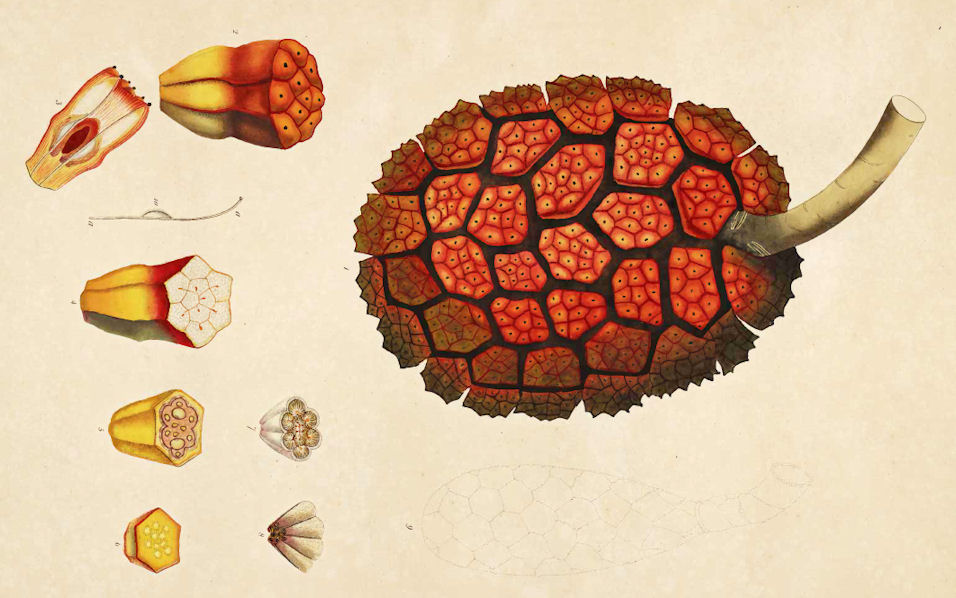
Abb.: Pandanus fascicularis Lam. (= Pandanus odoratissimus Roxb.)
[Bildquelle: Roxburgh. -- Vol I. -- 1795. -- Image courtesy Missouri Botanical
Garden. http://www.botanicus.org. --
Creative Commons Lizenz
(Namensnennung, keine kommerzielle Nutzung)]
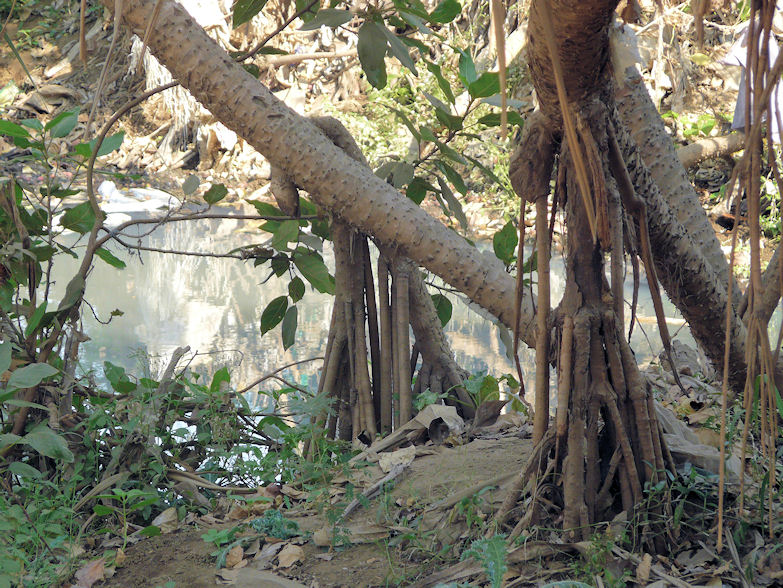
Abb.: Pandanus fascicularis Lam.
[Bildquelle: dinesh_valke. --
http://www.flickr.com/photos/dinesh_valke/2391962210/. -- Zugriff am
2010-10-23. --
Creative
Commons Lizenz (Namensnennung, keine kommerzielle Nutzung, keine
Bearbeitung)]
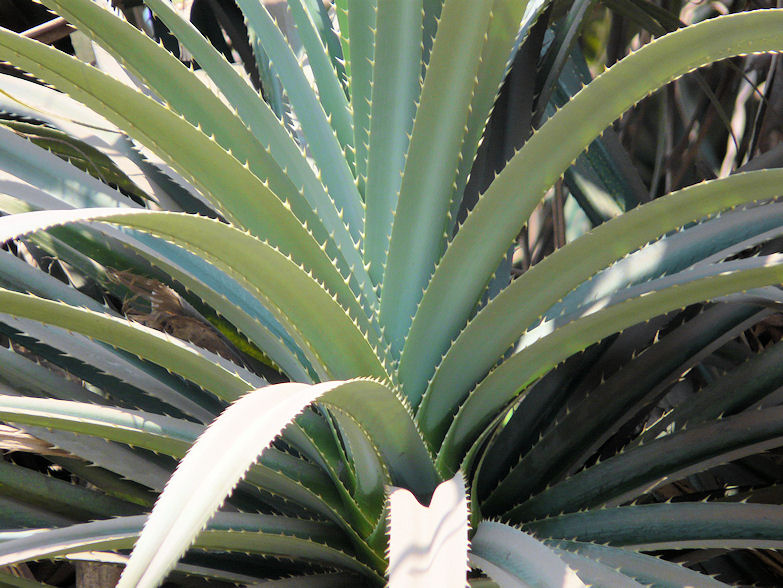
Abb.: Pandanus fascicularis Lam.
[Bildquelle: dinesh_valke. --
http://www.flickr.com/photos/dinesh_valke/2391139365/. -- Zugriff am
2010-10-23. --
Creative
Commons Lizenz (Namensnennung, keine kommerzielle Nutzung, keine
Bearbeitung)]
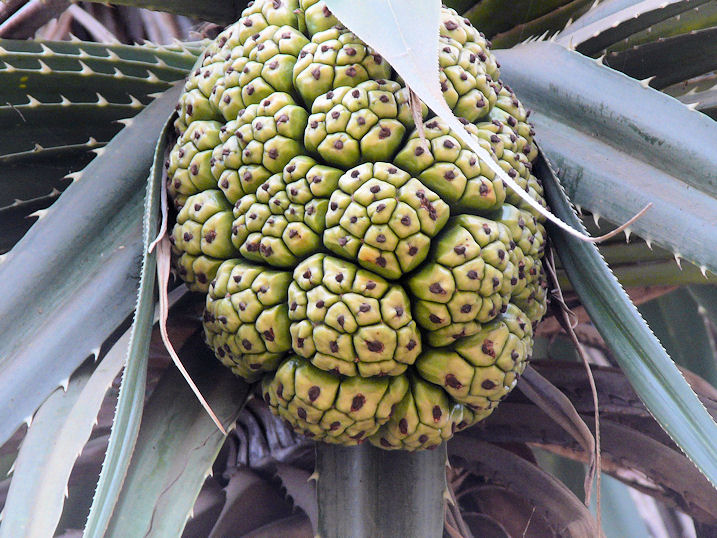
Abb.: Pandanus fascicularis Lam.
[Bildquelle: dinesh_valke. --
http://www.flickr.com/photos/dinesh_valke/3228941960/. -- Zugriff am
2010-10-23. --
Creative
Commons Lizenz (Namensnennung, keine kommerzielle Nutzung, share alike)]
"Pandanus odoratissimus. Willd. iv. 645.
[...]
Sans. Ketuka,
Mellore, or Nicobar bread fruit. Asiat, Res. iii. 161.
Kaida. Rheed. Mal. ii. t. 1.5.
P. odoratissimus. R. Corom. pl. N. 94, 95, 96.
P. verus. Rumph. Amb. iv. t. 74.
Anthrodactylis spinosa. Forst. gen. N. 75.
Keyro. Forsk. Aegypt. 172.
Mugalik is the Telinga name of the male plant, and Gozdoogoo that of the female. Kaldera is the name they are known by amongst Europeans on the coast of Coromandel.
It is a native of all the warmer parts of Asia, all soils and situations seem to suit it equally well. It flowers chiefly during the rainy season.
[...]
Note, This plant is much employed to make hedges, for which it answers well, but requires too much room. It grows readily from branches which renders it rare to find the full-grown, ripe fruit. The male is by far the most common, a circumstance merely accidental, for I have seen some old extensive hedges entirely female, which must be owing to their having been originally a female plant or plants nearest to these places. It is the tender white leaves of the flowers, chiefly those of the male, that yield that most delightful fragrance for which they are so universally and deservedly esteemed ; for of all the perfumes in the world it must be the richest and most powerful.
The lower yellow pulpy part of the drupes is sometimes eaten by the natives during times of scarcity, and famine ; the tender white base of the leaves is also eaten raw or boiled during the same melancholy periods. The fusiform roots already mentioned are composed of tough fibres, which basket-makers split and use to tie their work with, they are also so soft and spongy as to serve the natives for corks. The leaves are composed of longitudinal, tough, useful fibres like those of the Pine-apple. I have never known this plant cultivated with any other view than for fences, nor do I yet know any other species, or even variety of this genus.
The drawing of the Mellore, or bread fruit of the Nicobar Islands in the third volume of the Asiatic Researches, was taken from the ripe fruit brought from those Islands by Colonel Kyd. From this drawing and description there is every reason to think it is the fruit of the female plant of Pandanus odoratissimus. The size, from thirty-five to forty feet in height, to which it rises on those Islands, is much greater than I ever saw it on the Coromandel coast, or in Orissa, or Bengal, which, however, is not a sufficient reason to make it a different species.
Extract of a letter from Colonel Hardwicke, dated Mauritius, November 1811. This plant is of extensive use in most parts of the Island, for its leaves, which are employed for the purpose of package bags for the transportation of coffee, sugar, and grain from one place to another, and for exportation. Hedge rows, or avenues are formed of it round plantations, or along the sides of the many roads which intersect them ; and the leaves, as fast as they attain maturity are cut till the tree arrives at its full growth, when the production of new leaves being slower, and less useful, younger plants are resorted to, to supply the wants of the planter. The preparation of the leaves for working into matting is simple and short. As soon as gathered, the spines on their edges and dorsal nerve are stripped off, and the leaf divided into slips of the breadth proper for the use they are required for ; this operation is performed with the blade of a common straight knife, they are then laid in the sun for a few hours to dry ; when required for working into mats the slips are passed under the blade of a knife applied with a moderate pressure to remove all asperities on their surface, which gives them a polish and makes them plain and more convenient to the hands. One negro employed in the foregoing preparation, will supply slips fast enough to keep eight others at work ; and each negro can finish four, and sometimes five bags in the course of the day. Thus the value of each bag may be computed by the cost, or worth of the labour of nine negroes for one day. Every proprietor of slaves can obtain, by letting them out to daily labour, six Spanish Dollars, or twelve Sicca Rupees per month; the value therefore of the labour of one man for a day may be rated at six annas and one third, thus taking the lowest number made, viz. thirty-six, the cost of each bag will be about one anna and a half. This to me appears a cheaper material than the common gunny bag of Bengal used in the exportation of rice and other grain in Calcutta ; itseems also better calculated to repel wet and resist the common injuries of transportation from one place to another. No difficulty would attend the cultivation of this plant in Bengal, where one, or more species of this genus is indigenous. This tree attains here the height of about fifteen feet, the stem at half that height branching into several sub-erect arms terminated by the thick foliage. It flowers in the month of May; the fruit of the kind I here notice is when full grown about five inches in diameter, the seed large, turbinate with an angular apex."
[Quelle: Roxburgh, William <1751-1815>: Flora indica, or, Descriptions of Indian plants / by the late William Roxburgh. -- Serampore : Printed for W. Thacker, 1832. -- Vol. 3, S. 738ff.]
"Pandanus odoratissimus (Linn. Fil.) N. O. Pandanaceae. Caldera bush, Fragrant Screw-pine [...]
Description.—Large shrub, 10 feet or more, bushy; roots issuing from lower parts of the stem or larger branches; [...] flowers small, fragrant
Fl. June—Sept.
Roxb. Cor. i. t. 94-96.—Fl. Ind. iii 738.
Rheede, ii. t. 8.
Peninsula, near bank of streams and water-courses.
Economic Uses.—This large and singular-looking bush is very common along the banks of the canals and back-waters in Travancore, in which places it is planted to bind the soil. The flowers are seldom visible, but the large red fruit, much like a pine-apple, is very attractive. The flowers are very fragrant, and from them is made an oil known as the Keora-oil. The perfume is extracted chiefly from the male flowers. The floral leaves themselves are eaten either raw or boiled The lower pulpy part of the drupes is eaten by the natives in times of scarcity. The fusiform roots are used by the basket-makers to tie their work with, and also, by reason of their soft and spongy nature, for corks. There are manufactures at Cuddalore and other places, where mats, baskets, and hats are made from these roots, and a coarse brush for whitewashing houses: when beaten out with a mallet they open out like a soft brush. Matting and packing-bags are made from them in the Mauritius and China. The leaves, which abound in toughish fibres, are used for matting, cordage, and thatch. They are said to be good for paper-making also. The natives make with them a fine kind of mat to sleep on, which they stain red and yellow. Also used for making common umbrellas. In some districts the fibres are used for making the larger kinds of hunting-nets, and drag-ropes of fishing-nets. In Tinnevelly they are mixed with flax in small quantities for the manufacture of gunny and ropes, but they are not sold in their pure state. It is the farina of the male flowers which is used as a perfume. In Arabia and India people bestrew their heads with it, as Europeans do with perfumed powder.—(Ainslie. Roxb. Jury Rep. Mad. Exhib.) A species of Pandanus is used in most parts of the Mauritius for its leaves, which are employed for the purpose of package-bags for the transportation of coffee, sugar, and grain from one place to another, and for exportation. The preparation of the leaves for working into matting is simple and short As soon as gathered, the spines on their edges and dorsal nerve are stripped off and the leaf divided into strips of the breadth proper for the use they are required for.—Col. Hardwicke."
[Quelle: Drury, Heber <1819 - 1872>: The useful plants of India : with notices of their chief value in commerce, medicine, and the arts. -- 2d ed. with additions and corrections. London : Allen, 1873. -- xvi, 512 p. ; 22 cm. -- s.v.]
"PANDANUS ODORATISSIMUS, Linn. f. Fig.—Roxb. Cor. Pl. i., tt. 94-96.
Screw Pine, Kaldera bush
Hab.—India, Persia, Arabia.
[...]
History, Uses, &c.—The Ketaka or Dhūli-pushpika "dust flower," whose golden spikes of flowers are said to atone for all its defects, is a great favourite with Vishnu and Krishna, and its flower-leaves are much worn by women in their hair. The poets also celebrate its perfume. In the play of Malati and Madhava, the latter says:—
The slowly rising breezes spread around
The grateful fragrance of the Ketaka.A strophe quoted by Böhtlingk (Indische Sprüche, 1., 2083) says:—The drunken bee mistakes the golden flowers of the Ketaka for a lotus, and blinded by desire rushes into the flower and leaves his wings behind him. In the Gita Govinda, the bracts are likened to a lance fit to pierce the hearts of lovers, and the opening buds of the Jasmine are supposed to be impregnated by its pollen.
The defects of this plant are described as its crookedness, abundance of thorns (suchi-pushpa), and the desert places which it selects for a habitation. The Ketaka is obnoxious to Siva, and the following story is told to account for his hatred of the tree: Gambling with Parvati he is said to have lost everything he possessed, even to down the clothes upon his back. In a fit of repentance he wandered away and was lost to his friends, who afterwards discovered that he had retired into a forest of Ketaka trees and had become an ascetic. Parvati, having assumed the form of a Bhil damsel with Ketaka in her hair, followed him into the forest, and having succeeded in making him break his vow afterwards upbraided him for inconstancy ; whereupon he cursed the Ketaka and any one who should offer its flowers at his shrine. This episode is the subject of a well-known Marathi laoni ;—
Siva sāthi jhali bhilina
Jaga mohini Girja jhali udāsa.Unhappy Girje, erst the world's ador'd
A gipsy maid now, seeks for Shiv her lord.According to the Nighantas, the plant has bitter, sweet, light, and pungent properties, and removes phlegmatic humors.
In Persia it is called Kādi, Gulkiri, and Gul-i-kabadi; the Arabs call it Kādi and Kadar. Rāzi recommends it in leprosy and small-pox; it is considered by Mahometan physicians to be cardiacal, cephalic, and aphrodisiacal. They prepare a sharab by boiling the pounded stems in water, also a distilled water from the flowering tops and a perfumed oil. Mir Muhammad Husain states that the Hindus believe that if these preparations are used when small-pox is prevalent, the disease will be averted, or be of so mild a form as to be free from danger. The ashes of the wood are said to promote the healing of wounds, and the seeds to strengthen the heart and liver.
In India the perfumed oil is prepared by placing the floral bracts in sesamum oil and exposing it to the sun for forty days; fresh bracts are supplied and the old ones removed several times during this period. This oil is much valued as a perfume, and is used as a remedy for earache and suppuration of the meatus. The distilled water may be simple or compound; in the latter case the bracts are distilled with rose-water or sandalwood chips; it is used as a perfume and to flavour sherbets.
The leaves of several species of Pandanus are used for making mats and to polish lacquer-ware, and the fruit has been eaten in famine times. The edible species (P. edulis, Thonars), common in Madagascar and the islands of the South Pacific, does not occur in India. The aerial roots of the different species are much used to make coarse brushes in the East, a portion of the desired length being cut and the end beaten until the fibres separate."
[Quelle: Pharmacographia indica : a history of the principal drugs of vegetable origin met with in British India / by William Dymock [1834-1892], C. J. H. Warden and David Hooper [1858-1947]. -- Bd. 3. -- London, 1893. -- S. 535ff.]
|
35. c./d.
kharjūraḥ ketakī
tālī
kharjūrī
ca
tṛṇadrumāḥ खर्जूरः केतकी ताली खर्जूरी च तृणद्रुमाः ॥३५ ख॥ [Corypha umbraculifera L. 1753 - Talipotpalme - Talipot Palm:] ताली - tālī f.: Tālī = weiblicher Borassus flabellifer L. 1753 - Palmyrapalme - Toddy Palm |
Colebrooke (1807): "Corypha. C. Talliera, Roxb. or C. umbraculifera [L. 1753]."
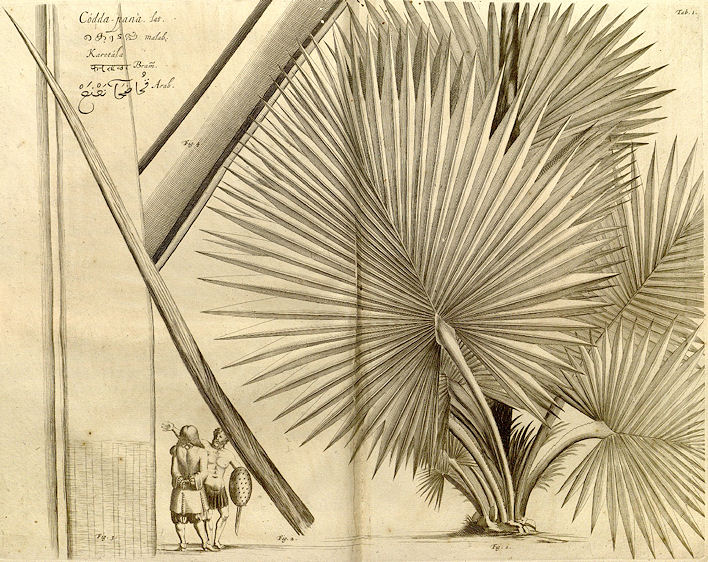
Abb.: Corypha umbraculifera L. 1753 - Talipotpalme - Talipot Palm
[Bildquelle: Hortus malabaricus III. Fig. 1, 1682]
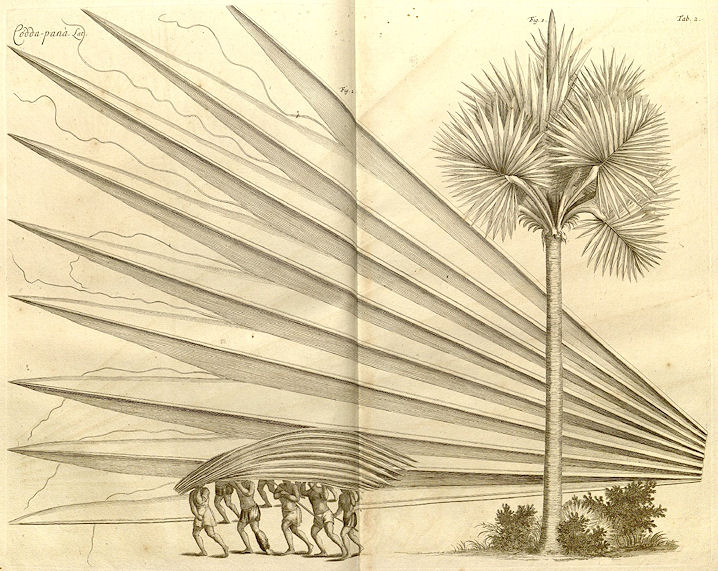
Abb.: Corypha umbraculifera L. 1753 - Talipotpalme - Talipot Palm
[Bildquelle: Hortus malabaricus III. Fig. 2, 1682]
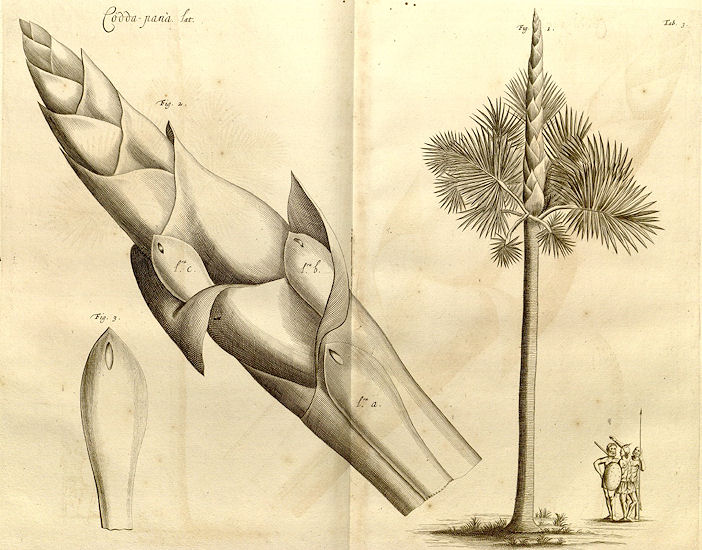
Abb.: Corypha umbraculifera L. 1753 - Talipotpalme - Talipot Palm
[Bildquelle: Hortus malabaricus III. Fig. 3, 1682]
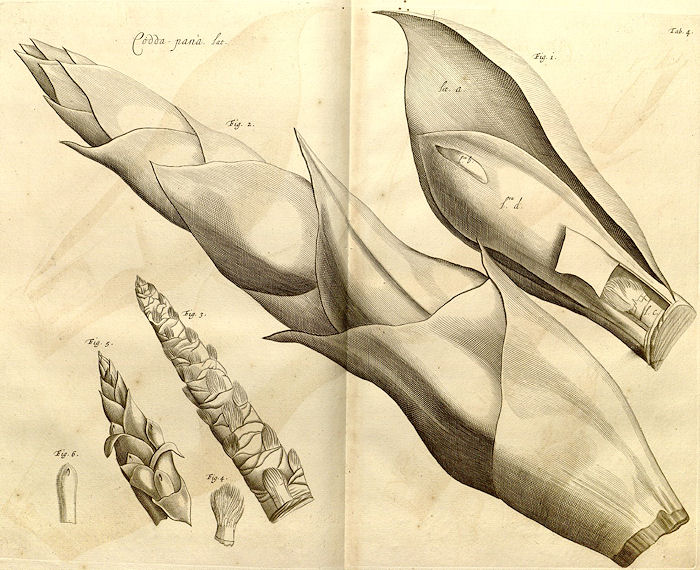
Abb.: Corypha umbraculifera L. 1753 - Talipotpalme - Talipot Palm
[Bildquelle: Hortus malabaricus III. Fig. 4, 1682]
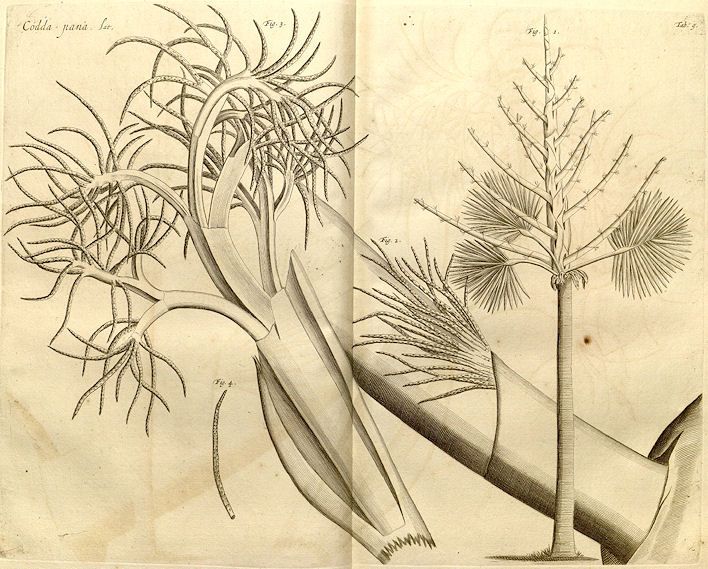
Abb.: Corypha umbraculifera L. 1753 - Talipotpalme - Talipot Palm
[Bildquelle: Hortus malabaricus III. Fig. 9, 1682]
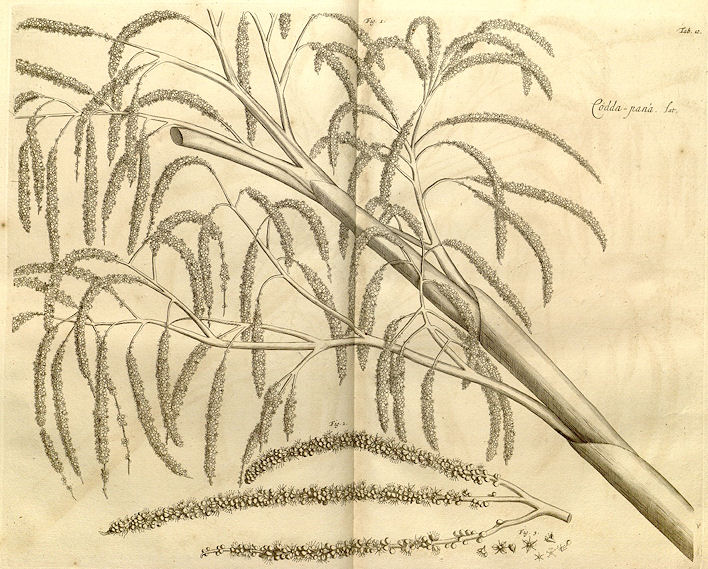
Abb.: Corypha umbraculifera L. 1753 - Talipotpalme - Talipot Palm
[Bildquelle: Hortus malabaricus III. Fig. 10, 1682]
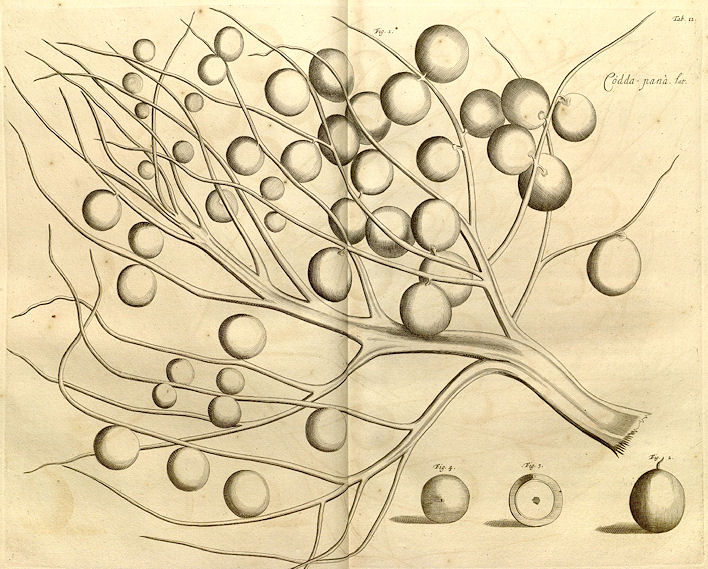
Abb.: Corypha umbraculifera L. 1753 - Talipotpalme - Talipot Palm
[Bildquelle: Hortus malabaricus III. Fig. 12, 1682]
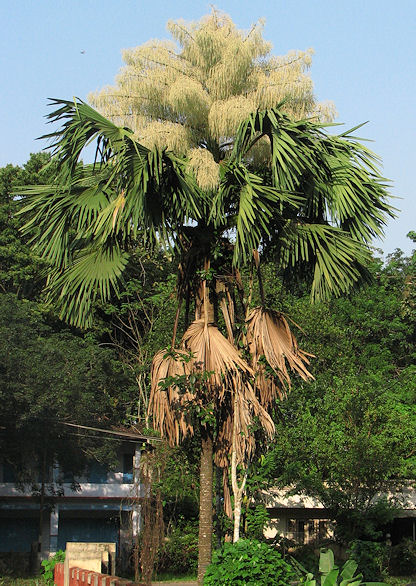
Abb.: Corypha umbraculifera L. 1753 - Talipotpalme - Talipot Palm in
Blüte
[Bildquelle: PraveenP / Wikimedia. -- Public domain]
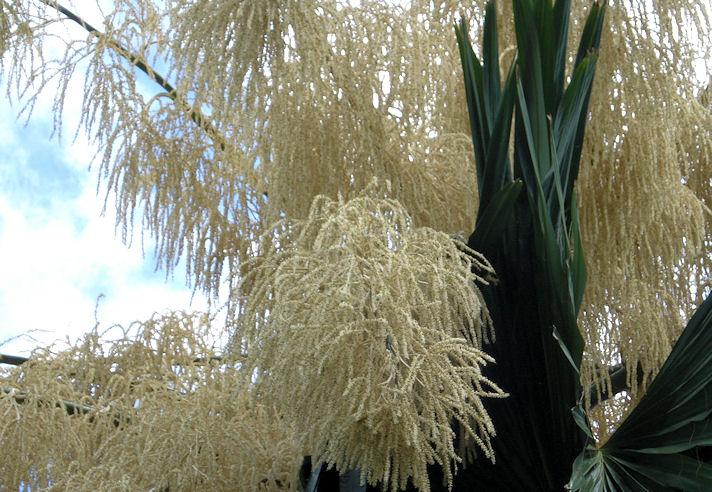
Abb.: Corypha umbraculifera L. 1753 - Talipotpalme - Talipot Palm in
Blüte, Hawaii
[Bildquelle: Cumulus Clouds / Wikimedia. -- GNU FDLicense]
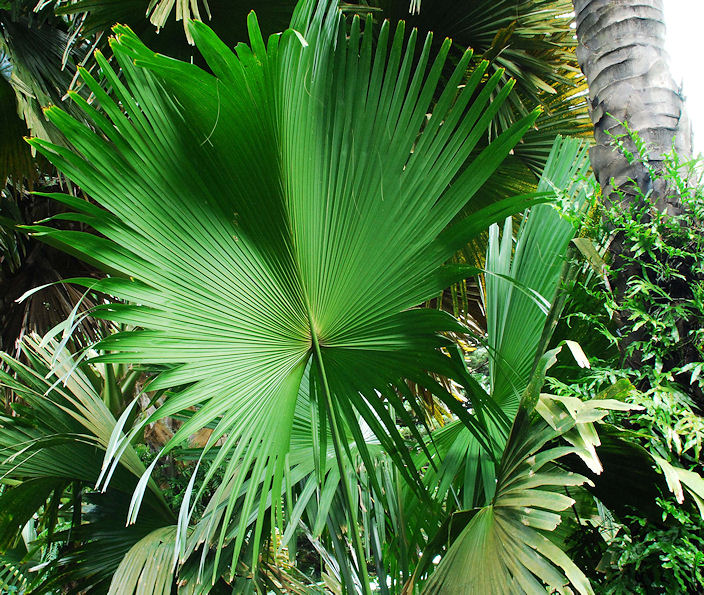
Abb.: Corypha umbraculifera L. 1753 - Talipotpalme - Talipot
[Bildquelle: Pancrat / Wikimedia. -- GNU FDLicense]
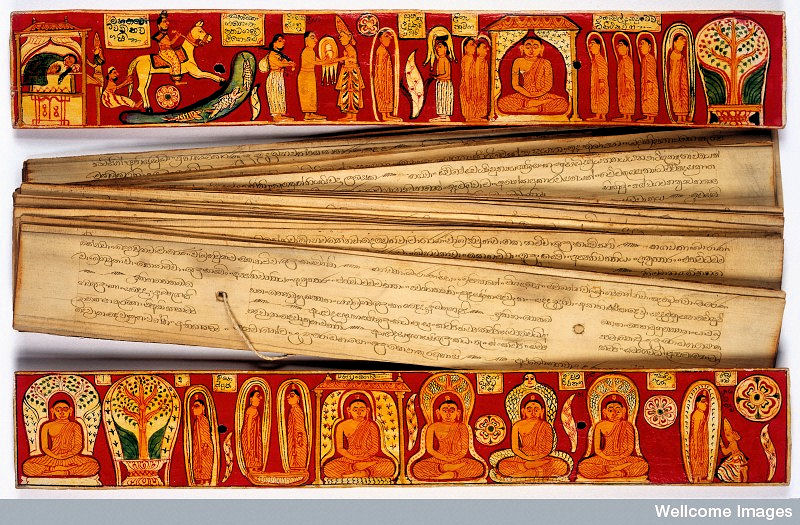
Abb.: Dhammacakkappavattanasutta-Handschrift auf Blättern von Corypha
umbraculifera L. 1753 - Talipotpalme - Talipot, Sri Lanka, 19. Jhdt.
[Bildquelle: Wellcome Images. -- Zugriff am 2010-12--04. --
Creative Commons
Lizenz (Namensnennung, keine kommerzielle Nutzung)]
"Corypha umbraculifera. Willd. 2. 201. Gaert. sem. 1. 18 t. 7.
[...]
Codda-pana. Rheed Mal. 3. t. 1-12.
Talipat. Knox. hist, of Ceylon.
This is an intermediate species, (with regard to size,) between Taliera stud Elata. From Ceylon it has been introduced about nine years into the Botanic Garden at Calcutta. The seeds were fully as large as those of Taliera, consequently much larger than in Elata. This alone is a sufficient mark in a tree of this nature to distinguish it from Elata ; infortunately I did not examine the situation of the embryo, we must therefore take it for granted that Gaertner was correct in placing it in the base of the seeds ; our young trees, are only now, when nine years old, beginning to exhibit the first appearance of a trunk.
In the same Garden are plants of Taliera, of the same age ; their appearance at this period is so very different as to announce their being distinct species."
[Quelle: Roxburgh, William <1751-1815>: Flora indica, or, Descriptions of Indian plants / by the late William Roxburgh. -- Serampore : Printed for W. Thacker, 1832. -- Vol. 2, S. 177f.]
"Corypha umbraculifera (Linn.) N. O. Palmaceae. Talipot or Fan Palm [...]
Description.—Trunk 60-70 feet; [...]
Roxb. Fl. Ind. ii. 177.—Rheede, iii 1.1-12 incl.
Ceylon. Malabar. Malay coast.
Economic Uses.—This is the well-known Fan-palm of Ceylon. Its large broad fronds are used for thatching, and also for writing on with an iron style. Such records are said to resist the ravages of time. The seeds are used as beads by certain sects of Hindoos. The dried leaf is very strong, and is commonly used for umbrellas by all classes. Ot opens and shuts like a lady's fan, and is remarkably light. A kind of flour or sago is prepared from the pith of the trunk. Little bowls and other ornaments are made from the nuts, and when polished and coloured red, are easily passed off for genuine coral.—(Roxb. Knox's Ceylon.) The most majestic and wonderful of the palm tribe, says Sir E. Tennent (Ceylon, i. 109), is the Talipot, the stem of which sometimes attains the height of 100 feet; and each of its enormous fan-like leaves, when laid upon the ground, will form a semicircle of 16 feet in diameter, and cover an area of 200 superficial feet. The tree flowers but once and dies, and the natives firmly believe that the bursting of the spadix is accompanied by a loud explosion. The leaves alone are converted by the Singhalese to purposes of utility. Of them they form coverings for their houses, and portable tents of a rude but effective character. But the most interesting use to which they are applied is a substitute for paper, both for books and ordinary purposes. In the preparation of Olas, which is the term applied to them when so employed, the leaves are taken whilst tender, and after separating the central ribs, they are cut into strips and boiled in spring-water. They are dried first in the shade and afterwards in the sun, then made into rolls and kept in store, or sent to the market for sale. Before they are fit for writing on they are subjected to a second process. A smooth plank of Areca palm is tied horizontally between two trees; each Ola is then damped, and a weight being attached to one end of it, it is drawn backwards and forwards across the edge of the wood till the surface becomes perfectly smooth and polished, and during the process, as the moisture dries up, it is necessary to renew it till the effect is complete. The smoothing of a single Ola will occupy from 15 to 20 minutes. Another palm is the C. Taliera, growing in Bengal, the leaves of which are used for writing on with an iron style, as well as for thatching roofs, being strong and durable. Hats and umbrellas are also made from them.—Roxb."
[Quelle: Drury, Heber <1819 - 1872>: The useful plants of India : with notices of their chief value in commerce, medicine, and the arts. -- 2d ed. with additions and corrections. London : Allen, 1873. -- xvi, 512 p. ; 22 cm. -- s.v.]
|
35. c./d.
kharjūraḥ ketakī tālī
kharjūrī ca tṛṇadrumāḥ खर्जूरः केतकी ताली खर्जूरी च तृणद्रुमाः ॥३५ ख॥ [Phoenix bulbifera Roxb. ??:] खर्जूरी - kharjūrī f.: weibliche Phoenix sylvestris (L.) Roxb. - Silber-Dattelpalme - Silver Date; auch: Skorpionin All dies sind तृणद्रुम - tṛṇadruma m.: Gras-Bäume (Palmen). |
Colebrooke (1807): "Wild date tree. Perhaps Phoenix bulbifera, Roxb. [= ???]"
|
iti vanauṣadhivargaḥ Ende des Abschnitts über Wälder und Pflanzen. |
Zu siṃhādivargaḥ I (Vers 1 - 4): Säugetiere I